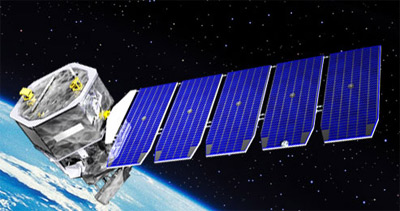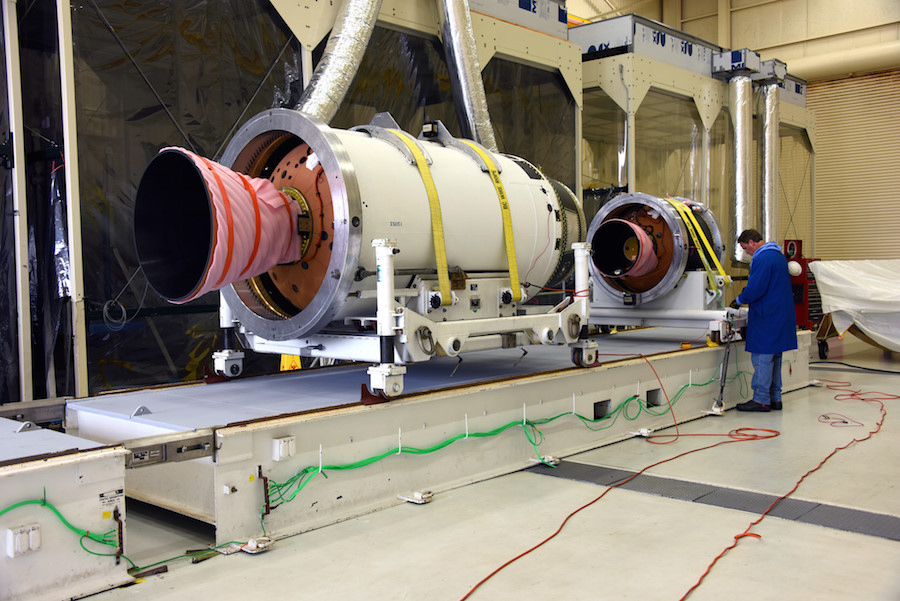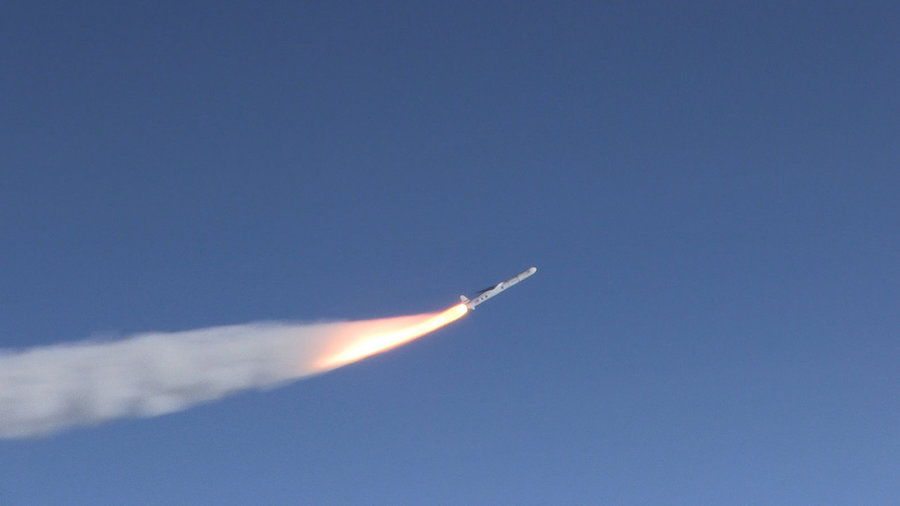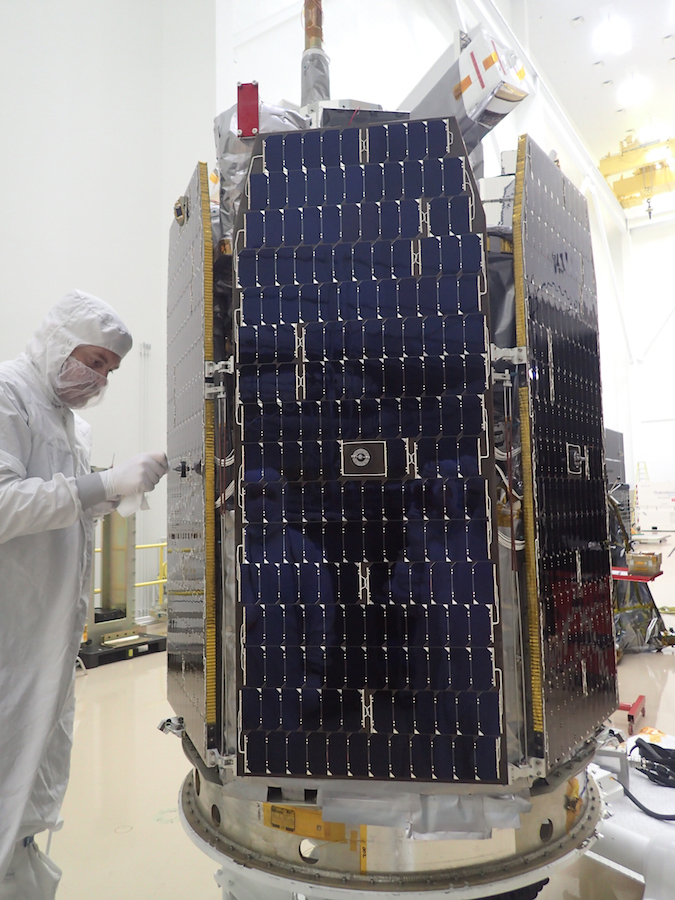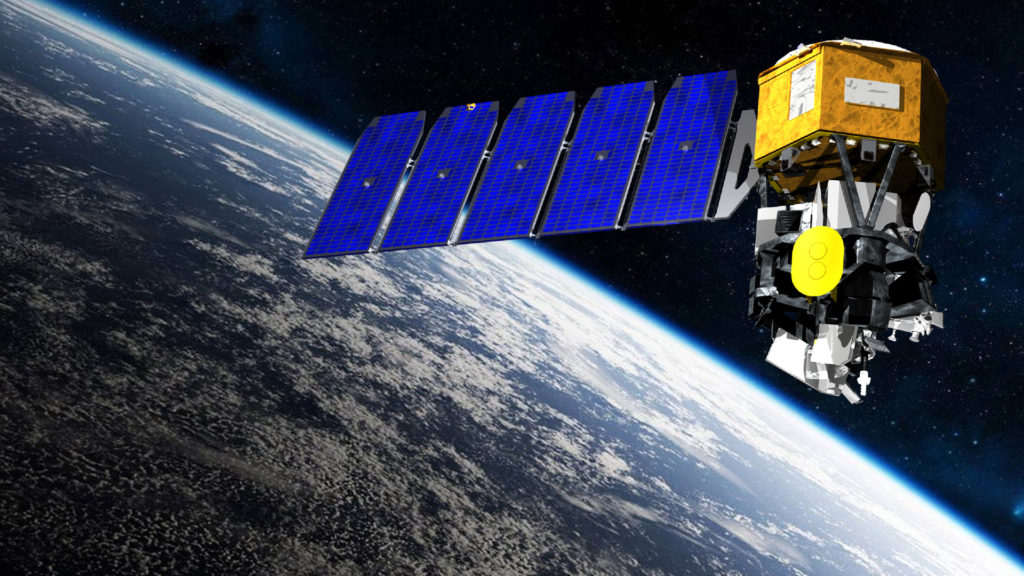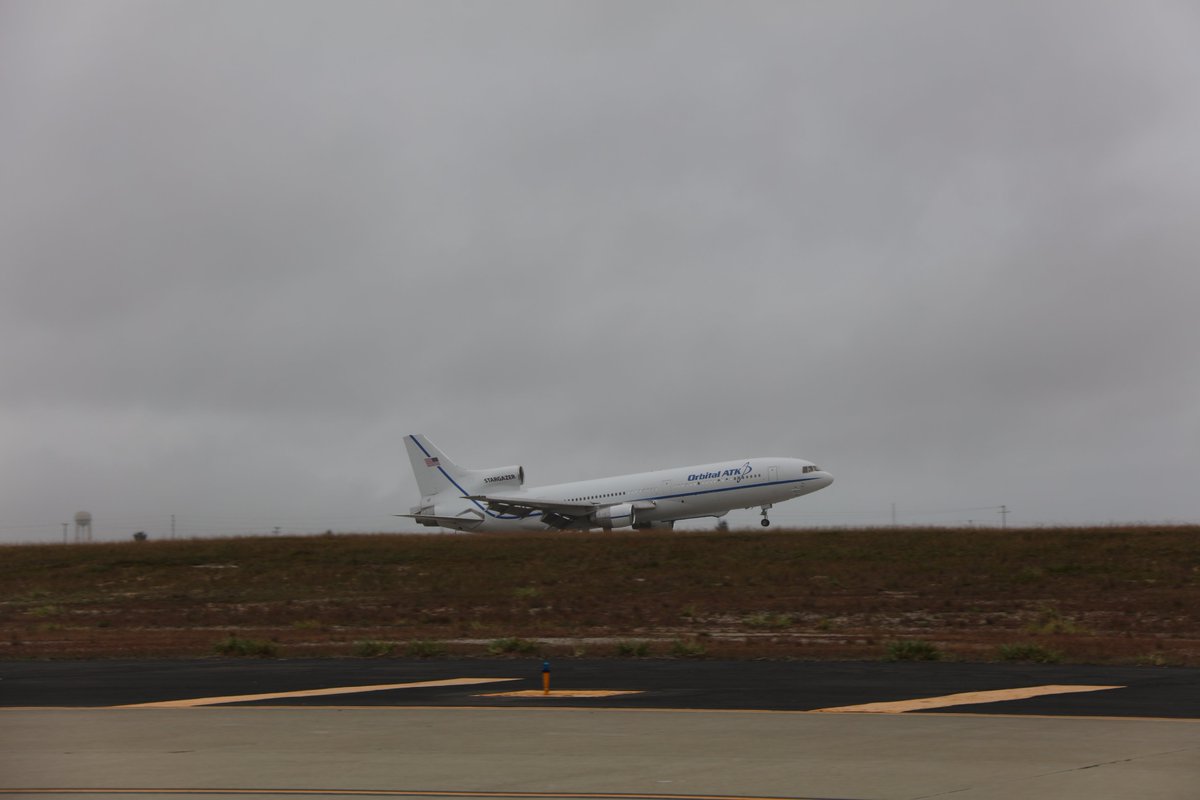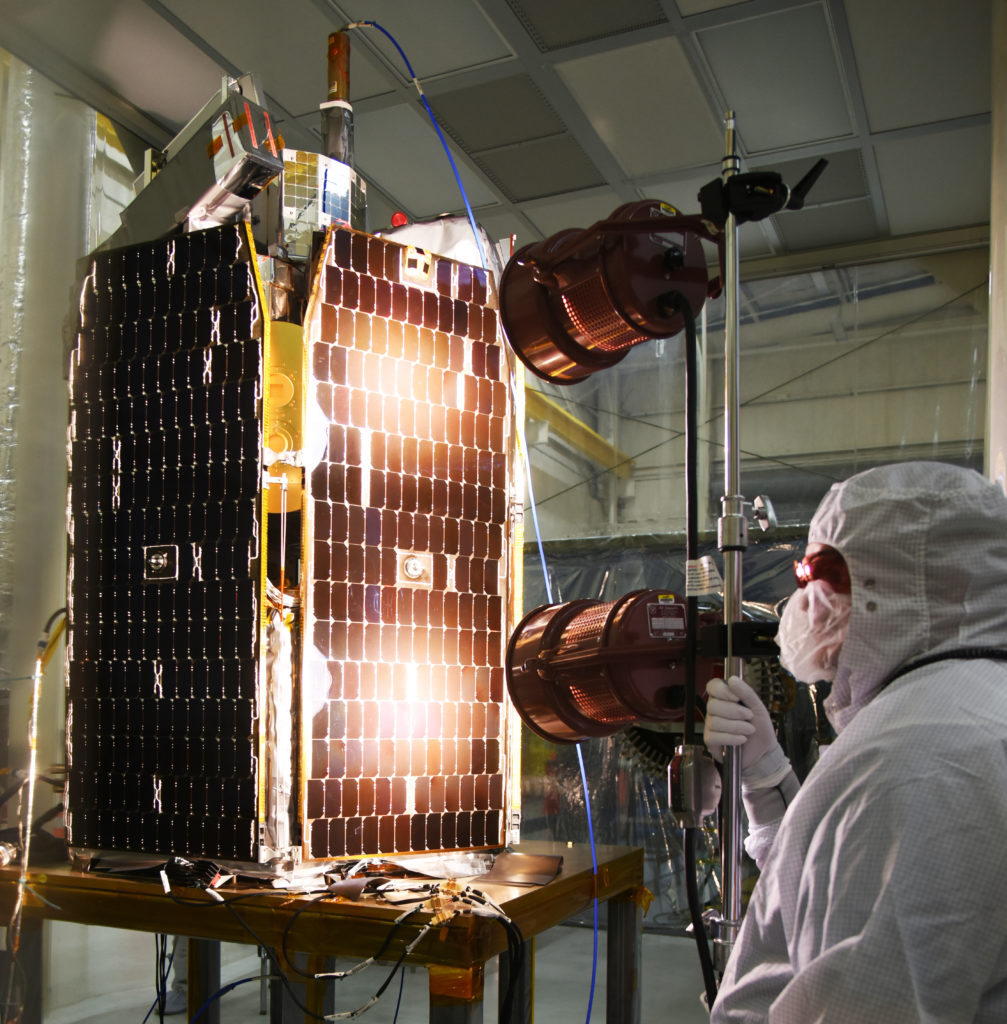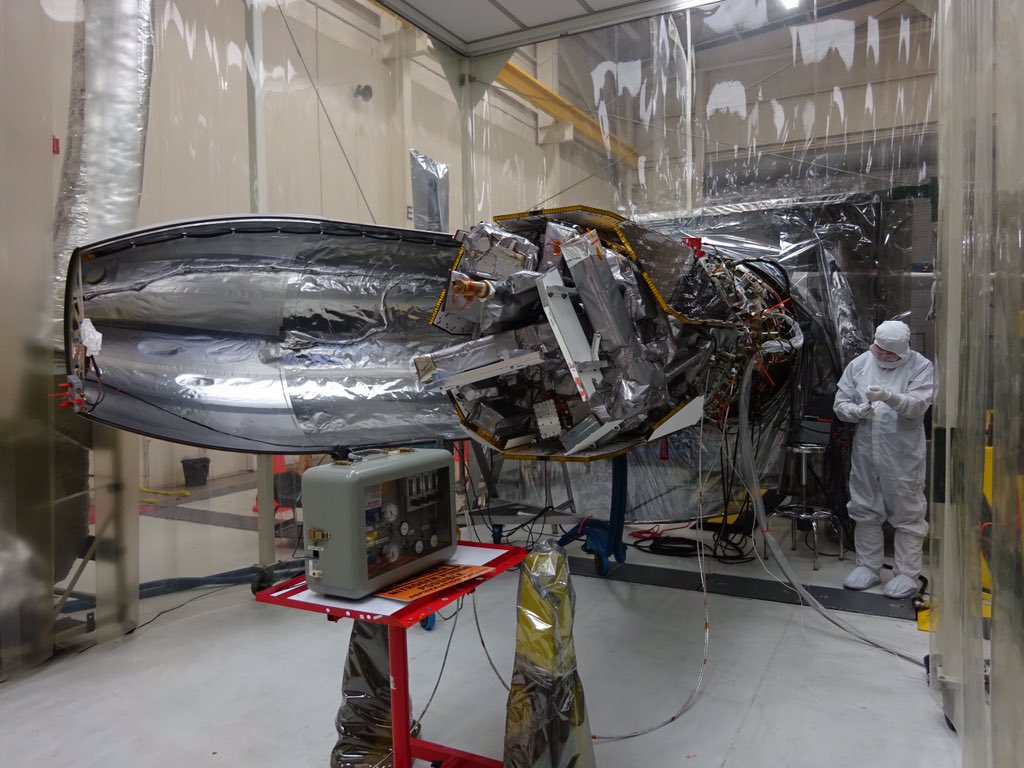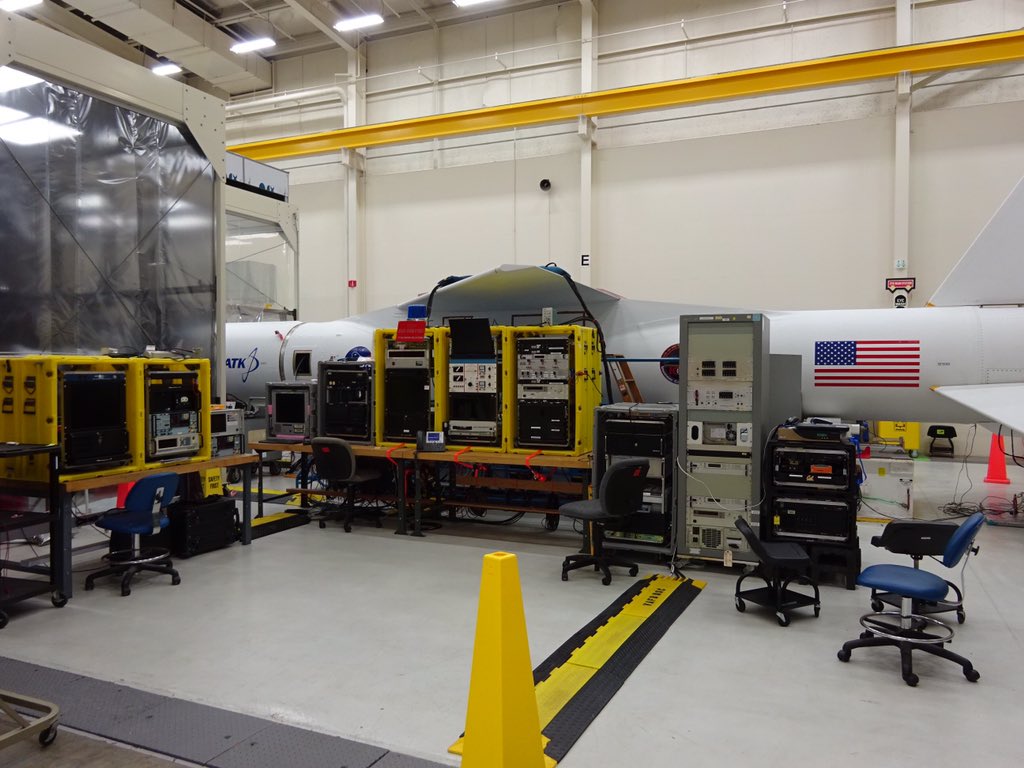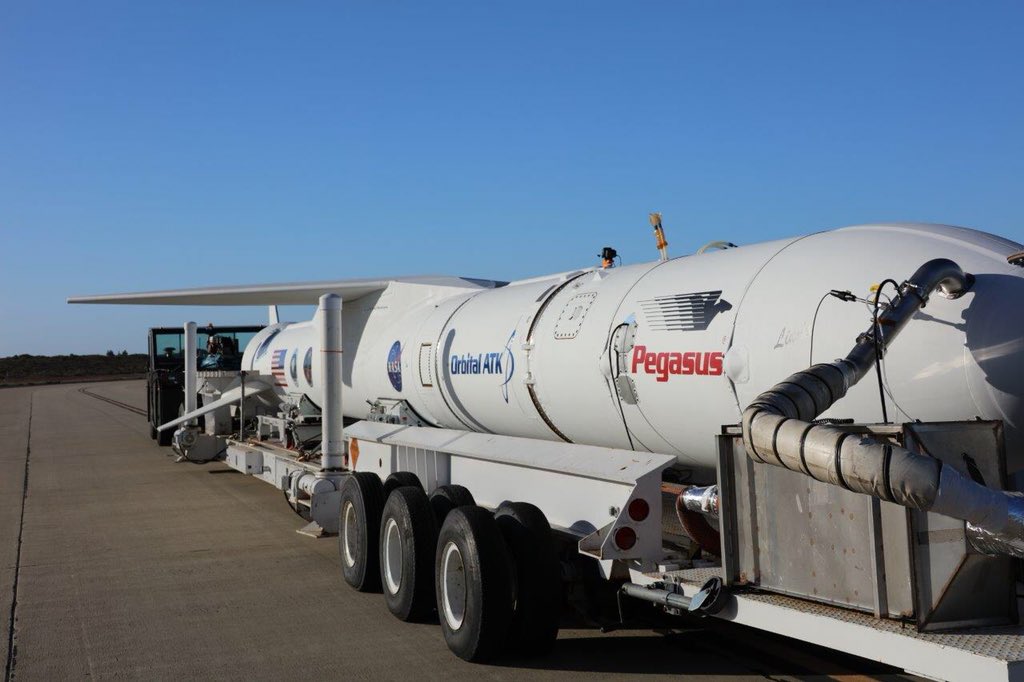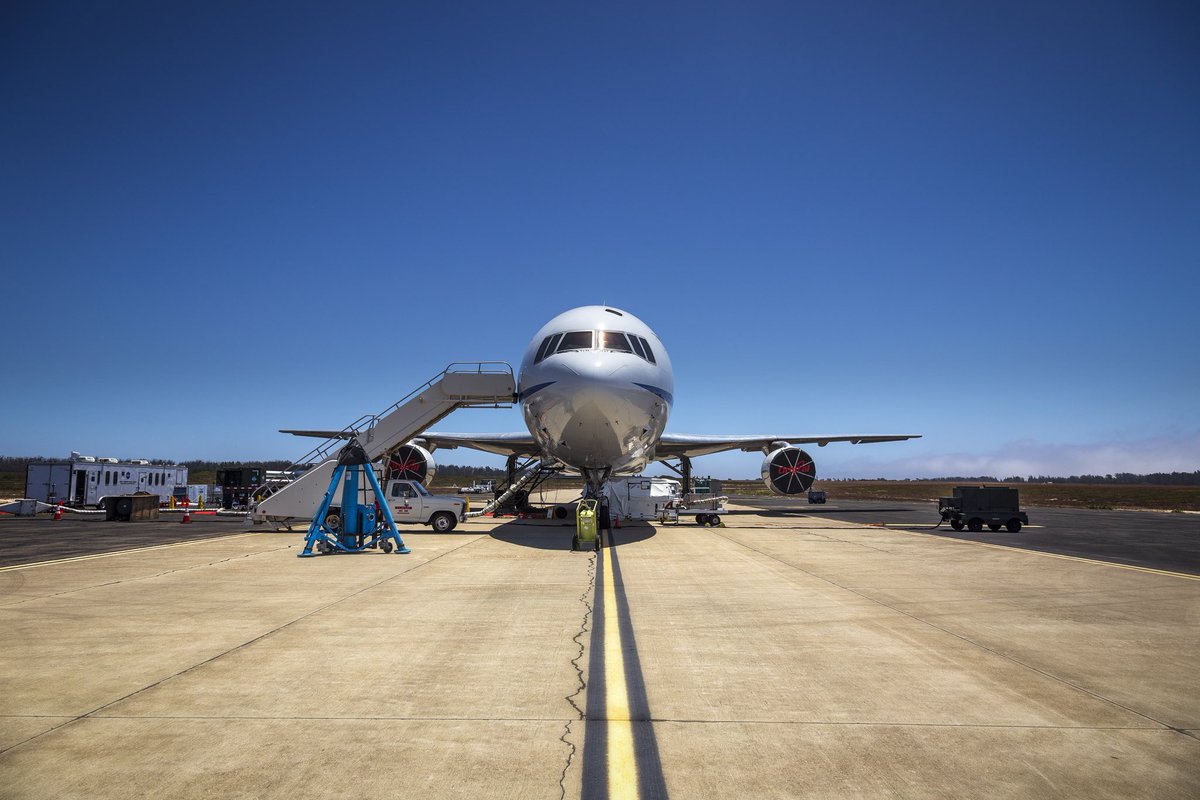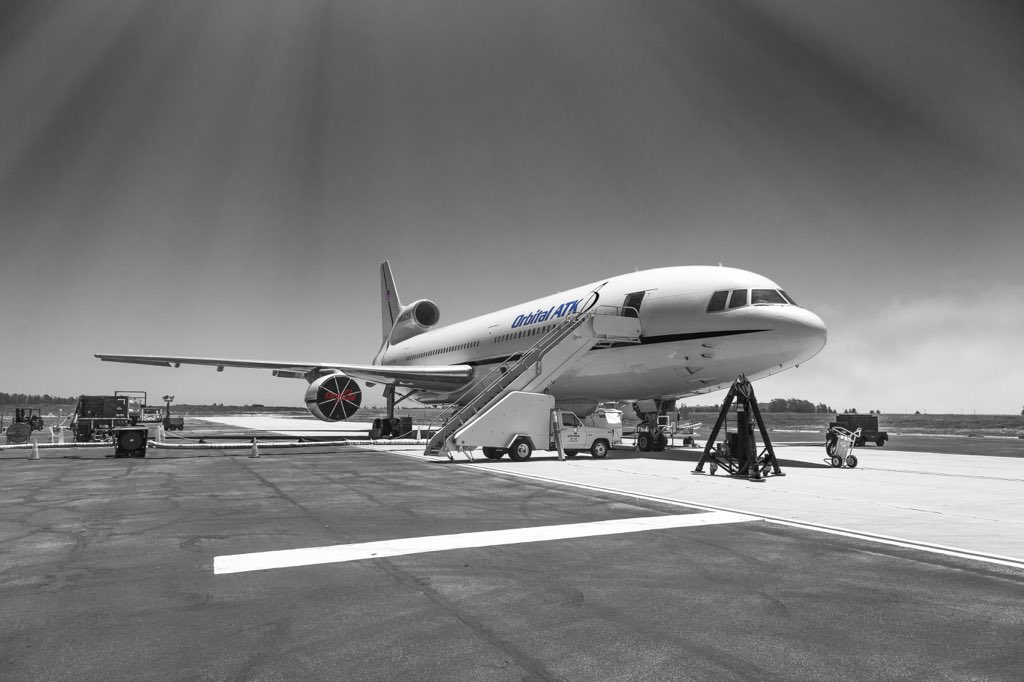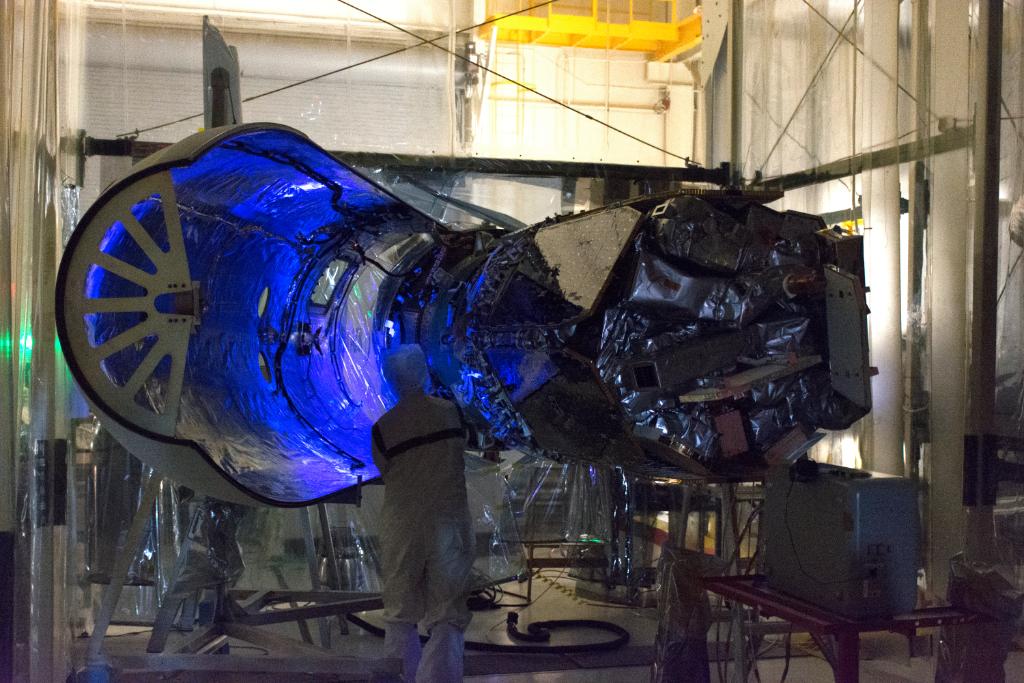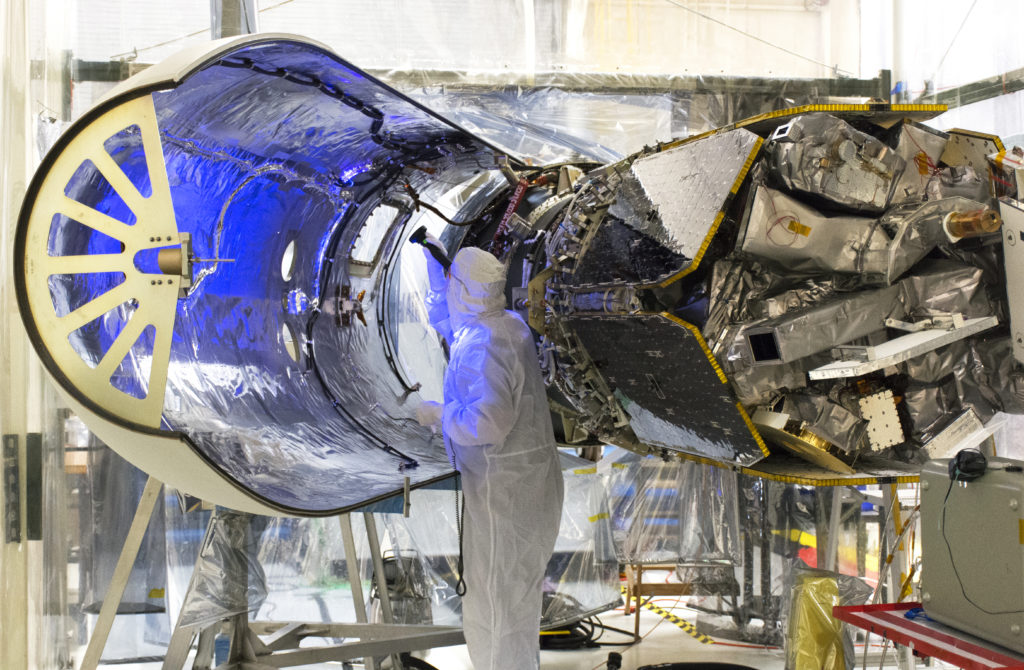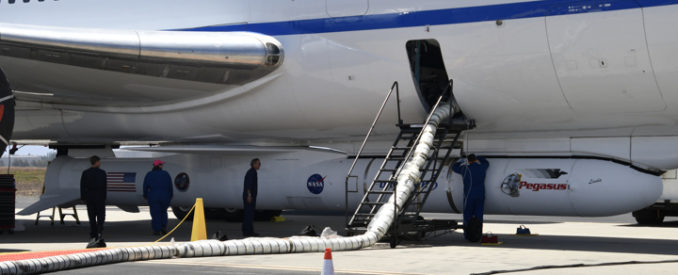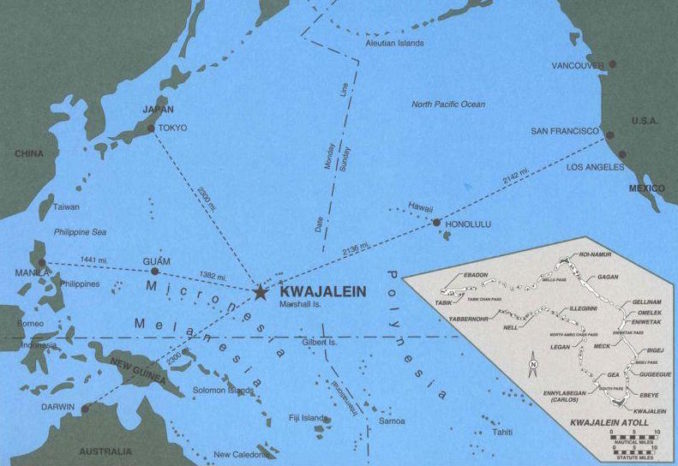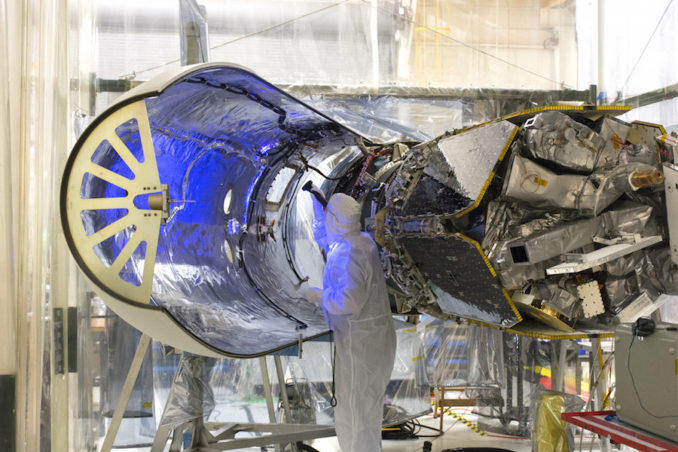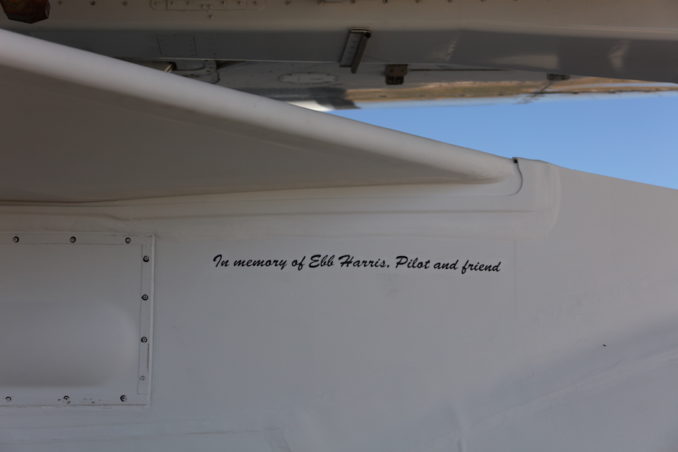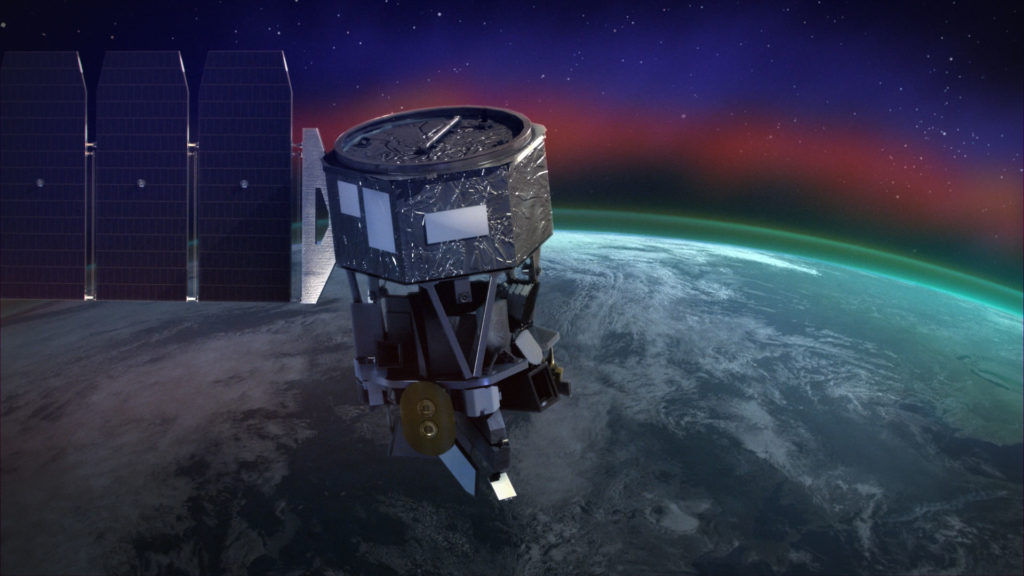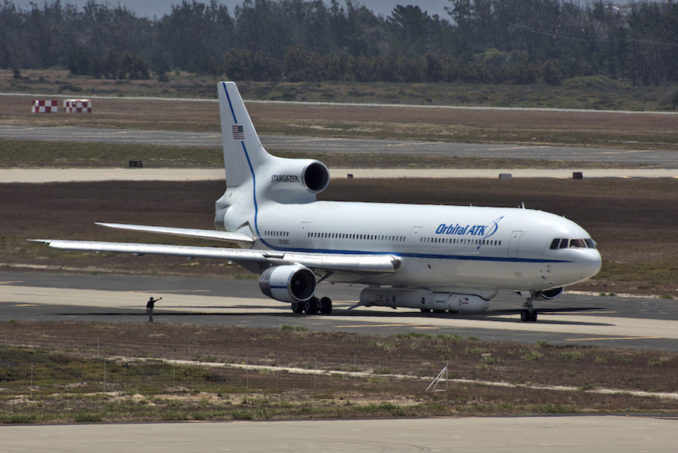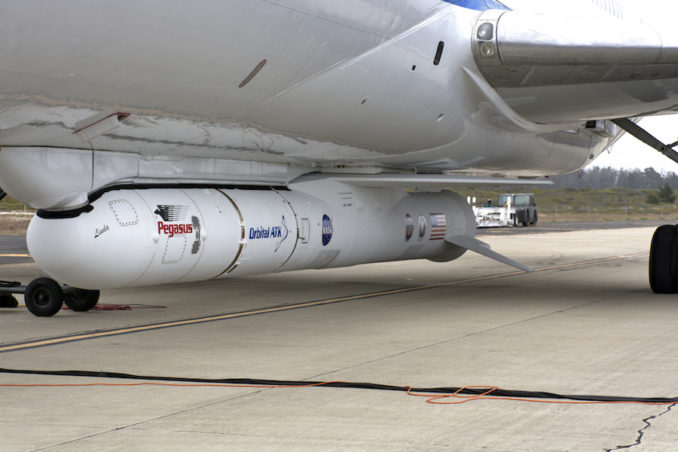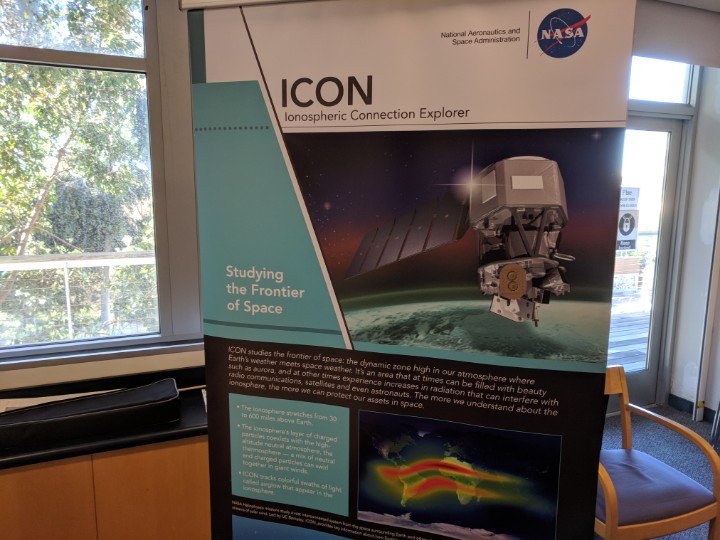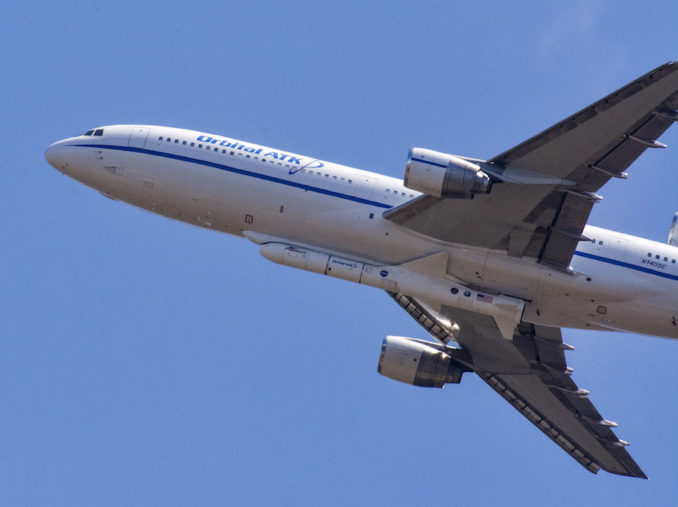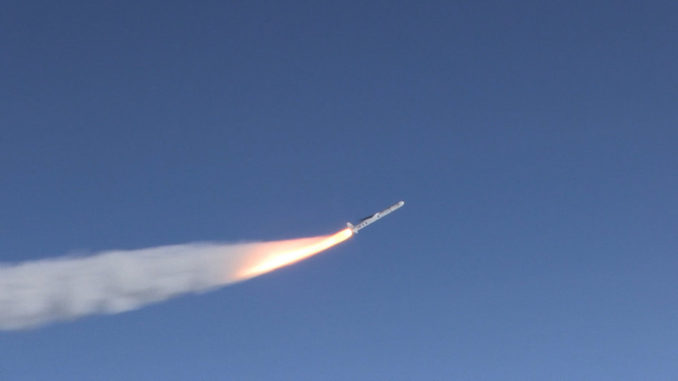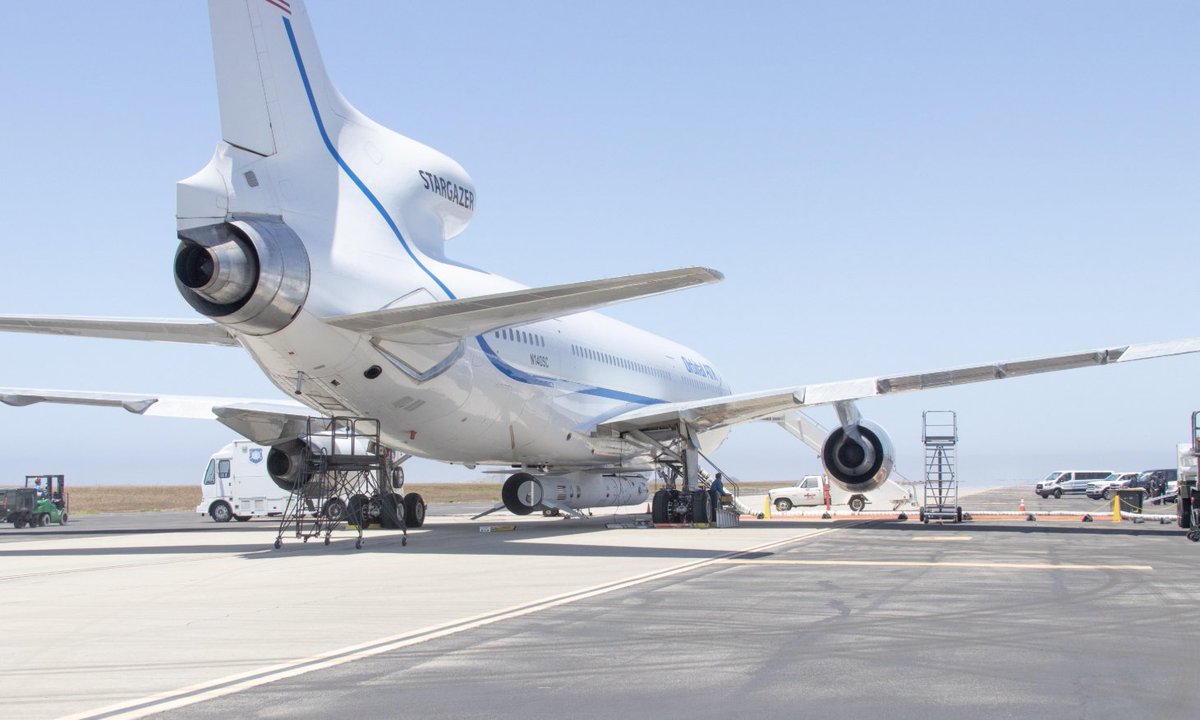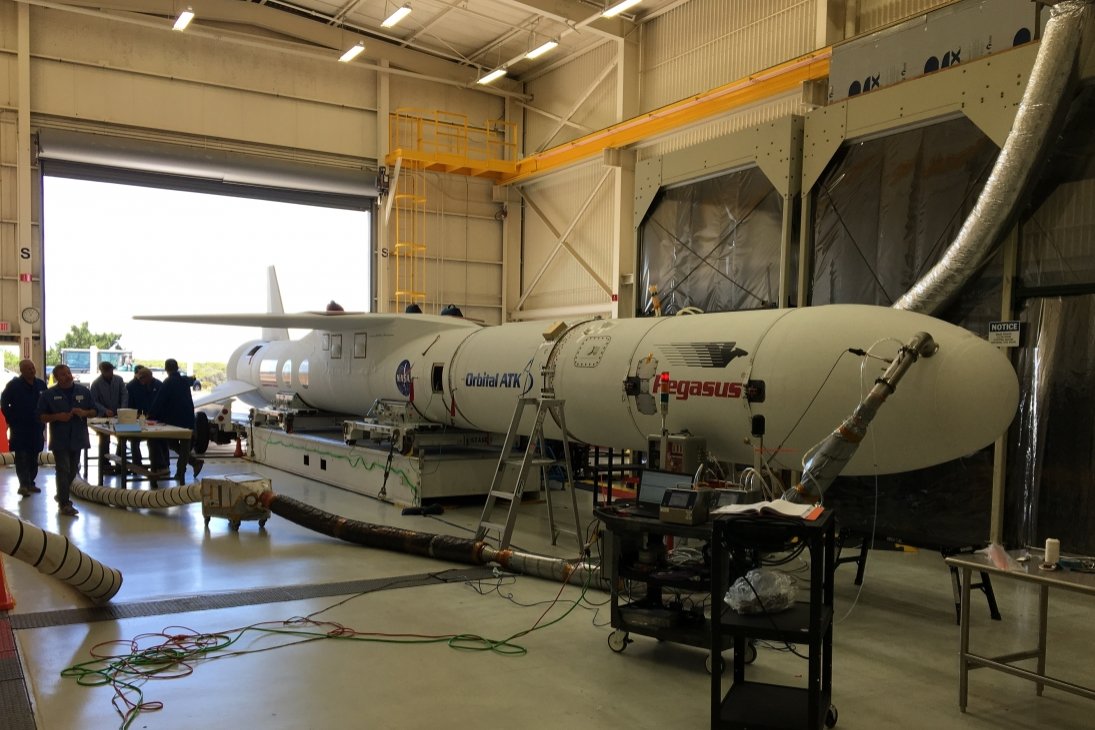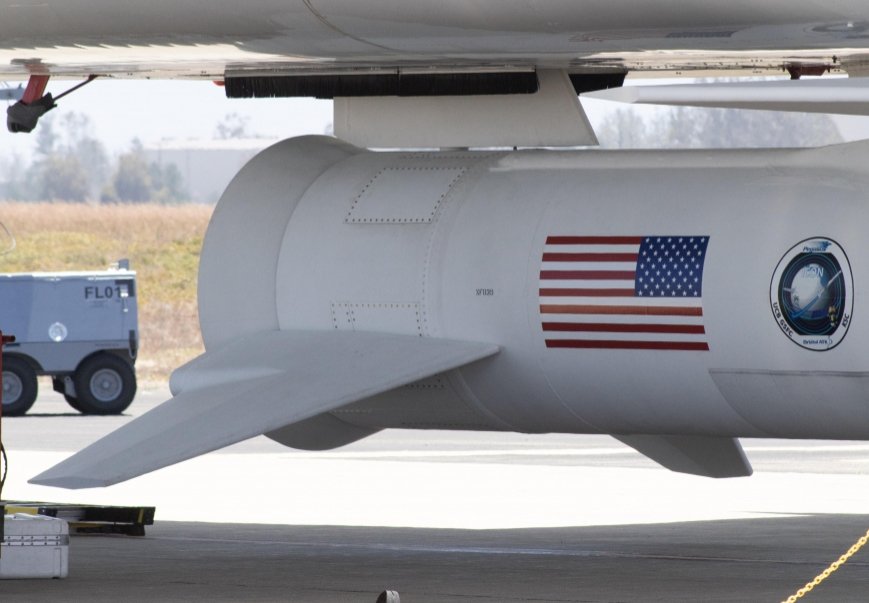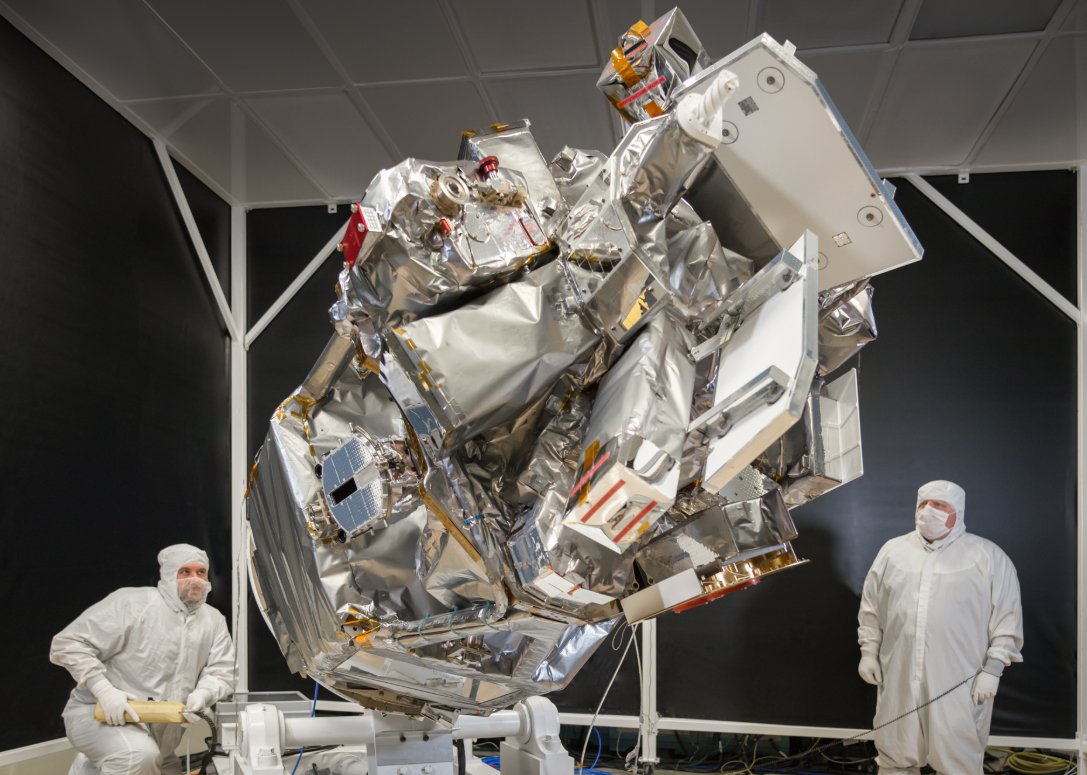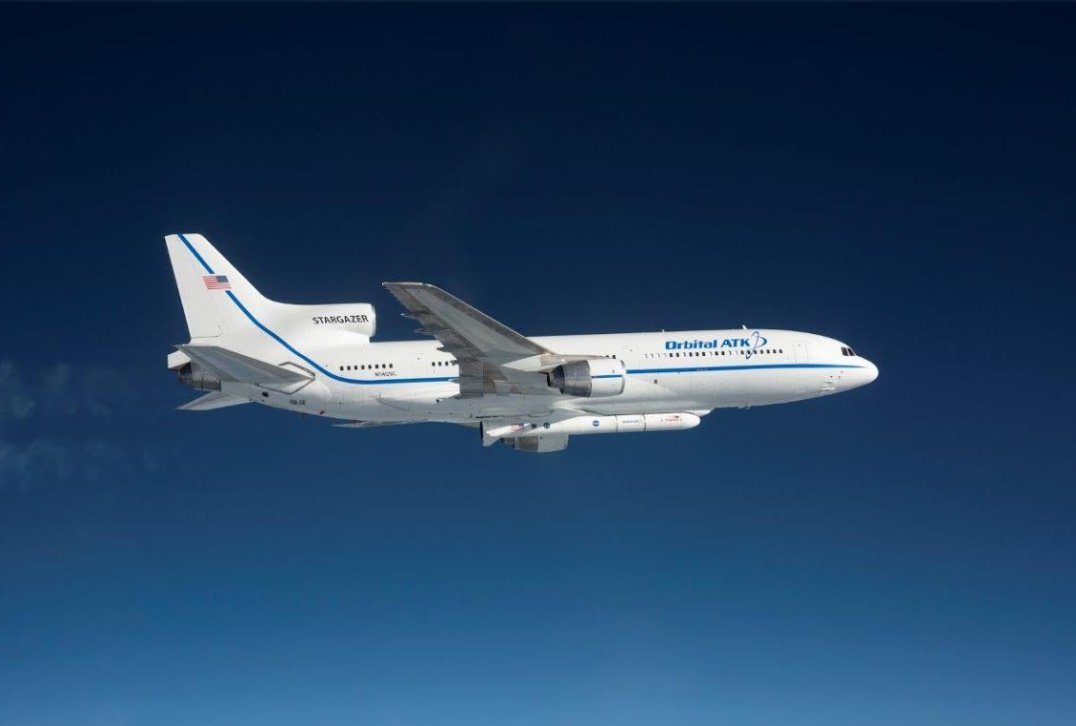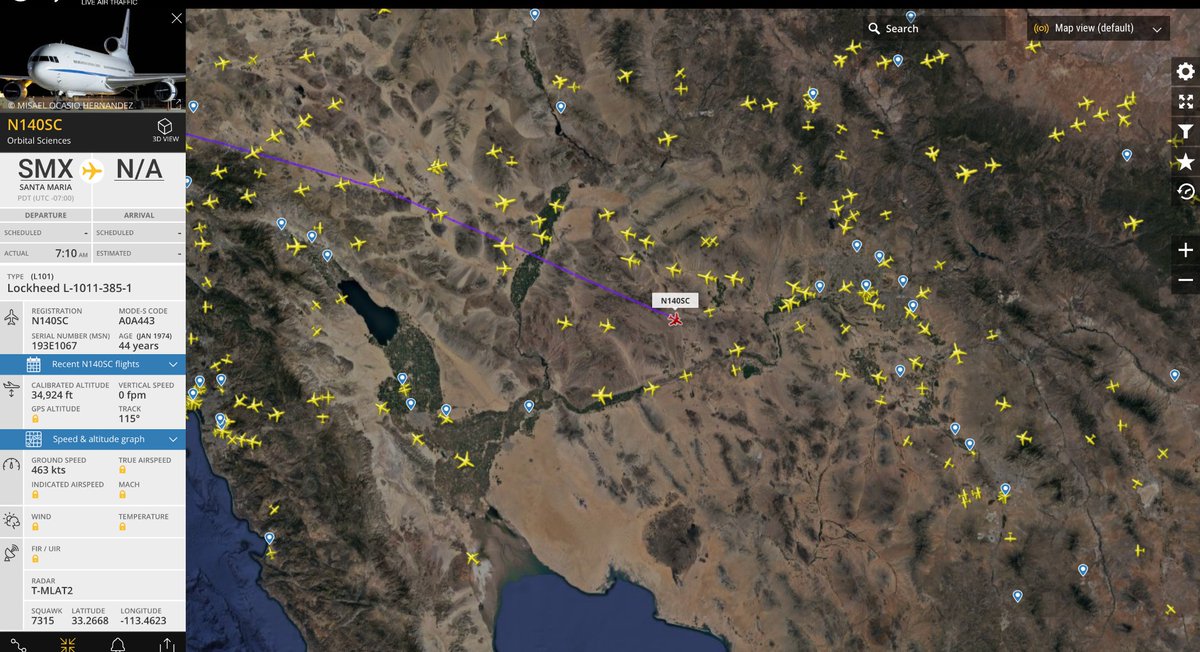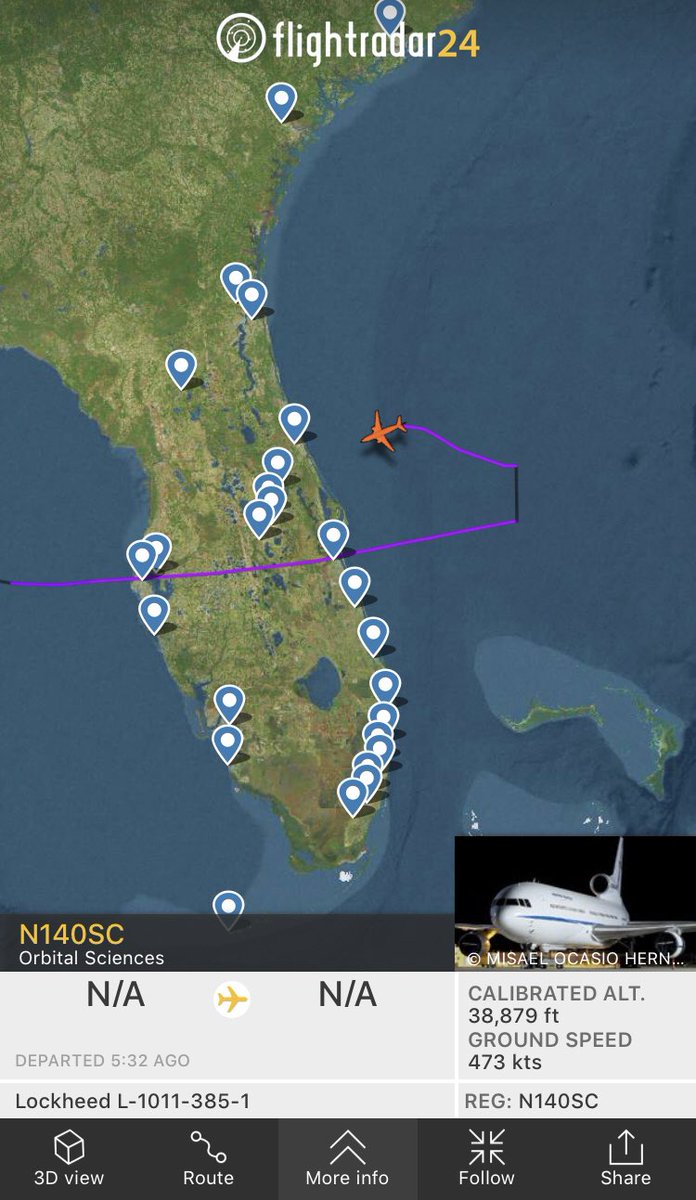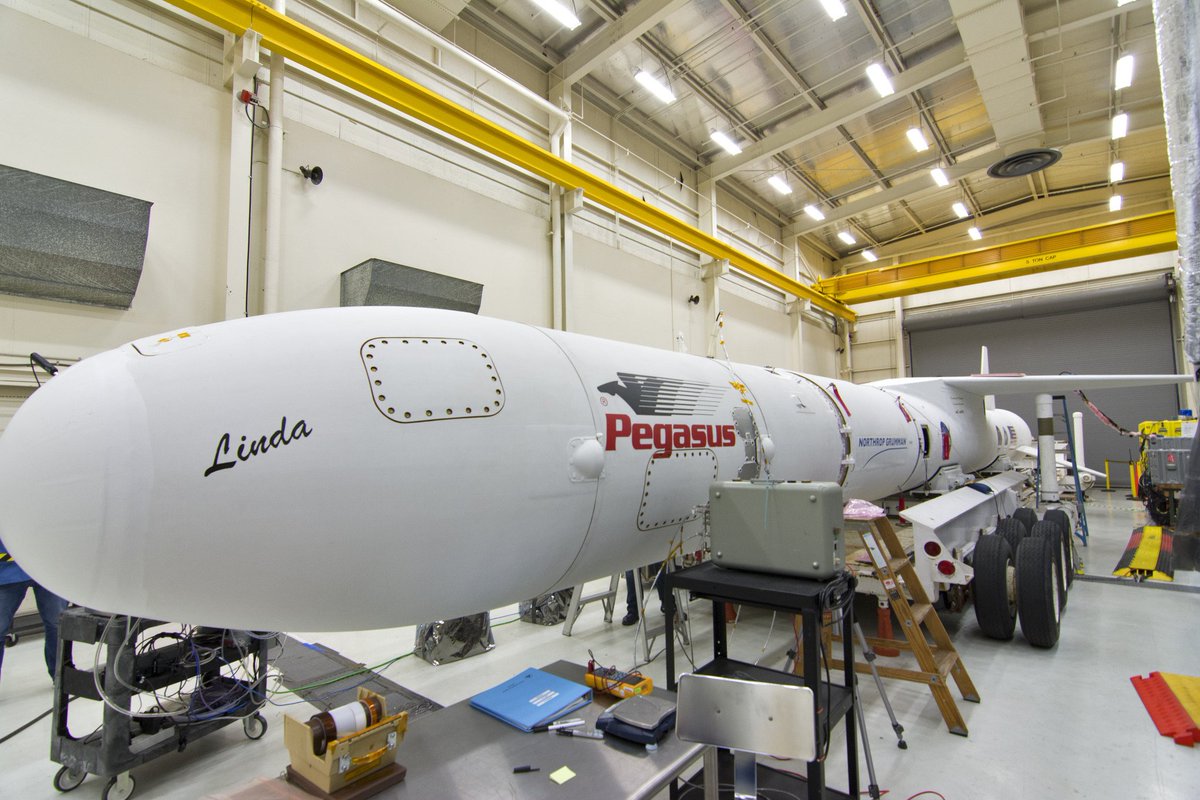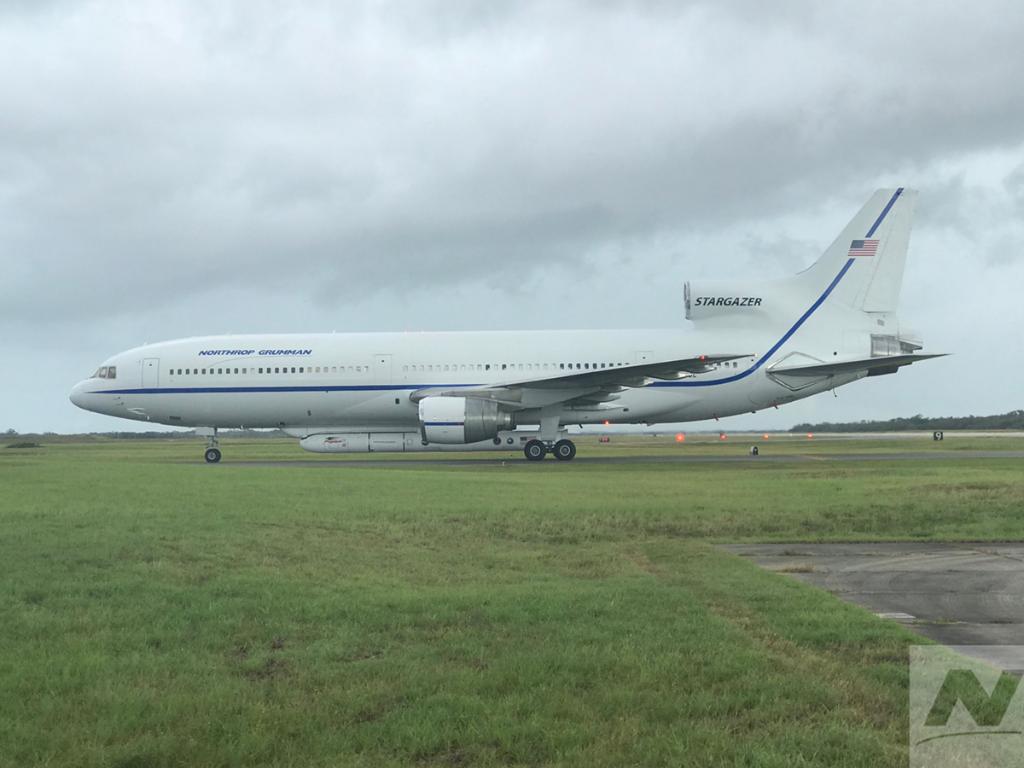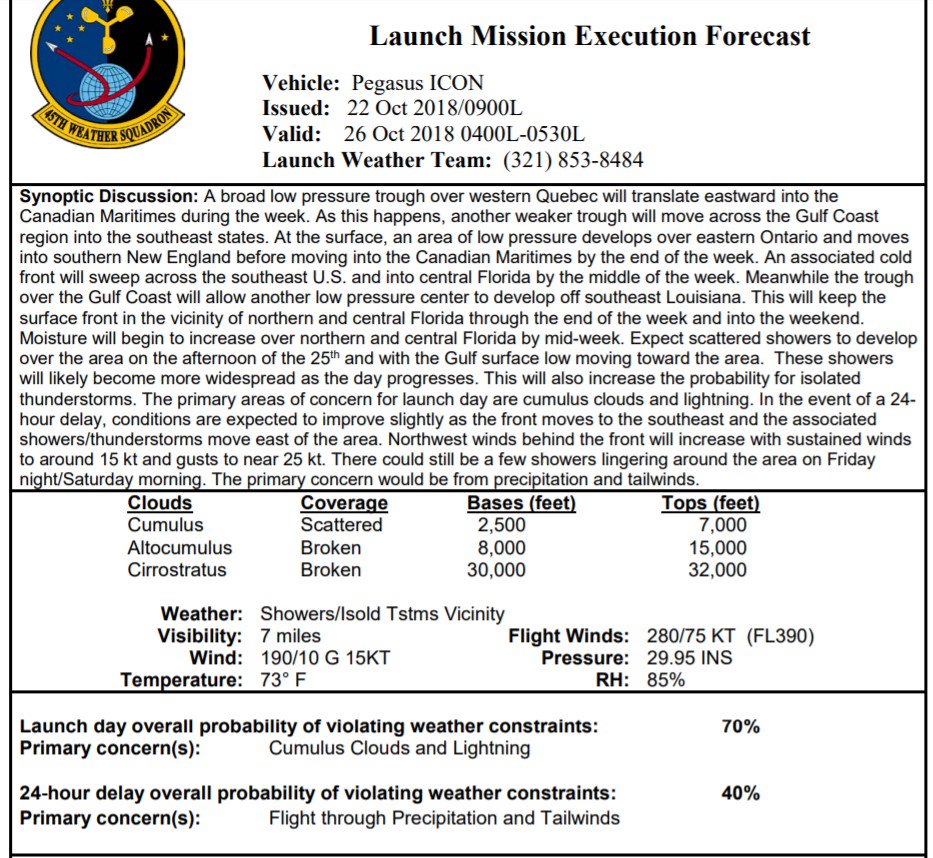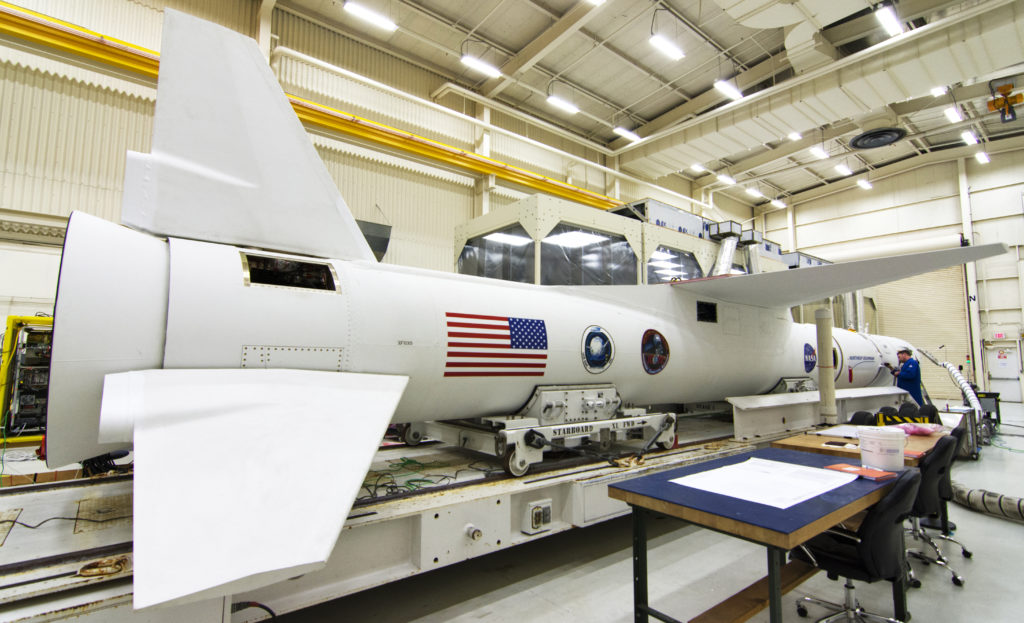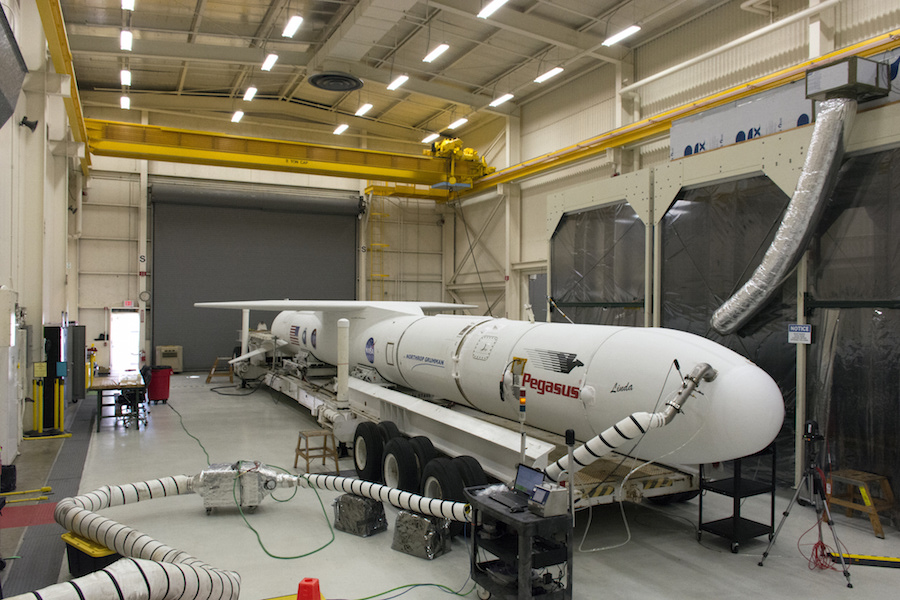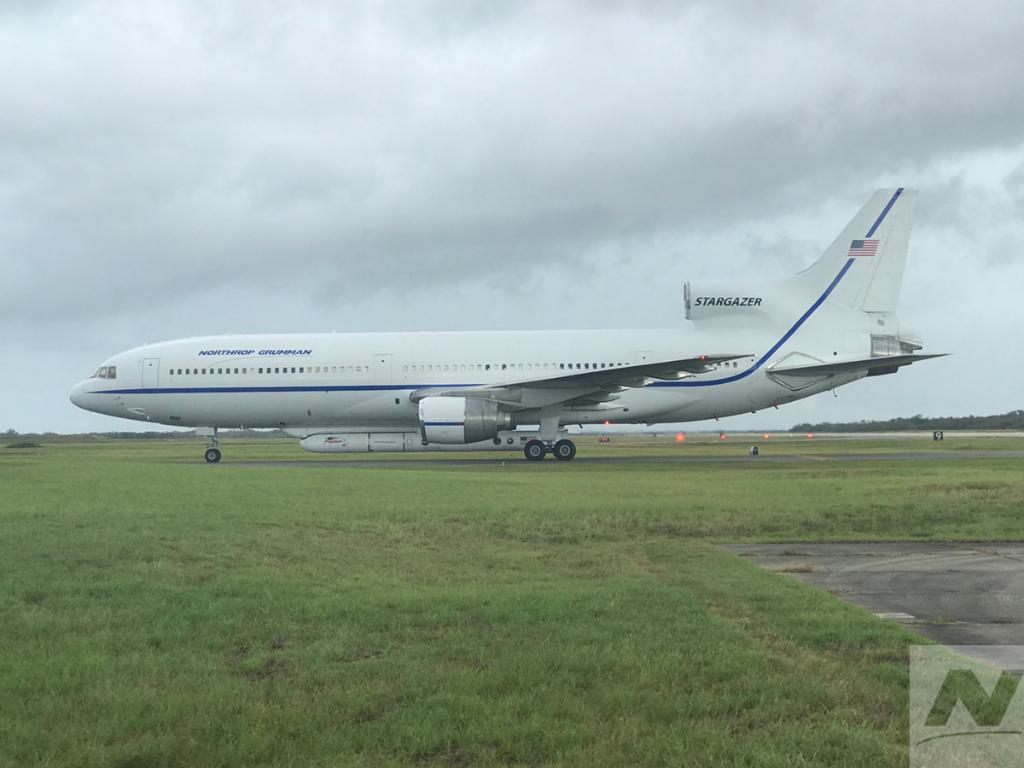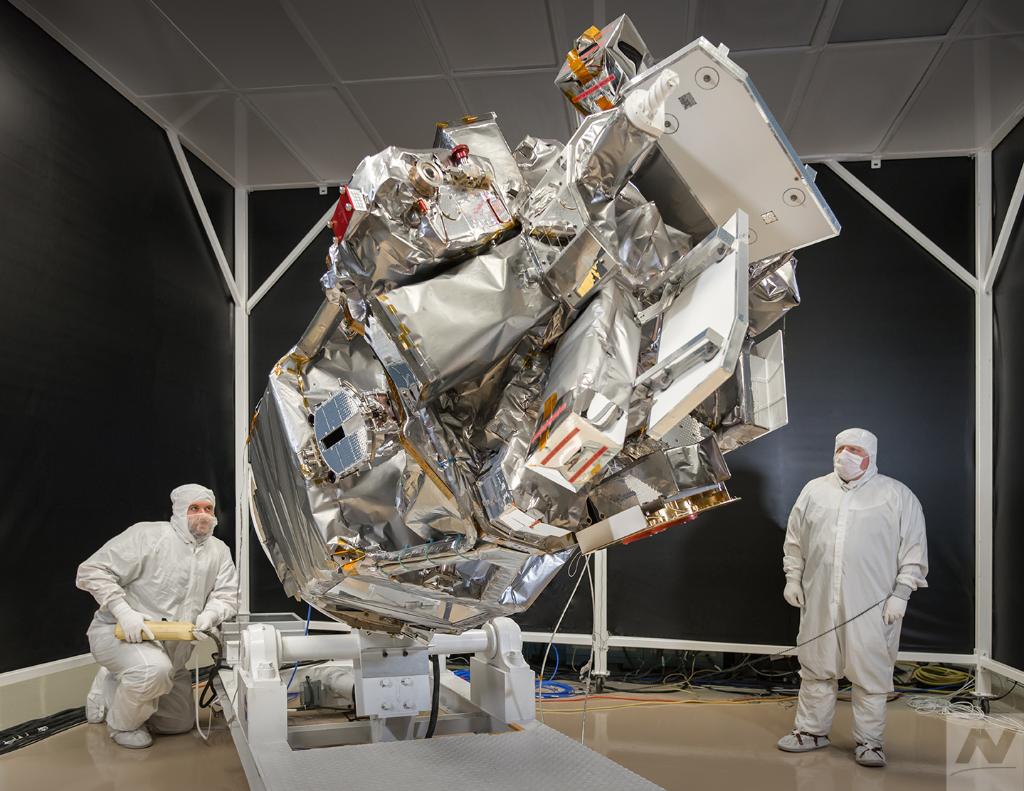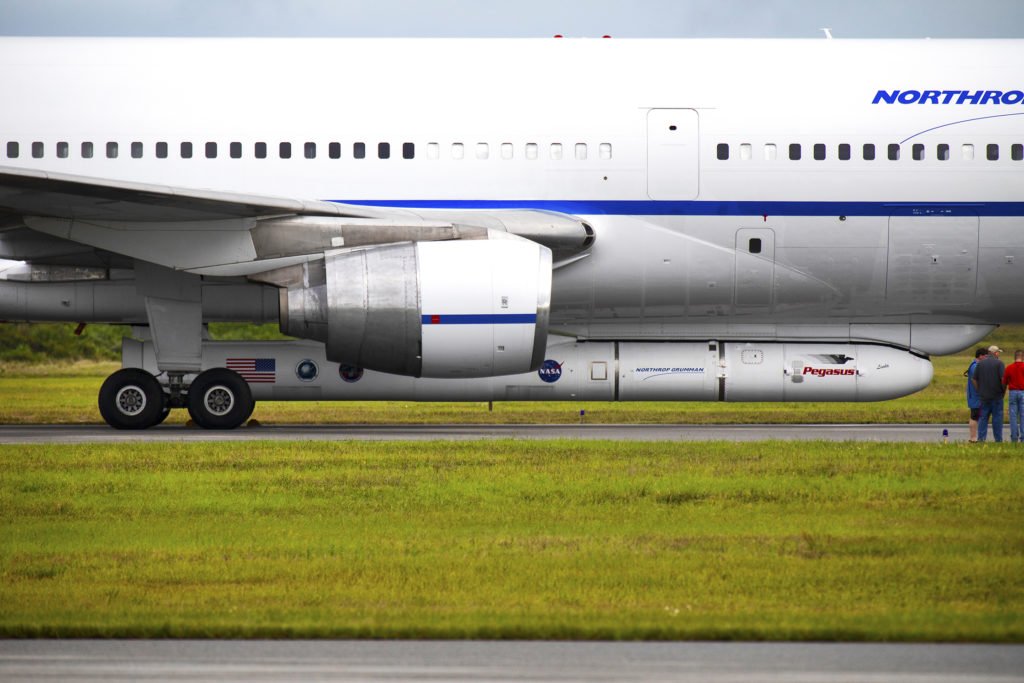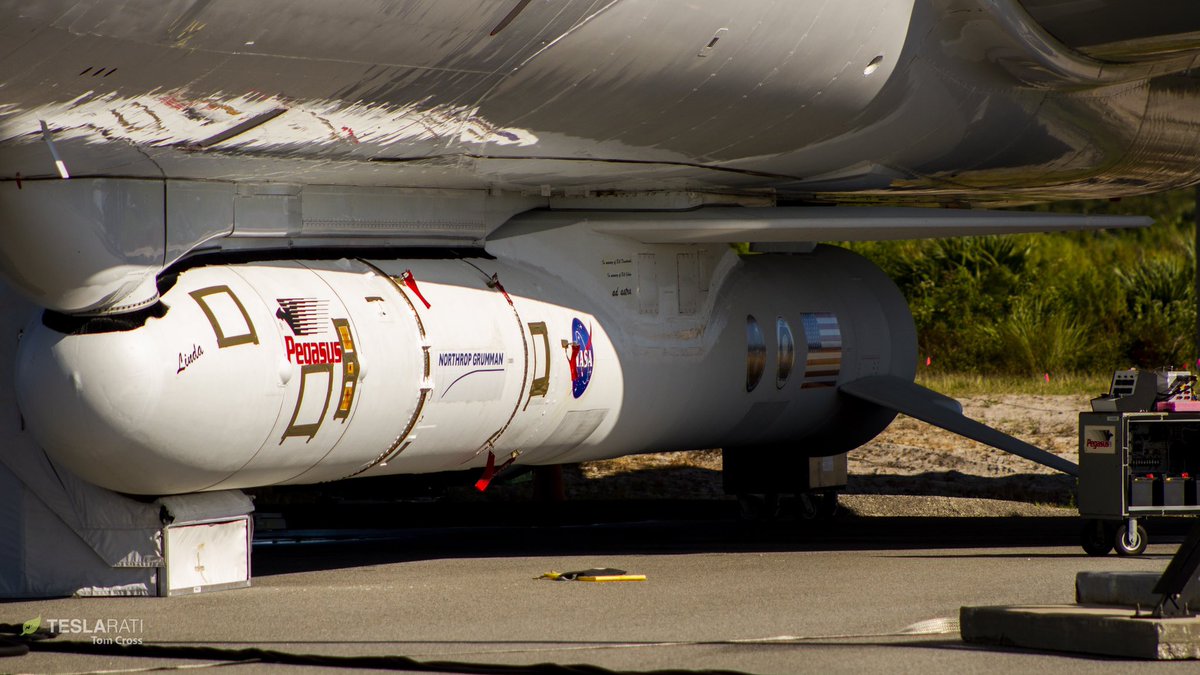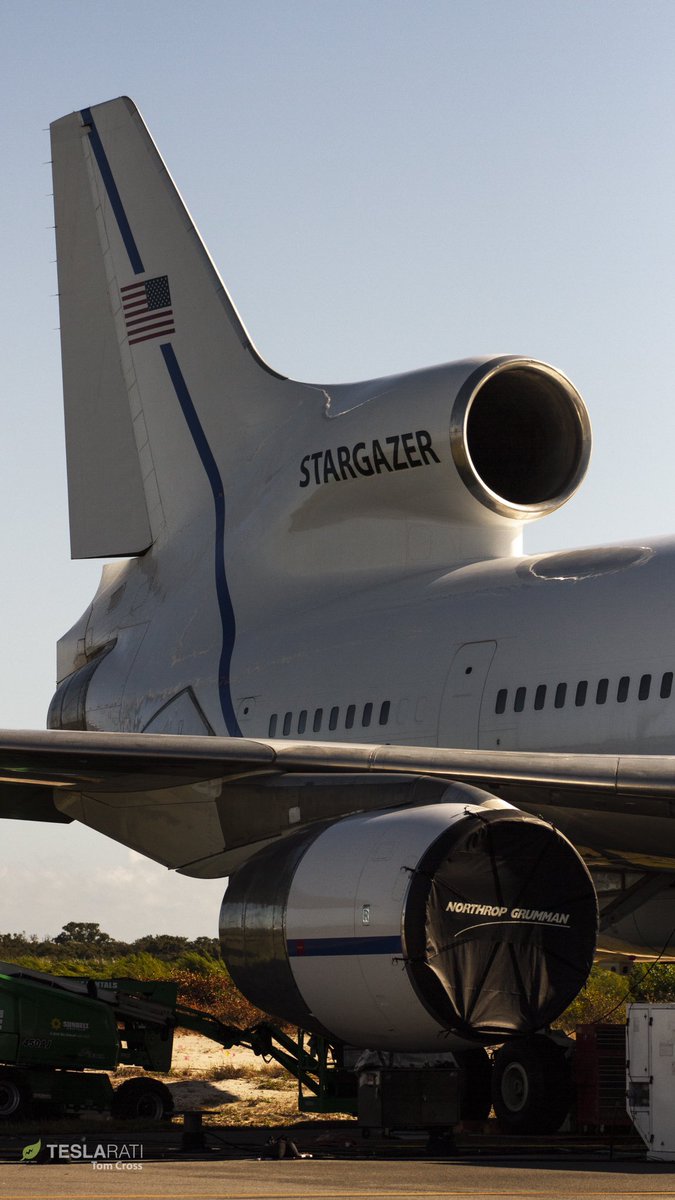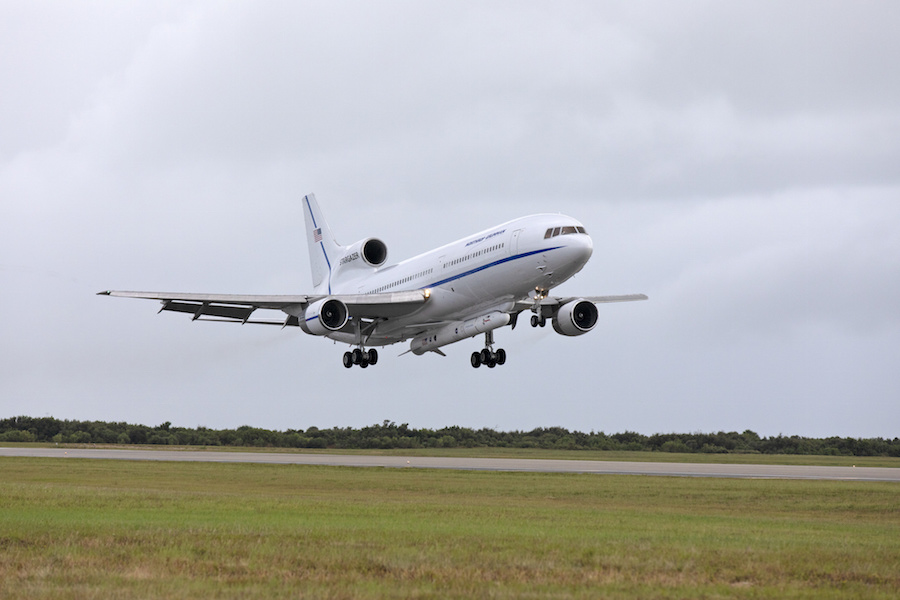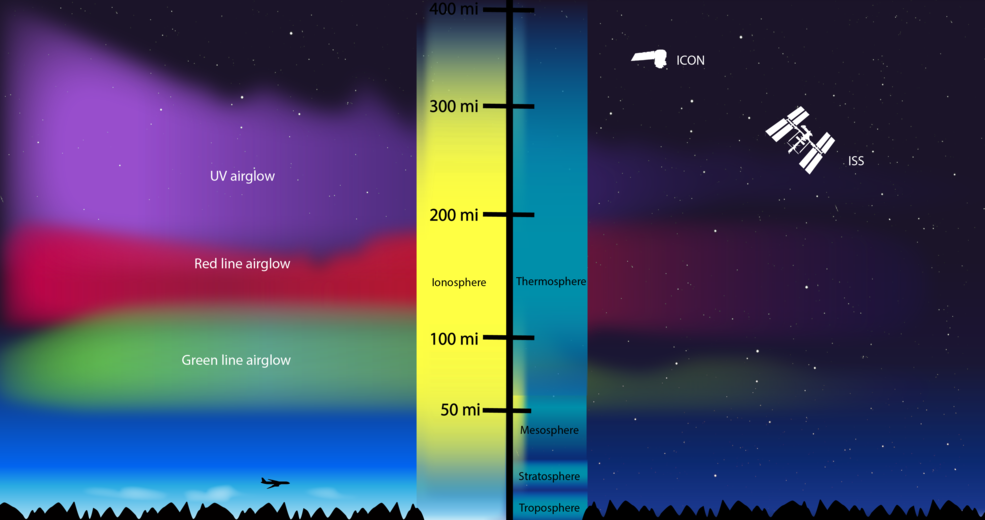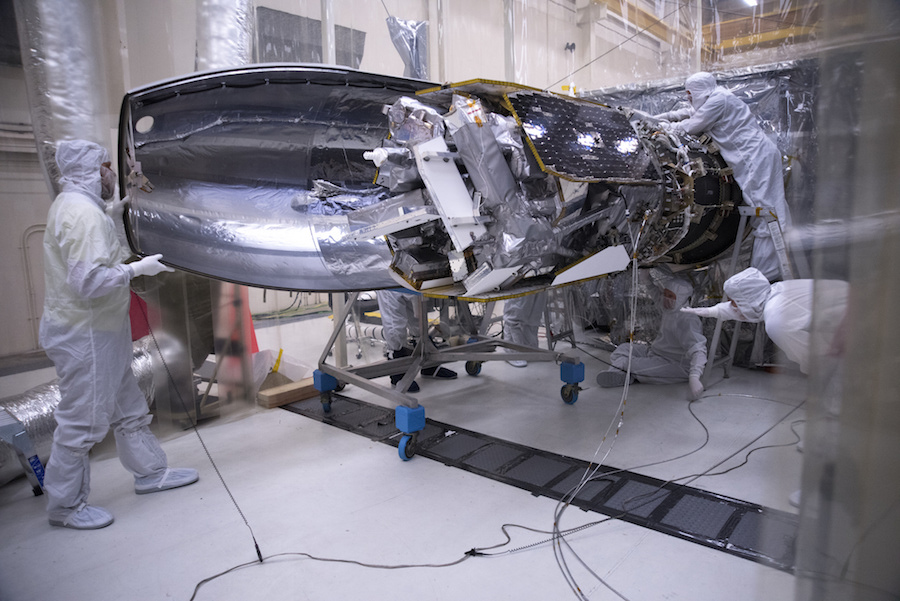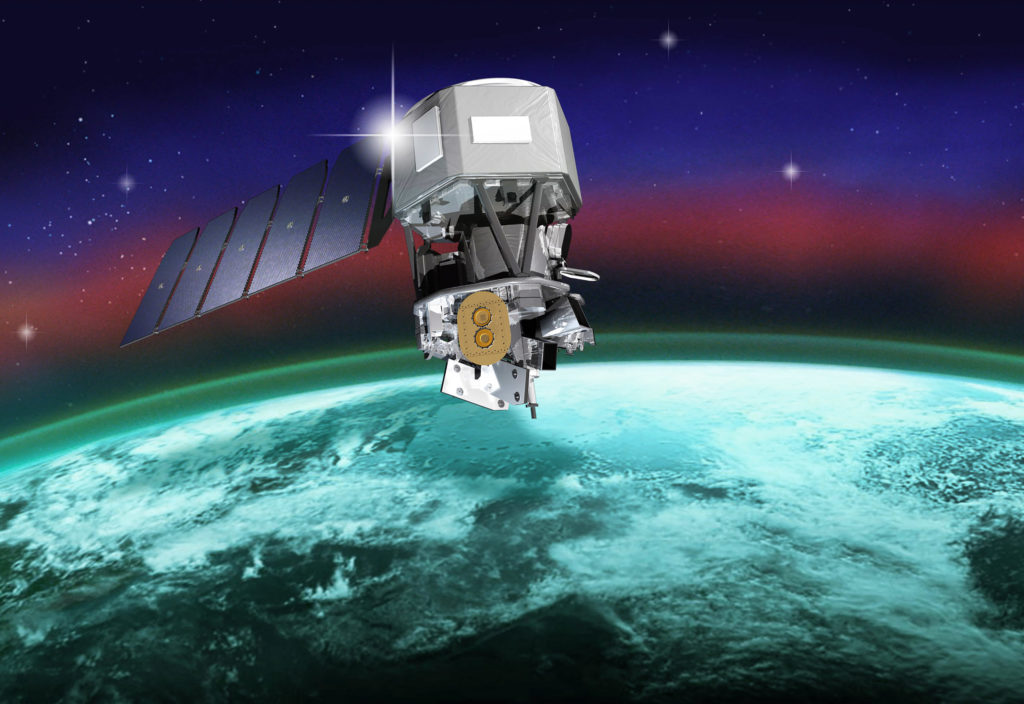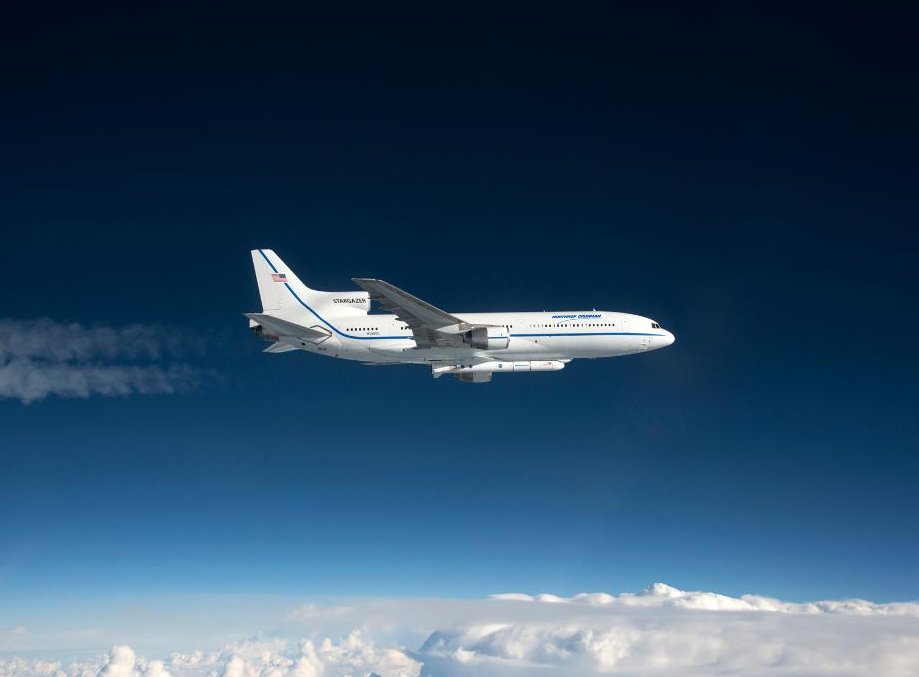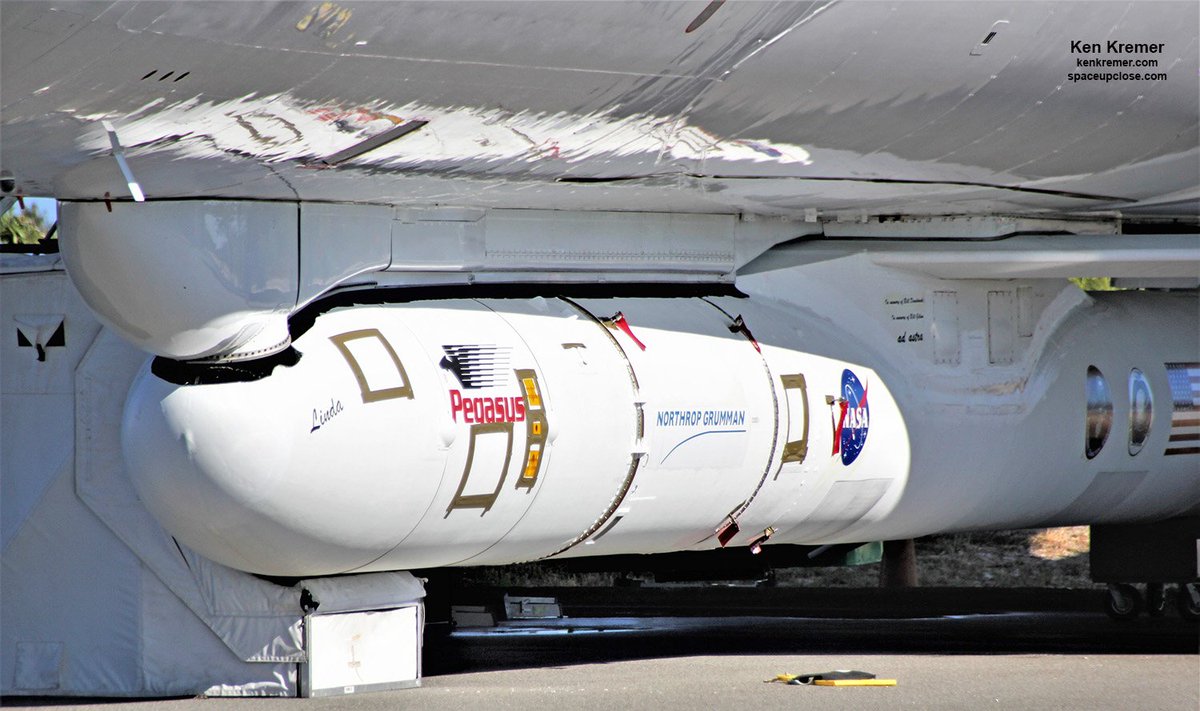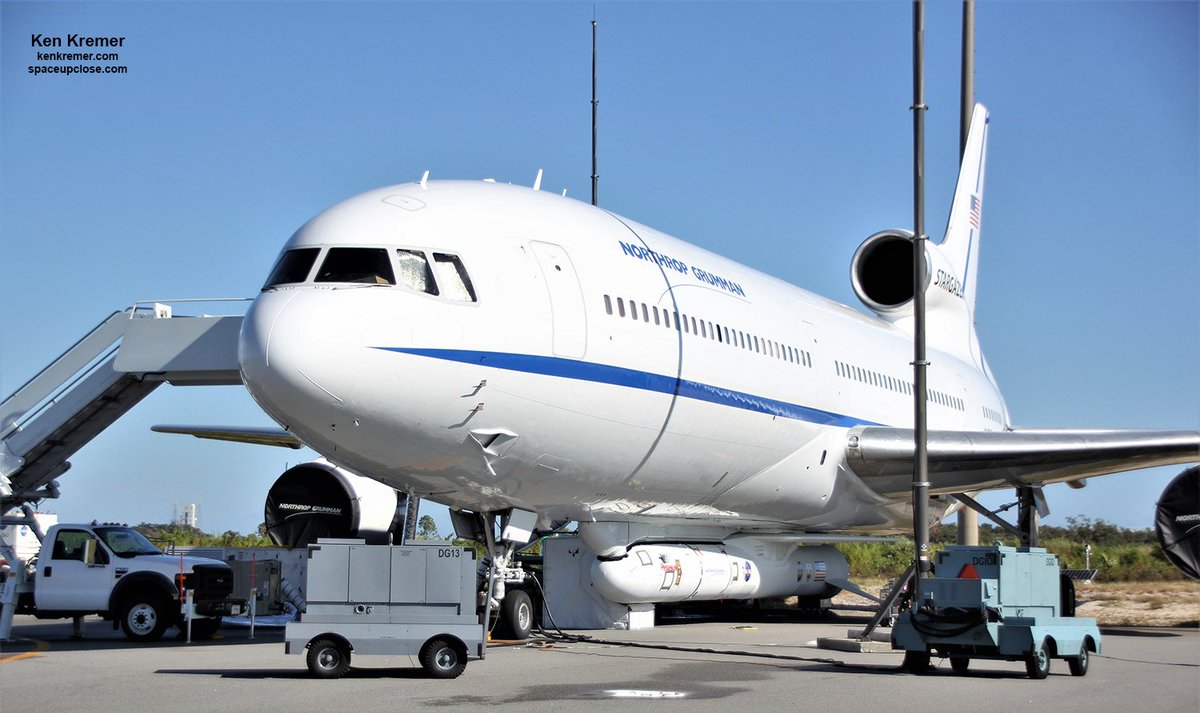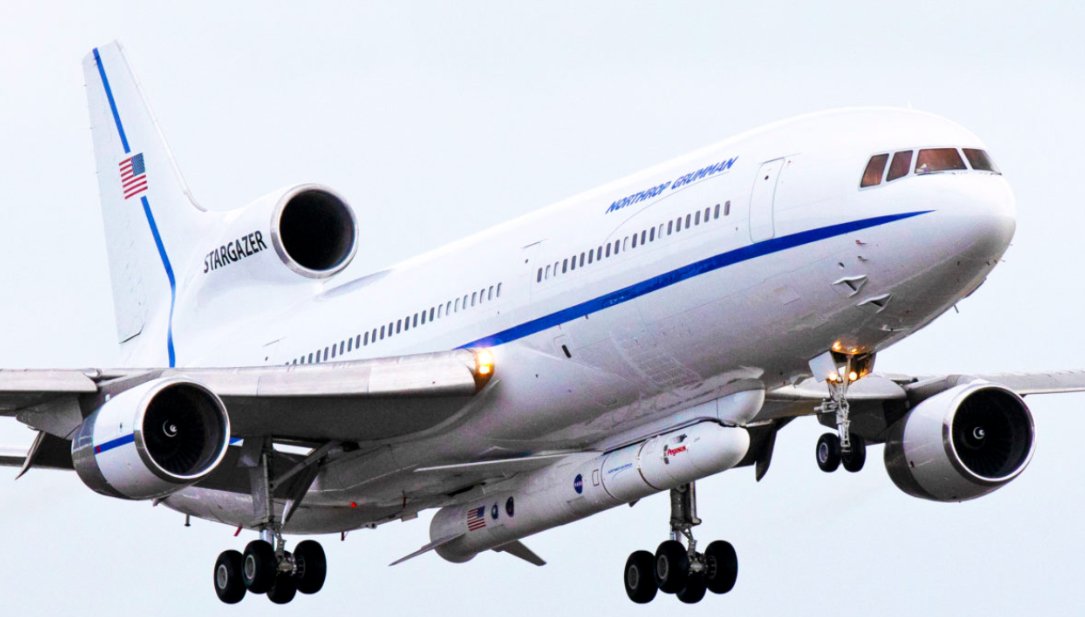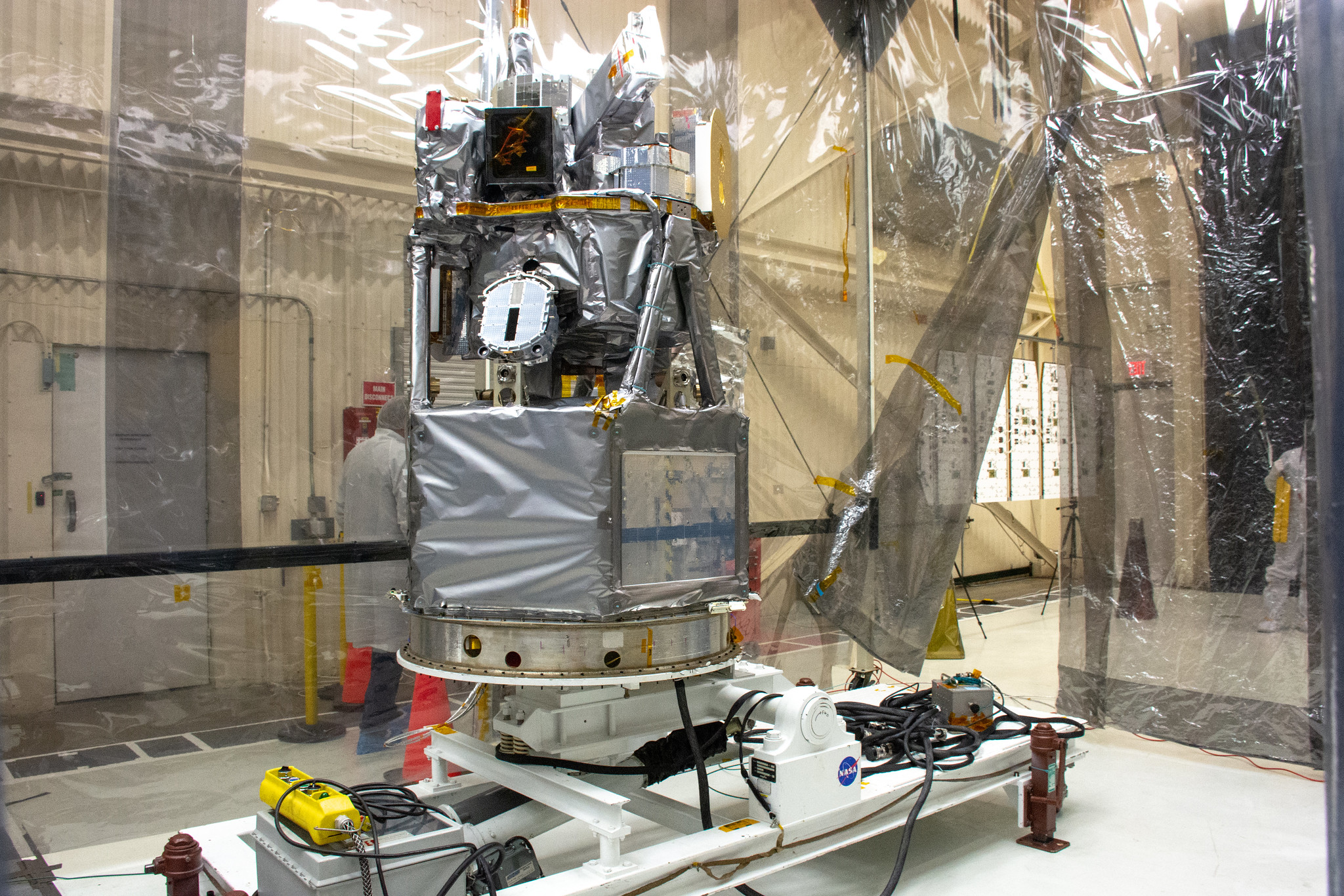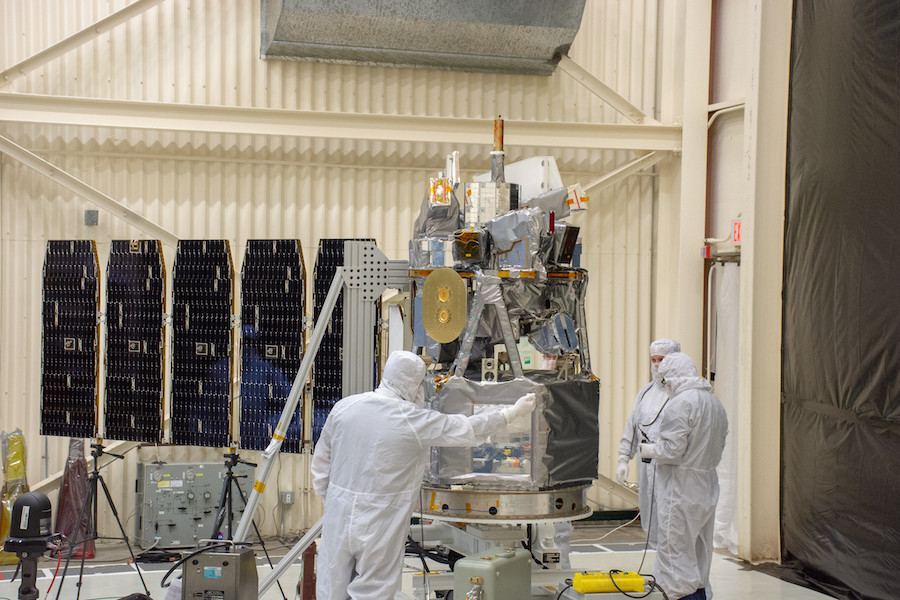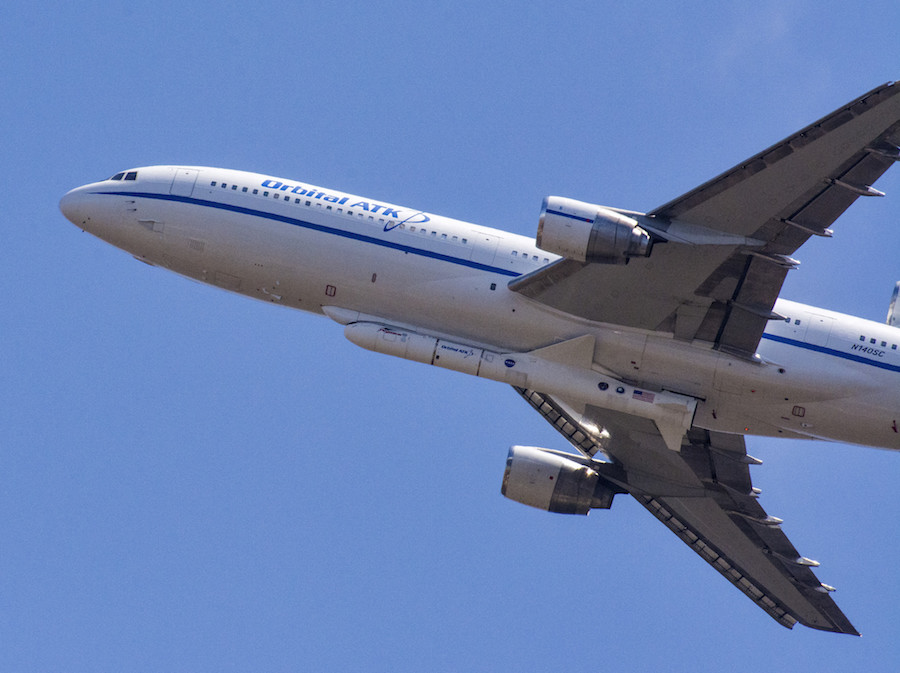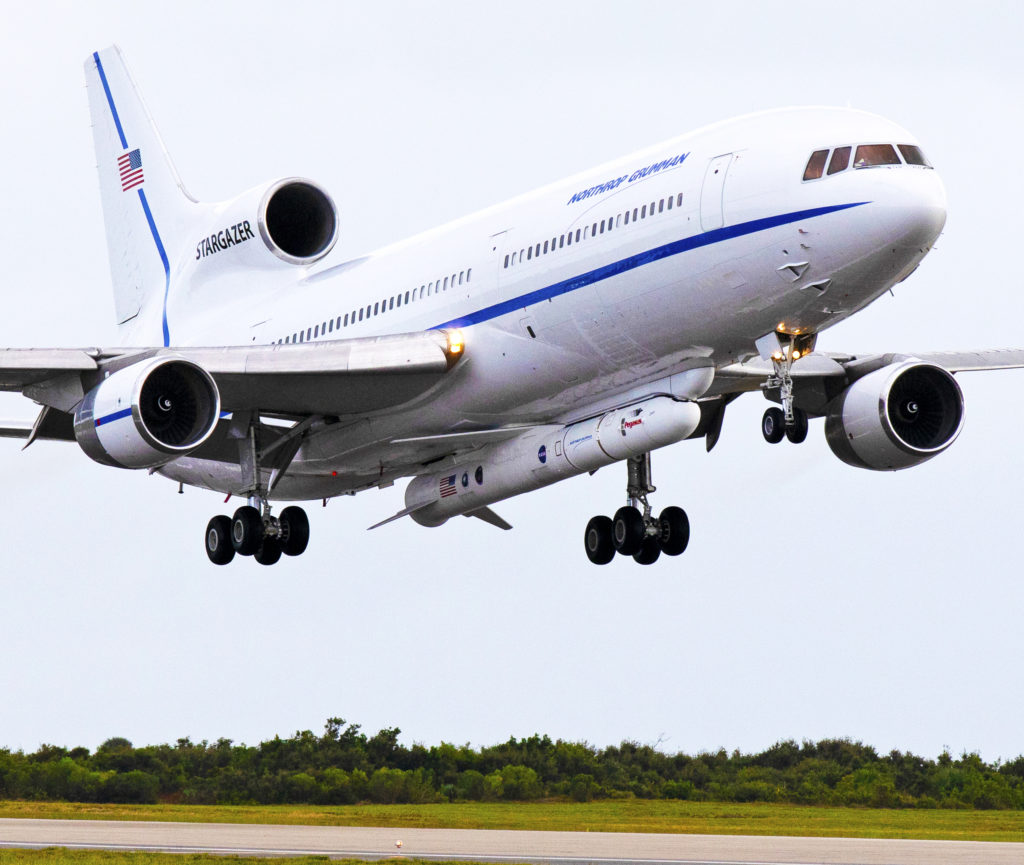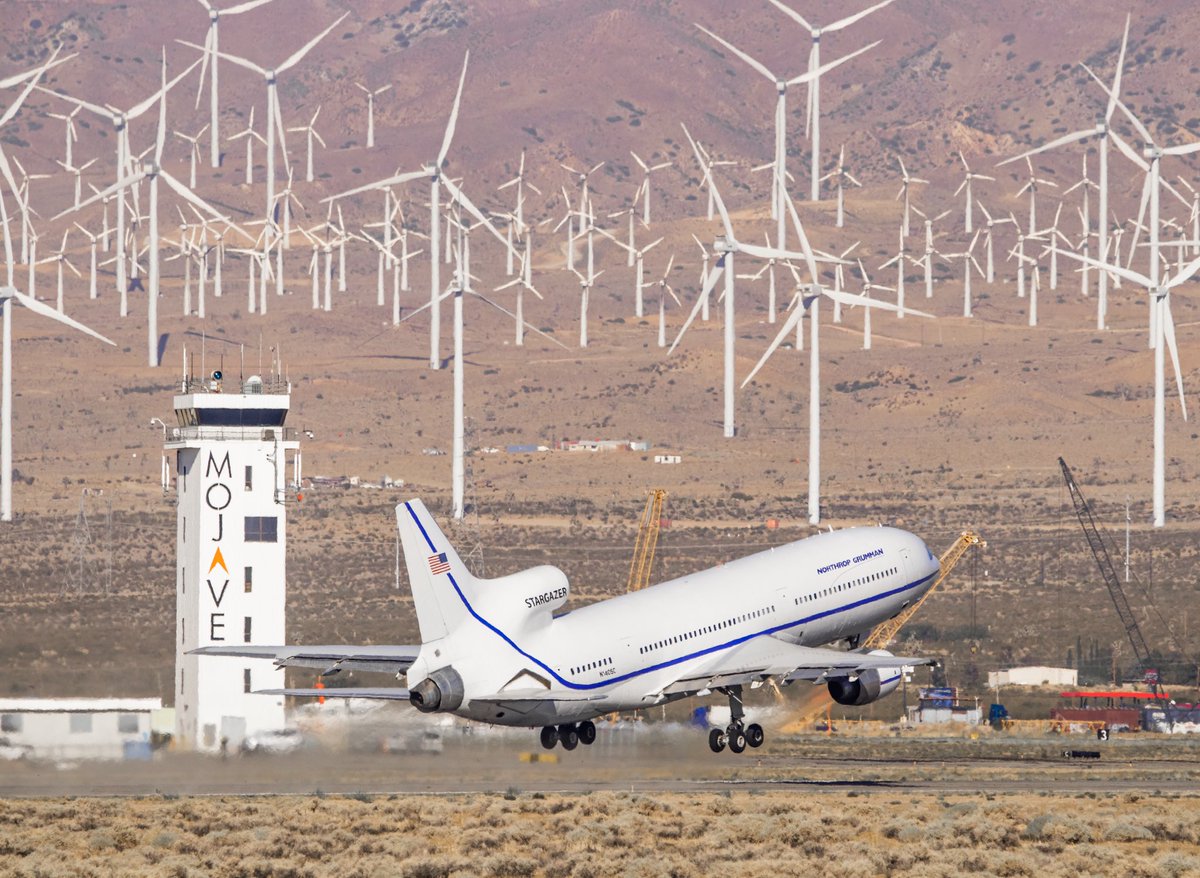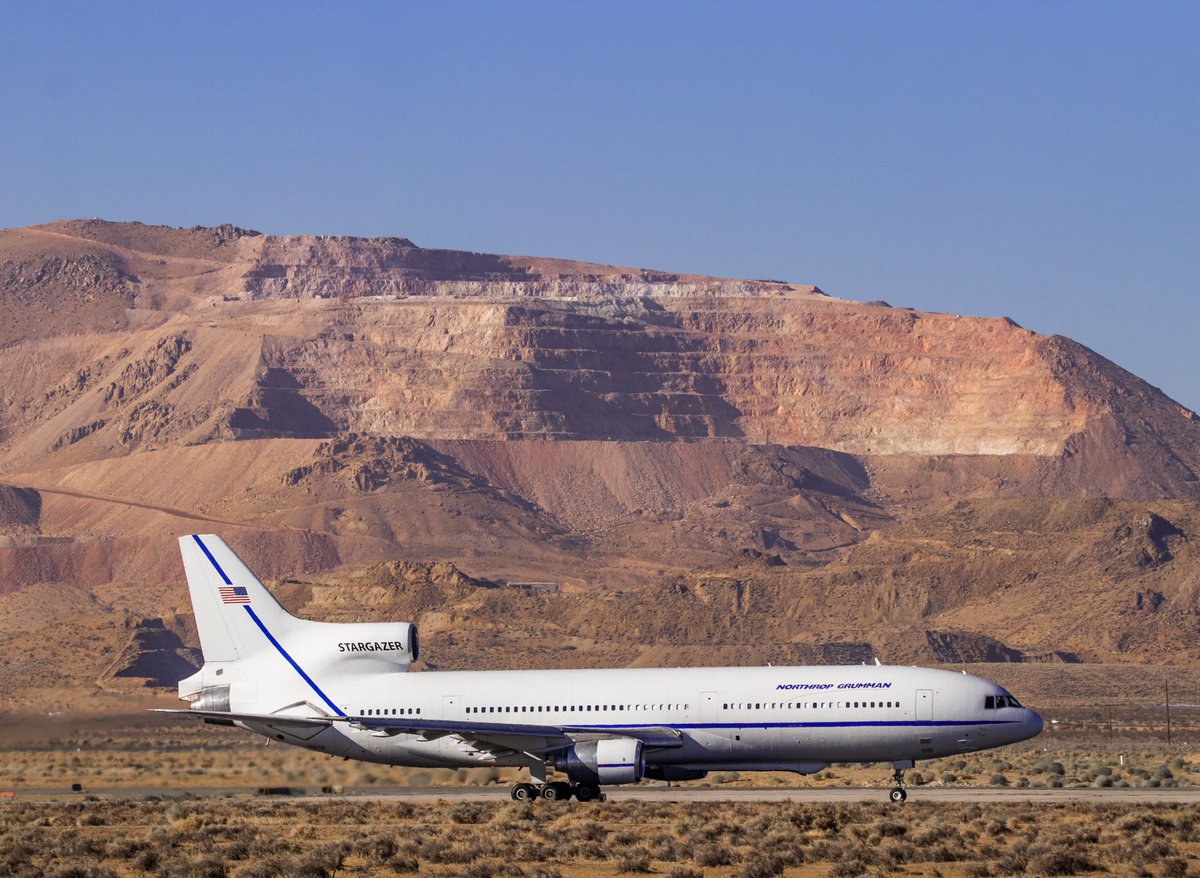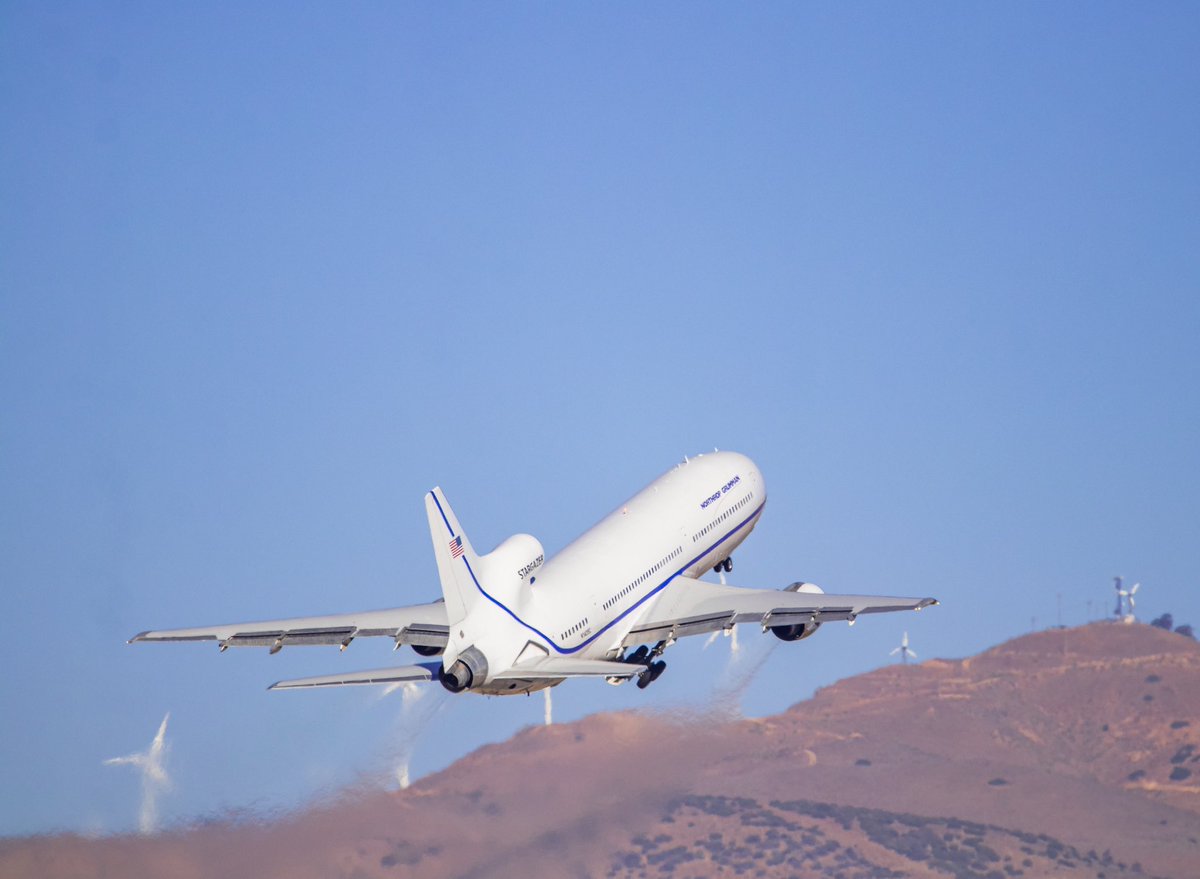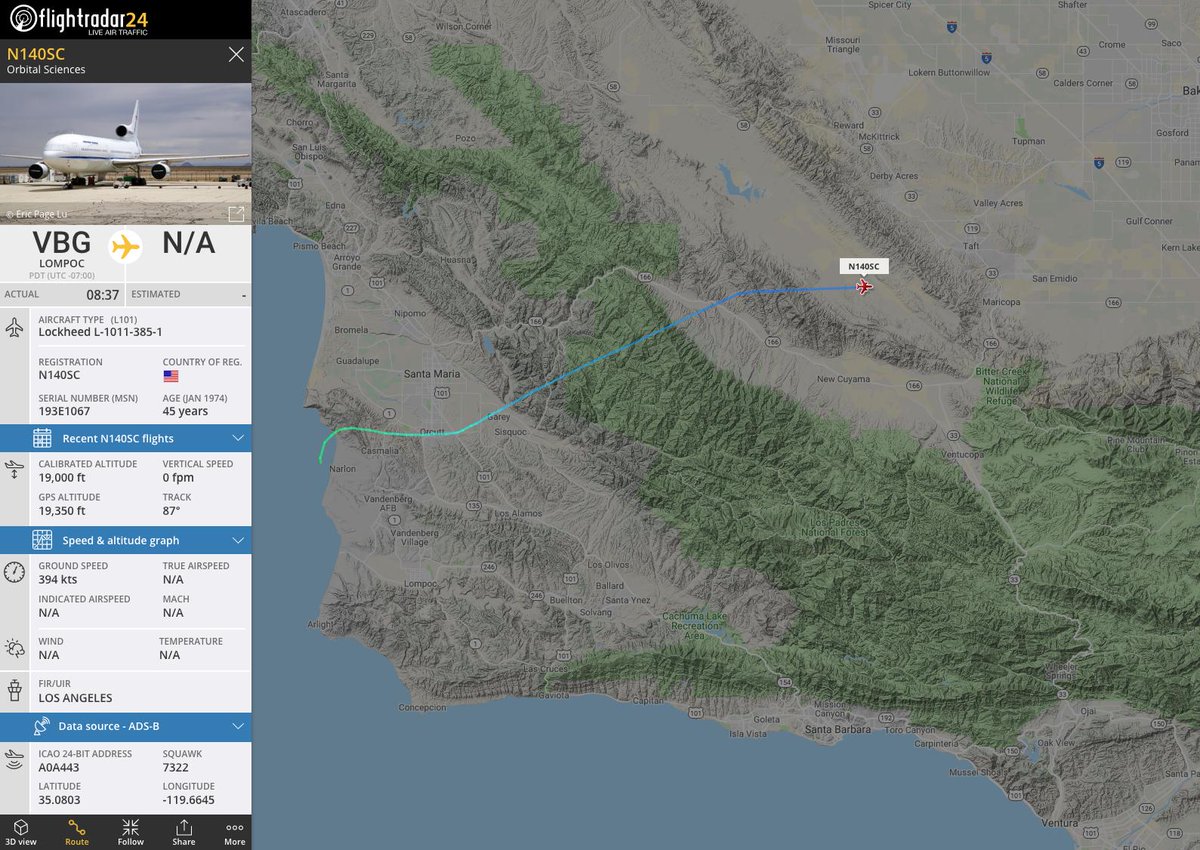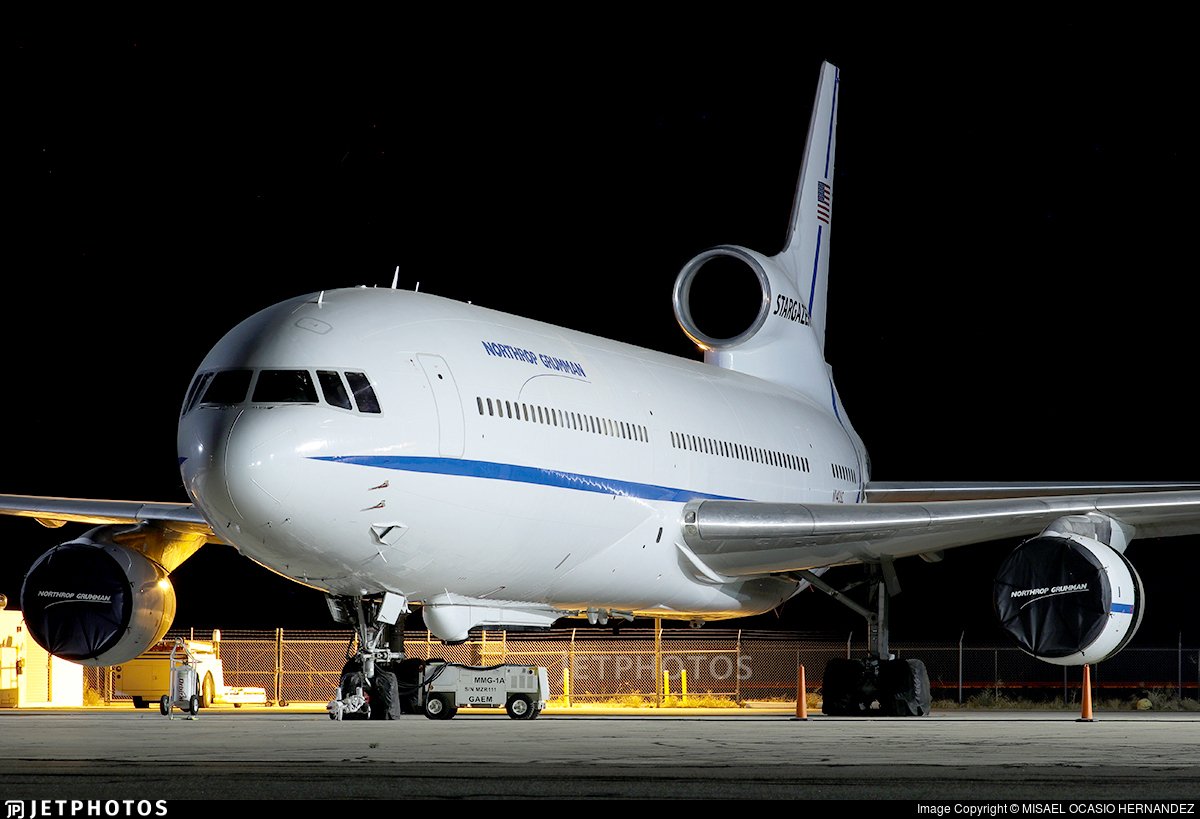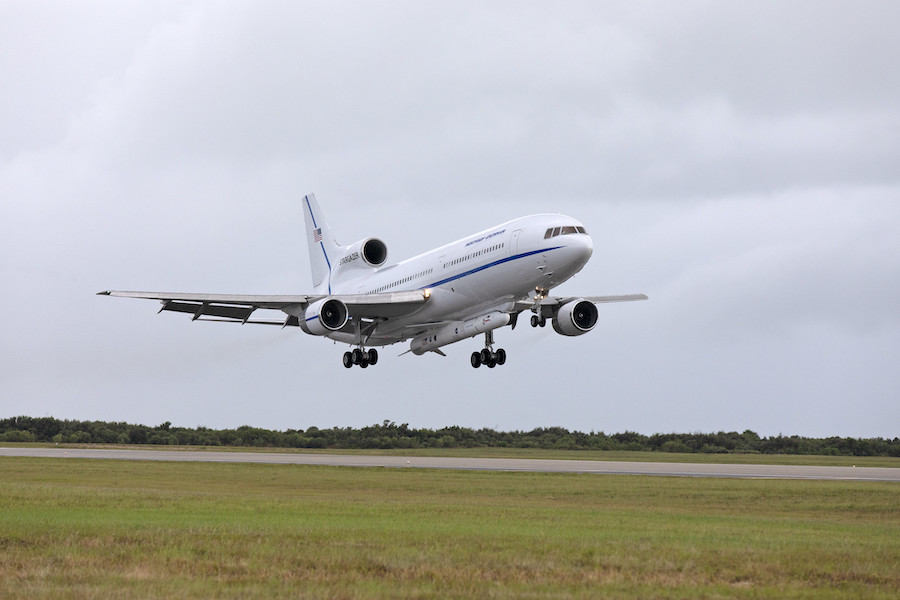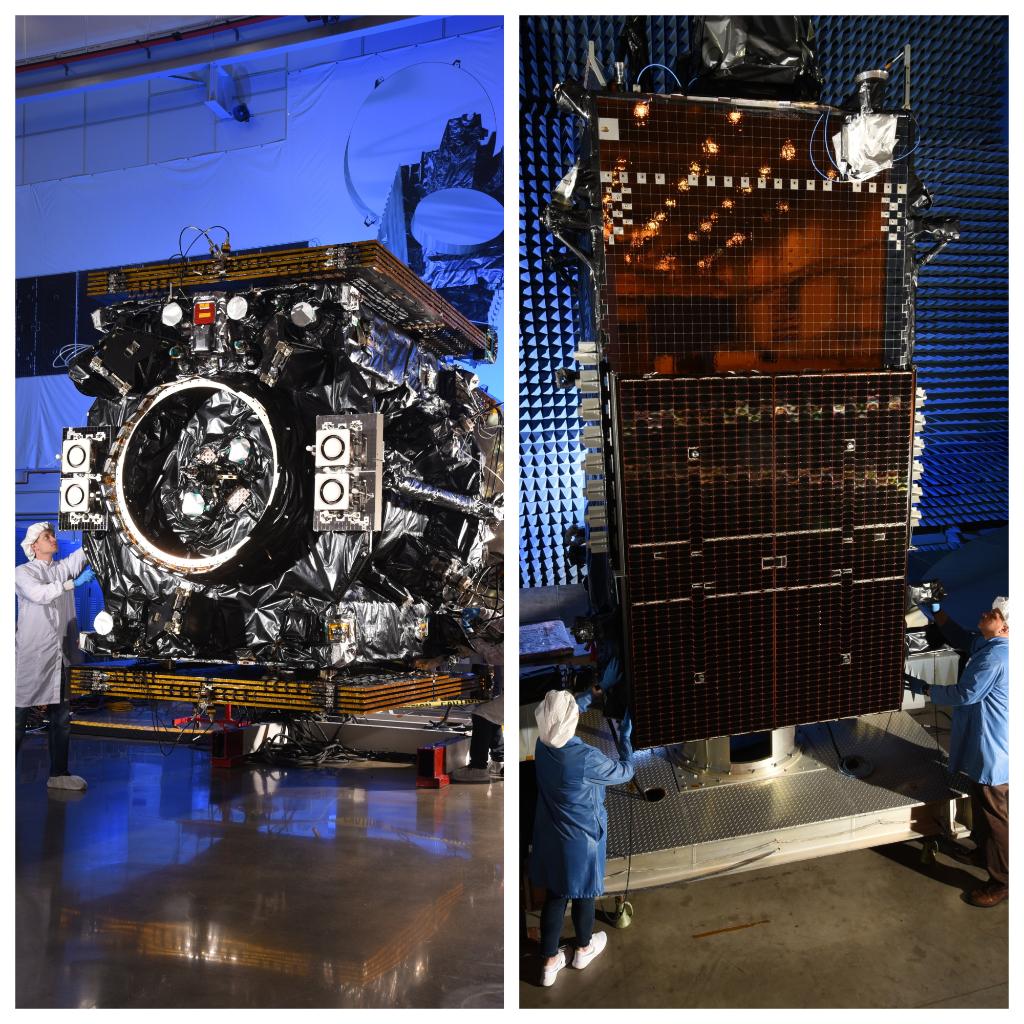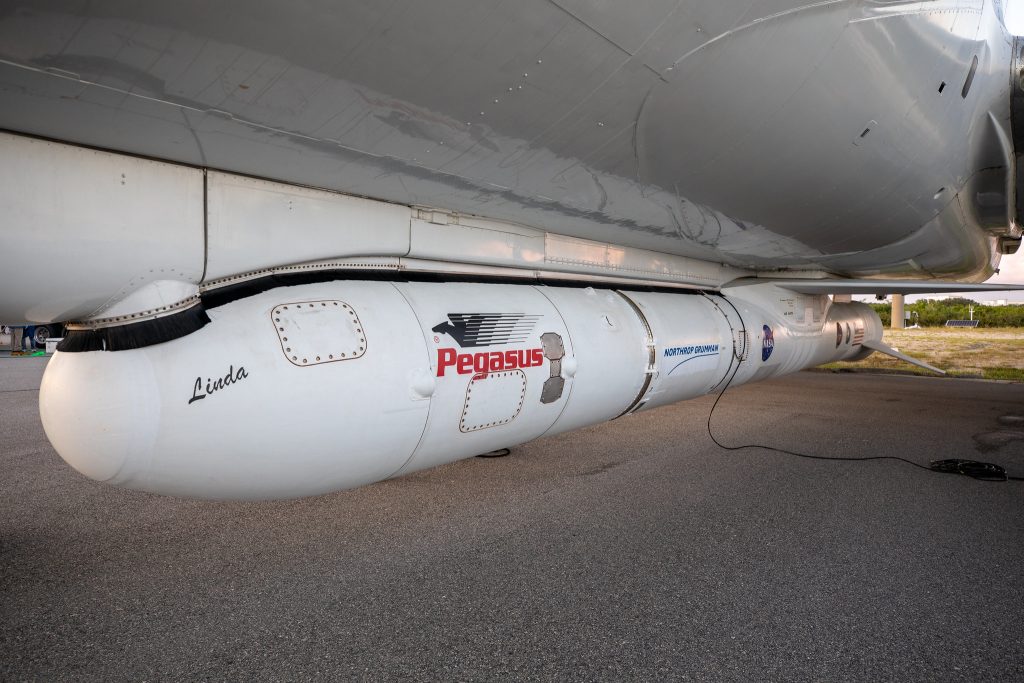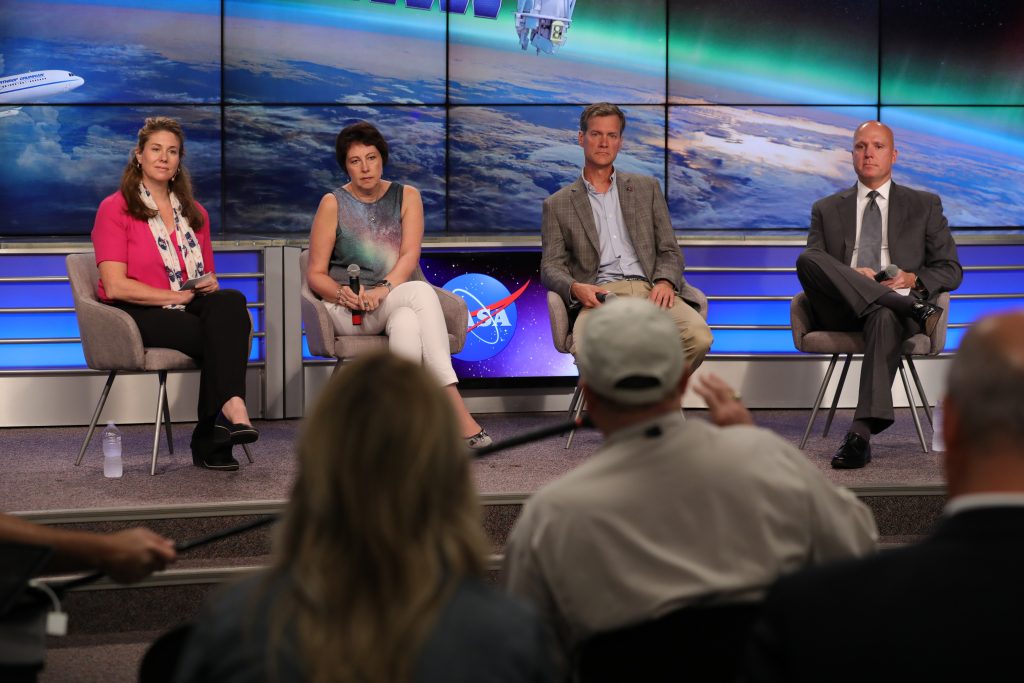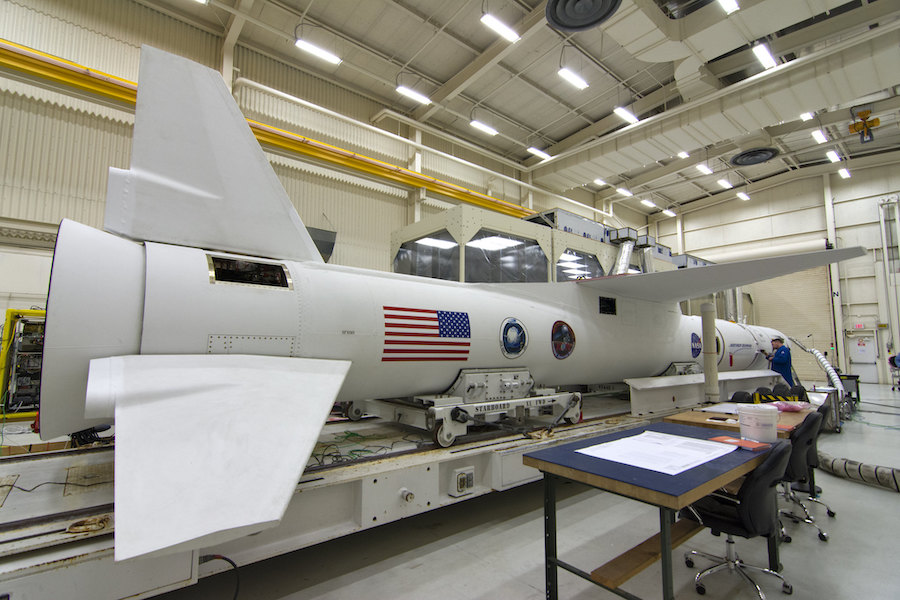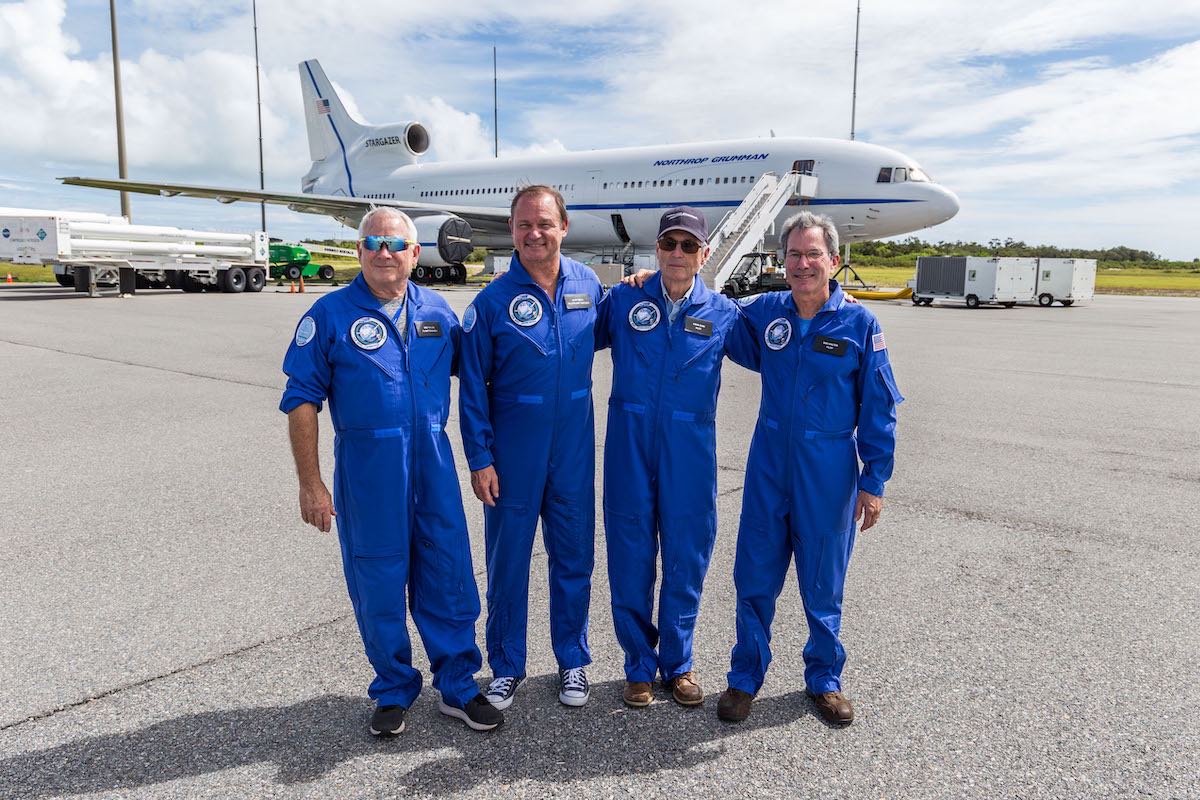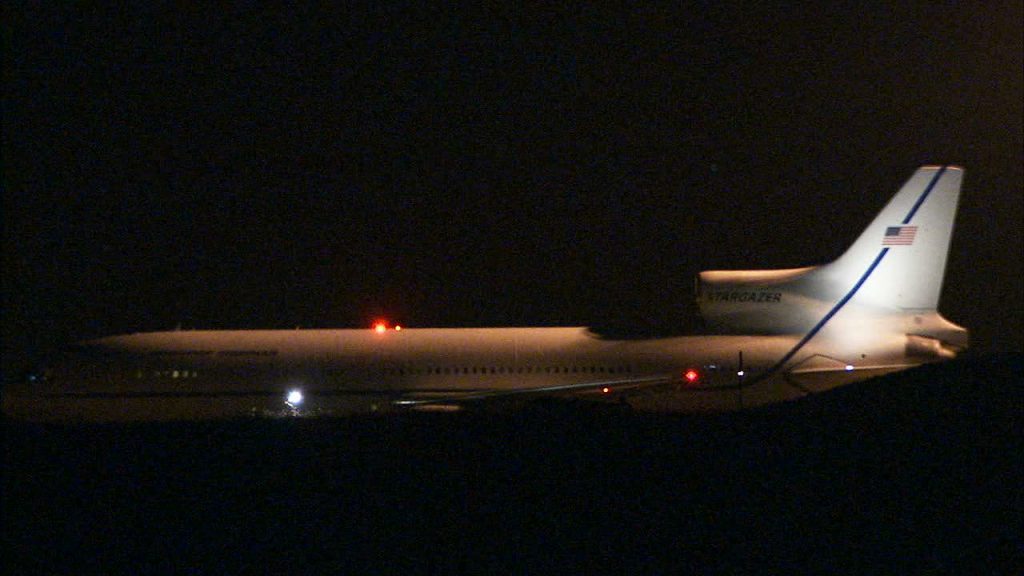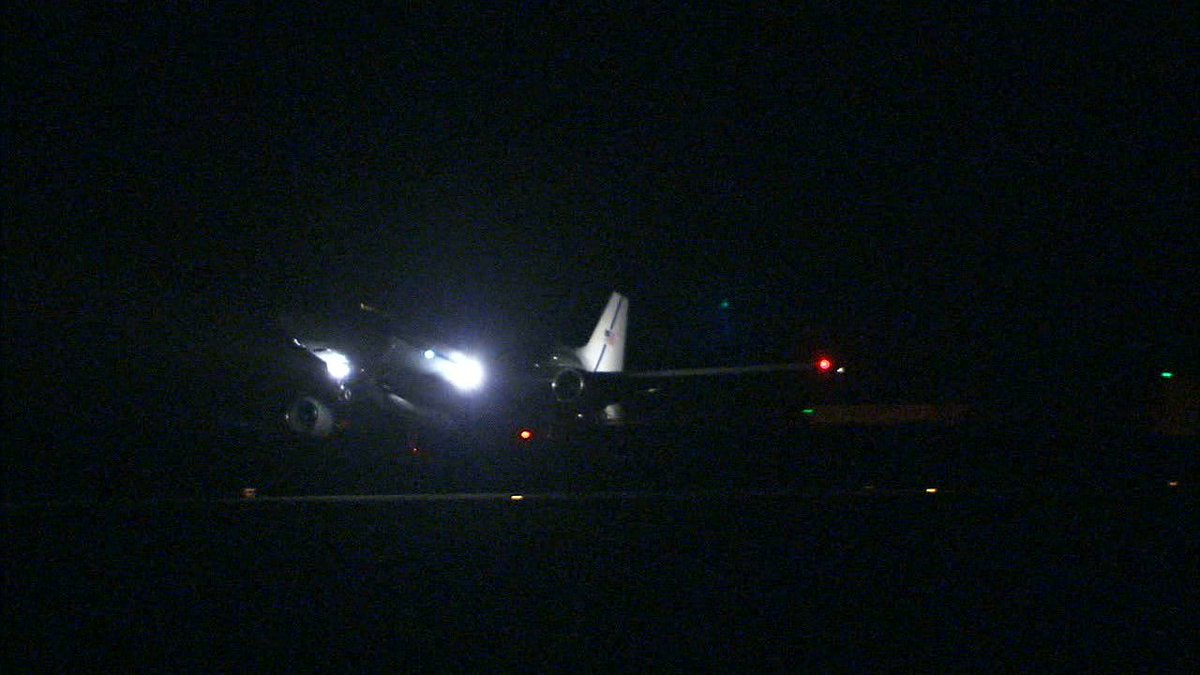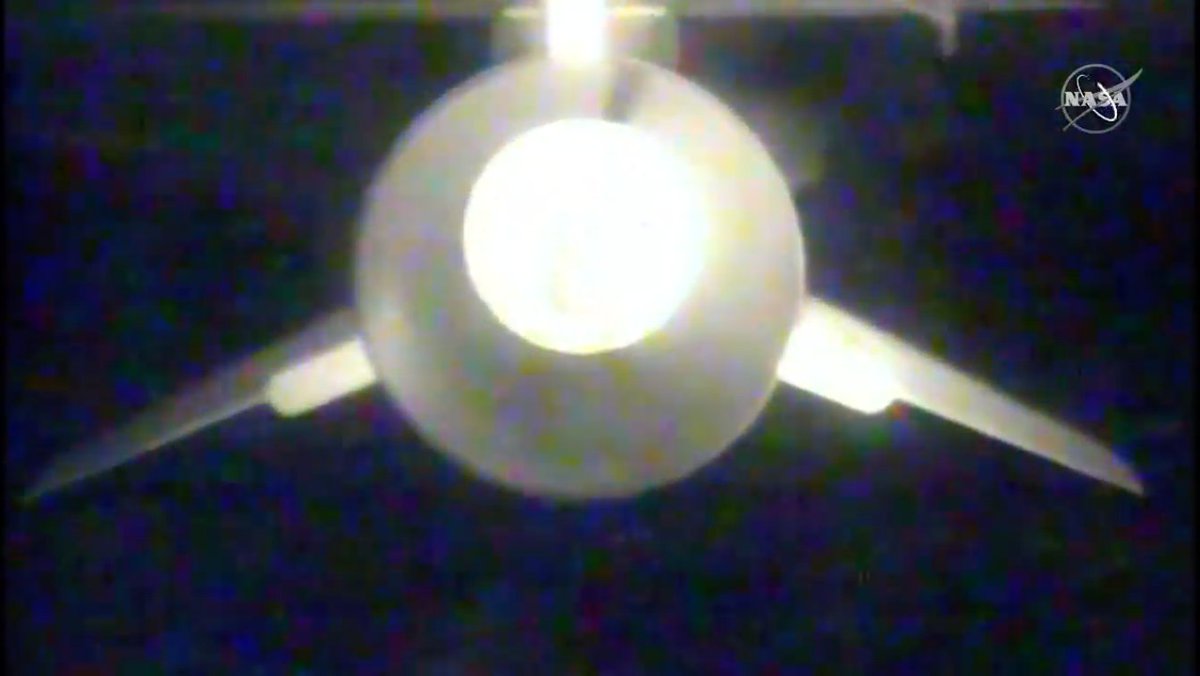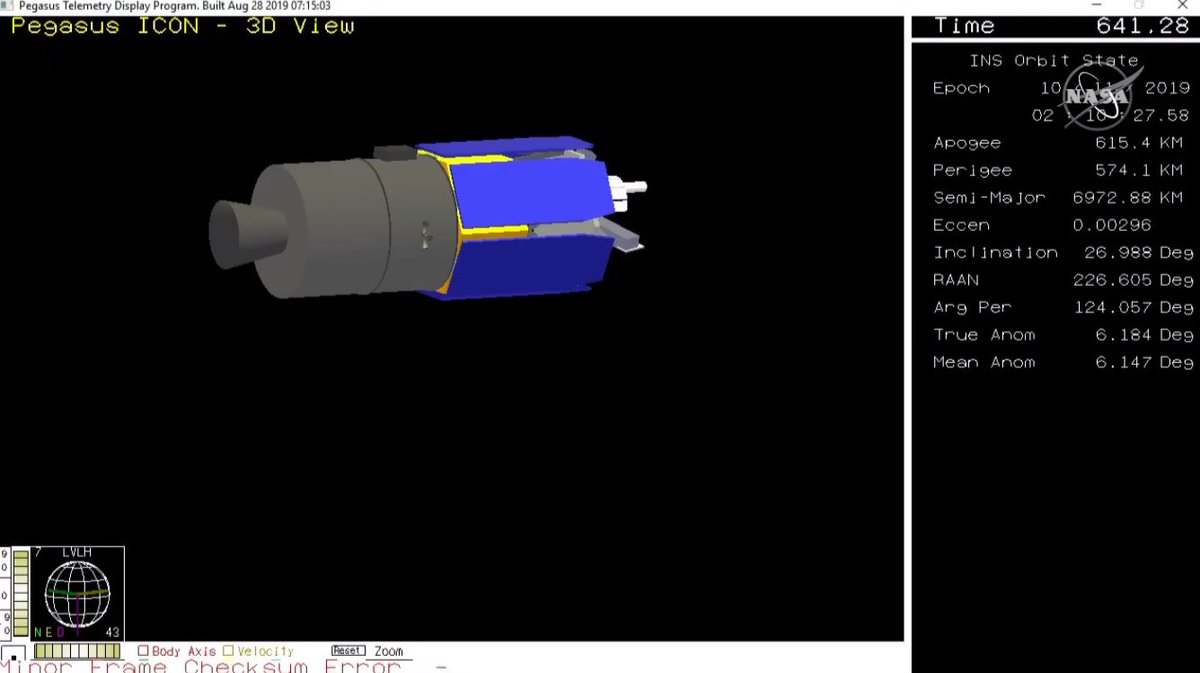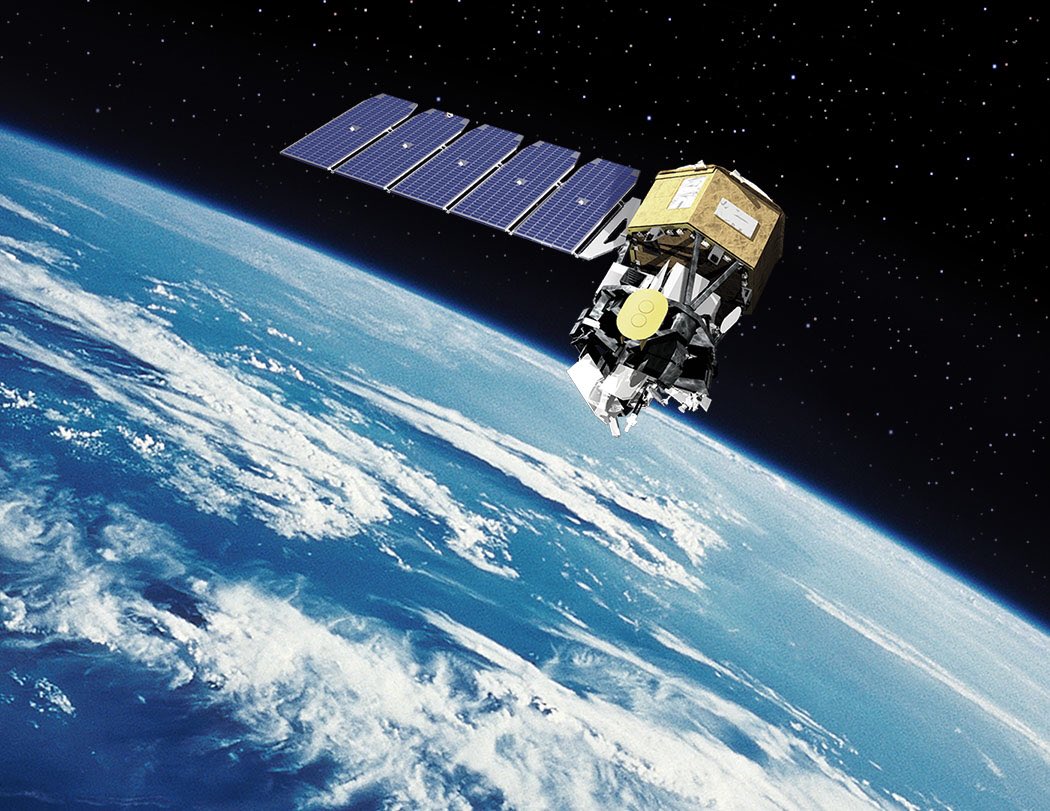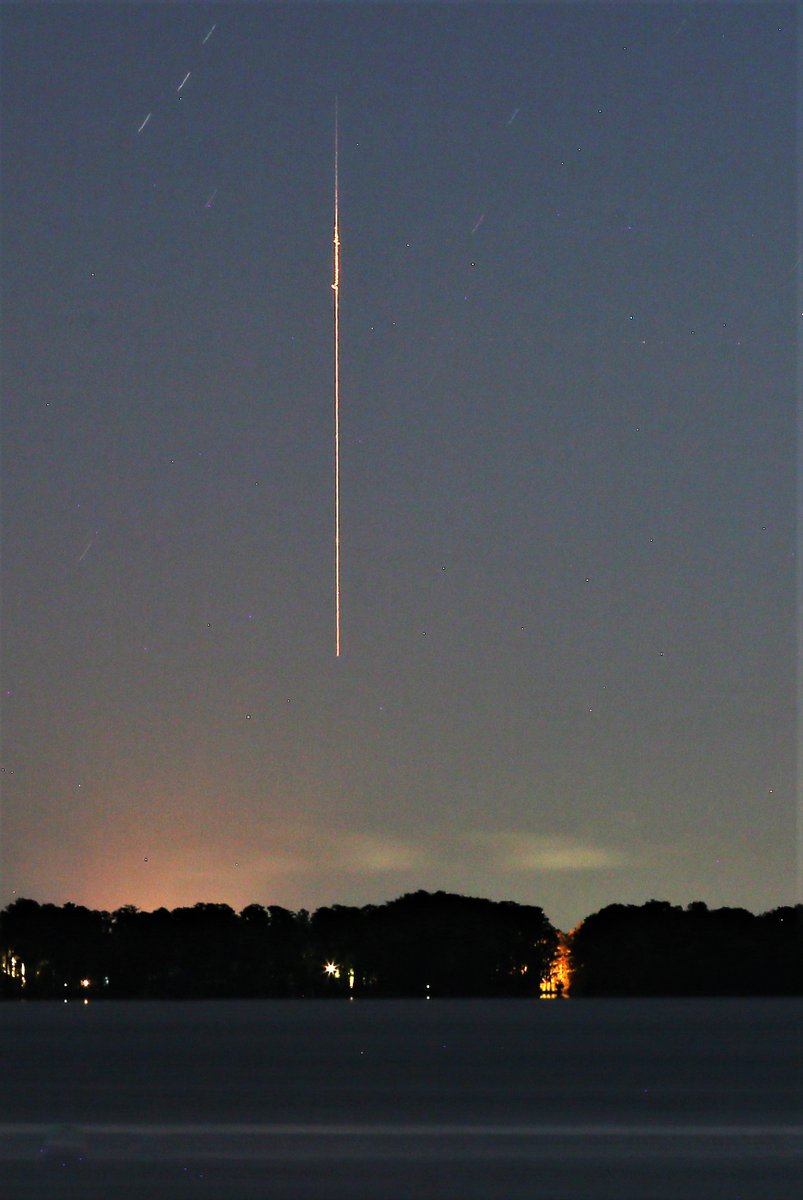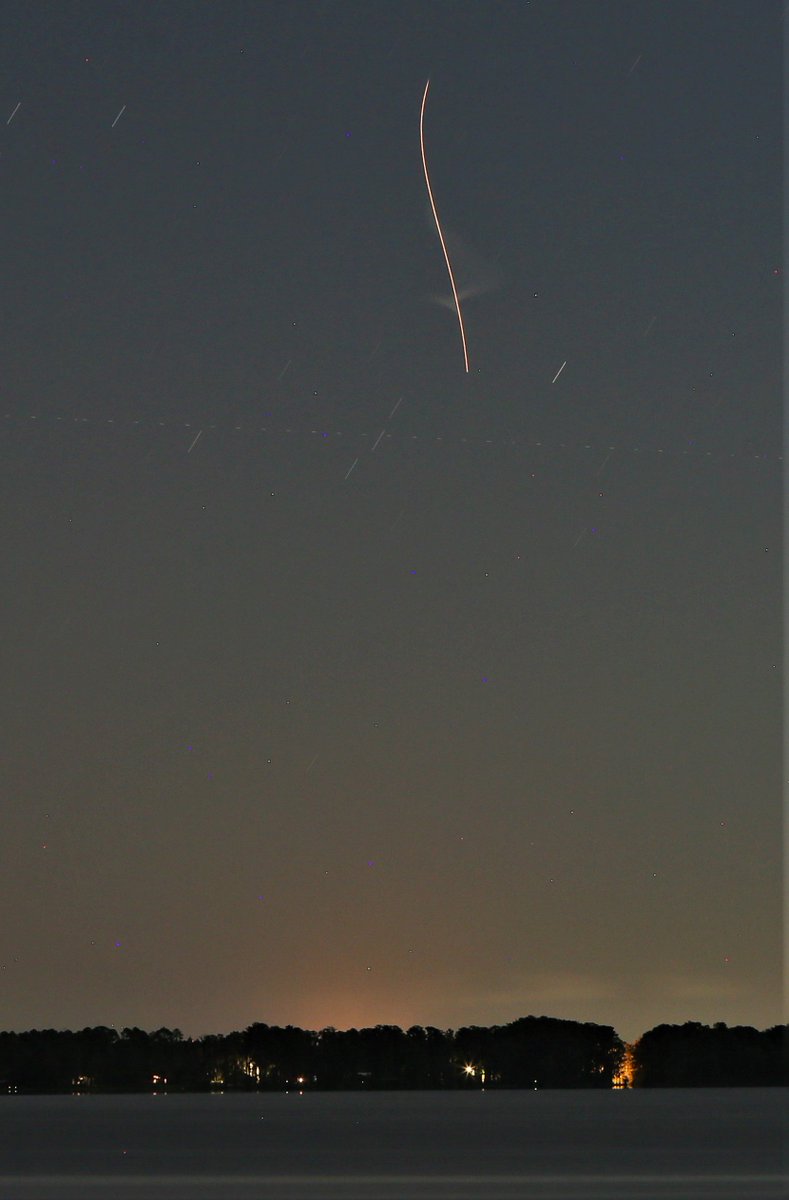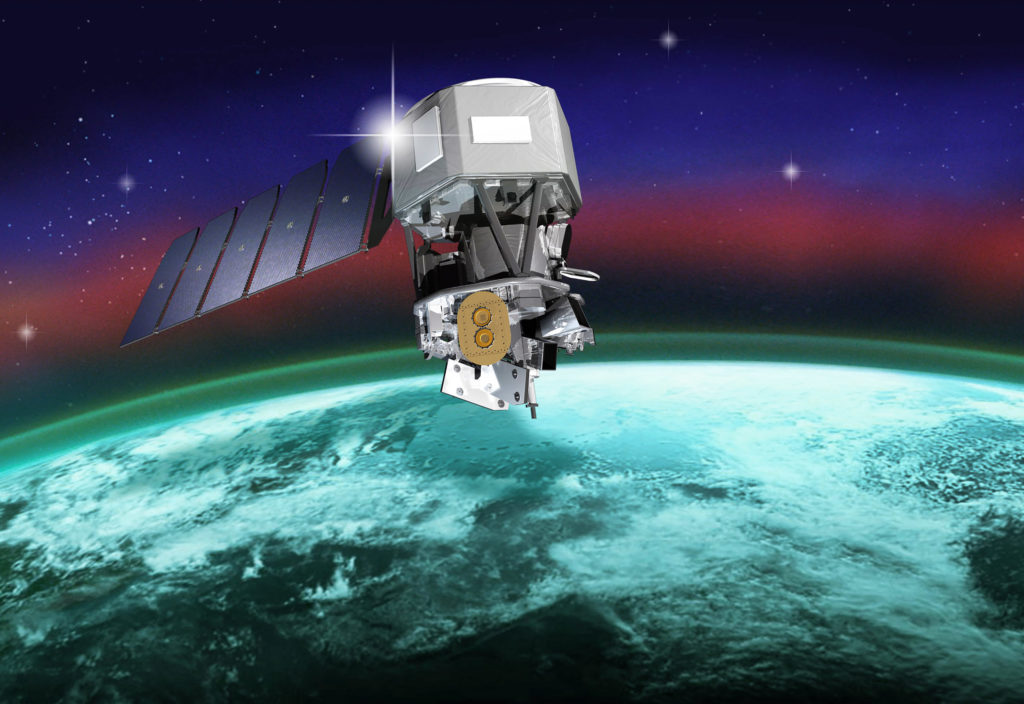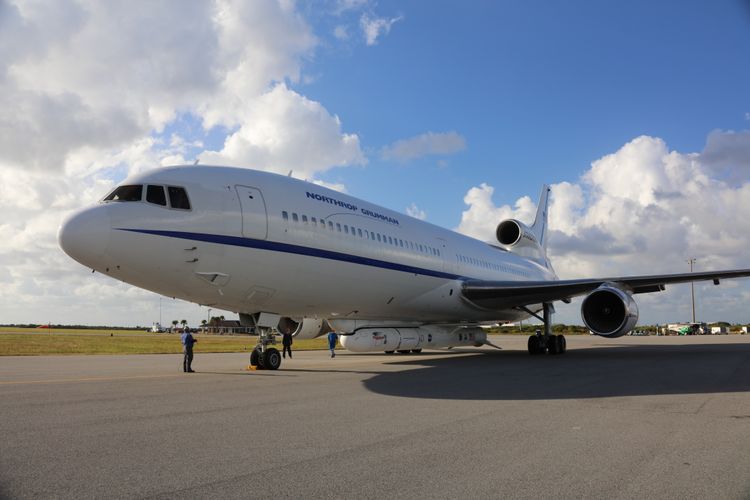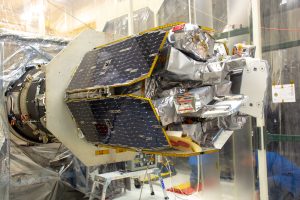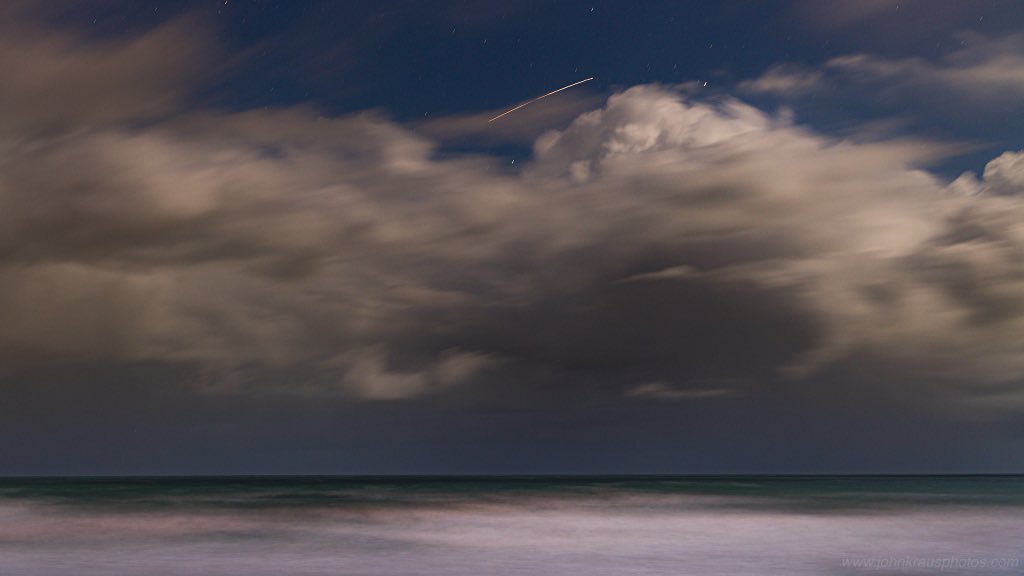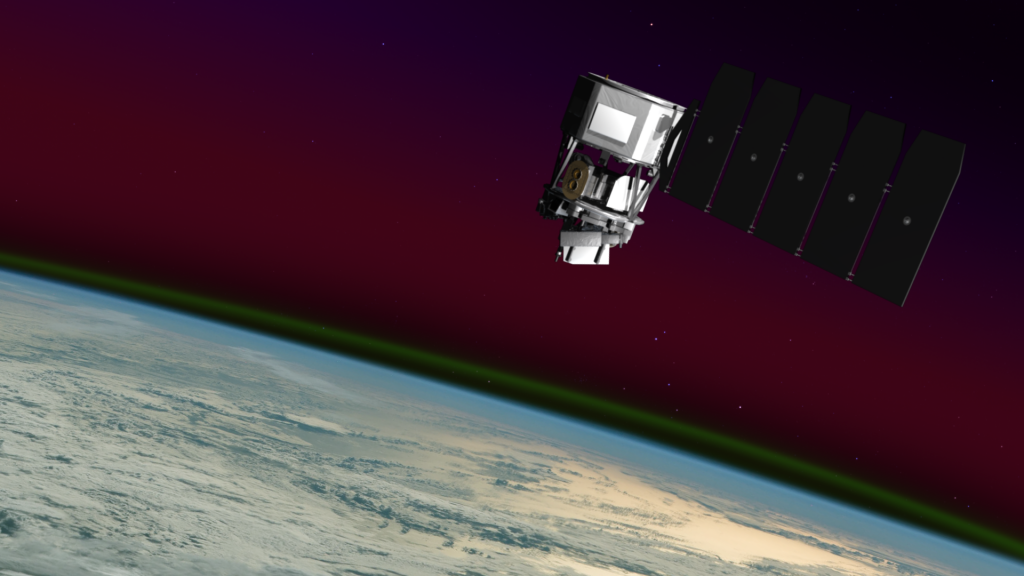Название: ICON – Pegasus XL – Cape Canaveral AFS, L-1011 "Stargazer" – 11.10.2019 – 04:59:05 ДМВ
Отправлено: Salo от 05.10.2017 01:21:58
Отправлено: Salo от 05.10.2017 01:21:58
https://blogs.nasa.gov/kennedy/2017/10/04/pegasus-rocket-prepared-for-nasas-icon-mission/ (https://blogs.nasa.gov/kennedy/2017/10/04/pegasus-rocket-prepared-for-nasas-icon-mission/)
ЦитироватьPegasus Rocket Prepared for NASA's ICON Mission
Posted on October 4, 2017 at 1:49 pm (https://blogs.nasa.gov/kennedy/2017/10/04/pegasus-rocket-prepared-for-nasas-icon-mission/) by Linda Herridge (https://blogs.nasa.gov/kennedy/author/lherridg/).
(https://blogs.nasa.gov/kennedy/wp-content/uploads/sites/246/2017/10/ICON-Stage-Arrival.jpg)
The second and third stages of the Orbital ATK Pegasus XL rocket were offloaded fr om a transport vehicle at Building 1555 at Vandenberg Air Force Base in California. Photo credit: Randy Beaudoin
Orbital ATK's Pegasus XL rocket is being prepared to launch NASA's Ionospheric Connection Explorer, or ICON mission. The rocket is being prepared in a facility at Vandenberg Air Force Base (VAFB) in California.
The rocket's second and third stages, first stage motor and wing arrived at VAFB and were transported to Building 1555 for processing.
ICON will launch aboard Pegasus from the Kwajalein Atoll, part of the Republic of the Marshall Islands in the Pacific Ocean, on Dec. 9, 2017 (in the continental United States the launch date is Dec.8 ).
ICON will study the frontier of space — the dynamic zone high in Earth's atmosphere wh ere terrestrial weather from below meets space weather above. The explorer will help determine the physics of Earth's space environment and pave the way for mitigating its effects on our technology, communications systems and society.(https://blogs.nasa.gov/kennedy/wp-content/uploads/sites/246/2017/10/ICON-Wing-Arrival.jpg)
Workers transfer the wing for the Orbital ATK Pegasus XL rocket from a truck to a forklift at Building 1555 at Vandenberg Air Force Base in California. Photo credit: Randy Beaudoin
Название: ICON – Pegasus XL – Cape Canaveral AFS, L-1011 "Stargazer" – 11.10.2019 – 04:59:05 ДМВ
Отправлено: Salo от 05.10.2017 01:27:45
Отправлено: Salo от 05.10.2017 01:27:45
http://space.skyrocket.de/doc_sdat/explorer_icon.htm
ЦитироватьExplorer: ICON (MIDEX 8 )
ICON (MIDEX 8 ) [OSC]
ICON (Ionospheric Connection) will explore the boundary between Earth and space – the ionosphere – to understand the physical connection between our world and the immediate space environment around us. This region, where ionized plasma and neutral gas collide and react exhibits dramatic variability that affects space-based technological systems like GPS.
Though the solar inputs are now well quantified, the drivers of ionospheric variability originating from lower atmospheric regions are not. ICON is the first space mission to simultaneously retrieve all of the properties of the system that both influence and result from the dynamical and chemical coupling of the atmosphere and ionosphere. ICON achieves this through an innovative measurement technique that combines remote optical imaging and in situ measurements of the plasma. With this approach, ICON gives us the ability to (1) separate the drivers and pinpoint the real cause of ionospheric variability (2) explain how energy and momentum from the lower atmosphere propagate into the space environment, and (3) explain how these drivers set the stage for the extreme conditions of solar-driven magnetic storms. ICON's imaging capability combined with its in-situ measurements on the same spacecraft (Figure 1) gives a perspective of the coupled system that would otherwise require two or more orbiting observatories.
ICON targets the low-latitude ionosphere because recent global-scale observations of this region show remarkable spatial and temporal variability that contravene the conventional view of ion-neutral coupling in space, and evince strong forcing by lower atmosphere drivers. The coupling of the atmosphere to space is strongest at these latitudes because the atmospheric waves are largest and so is the density of the space plasma, produced in abundance by the sun overhead and confined by the magnetic field.
Following instruments are on boards:
[/li]
Orbital was selected to provide a LEOStar-2 (http://space.skyrocket.de/doc_sat/osc_leostar-2.htm) based bus.- MIGHTI (Michelson Interferometer for Global High-Resolution Thermospheric Imaging): Remotely measuring the neutral wind field and temperatures – Heritage from SHIMMER flown on STPSat-1 (http://space.skyrocket.de/doc_sdat/stpsat-1.htm).
- EUV (Extreme Ultra-Violet): Measuring the height and density of the daytime ionosphere – Heritage from SPEAR flown on the Korean STSAT-1 (http://space.skyrocket.de/doc_sdat/stsat-1.htm).
- FUV (Far Ultra-Violet): Measuring the daytime atmospheric composition and the ionosphere at night – Heritage from FUV flown on IMAGE (http://space.skyrocket.de/doc_sdat/explorer_image.htm).
- IVM (Ion Velocity Meter): Measuring the electric fields detected at the satellite – Heritage from IVM flown on C/NOFS CINDI (http://space.skyrocket.de/doc_sdat/cnofs.htm).
ICON will launch by 2017 into a low earth orbit, operating for at least two years. A Pegasus-XL (http://space.skyrocket.de/doc_lau_det/pegasus-xl.htm) launch vehicle was selected in November 2013 for a launch in 2017.
[TH]Nation:[/TH] USA [TH]Type / Application:[/TH] Research, ionosphere [TH]Operator:[/TH] University of California, Berkeley for NASA [TH]Contractors:[/TH] Orbital Sciences Corporation (OSC) [TH]Equipment:[/TH] MIGHTI, EUV, FUV, IVM [TH]Configuration:[/TH] LEOStar-2 (http://space.skyrocket.de/doc_sat/osc_leostar-2.htm) [TH]Propulsion:[/TH] ? [TH]Power:[/TH] 2 deployable solar arrays, batteries [TH]Lifetime:[/TH] 2 years [TH]Mass:[/TH] 272 kg [TH]Orbit:[/TH] 575 km × 575 km, 27°
Название: ICON – Pegasus XL – Cape Canaveral AFS, L-1011 "Stargazer" – 11.10.2019 – 04:59:05 ДМВ
Отправлено: tnt22 от 18.10.2017 23:19:03
Отправлено: tnt22 от 18.10.2017 23:19:03
https://www.nasa.gov/feature/goddard/2017/nasa-s-icon-explores-the-boundary-between-earth-and-space
ЦитироватьOct. 18, 2017
NASA's ICON Explores the Boundary Between Earth and Space
On Dec. 8, 2017, NASA launches the Ionospheric Connection Explorer, or ICON, a low-Earth orbiting satellite that will give us new information about how Earth's atmosphere interacts with near-Earth space — a give-and-take that plays a major role in the safety of our satellites and reliability of communications signals.Last Updated: Oct. 18, 2017Спойлер
Specifically, ICON investigates the connections between the neutral atmosphere — which extends fr om here near the surface to far above us, at the edge of space — and the electrically charged part of the atmosphere, called the ionosphere. The particles of the ionosphere carry electrical charge that can disrupt communications signals, cause satellites in low-Earth orbit to become electrically charged, and, in extreme cases, cause power outages on the ground. Positioned on the edge of space and intermingled with the neutral atmosphere, the ionosphere's response to conditions on Earth and in space is difficult to pin down.
"The conditions in our space environment — space weather — is something we need to be able to forecast," said Thomas Immel, principal investigator for the ICON mission fr om the University of California, Berkeley."It's difficult to predict conditions in the ionosphere tomorrow based on what we measure today."
Earth's interface to space
As one goes higher and higher above Earth's surface, the atmosphere gradually gets thinner. The effects of these changes can be felt just a few miles above sea level — for instance, climbers on some of the world's tallest mountains must often use oxygen tanks to breathe. But even higher, about 60 miles above Earth's surface, the atmosphere becomes so thin that planes can't fly. This is where space begins.
Even beyond this boundary of space, Earth's atmosphere continues to extend upward — it just gets thinner and more tenuous the higher you go. This region is above Earth's ozone layer, so it's exposed to the full brunt of the Sun's radiation. The strong ultraviolet radiationbreaks down stable, neutral molecules, changing them fr om something resembling the air we breathe into more reactive forms of gas, like atomic oxygen. These reactive compounds in the neutral upper atmosphere produce a faint, global glow, called airglow.(https://www.nasa.gov/sites/default/files/thumbnails/image/ionospherev8-02.png)
NASA's Ionospheric Connection Explorer, or ICON, launches in December 2017 and orbits above the upper atmosphere, through the bottom edge of near-Earth space. Fr om this vantage point, ICON observes both the upper atmosphere — made of neutral particles — and a layer of charged particles called the ionosphere, which extends from about 50 to 360 miles above the surface of Earth. Processes in the ionosphere also create bright swaths of color in the sky, known as airglow. ICON will observe how interactions between terrestrial weather and the ionosphere create such shimmering airglow as well as other changes in the space environment.
Credits: NASA's Goddard Space Flight Center/ICON
But the sunlight doesn't stop there. It keeps breaking these atmospheric molecules apart, knocking off electrons, which leaves a sea of charged electrons and ions. This population of electrically charged particles is the ionosphere, and it exists in the same space as the extremely thin neutral upper atmosphere.
This makes our interface to spacea unique region, wh ere charged and neutral gases coexist. It is shaped both by weather patterns and winds from Earth below, and shifting electric and magnetic fields and space weather from above.
"ICON aims to understand how Earth's weather modifies space weather," said Doug Rowland, mission scientist for ICON at NASA's Goddard Space Flight Center in Greenbelt, Maryland. "We're looking at how the weather that we live in — rain, heat, snow, thunderstorms, hurricanes — affects the space environment above us."
Space weather is often triggered by changes on the Sun, which releases a constant outflow of magnetized material called the solar wind along with less frequent but more intense bursts of solar material, called coronal mass ejections. The magnetic fields embedded in this solar material can deform Earth's natural magnetic field, creating shifting electric and magnetic fields in near-Earth space. The electrically-charged gas of the ionosphere, called plasma, reacts uniquely to these changing electric and magnetic fields.
Many low-Earth orbiting satellites, including the International Space Station, fly through the ionosphere. It alsoacts as a conduit for many of our communications signals, such as radio waves and the signals that make GPS systems work. Unpredicted changes in the ionosphere, like ripples and bubbles of dense plasma, can have significant impacts on our technology and communication.
"Short-wave radio waves bounce off the ionosphere, and signals from GPS satellites have to pass through," said Immel. "The changes in density directly affect communications and navigation."
Understanding the details of what influences the ionosphere and causes signal disruptions has historically been difficult, in part because of the range of factors that can change the ionosphere. For decades, scientists thought that the ionosphere responded only to the changing conditions in space. New data over the past few decades, however, has proved that assumption wrong, and revealed that there's still much to learn about the forces that shape the ionosphere.
https://www.youtube.com/watch?v=b94PaWIeG9Q (https://www.youtube.com/watch?v=b94PaWIeG9Q)
(youtube.com/watch?v=b94PaWIeG9Q (https://www.youtube.com/watch?v=b94PaWIeG9Q), 2:00)
NASA's Ionospheric Connection Explorer, or ICON, launches in December 2017 and orbits above the upper atmosphere, through the bottom edge of near-Earth space. From this vantage point, ICON observes both the upper atmosphere and a layer of charged particles called the ionosphere, which extends from about 50 to 360 miles above the surface of Earth. Processes in the ionosphere also create bright swaths of color in the sky, known as airglow. ICON will observe how interactions between Earth's weather and the ionosphere create such shimmering airglow as well as other changes in the space environment.
Credits: NASA's Goddard Space Flight Center
Download this video in HD formats from NASA's Goddard Space Flight Center's Scientific Visualization Studio (https://svs.gsfc.nasa.gov/12699)
"What we discovered, using data from a NASA mission called IMAGE, was that this region of the upper atmosphere and ionosphere was actually responding to effects related to weather systems near Earth's surface," said Scott England, ICON project scientist based at Virginia Tech in Blacksburg. IMAGE, short for Imager for Magnetopause-to-Aurora Global Exploration, studied Earth's magnetosphere from 2000 to 2005. "This was really unexpected at the time, to see a connection. Wh ere the charged particles were, how many there were, how dense the gas was — they were responding to weather patterns near the surface of the Earth."
Pockets of high or low pressure are produced near Earth's surface by hurricanes, thunderstorms, or even phenomena as simple as a steady wind over a mountain range. These pressure differences can propagate into the very highest reaches of the upper atmosphere and influence the winds in this region. The exact role that these winds — and by extension, terrestrial weather — play in shaping the ionosphere is an outstanding question, and one that scientists hope ICON will answer.
"We think the winds will be directly related to the electric field measured at the spacecraft, but we don't know," said Immel. "No one's ever made this measurement, so no one knows what we're going to see."
Eyes on the ionosphere
ICON explores these connections between the neutral atmosphere and the electrically charged ionosphere with four instruments. Three of these four instruments rely on one of the upper atmosphere's more spectacular phenomena: airglow.
Airglow is created by a similar process that creates the aurora: gas is excited and emits light. Though auroras are typically confined to extreme northern and southern latitudes, airglow happens constantly across the globe, and it is much fainter. But it's still bright enough for ICON's instruments to build up a picture of the density, composition and structure of the ionosphere.
One of these airglow-measuring instruments is MIGHTI, short for Michelson Interferometer for Global High-resolution Thermospheric Imaging. Designed and built by the Naval Research Lab in Washington, D.C., MIGHTI measures the Doppler shift of the glowing gases of the upper atmosphere and ionosphere.
"The Doppler shift is the same process you can hear when you hear a siren on an ambulance: It has a different pitch when the ambulance is coming towards versus moving away from you," said England. "The same thing is happening with the light from airglow."
When gas producing airglow moves toward or away from ICON, pushed by winds, the wavelengths are stretched or compressed. Because scientists know what chemical species produce airglow in the upper atmosphere, they know very specifically what wavelength — or color — that light should be. The Doppler-shifted light has an ever-so-slightly different hue that MIGHTI can detect, and from there, scientists can deduce the speed and direction of the winds in this region.(https://www.nasa.gov/sites/default/files/thumbnails/image/iss_composite_test_182.png)
Bright swaths of red in the upper atmosphere, known as airglow, can be seen in this image taken from the International Space Station. NASA's Ionospheric Connection Explorer, or ICON, launches December 2017 to observe how interactions between terrestrial weather and a layer of charged particles called the ionosphere create the colorful glow.
Credits: NASA
Instruments similar to MIGHTI have flown on space missions before, but with a key difference. Earlier space-based interferometers would use moving parts to change the distance between different reflectors and detectors in order to measure each wavelength of light. But MIGHTI uses a tool called a diffraction grating — similar to a mirror with lines etched in it that reflect light in a certain way — to separate the light it sees into its component wavelengths simultaneously. This means that MIGHTI can measure multiple wavelengths at once, making the instrument more sensitive.
"MIGHTI can measure changes in the wind speed of around 10 miles per hour," said England. "If you translate that into the actual change in the wavelength, that's a change of about 1 in 100 million."
Another airglow instrument, the Far Ultraviolet instrument, uses an advanced de-blurring technique called time-delay integration to send back more information for scientists within the data bandwidth restrictions of the spacecraft.
"We have the bandwidth to send down one snapshot every 12 seconds, but the spacecraft moves about a hundred kilometers in that amount of time, and the structures we want to look at are only a few kilometers wide," said Rowland. "You would smear all these small-scale structures."
What the Far Ultraviolet instrumentdoes instead, said Rowland, is take eight snapshots per second — almost a hundred times as much data as ICON can send down — and combine them, with each one shifted appropriately to account for warping and the geometry of the spacecraft. This processing, which all happens on ICON's onboard computer, creates a single image that can be sent back to Earth within the bandwidth allotted. This combines the advantages of a long exposure by compressing the data, while still maintaining the sharp focus that gives scientists a detailed look at the structures they're interested in. The wavelengths measured by FUV are produced by certain types of oxygen and nitrogen molecules on Earth's day side, as well as oxygen ions on Earth's night side.
ICON's third airglow instrument, EUV — short for Extreme Ultraviolet instrument — measures shorter wavelengths of light than FUV. Airglow measured by EUV is produced by oxygen ions on Earth's day side, which make up the lion's share of Earth's daytime ionosphere. EUV's data will reveal details about the structure of the ionosphere during the day — like how far it extends, and wh ere pockets of denser plasma form — that can change the ionosphere'sinteraction with communications signals and satellites.
While ICON's three airglow instruments measure the temperature, velocity and composition of gases miles away from the spacecraft, a pair of identical in situ instruments characterizes the charged gas around the spacecraft. The two Ion Velocity Meters, or IVMs, make very precise measurements of the angle at which ionized gas enters the instrument, helping scientists understand how this ionized gas around the spacecraft is moving.
In the past, scientists may have had to combine instruments from different spacecraft — sometimes even from different years — to try and make connections between the lower atmosphere, neutral upper atmosphere and ionosphere. But one of ICON's main advances is the combination of data from its four instruments at the same place and time
"The unique thing is the suite of instruments," said Ellen Taylor, ICON project systems engineer at UC Berkeley. "ICON has several instruments that have been flown before, but they're put together into a payload suite to make unique measurements."
ICON's orbit is also designed to create a few points during each orbit wh ere the remote sensing instruments look straight down Earth's magnetic field. That means the spacecraft's in situ plasma measurements are sometimes directly magnetically connected to the remote measurements of airglow, even though they're hundreds of miles apart.(https://www.nasa.gov/sites/default/files/thumbnails/image/04_magfield.png)
NASA's Ionospheric Connection Explorer, or ICON, uses a combination of remote and in situ instruments to study Earth's neutral upper atmosphere and electrically charged ionosphere. At certain points in its orbit near Earth's equator, ICON's remote and in situ measurements are magnetically connected, even though they're hundreds of miles apart, giving scientists new insights into the connected between the lower atmosphere, neutral upper atmosphere and ionosphere.
Credits: NASA Goddard/Duberstein
ICON's data will be complemented by the January 2019 launch of the GOLD instrument, short for Global-scale Observations of the Limb and Disk. Hosted on a commercial satellite in geostationary orbit, GOLD also will observe the ionosphere, but from a vantage point very different from ICON's: GOLD will see the big picture, while ICON flies through the ionosphere, collecting data from up close.
"To study hurricanes, we might use a weather satellite to track how they're moving across the ocean, but to get detailed information, we fly a plane through the storm," said England. The same relationship holds true for ICON and GOLD studying the ionosphere. "GOLD is like the weather satellite, and ICON is like the airplane."
ICON launches on a Pegasus rocket from Kwajalein Atoll in the Marshall Islands in the Pacific Ocean. Carried underneath the L-1011 airplane out over the ocean, the launch window opens at approximately 3 a.m. local time on Dec. 8. NASA TV (https://www.nasa.gov/nasalive) will cover the launch.
After launch, Taylor's team will be in the mission operations center at UC Berkeley 24/7 for nearly a week to commission the spacecraft. This is followed by another three weeks of instrument commissioning, during which each one of the instruments is prepared to take science data — by powering up, opening sensor doors, ramping up voltage and cooling down detector plates. After instrument and payload commissioning, ICON should be fully online and sending back data by about a month after launch.
ICON is an Explorer-class mission. NASA Goddard manages the Explorer Program for NASA's Heliophysics Division within the Science Mission Directorate in Washington. UC Berkeley's Space Sciences Laboratory developed the ICON mission, EUV and FUV, the Naval Research Laboratory in Washington, D.C., developed the MIGHTI instrument (https://www.nasa.gov/content/icon-spacecraft-and-instruments), the University of Texas in Dallas developed IVM, and the ICON spacecraft and Pegasus launch vehicle were built by Orbital ATK in Dulles, Virginia.
Related:[/li]
- NASA's ICON website (https://www.nasa.gov/icon)
- UC Berkeley's ICON website (http://icon.ssl.berkeley.edu/)
By Sarah Frazier (mailto:sarah.frazier@nasa.gov?ICON%20Explores%20the%20Boundary%20Between%20Earth%20and%20Space)
NASA's Goddard Space Flight Center (http://www.nasa.gov/goddard), Greenbelt, Md.[свернуть]
Editor: Rob Garner
Название: ICON – Pegasus XL – Cape Canaveral AFS, L-1011 "Stargazer" – 11.10.2019 – 04:59:05 ДМВ
Отправлено: tnt22 от 03.11.2017 19:57:48
Отправлено: tnt22 от 03.11.2017 19:57:48
Цитироватьhttps://www.nasa.gov/content/icon-mission-overviewNASA Sun & SpaceПодлинная учетная запись @NASASun (https://twitter.com/NASASun) 13 мин. назад (https://twitter.com/NASASun/status/926488361065418759)
The launch of #NASAICON (https://twitter.com/hashtag/NASAICON?src=hash) has been delayed until 2018 from the previously planned date of Dec. 8, 2017. More:
ЦитироватьMission Update Nov. 3, 2017 - NASA is postponing launch of the Ionospheric Connection Explorer (ICON) until 2018. The mission was previously planned to launch Dec. 8, 2017, on an Orbital ATK Pegasus XL rocket from the Reagan Test Site on Kwajalein Atoll in the Marshall Islands. NASA and Orbital ATK need additional time to assess a separation component of the rocket. More information on a revised launch date will be provided once it becomes available.
Название: ICON – Pegasus XL – Cape Canaveral AFS, L-1011 "Stargazer" – 11.10.2019 – 04:59:05 ДМВ
Отправлено: tnt22 от 03.11.2017 20:02:11
Отправлено: tnt22 от 03.11.2017 20:02:11
ЦитироватьOrbital ATKПодлинная учетная запись @OrbitalATK (https://twitter.com/OrbitalATK) 14 мин. назад (https://twitter.com/OrbitalATK/status/926490807795900416)
1/2: We've received direction from NASA to delay the launch of #NASAICON (https://twitter.com/hashtag/NASAICON?src=hash). We are working with NASA to define a new launch date.
13 мин. назад (https://twitter.com/OrbitalATK/status/926490959927480320)
2/2: Orbital ATK is providing both the spacecraft and launch vehicle for the #NASAICON (https://twitter.com/hashtag/NASAICON?src=hash) mission.
Название: ICON – Pegasus XL – Cape Canaveral AFS, L-1011 "Stargazer" – 11.10.2019 – 04:59:05 ДМВ
Отправлено: tnt22 от 12.11.2017 11:54:29
Отправлено: tnt22 от 12.11.2017 11:54:29
https://spaceflightnow.com/2017/11/10/launch-of-nasa-ionospheric-probe-delayed-to-examine-rocket-issue/
ЦитироватьLaunch of NASA ionospheric probe delayed to examine rocket issue
November 10, 2017 (https://spaceflightnow.com/2017/11/) Stephen Clark (https://spaceflightnow.com/author/stephen-clark/)
The second and third stages of the Orbital ATK Pegasus XL rocket are offloaded fr om a transport vehicle at Building 1555 at Vandenberg Air Force Base in California for the launch of NASA's ICON satellite. Credit: NASA/Rodney Speed
The launch of a NASA satellite to study the behavior of plasma in Earth's ionosphere has been delayed to early next year, giving engineers time to resolve concerns with the separation system on its air-launched Pegasus XL booster.
NASA's Ionospheric Connection Explorer was set for launch Dec. 8, but the mission is not expected to take off until at least early 2018 after managers ordered a delay, NASA announced Nov. 3.Спойлер
Known by the acronym ICON, the mission will ride an Orbital ATK Pegasus XL launcher into orbit after dropping from the belly of an L-1011 carrier jet over the Pacific Ocean near the Reagan Test Site on Kwajalein Atoll in the Marshall Islands.
NASA decided to suspend launch preparations last week to give engineers more time to to assess a separation component on the Pegasus XL rocket, the space agency said in an update posted on its website.
The ICON spacecraft itself is healthy and ready for final pre-launch processing, according to Elsayed Talaat, chief scientists of NASA's heliophysics division. The satellite, also built by Orbital ATK, was placed in its shipping container at the contractor's Gilbert, Arizona, assembly facility last month to wait clearance to head to Vandenberg, he said.
But Talaat said last month that ICON's shipment to Vandenberg Air Force Base in California for attachment with the Pegasus rocket was delayed "pending resolution of concerns about the launch vehicle bolt cutter assembly reliability."
Talaat told a scientific advisory committee that ICON's launch could be postponed to resolve the issue, a decision NASA confirmed last week.
The suspect component is used in systems to jettison the Pegasus XL's payload shroud during its climb into space and separate the ICON spacecraft once in orbit.
File photo of the most recent Pegasus XL launch in December 2016 with NASA's CYGNSS hurricane research satellites. Credit: NASA/Lori Losey
The three-stage, solid-fueled Pegasus XL rocket is partially assembled in Orbital ATK's preparation building at Vandenberg. Once ICON arrives, ground crews will attach the satellite to the forward end of the Pegasus rocket, then encapsulate it inside the vehicle's clamshell-like payload fairing, which protects the spacecraft during final pre-flight activities and the initial ascent into space.
Technicians will then transfer the Pegasus to the ramp at Vandenberg's airfield to meet its L-1011 jumbo jet mothership. The carrier plane will ferry the Pegasus rocket across the Pacific Ocean to Kwajalein around a week before launch.
Fitted with a delta wing and steering fins, variants of the Pegasus rocket have flown 43 times on spacecraft delivery missions into Earth orbit, accomplishing 29 consecutive successful satellite launches.
Thomas Immel, ICON's principal investigator at the University of California, Berkeley, said engineers are scrutinizing a part in the rocket's separation systems, which are the same systems used Pegasus XL's last launch in December 2016, when the air-dropped booster successfully placed eight hurricane research satellites in orbit for NASA.
NASA planned to launch the ICON mission in June, but engineers wanted more time to inspect Pegasus rocket motors after they were mishandled during shipment to Vandenberg, NASA and ICON officials said. That pushed the launch back to December, the next availability in the military-run range at Kwajalein.
The ICON launch is currently the only mission with a firm assignment to a future Pegasus flight, but the winged booster is a candidate to launch a NASA X-ray astronomy satellite named IXPE in 2020. The space agency has not formally sel ected a launch provider for that mission.
A technician at Orbital ATK's satellite factory in Gilbert, Arizona, works on the ICON spacecraft. Credit: NASA/UC-Berkeley-SSL/Orbital ATK
Developed on a budget of approximately $200 million, ICON will observe an upper layer of Earth's atmosphere called the ionosphere, wh ere influences from terrestrial weather patterns meet the space environment. From a 357-mile-high (575-kilometer) orbit, scientific instruments on the 619-pound (281-kilogram) spacecraft will measure temperatures and winds high up in the atmosphere, and changes in the motion and density of ionized gas over time.
Scientists believe the behavior of neutral and charged particles in the ionosphere, located around 50 miles (80 kilometers) above Earth's surface, changes with the seasons, solar activity and space weather, and from day to night.
Research suggests radiation from the sun is not entirely responsible for variations in the ionosphere. ICON will investigate the drivers of changes in the ionosphere, including those fr om deeper in the atmosphere closer to Earth's surface.
Changes in the ionosphere can distort radio communications and GPS navigation signals, and scientists say a better understanding of how plasma propagates through the ionosphere could help predict communications and navigation outages in the future.[свернуть]
Название: ICON – Pegasus XL – Cape Canaveral AFS, L-1011 "Stargazer" – 11.10.2019 – 04:59:05 ДМВ
Отправлено: tnt22 от 22.12.2017 04:10:18
Отправлено: tnt22 от 22.12.2017 04:10:18
ЦитироватьICON and GOLD: Instrument Scanning Coveragehttps://www.youtube.com/watch?v=WybDcqqXn94https://www.youtube.com/watch?v=WybDcqqXn94 (https://www.youtube.com/watch?v=WybDcqqXn94) (1:33)
(https://www.youtube.com/user/NASAgovVideo) NASA Video (https://www.youtube.com/channel/UC_aP7p621ATY_yAa8jMqUVA)
Опубликовано: 21 дек. 2017 г.
A basic view of the orbits for ICON (Ionospheric Connections Explorer) and GOLD (Global-scale Observations of the Limb and Disk). These missions will conduct measurements of ionospheric composition, ionization, and winds to better understand the connection between space weather and its terrestrial impacts.Спойлер
In this visualization, we present GOLD (in geostationary orbit around Earth) and ICON (in low Earth orbit). The colors over Earth represent model data from the IRI (International Reference Ionosphere) model of the density of the singly-ionized oxygen atom at an altitude of 350 kilometers. Red represents high density. The ion density is enhanced above and below the geomagnetic equator (not perfectly aligned with the geographic equator) on the dayside due to the ionizing effects of solar ultraviolet radiation combined with the effects of high-altitude winds and the geomagnetic field.
In the latter half of the visualization, the viewing fields of the various instruments are displayed. ICON has an EUV (Extreme Ultraviolet) and FUV (Far Ultraviolet) cameras (violet colored frustrums directed from spacecraft) pointing perpendicular to the orbit direction for detecting ionospheric emissions. Two Doppler interferometer cameras (blue) are directed at 45 degrees from this camera to detect ionospheric wind velocities.
GOLD has an imaging spectrometer (green) that periodically scans the disk of Earth with additional higher-resolution scans of the dayside limb.[свернуть]
Название: ICON – Pegasus XL – Cape Canaveral AFS, L-1011 "Stargazer" – 11.10.2019 – 04:59:05 ДМВ
Отправлено: tnt22 от 05.01.2018 08:13:30
Отправлено: tnt22 от 05.01.2018 08:13:30
https://www.nasa.gov/feature/goddard/2018/two-heads-are-better-than-one-icon-gold-teaming-up-to-explore-earths-interface-to-space
ЦитироватьJan. 4, 2018
Two Heads Are Better than One: ICON & GOLD Teaming Up To Explore Earth's Interface to Space
Like Earth, space has weather. Except instead of swirling winds and downpours of precipitation, space weather is defined by shifting electric and magnetic fields and rains of charged particles. At the very beginning of space, starting just 60 miles above Earth's surface, there's a layer of the atmosphere that shifts and changes in concert with both types of weather.Спойлер
Above the ozone layer, the ionosphere is a part of Earth's atmosphere where particles have been cooked into a sea of electrically-charged electrons and ions by the Sun's radiation. The ionosphere is comingled with the very highest — and quite thin — layers of Earth's neutral upper atmosphere, making this region an area that is constantly in flux undergoing the push-and-pull between Earth's conditions and those in space. Increasingly, these layers of near-Earth space are part of the human domain, as it's home not only to astronauts, but to radio signals used to guide airplanes and ships, and satellites that provide our communications and GPS systems. Understanding the fundamental processes that govern our upper atmosphere and ionosphere is crucial to improve situational awareness that helps protect astronauts, spacecraft and humans on the ground.
Two new NASA missions are teaming up to explore this little-understood area that's close to home but historically hard to observe. The Global-scale Observations of the Limb and Disk, or GOLD (http://nasa.gov/gold), instrument launches aboard a commercial communications satellite in January 2018, and the Ionospheric Connection Explorer, or ICON, spacecraft launches later in 2018 (https://www.nasa.gov/icon/). Together, they will provide the most comprehensive observations of the ionosphere we've ever had.
(https://www.nasa.gov/sites/default/files/thumbnails/image/4ionosphereinfographic.jpg)
The ionosphere is a region of charged particles in near-Earth space that coexists with the neutral gases in the upper atmosphere, which are sometimes shaped by weather events in the lower atmosphere.
Credits: NASA's Goddard Space Flight Center/Duberstein
The two missions provide distinct but complementary perspectives: ICON, in low-Earth orbit, flies directly through and just above regions of interest, capturing detailed remote and in situ data on the forces that shape this area. GOLD, in geostationary orbit over the Western Hemisphere, will build up a full-disk view of the ionosphere and upper atmosphere every half hour, providing detailed large-scale measurements of related processes — a cadence which makes it the first mission to be able to monitor the true weather of the upper atmosphere, rather than the longer cycles of its climate. GOLD is also able to focus in on a tighter region and scan more quickly, to complement additional research plans as needed.
https://www.youtube.com/watch?v=vnQhr2Bdk88 (https://www.youtube.com/watch?v=vnQhr2Bdk88)
(Video1 (https://www.youtube.com/watch?v=vnQhr2Bdk88) 2:25)
From its geostationary orbit, GOLD will have a continual view of Earth and its outer atmosphere. This visualization shows the view of Earth from GOLD. Because GOLD remains situated above the same geographic longitude, ICON will pass through its field of view. The two will take complementary measurements from different vantage points, making it easier to identify what caused a given change in the ionosphere.
Credits: NASA's Scientific Visualization Studio
Download this video in HD formats from NASA Goddard's Scientific Visualization Studio (https://svs.gsfc.nasa.gov/4503)
The missions could be likened to photography we're familiar with on Earth. GOLD specializes in landscapes from its view 22,000 miles above the planet's surface and ICON — at 350 miles above Earth — captures detailed close-ups. During parts of its orbit, ICON passes through GOLD's field of view and each mission will get a unique snapshot of the same region. This overlap in their data makes it easier to identify what caused a certain change to the upper atmosphere at a given time.
One shared goal for the missions is to systematically measure weather-related shifts in the upper atmosphere. For the first time, we'll be able to see how the upper atmosphere changes in response to hurricanes and geomagnetic storms alike.
"We used to think only solar wind could affect the ionosphere, and only the lower atmosphere was affected by terrestrial weather," said Doug Rowland, ICON mission scientist at NASA's Goddard Space Flight Center in Greenbelt, Maryland. The solar wind is the Sun's constant outflow of charged particles and magnetized material. "But now we're going to get to see how that energy couples together."
Several types of terrestrial weather events are of particular interest. Scientists from the University of California, Berkeley, for example, have developed a theoretical model of El Niño's repercussions on the ionosphere (http://adsabs.harvard.edu/abs/2015AGUFMSA34A..04I). Their model suggests El Niño-driven warming of the Pacific Ocean causes an increase in water vapor, which in turn increases the amount of solar energy the atmosphere absorbs. That added heat causes wind patterns to fluctuate and alter conditions in the ionosphere. Tropical cyclones (http://onlinelibrary.wiley.com/doi/10.1002/2016JA022363/full) are also suspected to have effects on the ionosphere. Data from ICON and GOLD are expected to answer these questions and further reveal unanticipated mechanisms at work.
"There are huge scientific modeling efforts associated with both of these missions," said Sarah Jones, GOLD mission scientist at NASA Goddard. "We already have models that are filled with really good science, but these new measurements will lead to a better understanding of the physics in the models."
https://www.youtube.com/watch?v=n_MJDL2m_8w (https://www.youtube.com/watch?v=n_MJDL2m_8w)
(Video2 (https://www.youtube.com/watch?v=n_MJDL2m_8w) 0:39)
Bright swaths of red and green, known as airglow, are visible in this time-lapse view of Earth's limb captured from the International Space Station. Airglow occurs when gases in the upper atmosphere become charged by the Sun's radiation, emitting light. By measuring the light from airglow, ICON and GOLD will learn a lot about the neutral and charged particles in the upper atmosphere.
Credits: NASA
In addition to working together to determine how different types of energy flow through the upper atmosphere, the two missions also have their own research objectives. GOLD's science focuses on observing what drives change — the Sun, Earth's magnetic field and the lower atmosphere — in the upper atmosphere. GOLD is particularly interested in how the upper atmosphere reacts to geomagnetic storms, which are temporary disturbances of Earth's magnetic field set off by solar activity. During nighttime, GOLD examines disruptions in the ionosphere — dense, unpredictable bubbles of charged gas that appear over the equator and tropics, sometimes interfering with radio communications.
On the other hand, ICON concentrates on how charged and neutral gases in the upper atmosphere behave and interact. Several forces — including shifts in neutral winds, pressure gradients and solar activity — act on the ionosphere simultaneously; ICON was designed to study each of them individually, making it easier for scientists to elucidate cause-and-effect relationships.
ICON and GOLD join a small fleet of spacecraft that study a vast interconnected system from the space surrounding Earth and other planets to the farthest limits of the Sun's constantly flowing streams of solar wind. A third mission in the fleet — the 16-year-old Thermosphere, Ionosphere, Mesosphere Energetics and Dynamics, or TIMED, (https://www.nasa.gov/timed) will specifically complement the new efforts to study the upper atmosphere. TIMED, which launched in 2001, doesn't carry all the instruments necessary to analyze the motion of the particles in the upper atmosphere that ICON and GOLD bring to the effort, but it still can provide key measurements from a third vantage point to help scientists fill in pieces of the puzzle. Together they will provide key information about how Earth's upper atmosphere connects to the dynamic and complex system of space that fills our solar system.(https://www.nasa.gov/sites/default/files/thumbnails/image/s72-40821.jpg)
The last time Earth's disk was seen in far-ultraviolet light was in 1972, during the Apollo 16 lunar landing mission. Astronaut John W. Young used a UV camera to take this photo of Earth from the moon. GOLD will have a continuous view of Earth's atmosphere in far-ultraviolet light, allowing scientists to see changes to the ionosphere and thermosphere that are otherwise invisible.
Credits: NASA
ICON and GOLD are Explorer-class missions. NASA Goddard manages the Explorer Program for NASA's Science Mission Directorate in Washington, D.C. UC Berkeley's Space Sciences Laboratory developed the ICON mission and the two ultraviolet imaging spectrographs onboard; the Naval Research Laboratory in Washington, D.C., developed the MIGHTI instrument; the University of Texas in Dallas developed the Ion Velocity Meter; and the ICON spacecraft was built by Orbital ATK in Dulles, Virginia.
GOLD is led by the University of Central Florida, and the Laboratory for Atmospheric and Space Physics at the University of Colorado Boulder built the instrument. GOLD is a NASA mission of opportunity — an instrument hosted on an otherwise unrelated satellite. GOLD flies in geostationary orbit on a commercial communications satellite, SES-14, built by Airbus for Luxembourg-based satellite operator, SES. GOLD is the first NASA science mission to fly as a hosted payload on a commercial communications satellite.
NASA Goddard manages the TIMED mission for the Heliophysics Division within the Science Mission Directorate at NASA Headquarters in Washington, D.C. The Johns Hopkins University Applied Physics Laboratory in Laurel, Maryland, built the spacecraft for NASA.
Related[/li]
By Micheala Sosby (mailto:micheala.m.sosby@nasa.gov?subject=ICON%20+%20GOLD)- Revolutions in Understanding the Ionosphere, Earth's Interface to Space (https://www.nasa.gov/feature/goddard/2016/revolutions-in-understanding-the-ionosphere-earth-s-interface-to-space/)
- NASA's ICON Explores the Boundary Between Earth and Space (https://www.nasa.gov/feature/goddard/2017/nasa-s-icon-explores-the-boundary-between-earth-and-space/)
- Earth's Ionosphere (https://svs.gsfc.nasa.gov/12220)
NASA's Goddard Space Flight Center (https://www.nasa.gov/goddard), Greenbelt, Md.[свернуть]
Last Updated: Jan. 4, 2018
Editor: Rob Garner
Название: ICON – Pegasus XL – Cape Canaveral AFS, L-1011 "Stargazer" – 11.10.2019 – 04:59:05 ДМВ
Отправлено: tnt22 от 02.05.2018 22:03:49
Отправлено: tnt22 от 02.05.2018 22:03:49
https://blogs.nasa.gov/icon/2018/05/02/icon-spacecraft-arrives-at-vandenberg/
ЦитироватьICON Spacecraft Arrives at Vandenberg
Bob Granath (https://blogs.nasa.gov/icon/author/rgranath/)
Posted May 2, 2018 at 2:49 pm
On May 1, 2018, NASA's Ionospheric Connection Explorer, or ICON, arrived at Vandenberg Air Force Base in California for the next stage of its journey to launch, scheduled for June 14 fr om Kwajalein Atoll in the Marshall Islands.
The observatory made the trip overnight fr om Gilbert, Arizona, wh ere it was in an Orbital ATK facility. At Vandenberg, ICON will be integrated onto a Pegasus XL rocket, which will in turn be flown to Kwajalein on an L-1011 aircraft, which will double as its launcher.Спойлер
The Ionospheric Connection Explorer will study the frontier of space: the dynamic zone high in our atmosphere wh ere terrestrial weather from below meets space weather from above. This region of space and its changes have practical repercussions — this is the area through which radio communications and GPS signals travel. Variations there can result in distortions or even complete disruption of signals. In order to understand this complicated region of near-Earth space, called the ionosphere, NASA has developed the ICON mission. ICON will help determine the physical process at play in our space environment and pave the way for mitigating their effects on our technology, communications systems and society.
NASA Goddard manages the Explorer Program for NASA's Science Mission Directorate in Washington, D.C. UC Berkeley's Space Sciences Laboratory developed the ICON mission and the two ultraviolet imaging spectrographs onboard (the largest of which was integrated and tested at the Centre Spatial de Liège; the Naval Research Laboratory in Washington, D.C., developed the MIGHTI instrument; the University of Texas in Dallas developed the Ion Velocity Meter; and the ICON spacecraft was built by Orbital ATK in Dulles, Virginia. NASA's Launch Services Program is responsible for launch management.
Photo credit: NASA[свернуть]
Название: ICON – Pegasus XL – Cape Canaveral AFS, L-1011 "Stargazer" – 11.10.2019 – 04:59:05 ДМВ
Отправлено: поц от 03.05.2018 18:23:16
Отправлено: поц от 03.05.2018 18:23:16
ЦитироватьOrbital ATKПодлинная учетная запись @OrbitalATK (https://twitter.com/OrbitalATK) 19 ч.19 часов назад (https://twitter.com/OrbitalATK/status/991785101230034946)
The Orbital ATK-designed and built ICON spacecraft has arrived in Vandenberg ahead of its June 14 launch. ICON will launch from Kwajalein Atoll aboard one of our #Pegasus (https://twitter.com/hashtag/Pegasus?src=hash) rockets!
Название: ICON – Pegasus XL – Cape Canaveral AFS, L-1011 "Stargazer" – 11.10.2019 – 04:59:05 ДМВ
Отправлено: tnt22 от 18.05.2018 20:07:18
Отправлено: tnt22 от 18.05.2018 20:07:18
691589.pdf (https://www.gao.gov/assets/700/691589.pdf) - 9.8 MB, 127 стр, 2018-05-07 14:03:36 UTC

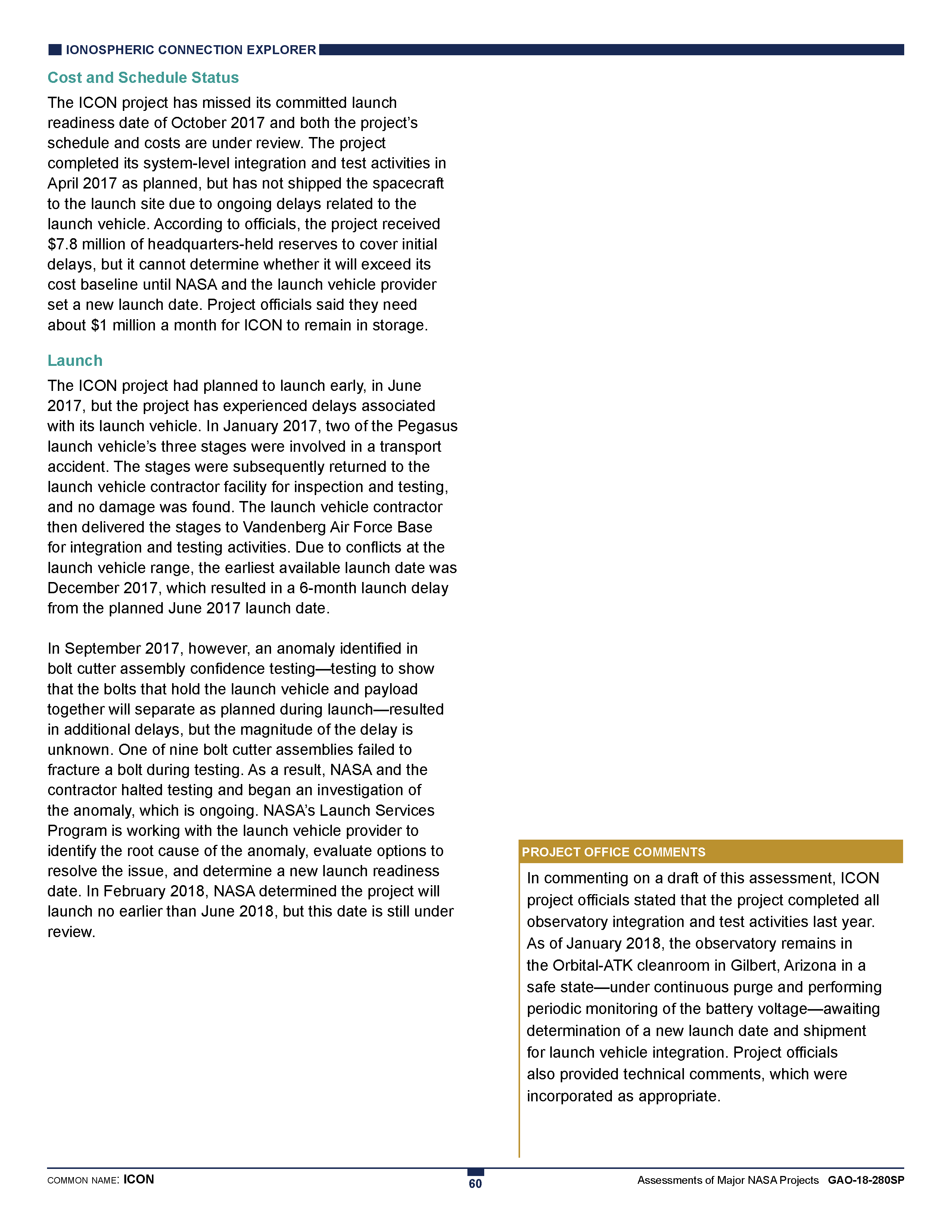
ЦитироватьNASA: Assessments of Major Projects
Government Accountability Office
May 1, 2018
Название: ICON – Pegasus XL – Cape Canaveral AFS, L-1011 "Stargazer" – 11.10.2019 – 04:59:05 ДМВ
Отправлено: tnt22 от 26.05.2018 02:12:49
Отправлено: tnt22 от 26.05.2018 02:12:49
ЦитироватьOrbital ATKПодлинная учетная запись @OrbitalATK (https://twitter.com/OrbitalATK) 5 ч. назад (https://twitter.com/OrbitalATK/status/1000080250405994497)
The #Stargazer (https://twitter.com/hashtag/Stargazer?src=hash) L-1011 has landed in VAFB @30thSpaceWing (https://twitter.com/30thSpaceWing) to prepare for the upcoming launch of #Pegasus (https://twitter.com/hashtag/Pegasus?src=hash), carrying the Orbital ATK-built ICON satellite for @NASA (https://twitter.com/NASA) , scheduled to launch on June 14. #NASAICON (https://twitter.com/hashtag/NASAICON?src=hash)
Название: ICON – Pegasus XL – Cape Canaveral AFS, L-1011 "Stargazer" – 11.10.2019 – 04:59:05 ДМВ
Отправлено: tnt22 от 29.05.2018 20:07:47
Отправлено: tnt22 от 29.05.2018 20:07:47
https://blogs.nasa.gov/icon/2018/05/29/icon-satellite-arrives-at-vandenberg/
ЦитироватьICON Satellite Arrives at Vandenberg
Bob Granath (https://blogs.nasa.gov/icon/author/rgranath/)
Posted May 29, 2018 at 12:54 pm
A solar array illumination test is performed on NASA's Ionospheric Connection Explorer, or ICON, satellite in the Building 1555 clean room Friday, May 4, 2018, at Vandenberg Air Force Base in California. The test checks for any imperfections and confirms that the solar arrays are functioning properly.
ICON arrived on May 1, 2018, and preflight processing began after it was offloaded and transported to its current location. The explorer will launch June 15, 2018, fr om Kwajalein Atoll in the Marshall Islands (June 14 in the continental United States). The satellite will be carried aloft on Orbital ATK's Pegasus XL rocket, attached to the company's L-1011 Stargazer aircraft.
ICON will study the frontier of space — the dynamic zone high in Earth's atmosphere wh ere terrestrial weather from below meets space weather above. The explorer will help determine the physics of Earth's space environment and pave the way for mitigating its effects on technology, communications systems and society.
Photo credit: USAF 30th Space Wing/Daniel Quinajon
Название: ICON – Pegasus XL – Cape Canaveral AFS, L-1011 "Stargazer" – 11.10.2019 – 04:59:05 ДМВ
Отправлено: tnt22 от 30.05.2018 11:12:04
Отправлено: tnt22 от 30.05.2018 11:12:04
ЦитироватьOrbital ATKПодлинная учетная запись @OrbitalATK (https://twitter.com/OrbitalATK) 9 ч. назад (https://twitter.com/OrbitalATK/status/1001601130852487168)
Our teams continue to prepare for launch of @NASA (https://twitter.com/NASA)'s Ionospheric Connection Explorer (ICON) satellite, scheduled to launch aboard our #Pegasus (https://twitter.com/hashtag/Pegasus?src=hash) rocket 6/14. Designed & integrated at our Gilbert, AZ facility, ICON will study effects of the ionosphere on communications transmissionСпойлер
[свернуть]
Название: ICON – Pegasus XL – Cape Canaveral AFS, L-1011 "Stargazer" – 11.10.2019 – 04:59:05 ДМВ
Отправлено: tnt22 от 31.05.2018 23:53:07
Отправлено: tnt22 от 31.05.2018 23:53:07
https://www.nasa.gov/press-release/nasa-previews-mission-to-study-frontier-of-space
ЦитироватьMay 29, 2018
MEDIA ADVISORY M18-087
NASA Previews Mission to Study Frontier of Space(https://www.nasa.gov/sites/default/files/thumbnails/image/iss_composite_test_182_0.jpg)
Processes in Earth's ionosphere create bright swaths of color in the sky, known as airglow, as seen here in an image taken from the International Space Station. NASA's Ionospheric Connection (ICON) mission will track airglow to observe how interactions between Earth's weather and the ionosphere create changes in our space environment.
Credits: NASA
NASA will host a media briefing at 1 p.m. EDT Monday, June 4, on the agency's mission to explore Earth's ionosphere and the processes there that impact life on Earth's surface. The event will air live on NASA Television, the agency's website (https://www.nasa.gov/live) and Facebook Live (https://www.facebook.com/NASASunScience).Last Updated: May 31, 2018Спойлер
Ionospheric Connection Explorer (ICON (https://www.nasa.gov/icon)) will study the layer of charged particles extending from about 50 to 360 miles above Earth's surface, through which radio communications and GPS signals travel, and the processes there that can distort or even disrupt these signals. Knowledge gleaned from this mission will aid in mitigating its effects on satellites and communications technology worldwide.
The event will be held at NASA's Goddard Space Flight Center in Greenbelt, Maryland. Participants will include:[/li]
...- Willis Jenkins, ICON program executive at NASA Headquarters, Washington
- Thomas Immel, mission principal investigator at the University of California Berkeley's Space Sciences Laboratory
- Rebecca Bishop, ionospheric research scientist at Aerospace Corporation
- Douglas Rowland, mission scientist at Goddard
ICON will launch June 14 Eastern time on an Orbital ATK Pegasus XL rocket from Kwajalein Atoll in the Marshall Islands and deploy from Orbital's L-1011 Stargazer aircraft.[свернуть]
Editor: Karen Northon
Название: ICON – Pegasus XL – Cape Canaveral AFS, L-1011 "Stargazer" – 11.10.2019 – 04:59:05 ДМВ
Отправлено: tnt22 от 03.06.2018 07:06:05
Отправлено: tnt22 от 03.06.2018 07:06:05
ЦитироватьOrbital ATKПодлинная учетная запись @OrbitalATK (https://twitter.com/OrbitalATK) 2 ч. назад (https://twitter.com/OrbitalATK/status/1003088298586226688)
Operations are rolling in VAFB as our crew moved and mated the #Pegasus (https://twitter.com/hashtag/Pegasus?src=hash) rocket to the #Stargazer (https://twitter.com/hashtag/Stargazer?src=hash) #L1011 (https://twitter.com/hashtag/L1011?src=hash) airplane in preps for a June 14 Launch of #NASAICON (https://twitter.com/hashtag/NASAICON?src=hash). Stay tuned to @NASA_LSP (https://twitter.com/NASA_LSP) for live launch coverage!
Название: ICON – Pegasus XL – Cape Canaveral AFS, L-1011 "Stargazer" – 11.10.2019 – 04:59:05 ДМВ
Отправлено: tnt22 от 04.06.2018 18:24:47
Отправлено: tnt22 от 04.06.2018 18:24:47
ЦитироватьNASA_EDGE @NASA_EDGE (https://twitter.com/NASA_EDGE) 47 мин. назад (https://twitter.com/NASA_EDGE/status/1003646669009743872)
We go live at 12:30 pm EDT for the Countdown to the ICON Ferry Flight show live from Vandenberg AFB. Check it out on NASA TV and on Facebook Live. http://www.facebook.com/nasaedgefan (https://t.co/yTzWbA5lbL) #NASAICON (https://twitter.com/hashtag/NASAICON?src=hash) #nasa (https://twitter.com/hashtag/nasa?src=hash) #orbitalatk (https://twitter.com/hashtag/orbitalatk?src=hash) #Stargazer (https://twitter.com/hashtag/Stargazer?src=hash) #Pegasus (https://twitter.com/hashtag/Pegasus?src=hash) #L1011 (https://twitter.com/hashtag/L1011?src=hash) #NASALSP (https://twitter.com/hashtag/NASALSP?src=hash)
Название: ICON – Pegasus XL – Cape Canaveral AFS, L-1011 "Stargazer" – 11.10.2019 – 04:59:05 ДМВ
Отправлено: tnt22 от 04.06.2018 19:27:19
Отправлено: tnt22 от 04.06.2018 19:27:19
Название: ICON – Pegasus XL – Cape Canaveral AFS, L-1011 "Stargazer" – 11.10.2019 – 04:59:05 ДМВ
Отправлено: tnt22 от 04.06.2018 19:43:17
Отправлено: tnt22 от 04.06.2018 19:43:17
Название: ICON – Pegasus XL – Cape Canaveral AFS, L-1011 "Stargazer" – 11.10.2019 – 04:59:05 ДМВ
Отправлено: tnt22 от 04.06.2018 19:46:53
Отправлено: tnt22 от 04.06.2018 19:46:53
Название: ICON – Pegasus XL – Cape Canaveral AFS, L-1011 "Stargazer" – 11.10.2019 – 04:59:05 ДМВ
Отправлено: tnt22 от 04.06.2018 19:48:05
Отправлено: tnt22 от 04.06.2018 19:48:05
Название: ICON – Pegasus XL – Cape Canaveral AFS, L-1011 "Stargazer" – 11.10.2019 – 04:59:05 ДМВ
Отправлено: tnt22 от 04.06.2018 19:49:49
Отправлено: tnt22 от 04.06.2018 19:49:49
Название: ICON – Pegasus XL – Cape Canaveral AFS, L-1011 "Stargazer" – 11.10.2019 – 04:59:05 ДМВ
Отправлено: tnt22 от 04.06.2018 19:50:30
Отправлено: tnt22 от 04.06.2018 19:50:30
Название: ICON – Pegasus XL – Cape Canaveral AFS, L-1011 "Stargazer" – 11.10.2019 – 04:59:05 ДМВ
Отправлено: tnt22 от 04.06.2018 19:50:46
Отправлено: tnt22 от 04.06.2018 19:50:46
Название: ICON – Pegasus XL – Cape Canaveral AFS, L-1011 "Stargazer" – 11.10.2019 – 04:59:05 ДМВ
Отправлено: tnt22 от 04.06.2018 20:00:56
Отправлено: tnt22 от 04.06.2018 20:00:56
Название: ICON – Pegasus XL – Cape Canaveral AFS, L-1011 "Stargazer" – 11.10.2019 – 04:59:05 ДМВ
Отправлено: tnt22 от 04.06.2018 20:01:07
Отправлено: tnt22 от 04.06.2018 20:01:07
Название: ICON – Pegasus XL – Cape Canaveral AFS, L-1011 "Stargazer" – 11.10.2019 – 04:59:05 ДМВ
Отправлено: tnt22 от 04.06.2018 20:01:16
Отправлено: tnt22 от 04.06.2018 20:01:16
Название: ICON – Pegasus XL – Cape Canaveral AFS, L-1011 "Stargazer" – 11.10.2019 – 04:59:05 ДМВ
Отправлено: tnt22 от 04.06.2018 20:04:18
Отправлено: tnt22 от 04.06.2018 20:04:18
Название: ICON – Pegasus XL – Cape Canaveral AFS, L-1011 "Stargazer" – 11.10.2019 – 04:59:05 ДМВ
Отправлено: tnt22 от 04.06.2018 20:06:03
Отправлено: tnt22 от 04.06.2018 20:06:03
Название: ICON – Pegasus XL – Cape Canaveral AFS, L-1011 "Stargazer" – 11.10.2019 – 04:59:05 ДМВ
Отправлено: tnt22 от 04.06.2018 20:06:44
Отправлено: tnt22 от 04.06.2018 20:06:44
Название: ICON – Pegasus XL – Cape Canaveral AFS, L-1011 "Stargazer" – 11.10.2019 – 04:59:05 ДМВ
Отправлено: tnt22 от 04.06.2018 20:23:07
Отправлено: tnt22 от 04.06.2018 20:23:07
Название: ICON – Pegasus XL – Cape Canaveral AFS, L-1011 "Stargazer" – 11.10.2019 – 04:59:05 ДМВ
Отправлено: tnt22 от 04.06.2018 20:25:51
Отправлено: tnt22 от 04.06.2018 20:25:51
Название: ICON – Pegasus XL – Cape Canaveral AFS, L-1011 "Stargazer" – 11.10.2019 – 04:59:05 ДМВ
Отправлено: tnt22 от 04.06.2018 20:28:41
Отправлено: tnt22 от 04.06.2018 20:28:41
Название: ICON – Pegasus XL – Cape Canaveral AFS, L-1011 "Stargazer" – 11.10.2019 – 04:59:05 ДМВ
Отправлено: tnt22 от 04.06.2018 20:40:18
Отправлено: tnt22 от 04.06.2018 20:40:18
Название: ICON – Pegasus XL – Cape Canaveral AFS, L-1011 "Stargazer" – 11.10.2019 – 04:59:05 ДМВ
Отправлено: tnt22 от 04.06.2018 20:41:12
Отправлено: tnt22 от 04.06.2018 20:41:12
Название: ICON – Pegasus XL – Cape Canaveral AFS, L-1011 "Stargazer" – 11.10.2019 – 04:59:05 ДМВ
Отправлено: tnt22 от 04.06.2018 20:42:23
Отправлено: tnt22 от 04.06.2018 20:42:23
Название: ICON – Pegasus XL – Cape Canaveral AFS, L-1011 "Stargazer" – 11.10.2019 – 04:59:05 ДМВ
Отправлено: tnt22 от 04.06.2018 20:51:09
Отправлено: tnt22 от 04.06.2018 20:51:09
Запись передачи NASA EDGE на Мордокниге
Цитировать(https://www.facebook.com/nasaedgefan/?ref=nf&hc_ref=ARRGNVRs9x66FLlXAecVjlW6P9sz6VylrvBeXWXYTAB4F-zLb5Z_sTUCOY6BAy86rhU) NASA EDGE (https://www.facebook.com/nasaedgefan/?hc_ref=ARTsqvbxg3XbGAJ5ujLWlJHtUbnHgIJKStAgtaYgj6LdiOvRd9cQFRETlnDcwzNuGEE) был(-а) в прямом эфире.
1 ч (https://www.facebook.com/nasaedgefan/videos/2062703803772222/) ·
https://scontent-arn2-1.xx.fbcdn.net/v/t42.9040-29/10000000_180285425967151_388689154399010816_n.mp4?_nc_cat=0&efg=eyJybHIiOjc0NywicmxhIjo0MDk2LCJ2ZW5jb2RlX3RhZyI6InNkIn0%3D&rl=747&vabr=415&oh=bebb8b05dbd678d66b8eb24e36849ce5&oe=5B15B584 (https://scontent-arn2-1.xx.fbcdn.net/v/t42.9040-29/10000000_180285425967151_388689154399010816_n.mp4?_nc_cat=0&efg=eyJybHIiOjc0NywicmxhIjo0MDk2LCJ2ZW5jb2RlX3RhZyI6InNkIn0%3D&rl=747&vabr=415&oh=bebb8b05dbd678d66b8eb24e36849ce5&oe=5B15B584)
(video (https://scontent-arn2-1.xx.fbcdn.net/v/t42.9040-29/10000000_180285425967151_388689154399010816_n.mp4?_nc_cat=0&efg=eyJybHIiOjc0NywicmxhIjo0MDk2LCJ2ZW5jb2RlX3RhZyI6InNkIn0%3D&rl=747&vabr=415&oh=bebb8b05dbd678d66b8eb24e36849ce5&oe=5B15B584) 58:36)
Название: ICON – Pegasus XL – Cape Canaveral AFS, L-1011 "Stargazer" – 11.10.2019 – 04:59:05 ДМВ
Отправлено: tnt22 от 04.06.2018 21:16:28
Отправлено: tnt22 от 04.06.2018 21:16:28
Запись брифинга "Exploring the Frontier of Space" на Мордокниге
Цитировать(https://www.facebook.com/NASASunScience/?ref=nf&hc_ref=ARSjvBNatE6SfOGHSskTwv-EMYVdmAFsSOvSvYAM8DBsX7ijfv2PWyxZ68e0XiV8Xx0) NASA Sun Science (https://www.facebook.com/NASASunScience/?hc_ref=ARStok6hdZiIil_d-uEnO0PDyTyc1Xfqip2NZ-njTBzGRDlRP8xDG8Ou6H7QtRsLOl0) был(-а) в прямом эфире.
1 ч (https://www.facebook.com/NASASunScience/videos/1654971951216688/) ·
The boundary between Earth and space is a dynamic region, filled with a swirling mix of charged and neutral particles. It's shaped by both Earth's weather from below and space weather from above, making it difficult to predict changes here — but those changes can impact satellites and communications signals.
We're launching a new satellite to study this region — the Ionospheric Connection Explorer, or ICON. ICON launches on June 14 (Eastern time) on an Orbital ATK Pegasus XL rocket from Kwajalein Atoll in the Marshall Islands.
Join us live to learn more, see your #askNASA (https://www.facebook.com/hashtag/asknasa?source=feed_text) questions answered, and find out why our scientists are so excited about this mission!
nasa.gov/icon (http://nasa.gov/icon)
Participating live are:
- Willis Jenkins, ICON program executive at NASA Headquarters, Washington
- Thomas Immel, mission principal investigator at the University of California Berkeley's Space Sciences Laboratory
- Rebecca Bishop, ionospheric research scientist at The Aerospace Corporation
- Douglas Rowland, mission scientist at Goddard
- Don Pettit, NASA astronaut
https://scontent-arn2-1.xx.fbcdn.net/v/t42.9040-29/10000000_825333994326173_5577132496916578304_n.mp4?_nc_cat=0&efg=eyJybHIiOjg3NCwicmxhIjo0MDk2LCJ2ZW5jb2RlX3RhZyI6InNkIn0%3D&rl=874&vabr=486&oh=9600974fe3df5fc1aad66d687a037a8e&oe=5B15B00A (https://scontent-arn2-1.xx.fbcdn.net/v/t42.9040-29/10000000_825333994326173_5577132496916578304_n.mp4?_nc_cat=0&efg=eyJybHIiOjg3NCwicmxhIjo0MDk2LCJ2ZW5jb2RlX3RhZyI6InNkIn0%3D&rl=874&vabr=486&oh=9600974fe3df5fc1aad66d687a037a8e&oe=5B15B00A)
(video (https://scontent-arn2-1.xx.fbcdn.net/v/t42.9040-29/10000000_825333994326173_5577132496916578304_n.mp4?_nc_cat=0&efg=eyJybHIiOjg3NCwicmxhIjo0MDk2LCJ2ZW5jb2RlX3RhZyI6InNkIn0%3D&rl=874&vabr=486&oh=9600974fe3df5fc1aad66d687a037a8e&oe=5B15B00A) 25:41)
Название: ICON – Pegasus XL – Cape Canaveral AFS, L-1011 "Stargazer" – 11.10.2019 – 04:59:05 ДМВ
Отправлено: tnt22 от 04.06.2018 21:49:50
Отправлено: tnt22 от 04.06.2018 21:49:50
ЦитироватьNASA EDGE Live Streamhttps://www.youtube.com/watch?v=63rj--t72Nwhttps://www.youtube.com/watch?v=63rj--t72Nw (https://www.youtube.com/watch?v=63rj--t72Nw) (1:06:18 )
NASA EDGE (https://www.youtube.com/channel/UCEPgFeclBHqZp80D14J5kfA)
Трансляция началась 2 часа назад
Название: ICON – Pegasus XL – Cape Canaveral AFS, L-1011 "Stargazer" – 11.10.2019 – 04:59:05 ДМВ
Отправлено: tnt22 от 04.06.2018 21:50:49
Отправлено: tnt22 от 04.06.2018 21:50:49
ЦитироватьOrbital ATKПодлинная учетная запись @OrbitalATK (https://twitter.com/OrbitalATK) 5 мин. назад (https://twitter.com/OrbitalATK/status/1003709227465048065)
The #Pegasus (https://twitter.com/hashtag/Pegasus?src=hash) team is busy conducting final tests aboard the #Stargazer (https://twitter.com/hashtag/Stargazer?src=hash) L-1011 in preparation for tomorrow's ferry flight to Kwajalein Atoll for the June 14th launch of the Orbital ATK-built ICON satellite for @NASA (https://twitter.com/NASA)! Be sure to follow @NASA_LSP (https://twitter.com/NASA_LSP) for live launch coverage. #NASAICON (https://twitter.com/hashtag/NASAICON?src=hash)
Название: ICON – Pegasus XL – Cape Canaveral AFS, L-1011 "Stargazer" – 11.10.2019 – 04:59:05 ДМВ
Отправлено: tnt22 от 05.06.2018 12:25:36
Отправлено: tnt22 от 05.06.2018 12:25:36
ЦитироватьOrbital ATKПодлинная учетная запись @OrbitalATK (https://twitter.com/OrbitalATK) 9 ч. назад (https://twitter.com/OrbitalATK/status/1003801645967278080)
Beautiful photo of our #Stargazer (https://twitter.com/hashtag/Stargazer?src=hash) L-1011 and the #Pegasus (https://twitter.com/hashtag/Pegasus?src=hash) rocket taken by @NASA_EDGE (https://twitter.com/NASA_EDGE). Our ferry flight has been moved one day to accommodate additional testing, launch date should remain June 14 from Kwajalein Atoll. @NASA_LSP (https://twitter.com/NASA_LSP) #NASAICON (https://twitter.com/hashtag/NASAICON?src=hash)
Название: ICON – Pegasus XL – Cape Canaveral AFS, L-1011 "Stargazer" – 11.10.2019 – 04:59:05 ДМВ
Отправлено: Maks от 06.06.2018 13:35:33
Отправлено: Maks от 06.06.2018 13:35:33
В России запрещали подобные работы, т.к. все деньги тратили на военные проекты. В России накоплены горы оружия, бедное, как в Африке вымирающее население, и параллельно шли работы по уничтожению ненужного химического оружия, баллистических ракет (запускаемых с поездов), резка корпусов атомных подводных лодок. На Украине резали ненужные бомбардировщики Ту-160. Bсе принадлежащие Украины стратегические ядерные боеголовки были переданы России и там уничтожены.
Название: ICON – Pegasus XL – Cape Canaveral AFS, L-1011 "Stargazer" – 11.10.2019 – 04:59:05 ДМВ
Отправлено: tnt22 от 06.06.2018 16:18:01
Отправлено: tnt22 от 06.06.2018 16:18:01
ЦитироватьNASA_LSPПодлинная учетная запись @NASA_LSP (https://twitter.com/NASA_LSP) 20 мин.назад (https://twitter.com/NASA_LSP/status/1004345676489256961)
On June 14 at 10:06 a.m. ET @nasa (https://twitter.com/NASA)'s ionosphere explorer, ICON, will launch from Kwajalein Atoll in the Marshall Islands aboard a @orbitalatk (https://twitter.com/OrbitalATK) Pegasus XL rocket. More photos from the mission: https://go.nasa.gov/2M2hhpm (https://t.co/prupteTEy9)
Спойлер
[свернуть]
Название: ICON – Pegasus XL – Cape Canaveral AFS, L-1011 "Stargazer" – 11.10.2019 – 04:59:05 ДМВ
Отправлено: tnt22 от 06.06.2018 20:04:17
Отправлено: tnt22 от 06.06.2018 20:04:17
https://blogs.nasa.gov/icon/2018/06/06/nasa-completes-flight-readiness-review-for-icon-satellite/
ЦитироватьNASA Completes Flight Readiness Review for ICON Satellite
Bob Granath (https://blogs.nasa.gov/icon/author/rgranath/)
Posted Jun 6, 2018 at 11:48 am
A technician uses an ultraviolet light to inspect the Orbital ATK Pegasus XL payload fairing on May 22, 2018. The examination is taking place after mating NASA's Ionospheric Connection Explorer, or ICON, satellite to the Pegasus XL rocket inside Building 1555 at Vandenberg Air Force Base in California.
Photo credit: NASA/Randy Beaudoin
Following a Flight Readiness Review NASA Launch Director Omar Baez and the mission team confirmed the Orbital ATK Pegasus XL rocket will be ready for its targeted launch date for the agency's Ionospheric Connection Explorer, or ICON, satellite. The spacecraft will be boosted to Earth orbit during a launch window between 10:01 to 10:38 a.m. EDT on June 14, 2018, (2:01 to 2:38 a.m. on June 15 at the launch site, Kwajalein Atoll in the Marshall Islands).
While the ICON satellite and its Pegasus XL rocket are being processed at Vandenberg Air Force Base in California, the combination was attached to Orbital ATK's L-1011 Star Gazer aircraft and will be ferried to the Reagan Test Site on Kwajalein Atoll.
On launch day the Stargazer aircraft will take off fr om Kwajalein carrying the Pegasus XL rocket. Five seconds after the rocket is released, its engine will ignite sending ICON to orbit.Спойлер
ICON is designed to study the frontier of space — the dynamic zone high in Earth's atmosphere wh ere terrestrial weather from below meets space weather above. The explorer will help determine the physics of Earth's space environment and pave the way for mitigating its effects on our technology and communications systems.
Scientists believe ICON will help determine the physics of our space environment and pave the way for mitigating its effects on our technology, communications systems and society.
NASA's Goddard Space Flight Center in Greenbelt, Maryland, manages the Explorer Program for NASA's Science Mission Directorate in Washington. UC Berkeley's Space Sciences Laboratory leads the ICON mission. The ICON spacecraft was built by Orbital ATK in Dulles, Virginia. NASA's Launch Services Program, based at the agency's Kennedy Space Center in Florida, is responsible for launch service acquisition, integration, analysis and launch management.[свернуть]
Название: ICON – Pegasus XL – Cape Canaveral AFS, L-1011 "Stargazer" – 11.10.2019 – 04:59:05 ДМВ
Отправлено: tnt22 от 07.06.2018 15:17:51
Отправлено: tnt22 от 07.06.2018 15:17:51
https://spaceflightnow.com/2018/06/06/pegasus-rocket-nasa-satellite-head-for-launch-base-in-pacific/
ЦитироватьPegasus rocket, NASA satellite head for launch base in Pacific
June 6, 2018 (https://spaceflightnow.com/2018/06/) | Stephen Clark (https://spaceflightnow.com/author/stephen-clark/)
The Pegasus XL rocket, fastened underneath an L-1011 carrier plane, took off Wednesday fr om Vandenberg Air Force Base, California, en route to Kwajalein Atoll in the Pacific Ocean. Credit: Gene Blevins/LA Daily News
Slung under the belly of a specially-equipped carrier airplane, a Northrop Grumman Pegasus rocket took off Wednesday from Vandenberg Air Force Base on a two-day trek to a remote U.S. military test site in the Pacific Ocean, wh ere crews will ready the air-dropped booster for launch of a NASA research satellite next week.
The ferry flight from California to Kwajalein Atoll in the mid-Pacific Ocean will position the Pegasus rocket, its carrier jet, and support teams for final preparations for launch June 14 with NASA's Ionospheric Connection Explorer, or ICON, a satellite designed to probe the link between Earth's atmosphere and space weather.
ICON is about the size of a refrigerator and weighs a little more than 600 pounds for launch. The $252 million project is NASA's first mission dedicated to studying the influence of Earth's weather on the ionosphere, an ever-changing layer in the upper atmosphere that affects long-distance communications and navigation.
It will ride into orbit at the forward end of a 55-foot-long (17-meter), three-stage Pegasus XL rocket, the world's only operational air-launched orbital-class satellite booster.Спойлер
The ICON spacecraft and the Pegasus XL rocket were built by Orbital ATK.
In a coincidental confluence of events, the company's acquisition by Northrop Grumman closed Wednesday. Northrop Grumman announced the conclusion of the transaction soon after the Pegasus rocket's L-1011 carrier aircraft, named "Stargazer," left California on the two-leg journey to Kwajalein.
Orbital ATK, formed three years ago by the merger of Orbital Sciences and ATK, now functions as a distinct business unit within Northrop Grumman, and has been renamed Northrop Grumman Innovation Systems.
The three-engine L-1011 carrier jet took off from Vandenberg's concrete runway with the Pegasus XL rocket at around 12 p.m. PDT (3 p.m. EDT; 1900 GMT) Wednesday, heading for an overnight layover at Hickam Air Force Base, Hawaii.
A charter jet carrying a team of launch controllers, engineers and technicians departed Vandenberg a couple of hours before the L-1011 carrier jet, also heading for an overnight refueling stop in Hawaii.
Both aircraft are scheduled to arrive at Bucholz Army Airfield at Kwajalein Atoll, located in the Marshall Islands, late Thursday, U.S. time.
A view of the Pegasus XL rocket during preparations for the ferry flight to Kwajalein. Credit: Gene Blevins/LA Daily News
The L-1011 carrier jet will fly through the Pegasus rocket's planned drop box north of Kwajalein Atoll as it approaches the remote island, situated just west of the International Date Line. The launch team will run through the final steps of the Pegasus countdown checklist, and the U.S. Army's Reagan Test Site at Kwajalein will activate range tracking equipment to simulate launch day procedures.
The rehearsal opportunity will give the Pegasus crew a chance to practice the countdown, and ensure range systems and a mobile control center recently set up at Kwajalein by an advance team are ready for launch day.
"We'll do a practice dress rehearsal with all the actual radars and equipment that Reagan Test Site will be using for the mission to test that equipment with our rocket at the actual drop point, and with our crew in our control center that we've set up there, so that we can get an end-to-end check," said Eric Denbrook, Northrop Grumman's site manager and head of launch vehicle processing at Vandenberg Air Force Base, in an interview Monday. "That will be really close to what we'll see on launch day."
Once at Kwajalein, support crews will configure the already-assembled Pegasus XL rocket for launch, and engineers will ensure the solid-fueled booster and the ICON spacecraft weathered the nearly 5,000-mile (8,000-kilometer) journey from California unscathed.
Another compatibility check between the ICON spacecraft, Pegasus rocket, the Stargazer carrier plane, and the Reagan Test site is also planned this weekend. A final launch dress rehearsal is on tap early next week, including a test of data and telemetry relays between Kwajalein and the ICON satellite control center in Berkeley, California.
After final closeouts and launch preps, the L-1011 aircraft will take off from Kwajalein and head north to the Pegasus drop box. The L-1011's co-pilot will command release of the 51,000-pound (23-metric ton) Pegasus XL at 39,000 feet (11,900 meters) during a planned 37-minute window opening June 14 at 1401 GMT (10:01 a.m. EDT).
The drop is currently targeted for around 1406 GMT (10:06 a.m. EDT), or 2:06 a.m. Kwajalein time on June 15, to begin an eight-minute climb into orbit roughly 357 miles (575 kilometers) above Earth.
Next week's mission will mark the 44th launch of a Pegasus rocket on a satellite delivery mission, and the 34th in the Pegasus XL configuration with uprated solid rocket motors. It will be the fifth Pegasus mission staged from Kwajalein, a site which NASA and Northrop Grumman officials — then part of Orbital ATK — sel ected based on ICON's target orbit and the rocket's lift capability, which gets an extra boost from the island's equatorial location.
Kwajalein's location in the Pacific Ocean. Credit: Kwajalein Range Services
Now part of the U.S. military's Reagan Test Site, Kwajalein Atoll is part of the Marshall Islands. Before the nation gained independence, the territory was administered by the United States, which took control of Kwajalein, known as Kwaj for short, in a World War 2 battle that left numerous shipwrecks and crashed airplanes in the atoll's lagoon. Japan, Germany and Spain previously claimed Kwajalein and surrounding islands.
"There's a lot of interesting history on Kwaj, so people who haven't been there are kind of interested to go and see it for the first time," Denbrook said. "For us, the struggle is making sure we have enough spares and parts."
Kwajalein is around 2,400 miles (3,900 kilometers) southwest of Honolulu. Equipment needed by the L-1011 carrier jet, Pegasus ground control consoles, and other hardware required during the final days of the ICON launch campaign had to be transported by boat or airplane ahead of time.
"It's hard to get things in and out of that island, so we have to make sure we're prepared for any contingency that could take place," Denbrook said. "From a logistics standpoint, that's the toughest thing."
Denbrook's team prepared the Pegasus XL rocket for launch at Vandenberg's Building 1555.
Workers assembled the rocket's three stages, which arrived from a Northrop Grumman facility in Utah already packed with solid propellant, connected the Pegasus XL's delta-shaped wing and articulating fins, then mated the ICON spacecraft to the launcher last month, a few weeks after its shipment from a factory in Gilbert, Arizona.
The final launch processing work included encapsulation of the ICON satellite inside the Pegasus rocket's nose shroud, and the lifting of the launcher onto a transport trailer.
A technician inspects the Pegasus rocket's payload fairing before enclosing the ICON spacecraft (right) for launch. Credit: NASA/Randy Beaudoin
On Saturday morning, crews rolled the Pegasus XL out of Building 1555 to the Vandenberg airfield and under the belly of the L-1011 carrier plane, which was jacked off the ground to receive the rocket. Teams hooked the Pegasus to the aircraft Saturday afternoon, and ran a full checkout of electrical and telemetry connections between the vehicles and the Vandenberg range Sunday.
Engineers noticed some unexpected noise in the telemetry channels, prompting a one-day delay in the L-1011's ferry flight from Tuesday to Wednesday.
ICON's launch was delayed a year by a pair of concerns with its Pegasus launcher.
Engineers wanted more time to inspect the Pegasus rocket motors after they were mishandled during shipment to Vandenberg, officials said. That pushed the launch back from June to December 2017, the next availability in the military-run range at Kwajalein.
Then managers decided to ground the mission to assess the reliability of bolt-cutters used to jettison the Pegasus rocket's payload fairing and separate the satellite in orbit. Bryan Baldwin, senior director of the Pegasus program at Orbital ATK, told Spaceflight Now that engineers opted to use slightly smaller quarter-inch diameter bolts for those functions on the ICON mission to ensure the bolt-cutter mechanisms do their job.
The quarter-inch bolts have flown on previous missions, and they still meet the Pegasus vehicle's structural requirements, Baldwin said.
Officials have dedicated the rocket set to deliver ICON to space in honor of Ebb Harris, who piloted numerous Pegasus launch missions since the dawn of the program more than a quarter-century ago. Harris died earlier this year.
"Ebb has been a mentor to everyone who has come since the beginning of the program, a true gentleman, a very knowledgable and competent airman, and just a fun guy to be around," said Don Walter, who will command the L-1011 aircraft during the ICON mission. "On every rocket that we launch, we have the ability to dedicate it to somebody, so if you look at the side of the rocket, you'll see that this rocket is dedicated to Ebb."
A dedication to former L-1011 pilot Ebb Harris is scripted under the starboard wing of the Pegasus XL rocket. Credit: Northrop Grumman
After its launch next week, ICON will go through a month of in-orbit testing before commencing science observations to examine a mysterious connection between the variability of the ionosphere with weather phenomena deeper in Earth's atmosphere.
"The ionosphere is the densest plasma in space between us and the sun, and that plasma has a number of effects on systems that we use every day," said Thomas Immel, ICON's principal investigator at the University of California, Berkeley.
The ICON mission will study "how weather in our lower atmosphere, the weather we experience fr om day to day, influences conditions in space," he said. "This coupling of the lower atmosphere to the upper atmosphere is a new science topic for NASA."
Previous NASA missions detected a link between the weather in the lower atmosphere to changes in the ionosphere, which scientists had thought was primarily driven by solar activity.
"We saw with those missions that the density in the ionosphere varied in response to changes in the rainy seasons in the tropics," Immel said. "The new mission of ICON is to focus on that topic, and we're carrying the instruments to invesitgate that region.
"We think focusing on that will give us a real key to understanding and making better predictions for space weather," he said.[свернуть]
Название: ICON – Pegasus XL – Cape Canaveral AFS, L-1011 "Stargazer" – 11.10.2019 – 04:59:05 ДМВ
Отправлено: tnt22 от 07.06.2018 18:31:32
Отправлено: tnt22 от 07.06.2018 18:31:32
https://www.nasa.gov/mission_pages/launch/pegasus_countdown101.html
ЦитироватьJune 5, 2018
Pegasus: Countdown 101(https://www.nasa.gov/sites/default/files/thumbnails/image/bigpegasuspic-square_0.jpg)
Orbital ATK's "Stargazer" L-1011 in flight with Pegasus attached.
Credits: Orbital ATK(https://www.nasa.gov/sites/default/files/thumbnails/image/ignition_35.jpg)
Flying over the Atlantic Ocean offshore fr om Daytona Beach, Florida, a Pegasus XL rocket carrying the Cyclone Global Navigation Satellite System payload begins its flight as the rocket's first stage ignites.
Credits: NASA
Pegasus XL is a winged, three-stage solid propellant rocket built by Orbital ATK that can launch a satellite into low earth orbit. The Pegasus is carried aloft for launch by a L-1011 jet called the "Stargazer."
After takeoff, the aircraft flies to about 39,000 feet over the ocean and releases the rocket. Following a five-second free-fall in a horizontal position, the Pegasus XL rocket's first stage ignites. The aerodynamic lift, generated by the rocket's triangle-shaped wing, delivers the payload into orbit in about 10 minutes.
Pegasus XL is used to deploy small satellites weighing up to 1,000 pounds into low-Earth orbit from virtually anywhere in the world wh ere a runway with support and checkout facilities is available. These locations include Kennedy Space Center in Florida, Vandenberg Air Force Base in California, Wallops Flight Facility in Virginia, and the Kwajalein Missile Range in the South Pacific.
Here are some typical countdown milestones and key events that take place after the countdown begins. NOTE: Event times and lengths are approximate and subject to change.
Countdown for PegasusLast Updated: June 6, 2018Спойлер
T-4 hours, 15 minutes[/li]
T-3 hours, 15 minutes- Ground operations checks are completed
[/li]
T-2 hours, 20 minutes- NASA launch manager and NASA advisory manager take a "management on station" voice-check poll
[/li]
T-2 hours, 18 minutes- Flight crew enters the L-1011 carrier aircraft
- Pilot completes prestart checklist
[/li]
T-2 hours, 10 minutes through T-1 hour, 20 minutes- Engine start poll is taken
[/li]
T-1 hour, 45 minutes through T-45 minutes- Ground launch team receives "go" for engine start
- Start engines
- Aircraft stairs are removed and the hatch is closed
[/li]
T-1 hour, 15 minutes- L-1011 pre-taxi checklist complete
- Flight Termination System (FTS) power on
- Voice checks complete
[/li]
T-1 hour, 3 minutes- "Go" for taxi after tower clearance is given
- Taxi is under way
[/li]
T-1 hour- Last chance status check completed
[/li]
T-30 minutes- Ground launch team "ready for takeoff" poll taken
- Launch team is "go" for takeoff
- After tower clearance, the L-1011 carrier aircraft takes off
- Chase plane takes off to follow the L-1011
[/li]
T-15 minutes- Chase plane visual inspection
- Report on turbulence, winds and clouds at launch point requested
[/li]
T-12 minutes- Release mechanism is armed
[/li]
T-9 minutes- Verify FTS check is nominal
- Transfer avionics to internal power
[/li]
T-7 minutes- Weather status report is confirmed and green for launch
- Peak power has been passed
- L-1011 heads for the drop point
[/li]
T-5 minutes- Range status report is given
- Verify transient power is "on" and vehicle is safe
[/li]
T-45 seconds- NASA launch manager conducts final launch readiness poll to enter terminal countdown
- Avionics now on internal power
[/li]
T-20 seconds- Fin battery is activated
[/li]
T-10 seconds- Verify fin testing and heading status
[/li]
T-Zero- Pilot confirms Pegasus is "go" for launch
[/li]
T+5 seconds- Pegasus is dropped from the L-1011
[/li]
T+1 minute, 17 seconds- Pegasus first stage motor is ignited
[/li]
T+1 minute, 30 seconds- First stage motor burnout
[/li]
T+2 minutes, 11 seconds- First stage separation, followed by second stage motor ignition
[/li]
T+2 minutes, 44 seconds- Fairing separation
[/li]
T+4 minutes, 53 seconds- Second stage motor burnout
[/li]
T+5 minutes- Second stage separation
[/li]
T+6 minutes, 12 seconds- Third stage motor ignition
[/li]
T+6 minutes, 32 seconds- Third stage motor burnout
[/li]
T+8 minutes, 42 seconds- Begin thermal roll
[/li]
T+9 minutes, 32 seconds- End thermal roll
[/li]
- Payload separation
- Pegasus has successfully delivered its payload into orbit!
- The L-1011 carrier aircraft returns to its departure point.
[свернуть]
Editor: NASA Content Administrator
Название: ICON – Pegasus XL – Cape Canaveral AFS, L-1011 "Stargazer" – 11.10.2019 – 04:59:05 ДМВ
Отправлено: tnt22 от 08.06.2018 23:29:06
Отправлено: tnt22 от 08.06.2018 23:29:06
https://www.nasa.gov/multimedia/nasatv/schedule.html
ЦитироватьNASA Television Upcoming Events
Watch NASA TV (https://www.nasa.gov/multimedia/nasatv/index.html#public)
JUNE
June 14, Thursday
9:45 a.m. – Coverage of the launch of the Ionospheric Connection Explorer (ICON) on a Northrop Grumman Pegasus rocket from Kwajalein Atoll in the Pacific. Launch window is 10:01 a.m. – 10:38 a.m. (Media Channel)
Название: ICON – Pegasus XL – Cape Canaveral AFS, L-1011 "Stargazer" – 11.10.2019 – 04:59:05 ДМВ
Отправлено: tnt22 от 09.06.2018 06:48:45
Отправлено: tnt22 от 09.06.2018 06:48:45
https://blogs.nasa.gov/icon/2018/06/08/launch-of-nasas-icon-satellite-postponed/
ЦитироватьLaunch of NASA's ICON Satellite Postponed
Linda Herridge (https://blogs.nasa.gov/icon/author/lherridg/)
Posted Jun 8, 2018 at 5:30 pm
NASA and Northrop Grumman have postponed the launch of the agency's Ionospheric Connection Explorer (ICON) satellite. ICON, which will study the frontier of space, was targeted to launch on a Pegasus XL rocket June 14 from the Kwajalein Atoll in Marshall Islands.
During a ferry transit, Northrop Grumman saw off-nominal data from the Pegasus rocket. While ICON remains healthy, the mission will return to Vandenberg Air Force Base in California for rocket testing and data analysis. A new launch date will be determined at a later date.
Название: ICON – Pegasus XL – Cape Canaveral AFS, L-1011 "Stargazer" – 11.10.2019 – 04:59:05 ДМВ
Отправлено: tnt22 от 09.06.2018 06:57:05
Отправлено: tnt22 от 09.06.2018 06:57:05
https://news.northropgrumman.com/news/releases/northrop-grumman-statement-on-pegasus-icon-launch
Цитировать[SIZE=8]Northrop Grumman Statement on Pegasus/ICON Launch[/SIZE]
FALLS CHURCH, Va. – June 8, 2018 – Northrop Grumman Corporation (NYSE: NOC) posted the following statement today:
"Northrop Grumman, working with NASA, has made the decision to postpone the June 14 launch of the Pegasus XL rocket, carrying the ICON spacecraft. The company will return Pegasus to Vandenberg Air Force Base to conduct testing of the rocket after off-nominal data was seen during the ferry flight. Upon further review of the data, the teams will work to determine a new launch date. As always, Northrop Grumman works with NASA to base its launch decisions on assuring mission success for our customer.
Название: ICON – Pegasus XL – Cape Canaveral AFS, L-1011 "Stargazer" – 11.10.2019 – 04:59:05 ДМВ
Отправлено: tnt22 от 09.06.2018 07:23:55
Отправлено: tnt22 от 09.06.2018 07:23:55
https://spaceflightnow.com/2018/06/08/airplane-with-pegasus-rocket-returning-to-california-postponing-nasa-satellite-launch/
ЦитироватьCarrier jet with Pegasus rocket returning to California, postponing NASA satellite launch
June 8, 2018 (https://spaceflightnow.com/2018/06/) | Stephen Clark (https://spaceflightnow.com/author/stephen-clark/)
EDITOR'S NOTE: Upd ated at 6 p.m. EDT (2200 GMT).
The L-1011 carrier aircraft with Northrop Grumman's air-dropped Pegasus launcher departed Vandenberg Air Force Base, California, on Wednesday on a planned two-day ferry flight to Kwajalein Atoll. The aircraft and Pegasus rocket will return to Vandenberg after teams encountered a technical concern en route to Kwajalein. Credit: USAF 30th Space Wing/Dan Herrera
NASA and Northrop Grumman officials decided Friday to return a Pegasus rocket and its carrier aircraft fr om Hawaii to California, aborting a trip to Kwajalein Atoll in the Pacific Ocean for next week's scheduled launch of a NASA research satellite to conduct additional testing.
The return trip to California will postpone the launch of NASA's Ionospheric Connection Explorer, known as ICON, indefinitely. Launch was scheduled for next Thursday, June 14, U.S. time.
"Northrop Grumman, working with NASA, has made the decision to postpone the June 14 launch of the Pegasus XL rocket, carrying the ICON spacecraft," the company said in a statement. "The company will return Pegasus to Vandenberg Air Force Base to conduct testing of the rocket after off-nominal data was seen during the ferry flight.
"Upon further review of the data, the teams will work to determine a new launch date," the statement said. "As always, Northrop Grumman works with NASA to base its launch decisions on assuring mission success for our customer."
The U.S. Army's Reagan Test Site, which manages the launch range at Kwajalein, has limited windows available for civilian launchers like the Pegasus. The Pegasus rocket's return to California is expected to cause the mission to miss its narrow launch opportunity in June, prompting a delay that could be measured in months.
The air-launched Pegasus XL rocket, nestled under the belly of an L-1011 carrier jet, departed Vandenberg Air Force Base, California, on Wednesday, heading for an overnight stop at Hickam Air Force Base, Hawaii, en route to Kwajalein Atoll, home to a U.S. military launch range in the mid-Pacific Ocean.
But teams reversed course after detecting a technical problem on the first leg of the journey. The nature of the "off-nominal data" found during the ferry flight was not announced as of Friday afternoon, and a NASA spokesperson did not provide further information when asked.
The L-1011 aircraft, along with a team of controllers, technicians and engineers making the trip on a charter airplane, did not take off for Kwajalein as planned Thursday, and officials decided Friday to bring the rocket back to Vandenberg Air Force Base, wh ere Pegasus launchers are assembled and readied for missions.Спойлер
The online flight tracking website FlightAware.com showed the charter plane with members of the ICON team took off from Honolulu on Friday bound for Vandenberg. A flight plan for the L-1011 aircraft, carrying the Pegasus rocket, showed it was scheduled to leave Hawaii later Friday.
The ICON satellite is fastened to the forward end of the 55-foot-long (17-meter) Pegasus rocket. ICON will probe the link between Earth's atmosphere and space weather.
ICON is about the size of a refrigerator and weighs a little more than 600 pounds for launch. The $252 million project is NASA's first mission dedicated to studying the influence of Earth's weather on the ionosphere, an ever-changing layer in the upper atmosphere that affects long-distance communications and navigation.
The mission was se t to be the first satellite launch conducted by Northrop Grumman after the aerospace contractor's purchase of Orbital ATK, which developed the Pegasus rocket. Orbital ATK has conducted 43 satellite launches with Pegasus rockets since 1990, and a record which includes 29 successful orbital-class missions in a row since 1997.
The fully-assembled Pegasus XL rocket, with the ICON spacecraft in its nose cone, before departure from Vandenberg Air Force Base on Wednesday. Credit: NASA/Randy Beaudoin
ICON will be the fifth Pegasus mission staged from Kwajalein, a site which NASA and Northrop Grumman officials — then part of Orbital ATK — sel ected based on ICON's target orbit and the rocket's lift capability, which gets an extra boost from the island's equatorial location.
The Pegasus team had pre-staged key equipment, including launch control consoles and spares for the Pegasus rocket and the L-1011 carrier aircraft, at Kwajalein months before the mission's scheduled takeoff.
Located in the Marshall Islands, Kwajalein is around 2,400 miles (3,900 kilometers) southwest of Honolulu, just west of the International Date Line.
ICON's launch has been delayed a year by a pair of concerns with its Pegasus launcher.
Engineers wanted more time to inspect the Pegasus rocket motors after they were mishandled during shipment to Vandenberg, officials said. That pushed the launch back fr om June to December 2017, the next availability in the military-run range at Kwajalein.
Then managers decided to ground the mission to assess the reliability of bolt-cutters used to jettison the Pegasus rocket's payload fairing and separate the satellite in orbit. Workers installed smaller bolts in the fairing and satellite separation mechanisms, a measure officials said will ensure the cutters do their jobs.[свернуть]
Название: ICON – Pegasus XL – Cape Canaveral AFS, L-1011 "Stargazer" – 11.10.2019 – 04:59:05 ДМВ
Отправлено: поц от 13.06.2018 16:36:41
Отправлено: поц от 13.06.2018 16:36:41
Запуск перенесли, а мужики-то не знают :D
ЦитироватьIan Kluft @ikluft (https://twitter.com/ikluft) 16 мин.16 минут назад (https://twitter.com/ikluft/status/1006915026592993280)
I have arrived at UC Berkeley's Space Sciences Lab for the #NASAICON (https://twitter.com/hashtag/NASAICON?src=hash) event by @NASASocial (https://twitter.com/NASASocial). A little early... I left time for travel delays but there weren't any. (Not complaining.)
Название: ICON – Pegasus XL – Cape Canaveral AFS, L-1011 "Stargazer" – 11.10.2019 – 04:59:05 ДМВ
Отправлено: tnt22 от 06.07.2018 03:20:02
Отправлено: tnt22 от 06.07.2018 03:20:02
https://spaceflightnow.com/2018/07/05/nasa-northrop-grumman-likely-to-relocate-delayed-pegasus-launch-to-florida/
ЦитироватьNASA likely to relocate delayed Pegasus launch to Florida
July 5, 2018 (https://spaceflightnow.com/2018/07/) | Stephen Clark (https://spaceflightnow.com/author/stephen-clark/)
A Northrop Grumman Pegasus XL rocket, carried underneath a modified L-1011 airplane, departed Vandenberg Air Force Base in California on June 6 on the way to Kwajalein Atoll in the Pacific Ocean. The rocket and carrier jet returned to Vandenberg on June 8 after engineers encountered a technical problem with the launch vehicle during the ferry flight. Credit: NASA/Randy Beaudoin
NASA and Northrop Grumman are expected to base the launch of an air-dropped Pegasus rocket with a NASA science satellite fr om Cape Canaveral later this year, after originally trying to get the mission into space fr om a remote island in the middle of the Pacific Ocean.
The space agency has not announced the move, but three officials involved in the mission said the launch of NASA's Ionospheric Connection Explorer — ICON — a small satellite instrumented to study the link between weather on Earth and conditions at the edge of space, is expected to shift fr om Kwajalein Atoll in the Pacific Ocean to Cape Canaveral.An opportunity to launch ICON from the U.S. Air Force's Eastern Range, based at Cape Canaveral Air Force Station in Florida, is expected before a new window is available at Kwajalein, officials said.Спойлер
The air-launched rocket was supposed to send the ICON satellite into orbit June 14. The Pegasus XL rocket was to take off fr om a U.S. military airfield on Kwajalein Atoll, located in the Marshall Islands in the Pacific Ocean around 2,400 miles (3,900 kilometers) southwest of Honolulu, under an L-1011 carrier jet, then drop from the belly of the aircraft and fire into orbit.
But teams from Northrop Grumman Innovation Systems, formerly known as Orbital ATK, noticed unusual telemetry from the rocket during a ferry flight from Vandenberg Air Force Base, California, to Kwajalein on June 6.
Launch crews examined the unexpected telemetry data during a planned one-night stopover in Honolulu, Hawaii, before deciding to return the Pegasus XL rocket, with the ICON spacecraft in its nose cone, back to Vandenberg under the L-1011 carrier aircraft, said Tim Dunn, a launch director from NASA's Launch Services Program at the Kennedy Space Center in Florida, which oversees the mission for the space agency.
"They have avionics powered on during the ferry flight from Vandenberg down to Hawaii, and they saw a signature on the rudder fin actuator system that they had not seen before," Dunn said in an interview with Spaceflight Now. "So they spent a day-and-a-half at Hawaii, and determined, out of an abundance of caution, that it was better to come back and fully understand that instead of proceeding ahead and launching at risk."
The Pegasus XL rocket is fitted with a wing and rear-mounted steering fins to provide lift and stability during the rocket's first stage burn.
After returning to California on June 8, crews disconnected the Pegasus XL launcher from the belly of the L-1011 aircraft and transferred the rocket to Building 1555 at Vandenberg, wh ere Northrop Grumman assembles its Pegasus and Minotaur families of satellite boosters.
Dunn said the Northrop Grumman team expects to resolve the rudder fin actuator issue within a matter of weeks.
But finding a slot in the U.S. Army Reagan Test Site, which controls the launch range at Kwajalein — often called "Kwaj" — is a more difficult matter. The range is typically busy with military operations, such as missile defense tests, and has limited windows for accommodating a civilian launch.[свернуть]Спойлер
File photo of the most recent Pegasus XL launch off Florida's East Coast in December 2016 with NASA's CYGNSS hurricane research satellites. Credit: NASA/Lori Losey
Assuming Northrop Grumman engineers clear the fin actuator issue identified last month, the Pegasus XL rocket will be re-assembled, mounted again on its L-1011 carrier aircraft, and flown in September on a cross-country trip from Vandenberg Air Force Base to the Skid Strip, a runway at Cape Canaveral Air Force Station.
Members of the ICON team have been informed the launch is currently targeted for late September over the Atlantic Ocean off Florida's East Coast, two officials familiar with the mission told Spaceflight Now.
The $252 million ICON project is NASA's first mission dedicated to studying the influence of Earth's weather on the ionosphere, an ever-changing layer in the upper atmosphere that affects long-distance communications and navigation.
Four of the Pegasus rocket's 43 satellite delivery missions have been staged from Kwajalein, and six Pegasus flights have been based from runways at Cape Canaveral Air Force Station or NASA's Kennedy Space Center in Florida.
In a recent interview with Spaceflight Now, Dunn said NASA and Northrop Grumman would evaluate their options before deciding on a new launch window and launch site.
"The question we normally get is why wouldn't you stage out of the Cape to begin with?" Dunn said. "It's an interesting one because when ICON was first developed, it had an estimated mass that just tipped the scales of capability of coming out of the Cape at roughly 28-and-a-half degrees north latitude. From a capability point-of-view, Pegasus just could not do it from the Cape, so Orbital ATK offered in the proposal to go back to Kwaj."
The solid-fueled, three-stage Pegasus XL rocket will place the roughly 600-pound (272-kilogram) ICON satellite, also built by Northrop Grumman Innovation Systems, into a 357-mile-high (575-kilometer) orbit inclined 27 degrees to the equator.
ICON requires a dedicated launch because few other satellites go into such an orbit, restricting rideshare launch opportunities.
It turns out ICON ended up weighing a little less than originally planned, meaning its Pegasus launcher no longer needs the extra velocity boost provided by Earth's rotation at Kwajalein, which sits closer to the equator than Cape Canaveral.
"As the spacecraft was developed over the last four years, that expected mass of the spacecraft kept coming down, marginally coming down," Dunn said. "We're only talking about tens of kilograms, so a difference of 20 or 30 kilograms (44-66 pounds) was wh ere the balance was, wh ere the scale got tipped. When they came in with their final mass, they were actually at a mass wh ere we could stage out of the Skid Strip here (in Florida) and fly off the coast and go into the approprate initial orbit.
"That's why the Cape is a player right now," Dunn said. "It certainly would give us a little bit of added flexibility, and we have a great history of staging the L-1011 out of the Skid Strip."
ICON's launch was previously delayed a year by a pair of concerns with its Pegasus launcher.
Engineers wanted more time to inspect the Pegasus rocket motors after they were mishandled during shipment to Vandenberg, officials said. That pushed the launch back from June to December 2017, the next availability in the military-run range at Kwajalein.
Then managers decided to ground the mission to assess the reliability of bolt-cutters used to jettison the Pegasus rocket's payload fairing and separate the satellite in orbit. Workers installed smaller bolts in the fairing and satellite separation mechanisms, a measure officials said will ensure the cutters do their jobs.
NASA and Northrop Grumman officials considered shifting ICON's launch from Kwajalein to Cape Canaveral during the previous delays, but they decided to continue with the mission from Kwajalein.
The Pegasus and ICON teams will have to ship ground support equipment deployed to Kwajalein Atoll back to the United States, and transfer some of the hardware to Cape Canaveral ahead of launch later this year.[свернуть]
Название: ICON – Pegasus XL – Cape Canaveral AFS, L-1011 "Stargazer" – 11.10.2019 – 04:59:05 ДМВ
Отправлено: tnt22 от 28.08.2018 01:06:20
Отправлено: tnt22 от 28.08.2018 01:06:20
ЦитироватьChris B - NSF @NASASpaceflight (https://twitter.com/NASASpaceflight) 2 ч. назад (https://twitter.com/NASASpaceflight/status/1034176714061099008)
ARTICLE: ICON resets for October launch from the East Coast -
https://www.nasaspaceflight.com/2018/08/icon-resets-october-launch-east-coast/ ... (https://t.co/sHam4jHBwz)
Photo by Jack Beyer (@thejackbeyer (https://twitter.com/thejackbeyer)) for NSF/L2
Название: ICON – Pegasus XL – Cape Canaveral AFS, L-1011 "Stargazer" – 11.10.2019 – 04:59:05 ДМВ
Отправлено: tnt22 от 29.08.2018 22:31:38
Отправлено: tnt22 от 29.08.2018 22:31:38
https://blogs.nasa.gov/icon/2018/08/29/nasas-icon-launch-now-targeted-for-oct-6/
ЦитироватьNASA's ICON launch now targeted for Oct. 6
Anna Heiney (https://blogs.nasa.gov/icon/author/aheiney/)
Posted Aug 29, 2018 at 2:52 pm(https://img.novosti-kosmonavtiki.ru/130835.jpg)
NASA and Northrop Grumman are now targeting Saturday, Oct. 6, 2018, for the launch of the agency's Ionospheric Connection Explorer, or ICON. The spacecraft will launch aboard a Northrop Grumman Pegasus XL rocket from Cape Canaveral Air Force Station in Florida. The launch window is 90 minutes starting at 4:00 a.m. EDT and ICON will be launching off the coast of Daytona at 39,000 ft. at a heading of 105.0 degrees. The June launch was postponed after off-nominal data was detected during the ferry flight of Pegasus. The root cause was traced to a faulty sensor, which has been replaced.
Название: ICON – Pegasus XL – Cape Canaveral AFS, L-1011 "Stargazer" – 11.10.2019 – 04:59:05 ДМВ
Отправлено: tnt22 от 31.08.2018 01:40:39
Отправлено: tnt22 от 31.08.2018 01:40:39
ЦитироватьNASA | Countdown to T-Zero for a Mission to Study Space Weatherhttps://www.youtube.com/watch?v=vgn2fpmJhr0https://www.youtube.com/watch?v=vgn2fpmJhr0 (https://www.youtube.com/watch?v=vgn2fpmJhr0) (2:51)
NASA (https://www.youtube.com/channel/UCLA_DiR1FfKNvjuUpBHmylQ)
Опубликовано: 30 авг. 2018 г.
Where does Earth's atmosphere end and space begin? This and other questions soon will be answered by NASA's Ionospheric Connection Explorer, or ICON, satellite. Get ready to watch as the Pegasus countdown reaches T-Zero launching in early October from its carrier aircraft flying near the Kennedy Space Center.
Название: ICON – Pegasus XL – Cape Canaveral AFS, L-1011 "Stargazer" – 11.10.2019 – 04:59:05 ДМВ
Отправлено: tnt22 от 14.09.2018 19:41:28
Отправлено: tnt22 от 14.09.2018 19:41:28
https://blogs.nasa.gov/kennedy/2018/09/14/icon-launch-delayed-new-launch-date-to-come/
https://blogs.nasa.gov/icon/2018/09/14/icon-launch-delayed-new-launch-date-to-come/
https://blogs.nasa.gov/icon/2018/09/14/icon-launch-delayed-new-launch-date-to-come/
ЦитироватьICON Launch Delayed; New Launch Date to Come
Bob Granath (https://blogs.nasa.gov/kennedy/author/rgranath/)
Posted Sep 14, 2018 at 12:27 pm
NASA and Northrop Grumman have decided to delay the launch of the agency's Ionospheric Connection Explorer, or ICON, to allow time to address a quality issue with a vendor-supplied electrical connector on the launch vehicle. Northrop Grumman does not expect an extended delay and will work with the range to determine a new launch date. The ICON spacecraft will launch aboard a Northrop Grumman Pegasus XL rocket from Cape Canaveral Air Force Station in Florida.
Название: ICON – Pegasus XL – Cape Canaveral AFS, L-1011 "Stargazer" – 11.10.2019 – 04:59:05 ДМВ
Отправлено: tnt22 от 21.09.2018 18:45:37
Отправлено: tnt22 от 21.09.2018 18:45:37
https://blogs.nasa.gov/kennedy/2018/09/21/nasas-icon-launch-now-targeted-for-oct-26/
https://blogs.nasa.gov/icon/2018/09/21/nasas-icon-launch-now-targeted-for-oct-26/
https://blogs.nasa.gov/icon/2018/09/21/nasas-icon-launch-now-targeted-for-oct-26/
ЦитироватьNASA's ICON launch now targeted for Oct. 2608:00 UTC, 11:00 ДМВ
Bob Granath (https://blogs.nasa.gov/kennedy/author/rgranath/)
Posted Sep 21, 2018 at 11:25 am(https://blogs.nasa.gov/kennedy/wp-content/uploads/sites/246/2018/09/NEW_ICON-Image_Portrait-082918a.jpg)
NASA and Northrop Grumman are now targeting Friday, Oct. 26, 2018, for the launch of the agency's Ionospheric Connection Explorer, or ICON. The spacecraft will launch aboard a Northrop Grumman Pegasus XL rocket from Cape Canaveral Air Force Station in Florida. The launch window is 90 minutes starting at 4 a.m. EDT and ICON will be launching off the coast of Daytona at 39,000 ft. at a heading of 105.0 degrees. The launch was postponed from Saturday, Oct. 6, 2018, to allow time to address a quality issue with a vendor-supplied electrical connector on the launch vehicle, which has been resolved.
Photo Credit: NASA
Название: ICON – Pegasus XL – Cape Canaveral AFS, L-1011 "Stargazer" – 11.10.2019 – 04:59:05 ДМВ
Отправлено: tnt22 от 05.10.2018 22:12:25
Отправлено: tnt22 от 05.10.2018 22:12:25
ЦитироватьChris B - NSF @NASASpaceflight (https://twitter.com/NASASpaceflight) 9 мин.9 минут назад (https://twitter.com/NASASpaceflight/status/1048286434128515072)
FEATURE ARTICLE:
Northrop Grumman Innovation Systems updates ICON launch status -
https://www.nasaspaceflight.com/2018/10/ngis-updates-icon-launch-status/ ... (https://t.co/s0LvDZltud)
- By Chris Gebhardt (@ChrisG_NSF (https://twitter.com/ChrisG_NSF))Спойлер
[свернуть]
Из статьи
ЦитироватьLaunch of ICON on Pegasus from underneath the Stargazer aircraft is currently scheduled for Friday, 26 October at 04:05 EDT (0805 UTC) – five minutes past the opening of the launch window – from a location over the Atlantic Ocean off the coast of Cape Canaveral, Florida.
Название: ICON – Pegasus XL – Cape Canaveral AFS, L-1011 "Stargazer" – 11.10.2019 – 04:59:05 ДМВ
Отправлено: tnt22 от 10.10.2018 22:22:01
Отправлено: tnt22 от 10.10.2018 22:22:01
ЦитироватьNASA Television Upcoming Events17:00 UTC 23.10.2018
Watch NASA TV (https://www.nasa.gov/multimedia/nasatv/index.html#public)
All times Eastern
OCTOBER
October 23, Tuesday
1 p.m. – ICON, the Ionospheric Connection Explorer, Mission Pre-Launch and Science Briefing (All Channels)
October 26, Friday
3:45 a.m. – ICON, the Ionospheric Connection Explorer, Mission Launch; launch window 4 – 5:30 a.m. (All Channels)
07:45 UTC 26.10.2018
Название: ICON – Pegasus XL – Cape Canaveral AFS, L-1011 "Stargazer" – 11.10.2019 – 04:59:05 ДМВ
Отправлено: tnt22 от 12.10.2018 21:12:54
Отправлено: tnt22 от 12.10.2018 21:12:54
https://blogs.nasa.gov/kennedy/2018/10/12/flight-readiness-review-underway-for-icon-satellite/
https://blogs.nasa.gov/icon/2018/10/12/flight-readiness-review-underway-for-icon-satellite/
https://blogs.nasa.gov/icon/2018/10/12/flight-readiness-review-underway-for-icon-satellite/
ЦитироватьFlight Readiness Review Underway for ICON Satellite
Bob Granath (https://blogs.nasa.gov/kennedy/author/rgranath/)
Posted Oct 12, 2018 at 8:08 am
(https://blogs.nasa.gov/kennedy/wp-content/uploads/sites/246/2018/10/9a-NEW_ICON-Image_Portrait-082918a-Copy.jpg)
This illustration depicts NASA's Ionospheric Connection Explorer, or ICON, satellite that will study the frontier of space, the dynamic zone high in the atmosphere where terrestrial weather fr om below meets space weather fr om above.
Photo credit: NASA
NASA and Northrop Grumman managers are holding a Flight Readiness Review to ensure preparations are continuing on track for the launch of the agency's Ionospheric Connection Explorer, or ICON, satellite. The meeting is taking place at Vandenberg Air Force Base in California wh ere the spacecraft is being processed. ICON is scheduled to be launched Oct. 26, 2018, by a Northrop Grumman Pegasus XL rocket carried aloft by the company's L-1011 Stargazer aircraft.
Recent checkouts of the ICON satellite have been completed and the payload fairing was installed with that process completed on Oct. 6. The Stargazer arrived at Vandenberg the day before. Plans call for the Pegasus XL rocket with ICON aboard to soon be attached to the aircraft for the flight to Cape Canaveral Air Force Station in Florida.
On launch day, the Stargazer will take off from the Cape's Skid Strip runway with the Pegasus XL rocket to be launched over the Atlantic Ocean about 50 miles east of Daytona Beach, Florida. This L-1011 aircraft is a mobile launch platform and the only one of its kind in the world.
ICON is designed to study the frontier of space — the dynamic zone high in Earth's atmosphere wh ere terrestrial weather from below meets space weather above. The explorer will help determine the physics of Earth's space environment and pave the way for mitigating its effects on our technology and communications systems.
Название: ICON – Pegasus XL – Cape Canaveral AFS, L-1011 "Stargazer" – 11.10.2019 – 04:59:05 ДМВ
Отправлено: tnt22 от 12.10.2018 21:50:41
Отправлено: tnt22 от 12.10.2018 21:50:41
https://blogs.nasa.gov/kennedy/2018/10/12/managers-complete-flight-readiness-review-for-icon-satellite/
https://blogs.nasa.gov/icon/2018/10/12/managers-complete-flight-readiness-review-for-icon-satellite/
https://blogs.nasa.gov/icon/2018/10/12/managers-complete-flight-readiness-review-for-icon-satellite/
ЦитироватьManagers Complete Flight Readiness Review for ICON Satellite
Bob Granath (https://blogs.nasa.gov/kennedy/author/rgranath/)
Posted Oct 12, 2018 at 2:38 pm(https://blogs.nasa.gov/kennedy/wp-content/uploads/sites/246/2018/10/9a-NEW_ICON-Image_Portrait-082918a-Copy.jpg)
This illustration depicts NASA's Ionospheric Connection Explorer, or ICON, satellite that will study the frontier of space, the dynamic zone high in the atmosphere where terrestrial weather fr om below meets space weather fr om above.
Photo credit: NASA
NASA and Northrop Grumman managers have completed the Flight Readiness Review ensuring preparations are on track for the launch of the agency's Ionospheric Connection Explorer, or ICON, satellite. The meeting took place at Vandenberg Air Force Base in California wh ere the spacecraft is being processed. ICON is scheduled to be launched Oct. 26, 2018, by a Northrop Grumman Pegasus XL rocket carried aloft by the company's L-1011 Stargazer aircraft.
Recent checkouts of the ICON satellite have been completed and the payload fairing was installed with that process completed on Oct. 6. The Stargazer arrived at Vandenberg the day before. Plans call for the Pegasus XL rocket with ICON aboard to soon be attached to the aircraft for the flight to Cape Canaveral Air Force Station in Florida.
On launch day, the Stargazer will take off from the Cape's Skid Strip runway with the Pegasus XL rocket to be launched over the Atlantic Ocean about 50 miles east of Daytona Beach, Florida. This L-1011 aircraft is a mobile launch platform and the only one of its kind in the world.
ICON is designed to study the frontier of space — the dynamic zone high in Earth's atmosphere wh ere terrestrial weather from below meets space weather above. The explorer will help determine the physics of Earth's space environment and pave the way for mitigating its effects on our technology and communications systems.
Название: ICON – Pegasus XL – Cape Canaveral AFS, L-1011 "Stargazer" – 11.10.2019 – 04:59:05 ДМВ
Отправлено: tnt22 от 17.10.2018 21:13:30
Отправлено: tnt22 от 17.10.2018 21:13:30
https://blogs.nasa.gov/kennedy/2018/10/17/payload-fairing-installed-for-icon-mission/
https://blogs.nasa.gov/icon/2018/10/17/payload-fairing-installed-for-icon-mission/
https://blogs.nasa.gov/icon/2018/10/17/payload-fairing-installed-for-icon-mission/
ЦитироватьPayload Fairing Installed for ICON Mission
Bob Granath (https://blogs.nasa.gov/kennedy/author/rgranath/)
Posted Oct 17, 2018 at 9:36 am(https://blogs.nasa.gov/kennedy/wp-content/uploads/sites/246/2018/10/30424955577_465e41745c_o.jpg)
On Oct. 4, 2018, technicians at Vandenberg Air Force Base in California, installed the payload fairing on the Northrop Grumman Pegasus XL rocket that will launch NASA's Ionospheric Connection Explorer, or ICON, satellite.
ICON is being prepared for launch on a Pegasus XL rocket which will be carried aloft by Northrop Grumman's L-1011 Stargazer aircraft. The Stargazer with the Pegasus XL attached is scheduled to fly fr om Vandenberg, where it was processed, to the Skid Strip at Cape Canaveral Air Force Station in Florida on Oct. 19, 2018.Спойлер
(https://blogs.nasa.gov/kennedy/wp-content/uploads/sites/246/2018/10/31488861768_b76782525f.jpg)
Launch of the Pegasus XL rocket is scheduled for Oct. 26, 2018. The Stargazer jet will take off from the Skid Strip at the Cape. About 50 miles offshore of Daytona Beach, Florida, the Pegasus XL will be dropped with the engine igniting five seconds later boosting ICON to orbit. The Stargazer is a mobile launch platform and the only one of its kind in the world.
ICON will study the ionosphere, wh ere terrestrial weather meets space weather. This dynamic zone high in Earth's atmosphere can be a source of great beauty such as the aurora, but can also be disruptive to radio communications and satellites and astronaut health. ICON will help determine the physical processes at play in this "frontier of space," thus paving the way for mitigating their effects on our technology, communications systems and society.
Photo credit: NASA/Dan Quinajon[свернуть]
Название: ICON – Pegasus XL – Cape Canaveral AFS, L-1011 "Stargazer" – 11.10.2019 – 04:59:05 ДМВ
Отправлено: tnt22 от 19.10.2018 18:19:47
Отправлено: tnt22 от 19.10.2018 18:19:47
ЦитироватьMichael Baylor @nextspaceflight (https://twitter.com/nextspaceflight) 6 мин. назад (https://twitter.com/nextspaceflight/status/1053302992487768064)
Stargazer is on its way to Cape Canaveral AFS with the Pegasus XL rocket for the ICON launch on October 26th. You can follow the flight live on @flightradar24 (https://twitter.com/flightradar24). https://www.flightradar24.com/N140SC/1e44c5a1 (https://t.co/qILIMCyg2L)
Название: ICON – Pegasus XL – Cape Canaveral AFS, L-1011 "Stargazer" – 11.10.2019 – 04:59:05 ДМВ
Отправлено: tnt22 от 19.10.2018 23:12:21
Отправлено: tnt22 от 19.10.2018 23:12:21
ЦитироватьThomas Burghardt @TGMetsFan98 (https://twitter.com/TGMetsFan98) 26 мин. назад (https://twitter.com/TGMetsFan98/status/1053371840540917760)
The L-1011 carrier aircraft for the @northropgrumman (https://twitter.com/northropgrumman) Pegasus rocket overflew Cape Canaveral, flew out over the Atlantic, and is now turned back towards Florida. Still at cruising altitude. Conducting various tests, I'd guess. #ICON (https://twitter.com/hashtag/ICON?src=hash)
Название: ICON – Pegasus XL – Cape Canaveral AFS, L-1011 "Stargazer" – 11.10.2019 – 04:59:05 ДМВ
Отправлено: tnt22 от 20.10.2018 01:13:15
Отправлено: tnt22 от 20.10.2018 01:13:15
ЦитироватьUnboxing a New NASA Spacecrafthttps://www.youtube.com/watch?v=JmAf11F2JRohttps://www.youtube.com/watch?v=JmAf11F2JRo (https://www.youtube.com/watch?v=JmAf11F2JRo) (5:26)
NASA Goddard (https://www.youtube.com/channel/UCAY-SMFNfynqz1bdoaV8BeQ)
Опубликовано: 19 окт. 2018 г.
Go behind the scenes as we unbox NASA's Ionospheric Connection Explorer, or ICON, after its arrival at Vandenberg Air Force Base in California. Northrop Grumman engineer Steve Turek and NASA EDGE's Chris Giersch walk us through the whole process of unboxing a spacecraft - from the instrument that records every tiny bump on its journey to the special crane used to lift the spacecraft to its new home.
ICON launches on Oct. 26, 2018, from NASA's Kennedy Space Center in Florida to study Earth's interface to space.
Название: ICON – Pegasus XL – Cape Canaveral AFS, L-1011 "Stargazer" – 11.10.2019 – 04:59:05 ДМВ
Отправлено: tnt22 от 22.10.2018 13:11:35
Отправлено: tnt22 от 22.10.2018 13:11:35
ЦитироватьJames DeanПодлинная учетная запись @flatoday_jdean (https://twitter.com/flatoday_jdean) 6:57 (https://twitter.com/flatoday_jdean/status/1053284055251410944) - 19 окт. 2018 г.
Northrop Grumman L-1011 Stargazer carrying Pegasus XL and #NASAICON (https://twitter.com/hashtag/NASAICON?src=hash) expected to depart Vandenberg shortly, arrive at Cape Canaveral AFS Skid Strip around 4 p.m. today. Launch targeted for early next Friday, Oct. 26.
Название: ICON – Pegasus XL – Cape Canaveral AFS, L-1011 "Stargazer" – 11.10.2019 – 04:59:05 ДМВ
Отправлено: tnt22 от 22.10.2018 13:15:57
Отправлено: tnt22 от 22.10.2018 13:15:57
ЦитироватьNorthrop GrummanПодлинная учетная запись @northropgrumman (https://twitter.com/northropgrumman) 4:51 (https://twitter.com/northropgrumman/status/1053614672635707394) - 20 окт. 2018 г.
Our L-1011 Stargazer has arrived at @45thSpaceWing (https://twitter.com/45thSpaceWing) in preparation for next Friday's launch of our #PegasusXL (https://twitter.com/hashtag/PegasusXL?src=hash) rocket carrying the #NorthropGrumman (https://twitter.com/hashtag/NorthropGrumman?src=hash)-built #NASAICON (https://twitter.com/hashtag/NASAICON?src=hash)! Launch window will open at 4:05 a.m. ET on October 26. Follow us here for mission updates!
Название: ICON – Pegasus XL – Cape Canaveral AFS, L-1011 "Stargazer" – 11.10.2019 – 04:59:05 ДМВ
Отправлено: tnt22 от 22.10.2018 15:00:54
Отправлено: tnt22 от 22.10.2018 15:00:54
Расписание трансляций НАСА по освещению пуска КА ICON
17:00 24.10.2018
19:00 25.10.2018
07:45 26.10.2018
ЦитироватьNASA Television Upcoming EventsUTC:
Watch NASA TV (https://www.nasa.gov/multimedia/nasatv/index.html#public)
All times Eastern
OCTOBER
October 24, Wednesday
1 p.m. – ICON, the Ionospheric Connection Explorer, Mission Pre-Launch and Science Briefing (All Channels)
October 25, Thursday
3 p.m. – NASA EDGE: Ionospheric Connection Explorer. Live coverage from Hanger AE and the Skid Strip for the ICON Mission from Cape Canaveral, Florida (All Channels)
October 26, Friday
3:45 a.m. – ICON, the Ionospheric Connection Explorer, Mission Launch; launch window 4 – 5:30 a.m. (All Channels)
17:00 24.10.2018
19:00 25.10.2018
07:45 26.10.2018
Название: ICON – Pegasus XL – Cape Canaveral AFS, L-1011 "Stargazer" – 11.10.2019 – 04:59:05 ДМВ
Отправлено: tnt22 от 22.10.2018 19:17:51
Отправлено: tnt22 от 22.10.2018 19:17:51
ЦитироватьJames DeanПодлинная учетная запись @flatoday_jdean (https://twitter.com/flatoday_jdean) 43 мин. назад (https://twitter.com/flatoday_jdean/status/1054393741967060999)
Poor weather forecast for early Friday launch of Pegasus XL and #NASAICON (https://twitter.com/hashtag/NASAICON?src=hash) from Cape Canaveral AFS, with showers offering 30% chance of acceptable conditions. Improves to 60% Saturday.
Название: ICON – Pegasus XL – Cape Canaveral AFS, L-1011 "Stargazer" – 11.10.2019 – 04:59:05 ДМВ
Отправлено: tnt22 от 22.10.2018 21:07:10
Отправлено: tnt22 от 22.10.2018 21:07:10
https://blogs.nasa.gov/kennedy/2018/10/22/stargazer-aircraft-arrives-with-pegasus-xl-icon-satellite/
https://blogs.nasa.gov/icon/2018/10/22/stargazer-aircraft-arrives-with-pegasus-xl-icon-satellite/
https://blogs.nasa.gov/icon/2018/10/22/stargazer-aircraft-arrives-with-pegasus-xl-icon-satellite/
ЦитироватьStargazer Aircraft Arrives with Pegasus XL, ICON Satellite
Bob Granath (https://blogs.nasa.gov/kennedy/author/rgranath/)
Posted Oct 22, 2018 at 1:08 pm
In Building 1555 at Vandenberg Air Force Base in California, preflight processing nears completion for a Northrup Grumman Pegasus XL rocket on Oct. 8, 2018. Enclosed in the rocket's payload fairing is NASA's Ionospheric Connection Explorer, or ICON, satellite.
Photo credit: NASA/Randy Beaudoin
The Northrup Grumman L-1011 Stargazer aircraft arrived Oct. 19, 2018 at the Skid Strip at Cape Canaveral Air Force Station in Florida following a cross-country trip fr om Vandenberg Air Force Base in California. Attached beneath the Stargazer is the company's Pegasus XL rocket with NASA's Ionospheric Connection Explorer, or ICON, satellite on board.
ICON will study the ionosphere, wh ere terrestrial weather meets space weather. This dynamic zone high in Earth's atmosphere can be a source of great beauty such as the aurora, but can also be disruptive to radio communications and satellites and astronaut health. ICON will help determine the physical processes at play in this "frontier of space," thus paving the way for mitigating their effects on our technology, communications systems and society.
ICON was processed and prepared for its mission at Vandenberg. The satellite is scheduled for its airborne launch aboard the Pegasus XL rocket after takeoff from the Skid Strip during a 90-minute launch window opening at 4:00 a.m. EDT on Oct. 26.
Название: ICON – Pegasus XL – Cape Canaveral AFS, L-1011 "Stargazer" – 11.10.2019 – 04:59:05 ДМВ
Отправлено: tnt22 от 23.10.2018 23:46:45
Отправлено: tnt22 от 23.10.2018 23:46:45
https://blogs.nasa.gov/kennedy/2018/10/23/nasas-icon-launch-delayed-new-launch-date-to-come/
https://blogs.nasa.gov/icon/2018/10/23/nasas-icon-launch-delayed-new-launch-date-to-come/
https://blogs.nasa.gov/icon/2018/10/23/nasas-icon-launch-delayed-new-launch-date-to-come/
ЦитироватьNASA's ICON Launch Delayed; New Launch Date to Come
Bob Granath (https://blogs.nasa.gov/kennedy/author/rgranath/)
Posted Oct 23, 2018 at 3:46 pm
NASA and Northrop Grumman have delayed the launch of the agency's Ionospheric Connection Explorer, or ICON, to conduct further pre-launch testing on the rocket. Upon completion of the testing, a new launch date will be established.
The spacecraft is launching aboard a Northrop Grumman Pegasus XL rocket from Cape Canaveral Air Force Station (CCAFS) in Florida. The L-1011 Stargazer carrying the Pegasus rocket arrived at CCAFS last Friday and will remain in Florida to conduct the testing. The spacecraft remains in good health.
The pre-launch mission briefing originally scheduled for Wednesday, Oct. 24, also has been postponed and will be rescheduled at a later date.
Название: ICON – Pegasus XL – Cape Canaveral AFS, L-1011 "Stargazer" – 11.10.2019 – 04:59:05 ДМВ
Отправлено: tnt22 от 24.10.2018 13:15:49
Отправлено: tnt22 от 24.10.2018 13:15:49
https://spaceflightnow.com/2018/10/23/pegasus-rocket-launch-postponed/
ЦитироватьPegasus rocket launch postponed
October 23, 2018 (https://spaceflightnow.com/2018/10/) | Stephen Clark (https://spaceflightnow.com/author/stephen-clark/)
The ICON spacecraft was re-encapsulated inside the Pegasus XL rocket's nose cone at Vandenberg Air Force Base, California, after an aborted launch campaign in June. Credit: NASA/Randy Beaudoin
Continuing a series of delays keeping NASA's Ionospheric Connection Explorer on Earth, NASA announced Tuesday that the satellite's launch aboard an air-dropped Northrop Grumman Pegasus XL rocket will not occur as scheduled Friday.
The $252 million science mission was set launch fr om an airborne carrier jet around 4:05 a.m. EDT (0805 GMT) Friday, but NASA said Tuesday mission managers decided to delay the flight "to conduct further pre-launch testing on the rocket."
The space agency said in a brief statement that a new launch date will be established upon completion of the testing. No further information was released by NASA or Northrop Grumman.Спойлер
The three-stage, 55-foot-long (17-meter) Pegasus XL rocket arrived at Cape Canaveral Air Force Station's Skid Strip runway Friday evening after a cross-country ferry flight under the belly of its L-1011 carrier aircraft fr om Vandenberg Air Force Base, California.
Ground teams fr om Northrop Grumman Innovation Systems, formerly known as Orbital ATK, prepared the solid-fueled Pegasus rocket and its satellite payload at Building 1555 at Vandenberg, then rolled the vehicle out to an airfield for attachment to the L-1011 aircraft, dubbed "Stargazer."
The L-1011 flight crew navigated through the Pegasus rocket's "drop box" at an altitude of 39,000 feet (11,900 meters) around 50 miles (80 kilometers) east of Daytona Beach before landing at the Skid Strip. The practice run was intended to familiarize the pilots with the drop zone, and verify the Pegasus rocket's compatibility with the U.S. Air Force's range safety systems at Cape Canaveral.
In this Oct. 12 photo, the fully-assembled Pegasus XL rocket with the ICON satellite is prepared for attachment to its L-100 carrier aircraft at Vandenberg Air Force Base, California. Credit: NASA/Randy Beaudoin
Activities that were planned in the final week leading up to Friday's launch included a launch rehearsal, additional range compatibility checks, inspections and final closeouts on the rocket.
The ICON satellite fastened to the Pegasus XL rocket will explore a mysterious connection between the ionosphere, a layer in the upper atmosphere ranging more than 60 miles (or 100 kilometers) above Earth, and weather conditions closer to the planet.
Scientists have long thought the solar wind was the leading influencer on conditions in the ionosphere, wh ere plasma and particles converge to generate colorful auroral displays. Plasma in this region can also potentially impact communications, satellite navigation, and even electrical power grids.
"For a long time, (the solar wind) was thought to be the primary driver of variation in the ionosphere, or variations in the space environment," said Douglas Rowland, ICON's mission scientist at NASA's Goddard Space Flight Center. "What we've learned in the last decade is that the lower atmosphere, some of our rainstorms and our tropical rainstorms, have a much bigger impact on the ionosphere, and how that distribution of plasma occurs can affect GPS."
ICON is the first mission dedicated to examining the link between weather on Earth and conditions high above the planet.
Northrop Grumman's L-1011 carrier jet, named "Stargazer," arrived at Cape Canaveral's Skid Strip runway Friday. Credit: Northrop Grumman
ICON's ride into space has been delayed more than a year by concerns related to its Pegasus launcher. The delays ultimately drove NASA and Northrop Grumman to move the launch's staging base to Cape Canaveral from Kwajalein Atoll, wh ere the U.S. Army runs a test site in the mid-Pacific Ocean.
Engineers wanted more time to inspect the Pegasus rocket motors after they were mishandled during shipment to Vandenberg, officials said. That pushed the launch back from June to December 2017, the next availability in the military-run range at Kwajalein in the Marshall Islands.
Then managers decided to ground the mission to assess the reliability of bolt-cutters used to jettison the Pegasus rocket's payload fairing and separate the satellite in orbit.
With that concern resolved, managers moved forward with plans to launch the Pegasus XL rocket with ICON on June 14. But engineers noticed an unexpected telemetry signal from the rocket's rudder fin actuator after the L-1011's departure June 6 from Vandenberg on a two-day ferry flight to Kwajalein.
During a planned stopover in Hawaii, officials decided to abort the mission and return the rocket to California for troubleshooting, giving up ICON's launch slot at the busy military test range at Kwajalein. Workers removed the rocket from the carrier jet and returned it to the Building 1555 hangar, wh ere they traced the problem to a faulty sensor requiring replacement.
That prompted NASA and Northrop Grumman to move the ICON launch from Kwajalein to a point off Florida's east coast.
"The question we normally get is why wouldn't you stage out of the Cape to begin with?" said Tim Dunn, a NASA launch director, in an interview in June. "It's an interesting one because when ICON was first developed, it had an estimated mass that just tipped the scales of capability of coming out of the Cape at roughly 28-and-a-half degrees north latitude. From a capability point-of-view, Pegasus just could not do it from the Cape, so Orbital ATK offered in the proposal to go back to Kwaj."
The Pegasus XL rocket will place the roughly 600-pound (272-kilogram) ICON satellite, also built by Northrop Grumman Innovation Systems, into a 357-mile-high (575-kilometer) orbit inclined 27 degrees to the equator.
ICON requires a dedicated launch because few other satellites go into such an orbit, restricting rideshare launch opportunities.
It turns out ICON ended up weighing a little less than originally planned, meaning its Pegasus launcher can steer the satellite into its planned orbit within needing a launch site closer to the equator.
Officials then delayed the mission from a planned launch date of Oct. 6 to address a quality issue with a vendor-supplied electrical connector on the Pegasus rocket.
The ICON mission will be the 44th launch of a Pegasus rocket on a satellite delivery mission, and the 34th in the Pegasus XL configuration with uprated solid rocket motors. It will be the seventh Pegasus launch based out of Cape Canaveral, which hosted the most recent Pegasus rocket mission in December 2016.[свернуть]
Название: ICON – Pegasus XL – Cape Canaveral AFS, L-1011 "Stargazer" – 11.10.2019 – 04:59:05 ДМВ
Отправлено: tnt22 от 24.10.2018 13:18:10
Отправлено: tnt22 от 24.10.2018 13:18:10
https://tass.ru/kosmos/5711134
Цитировать24 ОКТ, 00:17
NASA отложило запуск спутника из-за необходимости проверить ракету-носитель
НЬЮ-ЙОРК, 24 октября. /ТАСС/. Национальное управление по аэронавтике и исследованию космического пространства (NASA) США отложило на неопределенный срок запуск спутника ICON, предназначенного для изучения ионосферы Земли. Такой шаг обусловлен необходимостью продления предполетных испытаний ракеты-носителя Pegasus, сообщило во вторник NASA.
Старт носителя со спутником с космодрома на мысе Канаверал (штат Флорида) планировалось произвести 26 октября. Разработчиком ракеты Pegasus XL является корпорация Northrop Grumman.
"NASA и Northrop Grumman отложили запуск исследователя ионосферы ICON для того, чтобы провести дополнительные достартовые испытания ракеты. После завершения этих испытаний будет определена новая дата пуска", - уточнило космическое ведомство США.
По его информации, носитель со спутником были доставлены в минувшую пятницу на базу ВВС США на мысе Канаверал на борту модифицированного транспортного самолета L-1011 Stargazer. Тестирование ракеты будет проводиться там же. "Космический аппарат находится в хорошем состоянии", - заверило NASA.
Ведомство планировало провести брифинг для прессы по поводу запуска спутника 24 октября. Это мероприятие также отложено на неопределенный срок.
Название: ICON – Pegasus XL – Cape Canaveral AFS, L-1011 "Stargazer" – 11.10.2019 – 04:59:05 ДМВ
Отправлено: tnt22 от 24.10.2018 20:24:15
Отправлено: tnt22 от 24.10.2018 20:24:15
ЦитироватьNorthrop GrummanПодлинная учетная запись @northropgrumman (https://twitter.com/northropgrumman) 4 мин. назад (https://twitter.com/northropgrumman/status/1055146551104954374)
Bryan Baldwin, Sr Dir of Pegasus, addresses today's #NASASocial (https://twitter.com/hashtag/NASASocial?src=hash): We monitor data every time we captive carry our #PegasusXL (https://twitter.com/hashtag/PegasusXL?src=hash) rocket & we saw data we wanted to take more time to understand. We're tentatively looking at middle of next week for launch #NorthropGrumman (https://twitter.com/hashtag/NorthropGrumman?src=hash) #NASAICON (https://twitter.com/hashtag/NASAICON?src=hash)
Название: ICON – Pegasus XL – Cape Canaveral AFS, L-1011 "Stargazer" – 11.10.2019 – 04:59:05 ДМВ
Отправлено: tnt22 от 24.10.2018 21:01:45
Отправлено: tnt22 от 24.10.2018 21:01:45
ЦитироватьNorthrop GrummanПодлинная учетная запись @northropgrumman (https://twitter.com/northropgrumman) 5 мин. назад (https://twitter.com/northropgrumman/status/1055155685711900672)
Robert Lockwood, Program Director for #NorthropGrumman (https://twitter.com/hashtag/NorthropGrumman?src=hash)'s science and environmental satellites speaks about #NASAICON (https://twitter.com/hashtag/NASAICON?src=hash) to #NASASocial (https://twitter.com/hashtag/NASASocial?src=hash): We call our portion the spacecraft and the instrument is the science side. When they are combined, we call them the observatory
Название: ICON – Pegasus XL – Cape Canaveral AFS, L-1011 "Stargazer" – 11.10.2019 – 04:59:05 ДМВ
Отправлено: us2-star от 01.11.2018 00:17:12
Отправлено: us2-star от 01.11.2018 00:17:12
https://twitter.com/hashtag/NASAICON?src=hash
Цитировать@NASA (https://twitter.com/NASA) and @northropgrumman (https://twitter.com/northropgrumman) continue preparations for #NASAICON (https://twitter.com/hashtag/NASAICON?src=hash) launch and review data from Sunday's flight test & post flight testing. Availability on the Eastern Range is from Nov. 3-8. A launch date will be determined once the review is complete. More: https://go.nasa.gov/2JtLddd (https://t.co/WyckxxZHmg)
Название: ICON – Pegasus XL – Cape Canaveral AFS, L-1011 "Stargazer" – 11.10.2019 – 04:59:05 ДМВ
Отправлено: us2-star от 02.11.2018 17:09:02
Отправлено: us2-star от 02.11.2018 17:09:02
Цитировать@NASA (https://twitter.com/NASA) & @northropgrumman (https://twitter.com/northropgrumman) will hold a Launch Readiness Review early next week to ensure preparations are continuing on track for the launch of #NASAICON (https://twitter.com/hashtag/NASAICON?src=hash) satellite, expected to launch no earlier than Wed, Nov. 7 from Cape Canaveral Air Force Station. More: https://go.nasa.gov/2Qd4RNn (https://t.co/O88zQnQY5B)
Название: ICON – Pegasus XL – Cape Canaveral AFS, L-1011 "Stargazer" – 11.10.2019 – 04:59:05 ДМВ
Отправлено: tnt22 от 04.11.2018 16:00:20
Отправлено: tnt22 от 04.11.2018 16:00:20
https://twitter.com/NASASun/status/1058375997614120961
ЦитироватьOur Ionospheric Connection Explorer satellite — ICON — will launch no earlier than Wednesday, Nov. 7, with a 90-minute window opening at 3 a.m. EST. @NASA TV coverage starts at 2:45 a.m. EST on Nov. 7. Details: https://blogs.nasa.gov/icon/2018/11/01/nasa-to-hold-launch-readiness-review-for-icon/ ... #NASAICON
8:11 - 2 нояб. 2018 г.
Название: ICON – Pegasus XL – Cape Canaveral AFS, L-1011 "Stargazer" – 11.10.2019 – 04:59:05 ДМВ
Отправлено: tnt22 от 04.11.2018 16:09:23
Отправлено: tnt22 от 04.11.2018 16:09:23
https://twitter.com/_TomCross_/status/1058388787909353478
ЦитироватьPegasus rocket on the belly of Stargazer, an old modified passenger jet. Sending a small science satellite into Earth's thermosphere to gather fresh data about the gasses that envelope our planet. Launching next week above the Atlantic Ocean. #NASAICON9:02 - 2 нояб. 2018 г.Спойлер
[свернуть]
Название: ICON – Pegasus XL – Cape Canaveral AFS, L-1011 "Stargazer" – 11.10.2019 – 04:59:05 ДМВ
Отправлено: tnt22 от 06.11.2018 21:09:56
Отправлено: tnt22 от 06.11.2018 21:09:56
Pegasus_Factsheet.pdf (http://www.northropgrumman.com/Capabilities/Pegasus/Documents/Pegasus_Factsheet.pdf)
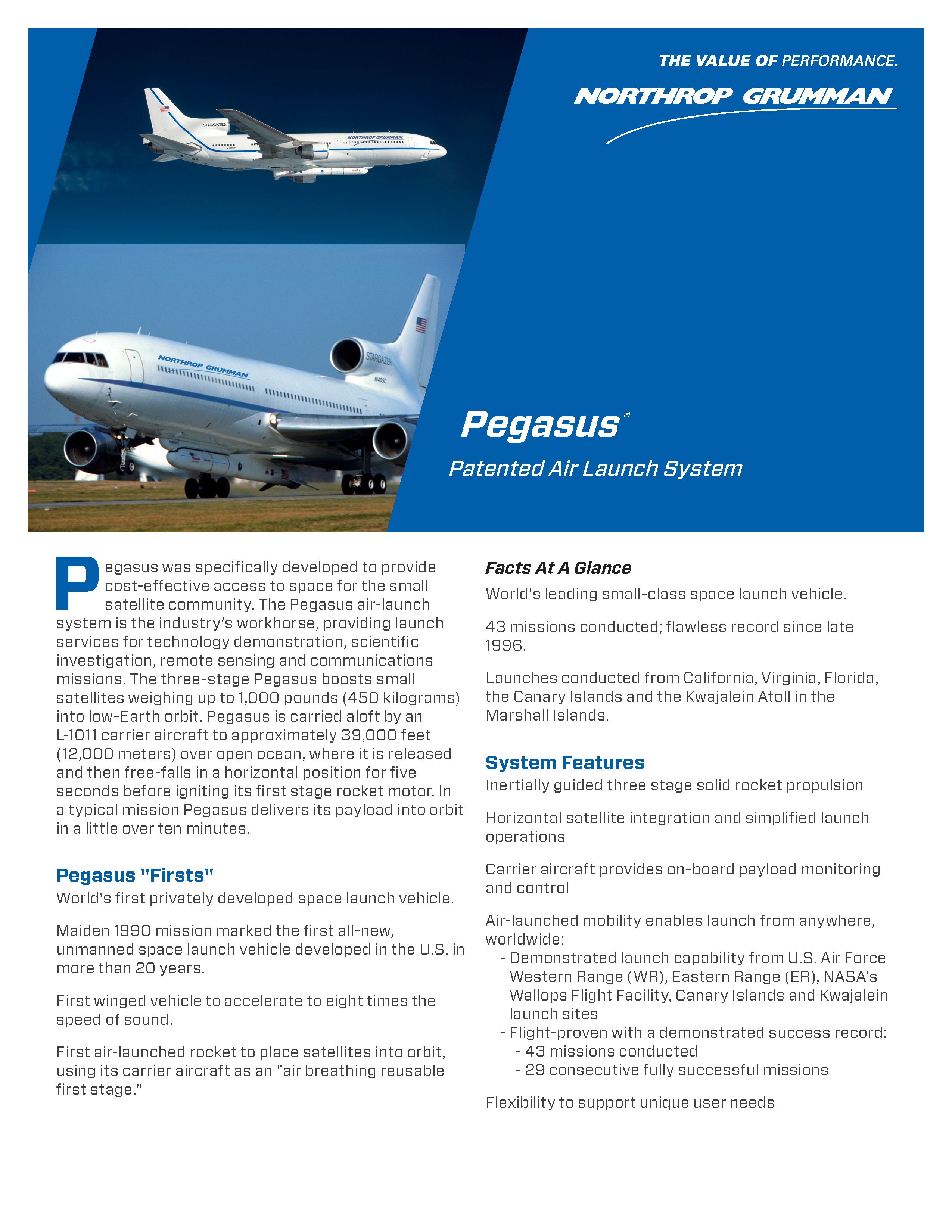
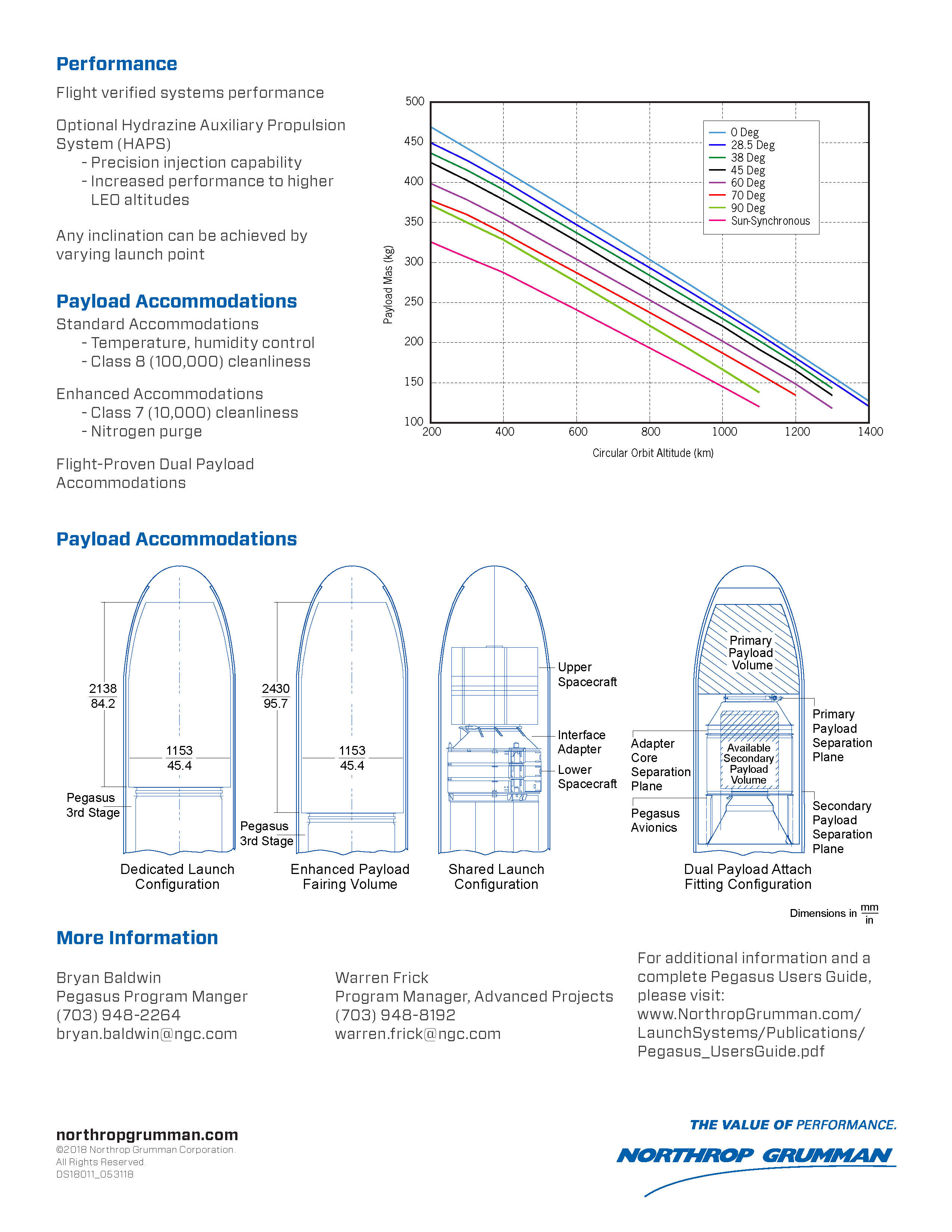
Название: ICON – Pegasus XL – Cape Canaveral AFS, L-1011 "Stargazer" – 11.10.2019 – 04:59:05 ДМВ
Отправлено: tnt22 от 06.11.2018 21:31:59
Отправлено: tnt22 от 06.11.2018 21:31:59
L1011_Factsheet.pdf (http://www.northropgrumman.com/Capabilities/Pegasus/Documents/L1011_Factsheet.pdf)

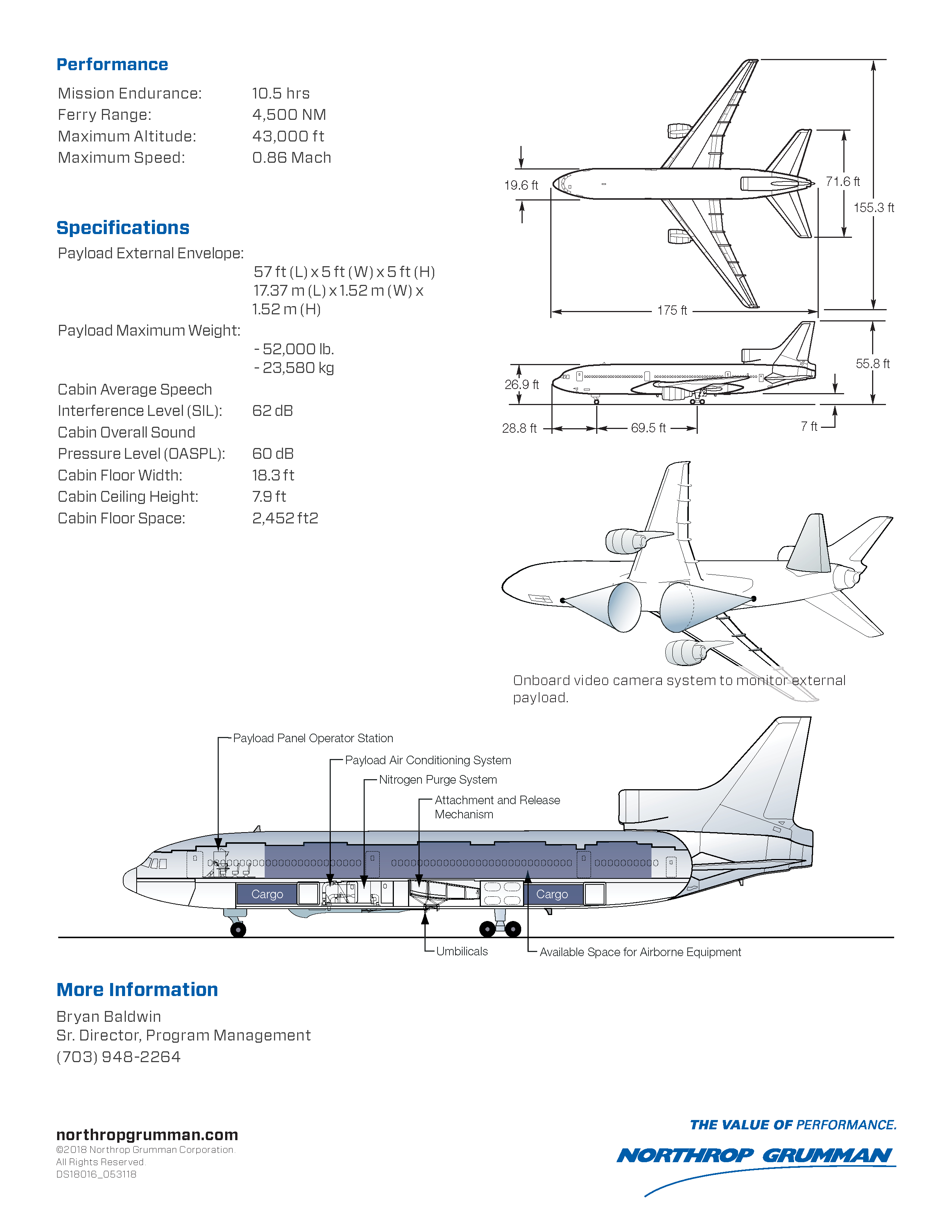
Название: ICON – Pegasus XL – Cape Canaveral AFS, L-1011 "Stargazer" – 11.10.2019 – 04:59:05 ДМВ
Отправлено: tnt22 от 06.11.2018 22:27:35
Отправлено: tnt22 от 06.11.2018 22:27:35
ICON_Factsheet.pdf (http://www.northropgrumman.com/Capabilities/ScienceEnvironmentSatellites/Documents/ICON_Factsheet.pdf)
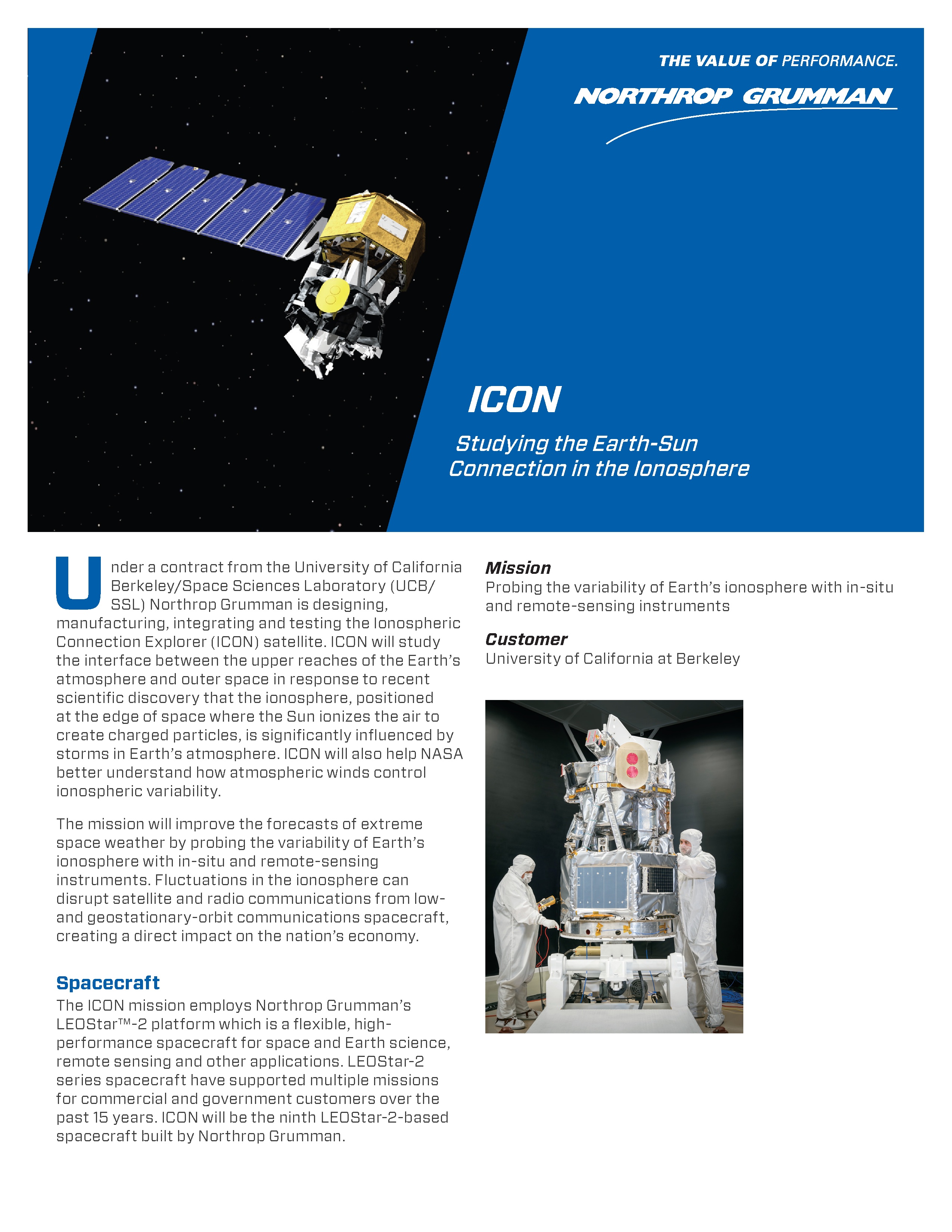
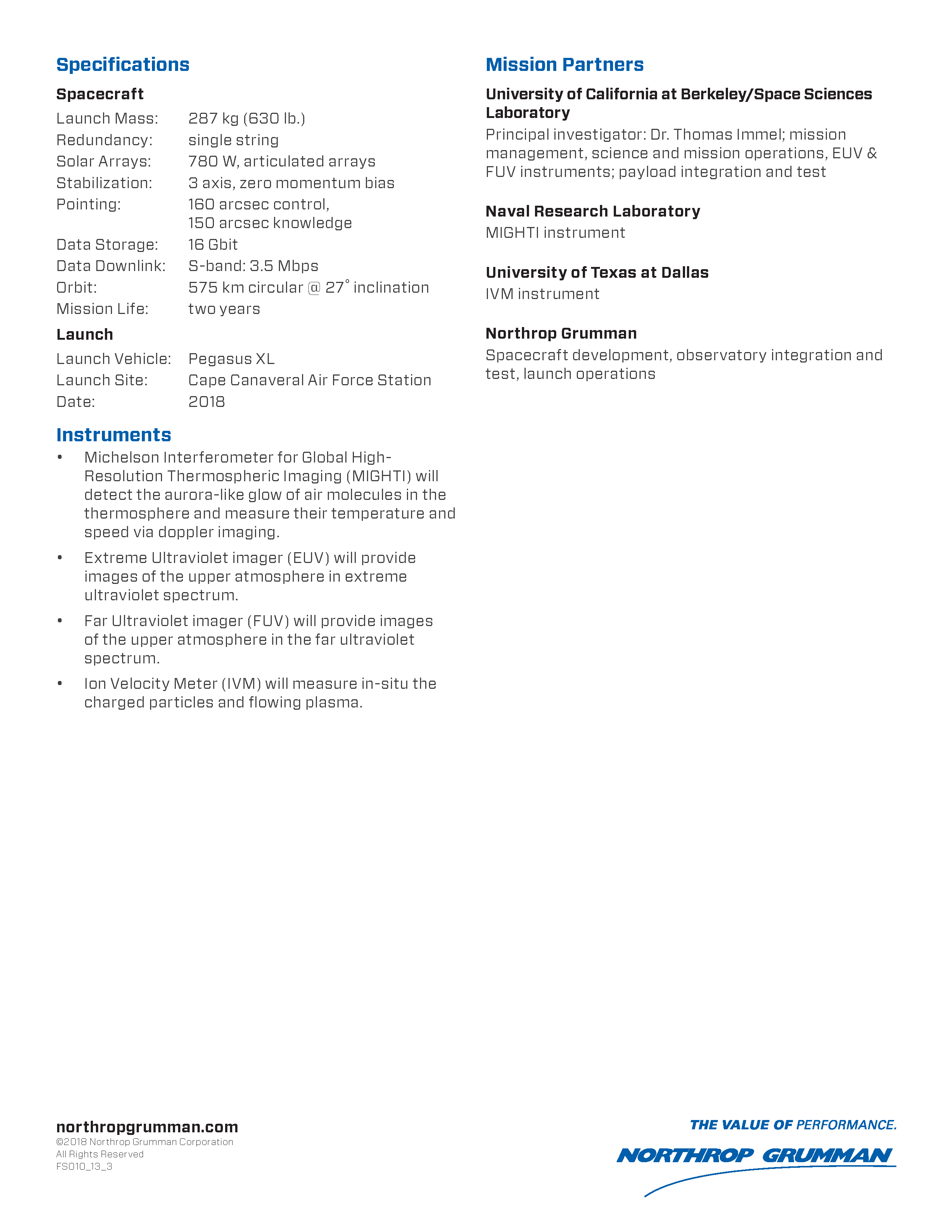
Название: ICON – Pegasus XL – Cape Canaveral AFS, L-1011 "Stargazer" – 11.10.2019 – 04:59:05 ДМВ
Отправлено: tnt22 от 06.11.2018 22:49:59
Отправлено: tnt22 от 06.11.2018 22:49:59
Прогноз погоды L-2
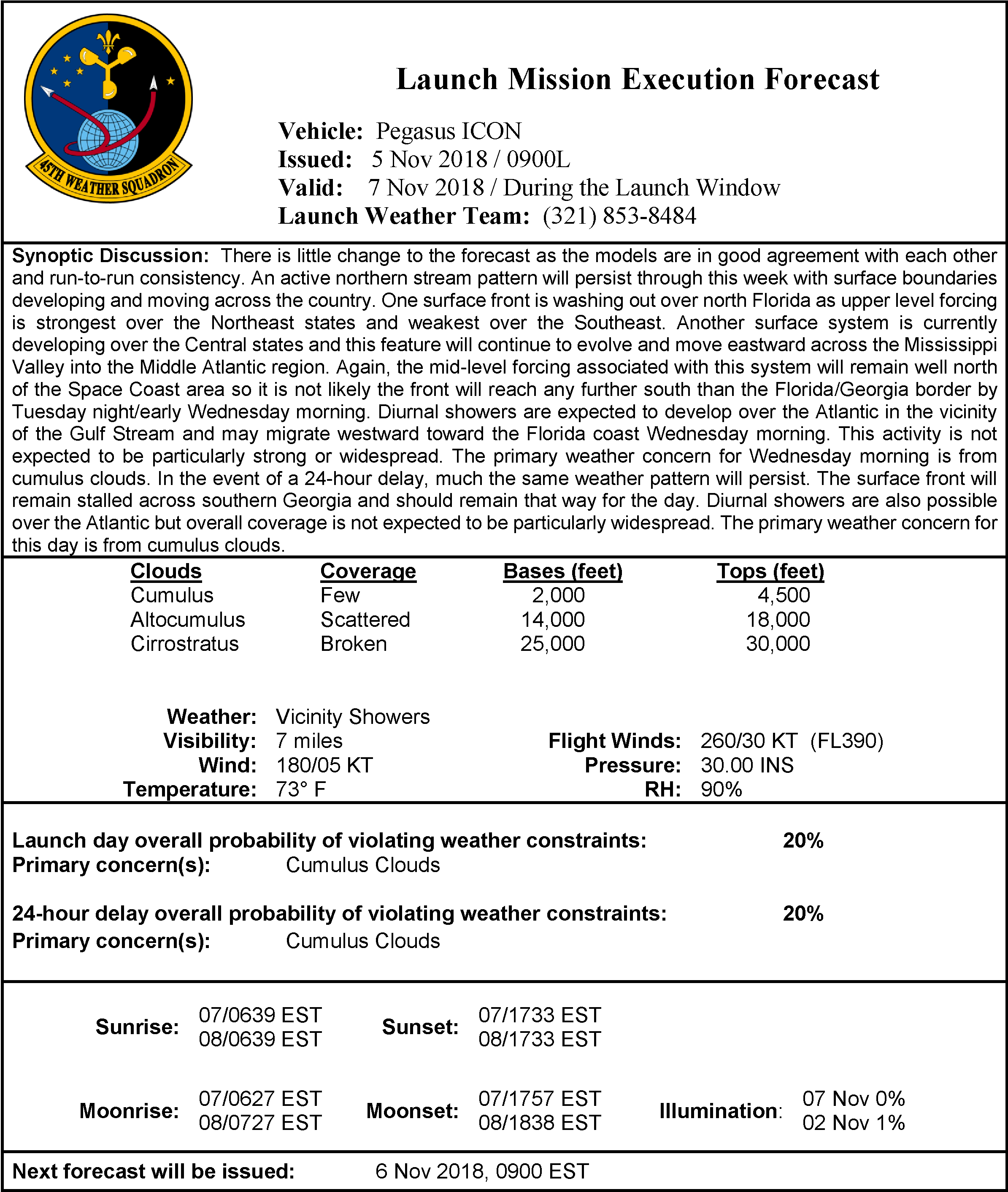
Название: ICON – Pegasus XL – Cape Canaveral AFS, L-1011 "Stargazer" – 11.10.2019 – 04:59:05 ДМВ
Отправлено: tnt22 от 06.11.2018 22:54:49
Отправлено: tnt22 от 06.11.2018 22:54:49
https://blogs.nasa.gov/icon/2018/11/05/launch-week-begins-for-icon/
https://blogs.nasa.gov/kennedy/2018/11/05/launch-week-begins-for-icon/
https://blogs.nasa.gov/kennedy/2018/11/05/launch-week-begins-for-icon/
ЦитироватьLaunch Week Begins for ICON
Anna Heiney (https://blogs.nasa.gov/icon/author/aheiney/)
Posted Nov 5, 2018 at 6:19 pm(https://blogs.nasa.gov/icon/wp-content/uploads/sites/277/2018/11/KSC-20181019-PH-KLS01_0019.jpg)
The Northrop Grumman L-1011 Stargazer aircraft is seen on the Skid Strip at Cape Canaveral Air Force Station. A Pegasus XL rocket is attached to the underside of the aircraft with NASA's Ionospheric Connection Explorer, or ICON, satellite. Photo credit: NASA/Kim Shiflett
NASA and Northrop Grumman will hold a Launch Readiness Review at the agency's Kennedy Space Center in Florida at 9 a.m. EST Tuesday, Nov. 6, to ensure preparations are on track for launch of NASA's Ionospheric Connection Explorer (ICON) satellite.
ICON is scheduled to launch Wednesday, Nov. 7, by Northrop Grumman's Pegasus XL rocket, which will be carried aloft by the company's L-1011 Stargazer aircraft taking off fr om the Skid Strip at Cape Canaveral Air Force Station in Florida. The 90-minute launch window opens at 3 a.m., with a targeted release at 3:05 a.m. Ignition of the Pegasus XL rocket occurs five seconds after release from the Stargazer.
ICON is designed to study the dynamic zone high in the atmosphere wh ere terrestrial weather from below meets space weather from above.
Название: ICON – Pegasus XL – Cape Canaveral AFS, L-1011 "Stargazer" – 11.10.2019 – 04:59:05 ДМВ
Отправлено: tnt22 от 06.11.2018 23:01:53
Отправлено: tnt22 от 06.11.2018 23:01:53
https://blogs.nasa.gov/kennedy/2018/11/06/launch-readiness-review-completed-for-icon/
https://blogs.nasa.gov/icon/2018/11/06/launch-readiness-review-completed-for-icon/
https://blogs.nasa.gov/icon/2018/11/06/launch-readiness-review-completed-for-icon/
ЦитироватьLaunch Readiness Review Completed for ICON
Bob Granath (https://blogs.nasa.gov/icon/author/rgranath/)
Posted Nov 6, 2018 at 1:43 pm(https://blogs.nasa.gov/kennedy/wp-content/uploads/sites/246/2018/11/KSC-20181019-PH-KLS01_0005.jpg)
The Northrop Grumman L-1011 Stargazer aircraft lands on Oct. 19, 2018 at the Skid Strip at Cape Canaveral Air Force Station. A Pegasus XL rocket is attached to the underside of the aircraft with NASA's Ionospheric Connection Explorer, or ICON, satellite.
Photo credit: NASA/Kim Shiflett
NASA and Northrop Grumman completed their Launch Readiness Review on Tuesday, Nov. 6, at the agency's Kennedy Space Center in Florida. There are no technical issues being worked at this time. NASA's Ionospheric Connection Explorer, or ICON, satellite mission is scheduled to launch Wednesday, Nov. 7, by Northrop Grumman's Pegasus XL rocket, which will be carried aloft by the company's L-1011 Stargazer aircraft taking off fr om the Skid Strip at Cape Canaveral Air Force Station in Florida.
The 90-minute launch window opens at 3 a.m. EST, with a targeted release at 3:05 a.m. Ignition of the Pegasus XL rocket occurs five seconds after release from the Stargazer.
The official weather forecast calls for a 90 percent chance for favorable conditions for launch. The primary launch weather concerns are cumulous clouds.
ICON is designed to study the dynamic zone high in the atmosphere wh ere terrestrial weather from below meets space weather from above.
Follow the launch coverage on NASA Television at:https://www.nasa.gov/liveTuesday, Nov. 6
3 p.m. – NASA EDGE webcast from Cape Canaveral Air Force Station will discuss ICON spacecraft operations, science and engineering, as well as launch processing of the Northrop Grumman L-1011 Stargazer with the Pegasus rocket.
Wednesday, Nov. 7
2:45 a.m. – Launch coverage begins at 2:45 a.m. EST
Название: ICON – Pegasus XL – Cape Canaveral AFS, L-1011 "Stargazer" – 11.10.2019 – 04:59:05 ДМВ
Отправлено: tnt22 от 06.11.2018 23:04:42
Отправлено: tnt22 от 06.11.2018 23:04:42
Прогноз погоды L-1
L-1 Pegasus Mission Execution Forecast (https://www.patrick.af.mil/Portals/14/documents/Weather/L-1%20Day%20MEF%200900L%206%20Nov%202018.pdf?ver=2018-11-06-074853-650)
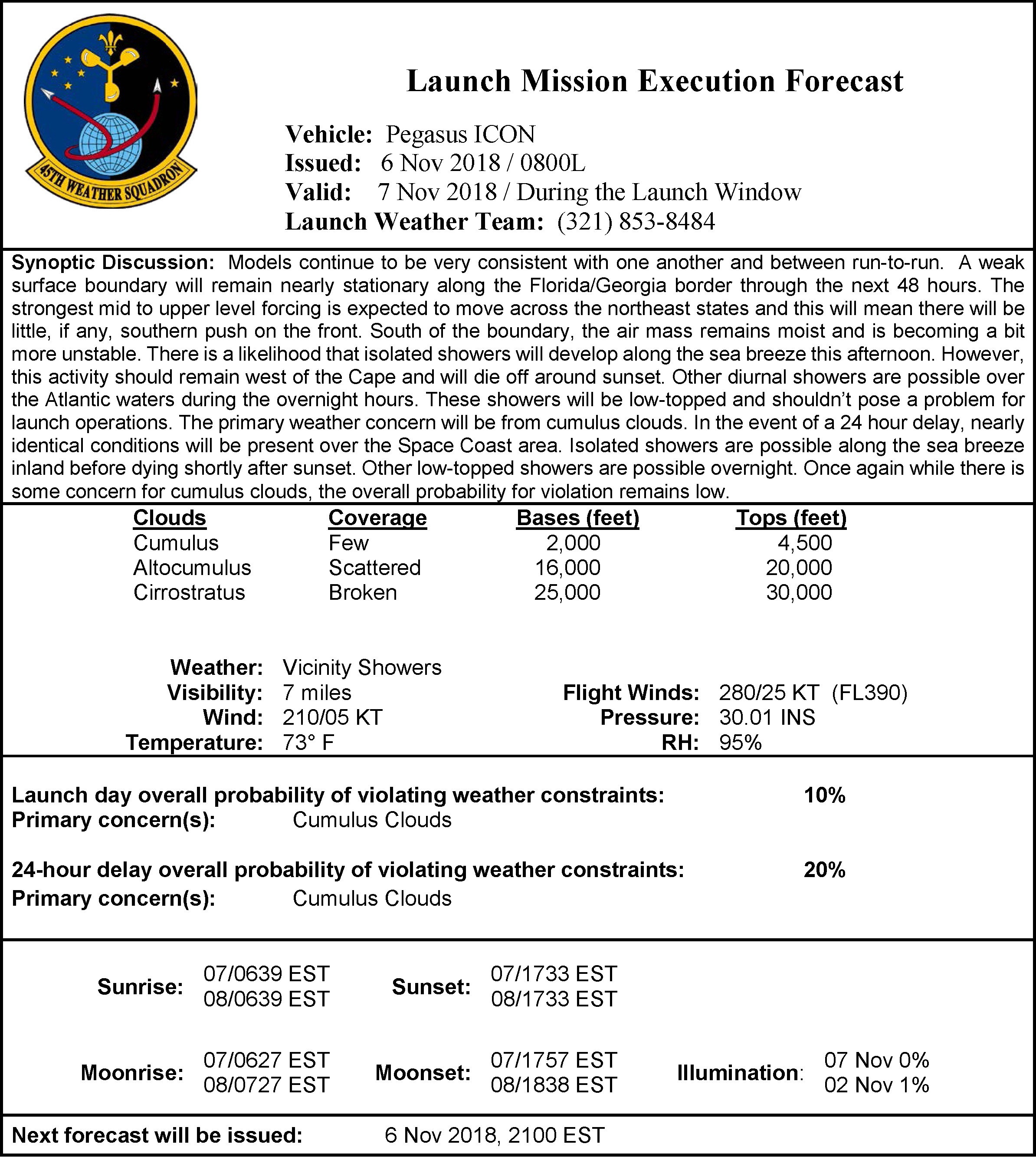
L-1 Pegasus Mission Execution Forecast (https://www.patrick.af.mil/Portals/14/documents/Weather/L-1%20Day%20MEF%200900L%206%20Nov%202018.pdf?ver=2018-11-06-074853-650)
Название: ICON – Pegasus XL – Cape Canaveral AFS, L-1011 "Stargazer" – 11.10.2019 – 04:59:05 ДМВ
Отправлено: tnt22 от 06.11.2018 23:26:26
Отправлено: tnt22 от 06.11.2018 23:26:26
Название: ICON – Pegasus XL – Cape Canaveral AFS, L-1011 "Stargazer" – 11.10.2019 – 04:59:05 ДМВ
Отправлено: tnt22 от 06.11.2018 23:30:14
Отправлено: tnt22 от 06.11.2018 23:30:14
Название: ICON – Pegasus XL – Cape Canaveral AFS, L-1011 "Stargazer" – 11.10.2019 – 04:59:05 ДМВ
Отправлено: tnt22 от 06.11.2018 23:36:46
Отправлено: tnt22 от 06.11.2018 23:36:46
Название: ICON – Pegasus XL – Cape Canaveral AFS, L-1011 "Stargazer" – 11.10.2019 – 04:59:05 ДМВ
Отправлено: tnt22 от 06.11.2018 23:38:18
Отправлено: tnt22 от 06.11.2018 23:38:18
Название: ICON – Pegasus XL – Cape Canaveral AFS, L-1011 "Stargazer" – 11.10.2019 – 04:59:05 ДМВ
Отправлено: tnt22 от 07.11.2018 00:00:48
Отправлено: tnt22 от 07.11.2018 00:00:48
Название: ICON – Pegasus XL – Cape Canaveral AFS, L-1011 "Stargazer" – 11.10.2019 – 04:59:05 ДМВ
Отправлено: tnt22 от 07.11.2018 00:34:46
Отправлено: tnt22 от 07.11.2018 00:34:46
Название: ICON – Pegasus XL – Cape Canaveral AFS, L-1011 "Stargazer" – 11.10.2019 – 04:59:05 ДМВ
Отправлено: tnt22 от 07.11.2018 00:41:22
Отправлено: tnt22 от 07.11.2018 00:41:22
Название: ICON – Pegasus XL – Cape Canaveral AFS, L-1011 "Stargazer" – 11.10.2019 – 04:59:05 ДМВ
Отправлено: tnt22 от 07.11.2018 01:04:49
Отправлено: tnt22 от 07.11.2018 01:04:49
ЦитироватьICON Mission Is Go for Launchhttps://www.youtube.com/watch?v=8jdFlRDEkAAhttps://www.youtube.com/watch?v=8jdFlRDEkAA (https://www.youtube.com/watch?v=8jdFlRDEkAA) (2:00)
NASA (https://www.youtube.com/channel/UCLA_DiR1FfKNvjuUpBHmylQ)
Опубликовано: 6 нояб. 2018 г.
Launch of NASA's Ionospheric Connection Explorer, or ICON is targeted for the early morning on Nov. 7, 2018. NASA TV coverage begins live at at 2:45 a.m. Eastern (7:45 a.m. UTC): https://www.youtube.com/watch?v=wwMDv... (https://www.youtube.com/watch?v=wwMDvPCGeE0)
ICON will explore the dynamic region where Earth meets space: the ionosphere.
Название: ICON – Pegasus XL – Cape Canaveral AFS, L-1011 "Stargazer" – 11.10.2019 – 04:59:05 ДМВ
Отправлено: tnt22 от 07.11.2018 02:03:11
Отправлено: tnt22 от 07.11.2018 02:03:11
ЦитироватьNASA EDGE Live Streamhttps://www.youtube.com/watch?v=ewCGLnhAm9chttps://www.youtube.com/watch?v=ewCGLnhAm9c (https://www.youtube.com/watch?v=ewCGLnhAm9c) (33:22)
NASA EDGE (https://www.youtube.com/channel/UCEPgFeclBHqZp80D14J5kfA)
Трансляция началась 2 часа назад
Название: ICON – Pegasus XL – Cape Canaveral AFS, L-1011 "Stargazer" – 11.10.2019 – 04:59:05 ДМВ
Отправлено: tnt22 от 07.11.2018 02:05:42
Отправлено: tnt22 от 07.11.2018 02:05:42
ЦитироватьTour the Plane Giving NASA's ICON a Ride to Spacehttps://www.youtube.com/watch?v=O0Hx1Qe07ighttps://www.youtube.com/watch?v=O0Hx1Qe07ig (https://www.youtube.com/watch?v=O0Hx1Qe07ig) (14:30)
NASA Goddard (https://www.youtube.com/channel/UCAY-SMFNfynqz1bdoaV8BeQ)
Опубликовано: 6 нояб. 2018 г.
Early in the morning of Nov. 7, 2018, NASA launches the Ionospheric Connection Explorer, or ICON, a spacecraft that will explore the dynamic region where Earth meets space. ICON launches on a Northrop Grumman Pegasus XL rocket, which is carried aloft by the Stargazer L-1011 aircraft.
Join NASA on a behind-the-scenes tour of this plane, once a jet airliner and now uniquely retrofitted to boost spacecraft into low-Earth orbit. Learn about ICON's science and meet the people — including an engineer, technician, and pilot — who will help launch the spacecraft into orbit.
CREDITS:
Scott England (Space Sciences Laboratory, UC Berkeley): Talent
Edward Dunlap (Northrop Grumman): Talent
Jim Stowers (Northrop Grumman): Talent
Don Walter (Northrop Grumman): Talent
Karen Fox (ASI): Host
...
Название: ICON – Pegasus XL – Cape Canaveral AFS, L-1011 "Stargazer" – 11.10.2019 – 04:59:05 ДМВ
Отправлено: tnt22 от 07.11.2018 02:57:42
Отправлено: tnt22 от 07.11.2018 02:57:42
https://spaceflightnow.com/2018/11/06/nasa-managers-clear-pegasus-rocket-for-launch-with-icon-satellite/
ЦитироватьNASA managers clear Pegasus rocket for launch with ICON satellite
November 6, 2018 (https://spaceflightnow.com/2018/11/) | Stephen Clark (https://spaceflightnow.com/author/stephen-clark/)
Northrop Grumman's L-1011 carrier jet, named Stargazer, arrived at Cape Canaveral's Skid Strip on Oct. 19. Credit: NASA/Kim Shiflett
NASA and Northrop Grumman managers at the Kennedy Space Center decided Tuesday to press ahead with final preparations to launch a NASA scientific research satellite early Wednesday aboard an air-launched Pegasus XL rocket off Florida's east coast.
Officials confirmed Wednesday's planned launch attempt during a launch readiness review Tuesday morning, and teams planned to take Tuesday afternoon to rest up ahead of an overnight countdown.
There is a 90-minute window Wednesday to launch NASA's Ionospheric Connection Explorer, or ICON, satellite aboard an air-dropped Northrop Grumman Pegasus XL rocket. The window opens at 3 a.m. EST (0800 GMT), with release of the 57-foot-long (17-meter) rocket fr om an L-1011 carrier aircraft planned at 3:05 a.m. EST (0805 GMT) around 100 miles (160 kilometers) east of Daytona Beach.
A point of discussion during Tuesday's launch readiness review was the readiness of a GPS navigation receiver on the Pegasus rocket. The navigation receiver feeds position data fr om GPS satellites to the rocket's guidance computer before ignition, providing information on the exact location of the launcher after release from the L-1011 carrier aircraft and before it fires into orbit.
The Pegasus rocket's GPS receiver displayed an error indication during the L-1011's cross-country ferry flight to Cape Canaveral on Oct. 19 from Vandenberg Air Force Base in California, wh ere Northrop Grumman assembles the air-dropped booster.
Technicians replaced hardware on the rocket and conducted a nearly five-hour test flight on Oct. 28. Engineers followed these test flight with a series of data reviews to assess the health of the GPS receiver, which continued providing good position data despite giving controllers an error indication. The GPS receiver is not used during the powered portion of the Pegasus launch.
If the GPS system suffers another problem during Wednesday's flight to the drop box, NASA plans to abort the mission and call the L-1011 back to Cape Canaveral for further analysis and troubleshooting, officials said.
The GPS receiver issue delayed ICON's launch from Oct. 26, the latest of several schedule slips due to rocket concerns. ICON was supposed to launch in June 2017, but the mission was delayed after the mishandling of Pegasus rocket stages during transport to the Vandenberg integration site, followed by a months-long evaluation of the reliability of bolt-cutters used to jettison the Pegasus payload fairing and separate the satellite in orbit.Спойлер
With those issues resolved, engineers noticed an unexpected telemetry signal from the rocket's rudder fin actuator after the L-1011's departure June 6 from Vandenberg on a two-day ferry flight to Kwajalein Atoll in the Marshall Islands, ICON's original launch base.
Officials ordered the rocket to return to Vandenberg for inspections and testing, and NASA decided to move the launch to a location off the Florida coast, which offered more launch opportunities through the Eastern Range operated by the U.S. Air Force's 45th Space Wing.
Kwajalein is home of the U.S. Army's Reagan Test Site, a range often busy with military missile tests, with few openings for a civilian launch.
ICON ended up weighing a little less than originally designed, allowing managers to relocate the launch from near the equator over the Pacific Ocean to the Atlantic Ocean off Florida's east coast. With ICON's lower mass, the Pegasus has the ability to boost the satellite into the correct orbit without requiring a launch base so close to the equator.
Thomas Immel, ICON's principal investigator at the University of California, Berkeley, said he was relieved the mission appears ready to finally go into space.
"After all the concern and the difficulty with the components of the rocket, it's a great relief," Immel told Spaceflight Now on Tuesday afternoon. "It feels pretty great to NASA's approval to fly, so I'm really looking forward to it. A few hundred seconds, and we're going to be on orbit, and it's going to be fantastic."
The solid-fueled Pegasus XL rocket will release ICON from its third stage at T+plus 11 minutes, 20 seconds. ICON will start extending its power-generating solar panels less than two minutes after deployment from the Pegasus rocket, then lock onto the sun to start charging its batteries.
NASA sel ected Immel's proposal for the agency's Explorer program in 2013 to probe the extreme variability of the ionosphere, ever-changing layer in the upper atmosphere that affects long-distance radio communications and GPS navigation.
NASA's ICON mission will orbit above the upper atmosphere, through the bottom edge of near-Earth space. Here it will be able to observe how interactions between terrestrial weather and a layer of charged particles called the ionosphere creates changes in the space environment — including bright swaths of color in the atmosphere called airglow.
Credits: NASA's Goddard Space Flight Center/ICON
The $252 million mission will investigate the link between conditions in the ionosphere, which scientists long thought was primarily driven by solar activity, and weather deeper in Earth's atmosphere.
"The ionosphere is the densest plasma in space between us and the sun, and that plasma has a number of effects on systems that we use every day," Immel said.
The ICON mission will study "how weather in our lower atmosphere, the weather we experience from day to day, influences conditions in space," he said. "This coupling of the lower atmosphere to the upper atmosphere is a new science topic for NASA."
Previous satellite missions detected the unexpected coupling between plasma waves and winds in the ionosphere and terrestrial weather systems.
"What we discovered, using data from a NASA mission called IMAGE, was that this region of the upper atmosphere and ionosphere was actually responding to effects related to weather systems near Earth's surface," said Scott England, ICON project scientist based at Virginia Tech. "This was really unexpected at the time, to see a connection. Wh ere the charged particles were, how many there were, how dense the gas was — they were responding to weather patterns near the surface of the Earth."
"We saw with those missions that the density in the ionosphere varied in response to changes in the rainy seasons in the tropics," Immel said. "The new mission of ICON is to focus on that topic, and we're carrying the instruments to invesitgate that region.
"We think focusing on that will give us a real key to understanding and making better predictions for space weather," he said.
ICON carries four types of instruments developed at the University of California, Berkeley, the Naval Research Laboratory, and the University of Texas at Dallas.
Northrop Grumman's ground crew will start arriving at the Skid Strip runway at Cape Canaveral Air Force Station around 10 p.m. EST (0300 GMT) to begin preparing the Pegasus rocket the L-1011 carrier aircraft, named "Stargazer," for takeoff.
At the "hot pad" at the Skid Strip, the ground team will remove safe-and-arm pins on the three-stage Pegasus rocket, start the L-1011's port and center engine, and install final closeout doors and hardware before giving the "go" to start the carrier aircraft's starboard engine.
NASA's Ionospheric Connection Explorer during encapsulation inside the Pegasus rocket's nose cone. Credit: NASA/Dan Quinajon
Northrop Grumman Innovation Systems, the Pegasus rocket's contractor, has nearly 30 engineers, managers, pilots and technicians at Cape Canaveral to support Wednesday's launch.
More than a half-dozen of those team members will be aboard the L-1011 carrier plane when it taxis to the runway and takes off from Cape Canaveral Air Force Station around 2 a.m. EST (0700 GMT).
The aircraft, under the control of lead pilot Don Walter, will head northeast over the Atlantic Ocean, then enter a "race track" pattern to circle and line up with the drop box. The drop point will be at an altitude of 39,000 feet (11,900 meters) as the L-1011 aircraft flies on an easterly heading.
Once the 53,000-pound (24,000-kilogram) Pegasus XL is away, the rocket's flight termination system will be armed and its first stage Orion 50S XL motor will ignite with more than 160,000 pounds of thrust after five-second drop.
The three-stage rocket will deliver the 634-pound (288-kilogram) ICON satellite, also built by Northrop Grumman, to an orbit 357 miles (575 kilometers) above Earth on a track carrying the spacecraft between 27 degrees north and south latitude on each lap of the planet.
While the launch is expected around 3:05 a.m. EST (0805 GMT), the time of the drop is at the discretion of the crew aboard the L-1011 once they receive the "go" from the ground team.
There is a 90 percent chance of favorable weather for Wednesday's launch, with the primary concern being a violation of the cumulus cloud rule.
"There is a likelihood that isolated showers will develop along the sea breeze this afternoon," the Air Force's 45th Weather Squadron said in a forecast released Tuesday morning. "However, this activity should remain west of the Cape and will die off around sunset. Other diurnal showers are possible over the Atlantic waters during the overnight hours. These showers will be low-topped and shouldn't pose a problem for launch operations. The primary weather concern will be from cumulus clouds."
The Pegasus rocket cannot fly through rain fr om the time of takeoff through release, so if there are rain showers in the area, the pilots must be able to navigate around the activity.
Conditions in the drop box will be mostly cloudy with rain showers in the vicinity, a few clouds at 2,000 feet, scattered clouds at 16,000 feet and a broken deck at 25,000 feet to 30,000 feet. Flight level winds are predicted to be around 25 knots out of the west.
If Wednesday's launch attempt is scrubbed, weather Thursday should be similar, with an 80 percent chance of acceptable conditions.
Orbital ATK's Pegasus rocket has flown 43 times to date since its debut in 1990. Six of those missions have been staged out of Cape Canaveral, most recently a mission deploying NASA's eight CYGNSS hurricane research satellites in orbit in December 2016.
Officials have dedicated the rocket set to deliver ICON to space in honor of Ebb Harris, who piloted numerous Pegasus launch missions since the dawn of the program more than a quarter-century ago. Harris died earlier this year.
"Ebb has been a mentor to everyone who has come since the beginning of the program, a true gentleman, a very knowledgable and competent airman, and just a fun guy to be around," said Walter, who will command the L-1011 on Wednesday's launch. "On every rocket that we launch, we have the ability to dedicate it to somebody, so if you look at the side of the rocket, you'll see that this rocket is dedicated to Ebb."[свернуть]
Название: ICON – Pegasus XL – Cape Canaveral AFS, L-1011 "Stargazer" – 11.10.2019 – 04:59:05 ДМВ
Отправлено: tnt22 от 07.11.2018 09:25:47
Отправлено: tnt22 от 07.11.2018 09:25:47
ЦитироватьJonathan McDowellПодлинная учетная запись @planet4589 (https://twitter.com/planet4589) 15 мин. назад (https://twitter.com/planet4589/status/1060050753987973121)
The Orbital Sciences ... oops sorry, Northrop Grumman ... L-1011 aircraft "Stargazer" is at Runway 31/13 at Cape Canaveral Air Station, known as the 'Skid Strip' from the days when it was used for landings of 1950s recoverable cruise missiles which had skids instead of wheels
12 мин. назад (https://twitter.com/planet4589/status/1060051516122427392)
Slung underneath the body of the Stargazer is the 23-tonne Pegasus XL rocket with the 281-kg ICON ionospheric research satellite inside its fairing
11 мин. назад (https://twitter.com/planet4589/status/1060051898517127168)
Stargazer will take off from the Skid Strip at about 0700 UTC and head east over the Atlantic, then make a loop around an imaginary 'racetrack' to line up with the drop point around 29.2N 77.2W
10 мин. назад (https://twitter.com/planet4589/status/1060052223407874048)
At 0805 UTC Stargazer will drop the Pegasus and maneuver away. Pegasus will fall for about 5 seconds. Then, with luck, the winged first stage of Pegasus will ignite
7 мин. назад (https://twitter.com/planet4589/status/1060053109580410880)
The first stage will burn for 1 min 12 s, carrying Pegasus to 54 km up in the mesosphere. 16 seconds after stage 1 cuttoff, at drop plus 1 min 33 s, the second stage ignites 72 km up and sends Pegasus into space
6 мин. назад (https://twitter.com/planet4589/status/1060053372093583360)
The second stage has basically the same solid motor as the first, but doesn't have the wings. It fires for 1 min 14s, during which the two halves of the nose fairing fall away, and burns out at 180 km up.
3 мин. назад (https://twitter.com/planet4589/status/1060054159007846406)
Pegasus is then in a suborbital trajectory with an apogee of 550 km or so. It will coast uphill for 4min 24s and then ignite the third stage for its 1 min 9s horizontal burn to boost speed to the Keplerian value and put ICON in a 575 km x 27 deg circular orbit
Название: ICON – Pegasus XL – Cape Canaveral AFS, L-1011 "Stargazer" – 11.10.2019 – 04:59:05 ДМВ
Отправлено: tnt22 от 07.11.2018 09:29:52
Отправлено: tnt22 от 07.11.2018 09:29:52
ЦитироватьJonathan McDowellПодлинная учетная запись @planet4589 (https://twitter.com/planet4589) 9 мин. назад (https://twitter.com/planet4589/status/1060054379171065856)
The empty third stage solid motor is jettisoned 11 min 20 s after launch, leaving it and ICON as separate orbiting objects.
6 мин. назад (https://twitter.com/planet4589/status/1060055109105795072)
ICON carries the MIGHTI imaging interferometer to measure airglow lines, ultraviolet imagers covering the 500-900A and 1356 , 1550A ranges, and an ion velocity meter. The mission was developed by and will be controlled from @UCBerkeley (https://twitter.com/UCBerkeley)
Название: ICON – Pegasus XL – Cape Canaveral AFS, L-1011 "Stargazer" – 11.10.2019 – 04:59:05 ДМВ
Отправлено: tnt22 от 07.11.2018 09:39:39
Отправлено: tnt22 от 07.11.2018 09:39:39
https://spaceflightnow.com/2018/11/06/pegasus-xl-icon-mission-status-center/
ЦитироватьLive coverage: NASA research satellite set for airborne launch off Florida's coast
November 6, 2018 (https://spaceflightnow.com/2018/11/) Stephen Clark (https://spaceflightnow.com/author/stephen-clark/)
11/07/2018 09:30 Stephen Clark
We've posted an overview timeline of this morning's Pegasus XL launch off Florida's east coast with the ICON satellite. The three-stage solid-fueled rocket will release the ICON spacecraft into a roughly 357-mile-high (575-kilometer) orbit around 11 minutes, 20 seconds after launch.
Название: ICON – Pegasus XL – Cape Canaveral AFS, L-1011 "Stargazer" – 11.10.2019 – 04:59:05 ДМВ
Отправлено: tnt22 от 07.11.2018 09:46:07
Отправлено: tnt22 от 07.11.2018 09:46:07
https://spaceflightnow.com/2018/11/06/launch-timeline-for-pegasus-launch-of-icon-satellite/
ЦитироватьTimeline for Pegasus launch of ICON satellite
November 6, 2018 (https://spaceflightnow.com/2018/11/) | Stephen Clark (https://spaceflightnow.com/author/stephen-clark/)
Northrop Grumman's Pegasus XL rocket will take about 11 minutes to place NASA's Ionospheric Connection Explorer, or ICON, satellite into a roughly 357-mile-high (575-kilometer) orbit after an airborne launch off Florida's east coast.
The nearly 53,000-pound (24-metric ton) rocket will drop from the belly of a modified L-1011 carrier plane, named Stargazer, flying on an easterly path over the Atlantic Ocean at an altitude of 39,000 feet (11,900 meters).
The Pegasus rocket, launching on its 44th orbital mission, will fire three solid-fueled stages in succession, then release NASA's ICON satellite into orbit to begin a mission studying how weather in Earth's atmosphere influences plasma conditions at the edge of space in the ionosphere, a boundary that can interfere with radio communications and satellite navigation.
The images below were recorded from a previous flight.Спойлер
Data source: NASA/Northrop Grumman
T-00:00: Pegasus Drop(https://img.novosti-kosmonavtiki.ru/143787.png)
The 57-foot-long Pegasus XL rocket is released from the Orbital Carrier Aircraft off the east coast of Florida at an altitude of 39,000 feet above the Atlantic Ocean and a speed of Mach 0.82.
T+00:05: First Stage Ignition(https://img.novosti-kosmonavtiki.ru/143791.png)
After falling for five seconds to a distance of about 300 feet below the L-1011, the first stage Orion 50S XL solid-fueled motor of Pegasus is ignited to begin the powered journey to orbit with ICON. Between drop and ignition, the Pegasus XL's destruct system is armed.
T+00:36: Max-Q(https://img.novosti-kosmonavtiki.ru/143789.png)
The Pegasus XL flies through the phase of maximum aerodynamic pressure, and the Orion 50S XL continues firing, reaching a peak power level of about 163,000 pounds of thrust.
T+01:17: First Stage Burnout(https://img.novosti-kosmonavtiki.ru/143790.png)
The Orion 50S XL first stage motor consumes all of its solid-fuel propellant and burns out at an altitude of more than 177,000 feet, or 53.9 kilometers.
T+01:33: First Stage Separation/Second Stage Ignition(https://img.novosti-kosmonavtiki.ru/143794.png)
The spent first stage motor is jettisoned at T+plus 1 minute, 33 seconds, to prepare for the second stage of flight. The first stage casing falls into the Atlantic Ocean. One second later, Orion 50 XL motor ignites at an altitude of 237,000 feet (72.1 kilometers) to continue the flight into orbit.
T+02:10: Fairing Jettison(https://img.novosti-kosmonavtiki.ru/143788.png)
The 50-inch-diamter (1.3-meter) payload fairing that protected the ICON during atmospheric ascent is separated once heating levels drop to predetermined limits at an altitude of around 381,000 feet (116 kilometers). The second stage motor continues its burn with 44,000 pounds of thrust.
T+02:48: Second Stage Burnout(https://img.novosti-kosmonavtiki.ru/143792.png)
The Orion 50 XL second stage motor consumes all its solid fuel, then begins a four-minute coast phase for the rocket to climb to the targeted altitude for the ICON mission. During this time, the rocket's on-board computer calculates when it needs to ignite the third stage based on the performance of the booster to this point.
T+07:00: Second Stage Separation(https://img.novosti-kosmonavtiki.ru/143795.png)
The Pegasus XL's second stage separates from the third stage.
T+07:11: Third Stage Ignition(https://img.novosti-kosmonavtiki.ru/143793.png)
The Pegasus XL's third stage Orion 38 motor fires for a planned 69-second burn to accelerate the ICON satellite to orbital velocity.
T+08:20: Third Stage Burnout(https://img.novosti-kosmonavtiki.ru/143786.png)
The third stage Orion 38 solid-fueled motor burns out. The mission is targeting a circular orbit 357 miles (575 kilometers) above Earth at an inclination of 27 degrees.
T+11:20: ICON Separation
The attitude control thrusters on the Pegasus XL's third stage will re-orient the vehicle for the deployment of the ICON satellite. The spacecraft is programmed to begin extending its solar panel within about 100 seconds of separation from the Pegasus third stage.[свернуть]
Название: ICON – Pegasus XL – Cape Canaveral AFS, L-1011 "Stargazer" – 11.10.2019 – 04:59:05 ДМВ
Отправлено: tnt22 от 07.11.2018 10:07:03
Отправлено: tnt22 от 07.11.2018 10:07:03
Цитировать11/07/2018 10:00 Stephen Clark
All stations reported a "go" for departure of the L-1011 carrier aircraft from Cape Canaveral Air Force Station, with Air Force, NASA and Northrop Grumman officials voicing approval for takeoff.
Название: ICON – Pegasus XL – Cape Canaveral AFS, L-1011 "Stargazer" – 11.10.2019 – 04:59:05 ДМВ
Отправлено: tnt22 от 07.11.2018 10:18:37
Отправлено: tnt22 от 07.11.2018 10:18:37
Цитировать11/07/2018 10:06 Stephen Clark
The L-1011 "Stargazer" carrier aircraft with the Northrop Grumman Pegasus XL rocket has departed Cape Canaveral Air Force Station in Florida for this morning's launch of NASA's ICON mission. The booster will be released from the jet over the Atlantic Ocean around 3:05 a.m. EST to propel the Ionospheric Connection Explorer into a 357-mile-high (575-kilometer) orbit.
Название: ICON – Pegasus XL – Cape Canaveral AFS, L-1011 "Stargazer" – 11.10.2019 – 04:59:05 ДМВ
Отправлено: tnt22 от 07.11.2018 10:44:09
Отправлено: tnt22 от 07.11.2018 10:44:09
Цитировать11/07/2018 10:39 Stephen Clark
ABORT. Today's launch attempt has been scrubbed.
Название: ICON – Pegasus XL – Cape Canaveral AFS, L-1011 "Stargazer" – 11.10.2019 – 04:59:05 ДМВ
Отправлено: tnt22 от 07.11.2018 10:47:17
Отправлено: tnt22 от 07.11.2018 10:47:17
ЦитироватьNASA_LSPПодлинная учетная запись @NASA_LSP (https://twitter.com/NASA_LSP) 2 мин. назад (https://twitter.com/NASA_LSP/status/1060075026366504960)
We have encountered an anomaly while ferrying the #PegasusXL (https://twitter.com/hashtag/PegasusXL?src=hash) for the launch of #NASAICON (https://twitter.com/hashtag/NASAICON?src=hash). The L-1011 is returning to base for investigation. The team is evaluating the next launch attempt.
Название: ICON – Pegasus XL – Cape Canaveral AFS, L-1011 "Stargazer" – 11.10.2019 – 04:59:05 ДМВ
Отправлено: tnt22 от 07.11.2018 10:52:23
Отправлено: tnt22 от 07.11.2018 10:52:23
Название: ICON – Pegasus XL – Cape Canaveral AFS, L-1011 "Stargazer" – 11.10.2019 – 04:59:05 ДМВ
Отправлено: tnt22 от 07.11.2018 11:05:42
Отправлено: tnt22 от 07.11.2018 11:05:42
ЦитироватьChris B - NSF @NASASpaceflight (https://twitter.com/NASASpaceflight) 9 мин. назад (https://twitter.com/NASASpaceflight/status/1060078045564932096)
ARTICLE:
NASA's ICON mission on Northrop Grumman Pegasus XL rocket scrubbed -
https://www.nasaspaceflight.com/2018/11/nasas-icon-launch-ngis-pegasus-xl-rocket/ ... (https://t.co/PMA0sF16z5)
- By Chris Gebhardt (@ChrisG_NSF (https://twitter.com/ChrisG_NSF))
Название: ICON – Pegasus XL – Cape Canaveral AFS, L-1011 "Stargazer" – 11.10.2019 – 04:59:05 ДМВ
Отправлено: tnt22 от 07.11.2018 11:42:17
Отправлено: tnt22 от 07.11.2018 11:42:17
ЦитироватьNorthrop GrummanПодлинная учетная запись @northropgrumman (https://twitter.com/northropgrumman) 13 мин. назад (https://twitter.com/northropgrumman/status/1060086663039410176)
.@NASA (https://twitter.com/NASA) & #NorthropGrumman (https://twitter.com/hashtag/NorthropGrumman?src=hash) scrubbed today's launch of #PegasusXL (https://twitter.com/hashtag/PegasusXL?src=hash) due to off-nominal data received during the captive carry flight. The L-1011 Stargazer returned to CCAFS and the team will begin an investigation.
#NASAICON (https://twitter.com/hashtag/NASAICON?src=hash) remains healthy & we are evaluating the next launch attempt
Название: ICON – Pegasus XL – Cape Canaveral AFS, L-1011 "Stargazer" – 11.10.2019 – 04:59:05 ДМВ
Отправлено: tnt22 от 07.11.2018 11:45:20
Отправлено: tnt22 от 07.11.2018 11:45:20
ЦитироватьSpaceflight Now @SpaceflightNow (https://twitter.com/SpaceflightNow) 3 мин. назад (https://twitter.com/SpaceflightNow/status/1060089630903713793)
Northrop Grumman's rocket carrier aircraft has landed back at Cape Canaveral Air Force Station after this morning's scrubbed launch attempt. There's another launch opportunity Thursday if engineers resolve the technical concern on the Pegasus rocket.
Название: ICON – Pegasus XL – Cape Canaveral AFS, L-1011 "Stargazer" – 11.10.2019 – 04:59:05 ДМВ
Отправлено: tnt22 от 08.11.2018 23:22:38
Отправлено: tnt22 от 08.11.2018 23:22:38
ЦитироватьKen Kremer @ken_kremer (https://twitter.com/ken_kremer) 18 ч. назад (https://twitter.com/ken_kremer/status/1060356310405992448)
Have confirmed there will be NO #NASAICON (https://twitter.com/hashtag/NASAICON?src=hash) launch attempt overnight tonight at 3 AM ET 11/8 on #PegasusXL (https://twitter.com/hashtag/PegasusXL?src=hash) air-launched rocket. NO new NET at this time as @northropgrumman (https://twitter.com/northropgrumman) & @Nasa (https://twitter.com/NASA) team investigates/evaluates root cause continuing off nominal data signatures
Название: ICON – Pegasus XL – Cape Canaveral AFS, L-1011 "Stargazer" – 11.10.2019 – 04:59:05 ДМВ
Отправлено: tnt22 от 15.11.2018 19:46:20
Отправлено: tnt22 от 15.11.2018 19:46:20
ЦитироватьChris B - NSF @NASASpaceflight (https://twitter.com/NASASpaceflight) 27 мин. назад (https://twitter.com/NASASpaceflight/status/1063104184793337856)
Meanwhile, Stargazer, Pegasus and ICON appear to be preparing to head back to Vandenberg, so the ICON mission will be slipping a fair amount - and might, of course, be actually switching back to it's original West Coast launch as a result. We'll have to wait and see.
Название: ICON – Pegasus XL – Cape Canaveral AFS, L-1011 "Stargazer" – 11.10.2019 – 04:59:05 ДМВ
Отправлено: tnt22 от 16.11.2018 23:34:17
Отправлено: tnt22 от 16.11.2018 23:34:17
https://blogs.nasa.gov/kennedy/2018/11/16/icon-to-return-to-vandenberg-afb-for-further-analysis/
https://blogs.nasa.gov/icon/2018/11/16/icon-to-return-to-vandenberg-afb-for-further-analysis/
https://blogs.nasa.gov/icon/2018/11/16/icon-to-return-to-vandenberg-afb-for-further-analysis/
ЦитироватьICON to Return to Vandenberg AFB for Further Analysis
Bob Granath (https://blogs.nasa.gov/kennedy/author/rgranath/)
Posted Nov 16, 2018 at 12:28 pm
NASA and Northrop Grumman have made the decision to fly the L-1011 Stargazer and Pegasus XL rocket carrying NASA's Ionospheric Connection Explorer, or ICON, spacecraft back to its integration facility at Vandenberg Air Force Base in California. The ferry flight will take place early next week. Returning to the environmentally-controlled integration facility allows the team to further investigate off-nominal data observed during the Nov. 8 launch attempt.
Once the investigation is complete, a new launch date will be determined. ICON will launch out of Cape Canaveral Air Force Station in Florida. The ICON spacecraft, which uses Northrop Grumman's LEOStar-2 platform, is monitored at all times and remains healthy.
Название: ICON – Pegasus XL – Cape Canaveral AFS, L-1011 "Stargazer" – 11.10.2019 – 04:59:05 ДМВ
Отправлено: tnt22 от 29.11.2018 00:25:31
Отправлено: tnt22 от 29.11.2018 00:25:31
https://blogs.nasa.gov/kennedy/2018/11/28/nasas-icon-analysis-underway-at-vandenberg-afb/
https://blogs.nasa.gov/icon/2018/11/28/nasas-icon-analysis-underway-at-vandenberg-afb/
https://blogs.nasa.gov/icon/2018/11/28/nasas-icon-analysis-underway-at-vandenberg-afb/
ЦитироватьNASA's ICON Analysis Underway at Vandenberg AFB
Bob Granath (https://blogs.nasa.gov/kennedy/author/rgranath/)
Posted Nov 28, 2018 at 3:25 pm(https://blogs.nasa.gov/kennedy/wp-content/uploads/sites/246/2018/10/9a-NEW_ICON-Image_Portrait-082918a-Copy.jpg)
This illustration depicts NASA's Ionospheric Connection Explorer, or ICON, satellite that will study the frontier of space: the dynamic zone high in our atmosphere where terrestrial weather from below meets space weather from above.
Photo credit: NASA
On Monday, Nov. 19, Northrop Grumman flew the L-1011 Stargazer and Pegasus XL rocket carrying NASA's Ionospheric Connection Explorer, or ICON, spacecraft back to Vandenberg Air Force Base in California. On Nov. 20, Northrop Grumman completed the de-mate of Pegasus from the L-1011 and transported the rocket safely into the integration facility.
The Northrop Grumman/NASA team continues its investigation into the off-nominal data observed during the Nov. 7 launch attempt. Once the analysis is complete, a new launch date will be determined. ICON will launch out of Cape Canaveral Air Force Station in Florida.
The ICON spacecraft, which uses Northrop Grumman's LEOStar-2 platform, is monitored at all times and remains healthy.
Название: ICON – Pegasus XL – Cape Canaveral AFS, L-1011 "Stargazer" – 11.10.2019 – 04:59:05 ДМВ
Отправлено: tnt22 от 18.12.2018 18:42:24
Отправлено: tnt22 от 18.12.2018 18:42:24
ЦитироватьJeff Foust @jeff_foust (https://twitter.com/jeff_foust) 46 мин. назад (https://twitter.com/jeff_foust/status/1075041994936864768)
Nicola Fox, heliophysics division director, says ICON launch on a Pegasus XL now scheduled for early 2019.
Название: ICON – Pegasus XL – Cape Canaveral AFS, L-1011 "Stargazer" – 11.10.2019 – 04:59:05 ДМВ
Отправлено: tnt22 от 25.02.2019 21:37:51
Отправлено: tnt22 от 25.02.2019 21:37:51
Цитировать
(https://mobile.twitter.com/jeff_foust) @jeff_foust (https://mobile.twitter.com/jeff_foust) · 3 ч (https://mobile.twitter.com/jeff_foust/status/1100041368695685120)
At a National Academies committee meeting this morning, Nicky Fox, head of NASA's heliophysics division, says the ICON launch now planned for no earlier the 2nd quarter. Northrop Grumman still working "extremely hard" on problems with the Pegasus launch vehicle.
Название: ICON – Pegasus XL – Cape Canaveral AFS, L-1011 "Stargazer" – 11.10.2019 – 04:59:05 ДМВ
Отправлено: tnt22 от 26.03.2019 18:19:30
Отправлено: tnt22 от 26.03.2019 18:19:30
ЦитироватьStephen Clark @StephenClark1 (https://twitter.com/StephenClark1) 21 мин. назад (https://twitter.com/StephenClark1/status/1110556273039327235)
Nicky Fox, head of NASA's heliophysics division, tells National Academy of Sciences committee that Northrop Grumman plans test flight of the Pegasus XL under its L-1011 carrier jet in a few weeks. If it goes well, launch campaign for long-delayed ICON satellite could soon follow.
Название: ICON – Pegasus XL – Cape Canaveral AFS, L-1011 "Stargazer" – 11.10.2019 – 04:59:05 ДМВ
Отправлено: tnt22 от 30.04.2019 20:29:34
Отправлено: tnt22 от 30.04.2019 20:29:34
ЦитироватьJeff Foust @jeff_foust (https://twitter.com/jeff_foust) 9 мин. назад (https://twitter.com/jeff_foust/status/1123275932725317634)
NASA's Bill Gerstenmaier speaking now at the ASEB/SSB meeting, with a broad overview of HEOMD programs. Notes problem with Pegasus XL that delayed ICON launch for months appears to have been solved; should be ready to launch this summer.
Название: ICON – Pegasus XL – Cape Canaveral AFS, L-1011 "Stargazer" – 11.10.2019 – 04:59:05 ДМВ
Отправлено: tnt22 от 01.09.2019 00:33:32
Отправлено: tnt22 от 01.09.2019 00:33:32
https://www.flickr.com/photos/nasakennedy/48642896996/ (https://www.flickr.com/photos/nasakennedy/48642896996/)
ЦитироватьNASA Kennedy (https://www.flickr.com/photos/nasakennedy/)
VAFB-20190810-PH_RNB02_0005
Technicians removed the solar array fr om NASA's Ionospheric Connection Explorer (ICON) during a deployment test inside Building 1555 at Vandenberg Air Force Base in California on Aug. 10, 2019. ICON is being prepared for its launch on a Pegasus XL rocket, attached beneath the company's L-1011 Stargazer aircraft. Launch is scheduled for Oct. 10, 2019, from the Skid Strip at Cape Canaveral Air Force Station in Florida. ICON will study the frontier of space - the dynamic zone high in Earth's atmosphere wh ere terrestrial weather from below meets space weather above. The explorer will help determine the physics of Earth's space environment and pave the way for mitigating its effects on our technology and communications systems. Photo credit: NASA/Randy Beaudoin
Название: ICON – Pegasus XL – Cape Canaveral AFS, L-1011 "Stargazer" – 11.10.2019 – 04:59:05 ДМВ
Отправлено: tnt22 от 06.09.2019 19:32:05
Отправлено: tnt22 от 06.09.2019 19:32:05
https://blogs.nasa.gov/icon/2019/09/06/icon-launch-targeted-for-oct-10/ (https://blogs.nasa.gov/icon/2019/09/06/icon-launch-targeted-for-oct-10/)
https://blogs.nasa.gov/kennedy/2019/09/06/icon-launch-targeted-for-oct-10/ (https://blogs.nasa.gov/kennedy/2019/09/06/icon-launch-targeted-for-oct-10/)
https://blogs.nasa.gov/kennedy/2019/09/06/icon-launch-targeted-for-oct-10/ (https://blogs.nasa.gov/kennedy/2019/09/06/icon-launch-targeted-for-oct-10/)
ЦитироватьICON Launch Targeted for Oct. 10
Anna Heiney (https://blogs.nasa.gov/icon/author/aheiney/)
Posted Sep 6, 2019 at 12:23 pm(https://blogs.nasa.gov/icon/wp-content/uploads/sites/277/2019/09/VAFB-20190810-ICON-solar-array.jpg)
Technicians extend the solar array on NASA's Ionospheric Connection Explorer (ICON) during a deployment test inside Building 1555 at Vandenberg Air Force Base in California on Aug. 10, 2019. Photo credit: NASA/Randy Beaudoin
NASA and Northrop Grumman currently are preparing the agency's Ionospheric Connection Explorer, or ICON, spacecraft and the Pegasus XL rocket at Vandenberg Air Force Base in California for ferry to the Cape Canaveral Air Force Station in Florida by the L-1011 Stargazer aircraft on Oct. 1, 2019. The launch has been rescheduled to Oct. 10, 2019, following the completion of a joint NASA/Northrop Grumman investigation into a Pegasus sensor reading that was not within normal limits during previous ferry and launch attempt flights. The cause of the issue is understood, and the flight hardware has been modified to address the issue. Two L-1011 flights with Pegasus were conducted to verify the effectiveness of the modification with no issues. Functional tests are being performed on NASA's ICON spacecraft, which utilizes Northrop Grumman's LEOStar-2 platform, to ensure that the ICON spacecraft is ready for the upcoming integration activity, ferry flight and launch. As always, mission success for Pegasus and ICON is the top priority.
Название: ICON – Pegasus XL – Cape Canaveral AFS, L-1011 "Stargazer" – 11.10.2019 – 04:59:05 ДМВ
Отправлено: tnt22 от 11.09.2019 12:43:18
Отправлено: tnt22 от 11.09.2019 12:43:18
https://spaceflightnow.com/2019/09/10/long-delayed-nasa-science-satellite-gets-october-launch-date/ (https://spaceflightnow.com/2019/09/10/long-delayed-nasa-science-satellite-gets-october-launch-date/)
ЦитироватьLong-delayed NASA science satellite gets October launch date
September 10, 2019 (https://spaceflightnow.com/2019/09/) | Stephen Clark (https://spaceflightnow.com/author/stephen-clark/)
Technicians extend the solar array on NASA's Ionospheric Connection Explorer, or ICON, satellite during a deployment test Aug. 10 at Vandenberg Air Force Base, California. Credit: NASA/Randy Beaudoin
The launch of a NASA ionospheric research satellite off Florida's east coast is targeted for Oct. 10 after persistent technical problems with its air-dropped Pegasus rocket stymied two launch opportunities last year.
The launch campaign for the Ionospheric Connection Explorer, or ICON, mission resumed this week.
The first steps were expected to include electrically and mechanically connecting the 634-pound (288-kilogram) ICON spacecraft to the front end of its Northrop Grumman Pegasus XL launcher inside Building 1555 at Vandenberg Air Force Base, California.
In the coming weeks, ground teams inside Building 1555 will encapsulate the satellite inside the Pegasus nose fairing and ready the solid-fueled rocket for rollout to meet an L-1011 carrier jet at the Vandenberg airfield. Technicians will bolt the Pegasus under the belly of the L-1011 jet, which will ferry the rocket on a cross-country flight to Cape Canaveral Air Force Station on Oct. 1, according to NASA.
After final launch rehearsals and checkouts, the L-1011 will take off fr om the Skid Strip at Cape Canaveral and head to a predetermined drop box over the Atlantic Ocean around 100 miles (160 kilometers) east of Daytona Beach, where the flight crew will release the winged Pegasus launcher to ignite and fire into a 357-mile-high (575-kilometer) orbit with ICON.The scheduled launch time for ICON is 9:30 p.m. EDT on Oct. 10 (0130 GMT on Oct. 11).
The scheduled launch time for ICON is 9:30 p.m. EDT on Oct. 9 (0130 GMT on Oct. 10). NASA previously set the target launch date for Oct. 10, but an earlier date became available on the Air Force-run Eastern Range.
The Pegasus and ICON teams have been through this twice before. Recurring problems in the Pegasus XL's electrical systems kept the mission grounded on two launch campaigns last year.
Engineers noticed unexpected readings from the Pegasus rocket's rudder during a ferry flight last June (https://spaceflightnow.com/2018/07/05/nasa-northrop-grumman-likely-to-relocate-delayed-pegasus-launch-to-florida/) to the mission's original launch base on Kwajalein Atoll in the Pacific Ocean. Managers decided to return the rocket to Vandenberg during a planned stopover in Hawaii.
NASA and Northrop Grumman officials agreed to relocate the mission's staging base to Cape Canaveral in the aftermath of the aborted Kwajalein launch campaign. Launching from Florida was not originally planned because the ICON satellite was expected to be slightly heavier than it turned out to be, which would have required a launch from a location closer to the equator.
But similar rudder data signatures cropped up during a ferry flight from Vandenberg to Cape Canaveral last October, prompting more data reviews and hardware changes in an attempt to resolve the problem. Teams thought they might have the issue fixed, but telemetry data again showed a potential problem after the L-1011 and Pegasus departed Cape Canaveral toward the drop box for a launch attempt Nov. 7.
Managers ordered another stand-down to further investigate the problem, and NASA announced Friday that the mission has been rescheduled for Oct. 10.
"The launch has been rescheduled to Oct. 10, 2019, following the completion of a joint NASA/Northrop Grumman investigation into a Pegasus sensor reading that was not within normal limits during previous ferry and launch attempt flights," NASA said in a statement. "The cause of the issue is understood, and the flight hardware has been modified to address the issue."
NASA said Northrop Grumman conducted two L-1011 test flights with the Pegasus "to verify the effectiveness of the modification." The test flights revealed no issues.
Sources familiar with the launch preparations said engineers were not able to identify a root cause for the strange readings from the Pegasus rudder actuator, which is located on the rear of the three-stage rocket. Investigators traced the proximate cause of the data problems to the behavior of a potentiometer in a dynamic flight environment.
In addition to the hardware fix, engineers developed new software to filter out "rudder spikes" from poor data, one source said.
"Northrop Grumman thinks they've solved the problem," the source said. "They'll be monitoring with all eyes on the rudder."
A Northrop Grumman Pegasus XL rocket, carried underneath a modified L-1011 airplane, departs Vandenberg Air Force Base in California on June 6, 2018, on the way to Kwajalein Atoll in the Pacific Ocean. The rocket and carrier jet returned to Vandenberg two days later after engineers encountered a technical problem with the launch vehicle during the ferry flight. Credit: NASA/Randy Beaudoin
ICON carries scientific instruments to investigate plasma waves in the ionosphere, a layer in the upper atmosphere wh ere colorful auroras are generated. Changes in the ionosphere can also affect communications and navigation signals coming from satellites, and ICON will study how weather systems lower in the atmosphere can influence conditions at the edge of space.
ICON's ride into space has been delayed more than two years by concerns related to its Pegasus launcher.
Engineers wanted more time to inspect the Pegasus rocket motors after they were mishandled during shipment to Vandenberg. That pushed the launch back from June to December 2017, the next availability in the military-run range at Kwajalein in the Marshall Islands.
Then managers decided to ground the mission to assess the reliability of bolt-cutters used to jettison the Pegasus rocket's payload fairing and separate the satellite in orbit.
Those issues were closed out before the first ICON launch campaign last year, when the rudder problems first appeared.
The ICON mission will be the 44th launch of a Pegasus rocket on a satellite delivery mission, and the 34th in the Pegasus XL configuration with uprated solid rocket motors. It will be the seventh Pegasus launch based out of Cape Canaveral, which hosted the most recent Pegasus rocket mission in December 2016.
Northrop Grumman has no more Pegasus launches in its backlog after ICON.A NASA satellite named the Imaging X-ray Polarimetry Explorer was designed to fly on a Pegasus rocket in 2021 into a unique equator-hugging orbit that would have typically required a launch from an equatorial launch site like Kwajalein, the remote staging point for four previous Pegasus missions, and ICON's original launch base.
But SpaceX won the IXPE launch contract (https://spaceflightnow.com/2019/07/08/spacex-wins-nasa-contract-to-launch-x-ray-telescope-on-reused-rocket/), and plans to deliver the satellite into its unusual low-inclination orbit using a more powerful Falcon 9 rocket launched from the Kennedy Space Center in Florida.
Another Northrop Grumman customer, Stratolaunch, purchased parts for two Pegasus rockets to launch from the company's giant carrier aircraft, which flew for the first time in April. But those plans are in doubt after reports that the holding company Vulcan Inc., founded by the late billionaire Paul Allen, is seeking to sell Stratolaunch.[свернуть]
Название: ICON – Pegasus XL – Cape Canaveral AFS, L-1011 "Stargazer" – 11.10.2019 – 04:59:05 ДМВ
Отправлено: tnt22 от 11.09.2019 17:07:37
Отправлено: tnt22 от 11.09.2019 17:07:37
https://blogs.nasa.gov/icon/2019/09/11/icon-launch-now-targeted-for-oct-9/ (https://blogs.nasa.gov/icon/2019/09/11/icon-launch-now-targeted-for-oct-9/)
https://blogs.nasa.gov/kennedy/2019/09/11/icon-launch-now-targeted-for-oct-9/ (https://blogs.nasa.gov/kennedy/2019/09/11/icon-launch-now-targeted-for-oct-9/)
https://blogs.nasa.gov/kennedy/2019/09/11/icon-launch-now-targeted-for-oct-9/ (https://blogs.nasa.gov/kennedy/2019/09/11/icon-launch-now-targeted-for-oct-9/)
ЦитироватьICON Launch Now Targeted for Oct. 9
Danielle Sempsrott (https://blogs.nasa.gov/icon/author/dsempsro/)
Posted Sep 11, 2019 at 10:00 am
The Northrop Grumman L-1011 Stargazer aircraft lands on Oct. 19, 2018 at the Skid Strip at Cape Canaveral Air Force Station. A Pegasus XL rocket is attached to the underside of the aircraft with NASA's Ionospheric Connection Explorer, or ICON, satellite. Photo credit: NASA/Kim Shiflett
NASA and Northrop Grumman coordinated with the U.S. Air Force Eastern Range for an earlier launch date for the agency's Ionospheric Connection Explorer, or ICON, spacecraft from Cape Canaveral Air Force Station in Florida. ICON is now targeted for launch on Oct. 9, 2019, aboard a Northrop Grumman Pegasus XL rocket carried by the company's L-1011 Stargazer aircraft.
Название: ICON – Pegasus XL – Cape Canaveral AFS, L-1011 "Stargazer" – 11.10.2019 – 04:59:05 ДМВ
Отправлено: tnt22 от 18.09.2019 20:40:33
Отправлено: tnt22 от 18.09.2019 20:40:33
ЦитироватьJack "Flegs" Beyer @thejackbeyer (https://twitter.com/thejackbeyer) 30 мин. назад (https://twitter.com/thejackbeyer/status/1174369359826837504)
Stargazer, the last flying Lockheed L-1011 TriStar, took off from Mojave Air and Spaceport this morning. It's headed to Vandenberg AFB to pick up a Pegasus XL rocket and @NASA (https://twitter.com/NASA)'s ICON satellite ahead of their launch out of Cape Canaveral on October 10.
#NASAICON (https://twitter.com/hashtag/NASAICON?src=hash) @NASASpaceflight (https://twitter.com/NASASpaceflight)
Название: ICON – Pegasus XL – Cape Canaveral AFS, L-1011 "Stargazer" – 11.10.2019 – 04:59:05 ДМВ
Отправлено: tnt22 от 01.10.2019 20:51:01
Отправлено: tnt22 от 01.10.2019 20:51:01
ЦитироватьThomas Burghardt @TGMetsFan98 (https://twitter.com/TGMetsFan98) 2 ч. назад (https://twitter.com/TGMetsFan98/status/1179066549157662723)
Stargazer, it's Pegasus rocket, and ICON satellite are en route from Vandenberg to Cape Canaveral ahead of the October 9 launch!ЦитироватьFlightradar24 Подлинная учетная запись @flightradar24 (https://twitter.com/flightradar24) 2 ч. назад (https://twitter.com/flightradar24/status/1179061033165570054)
The only flying L-1011, the @northropgrumman (https://twitter.com/northropgrumman) Stargazer, is en route to Florida with the #NASAICON (https://twitter.com/hashtag/NASAICON?src=hash) satellite for launch later this month aboard a Pegasus XL rocket. https://www.flightradar24.com/N140SC/2250479e (https://t.co/ohxaBn7pYf)
Название: ICON – Pegasus XL – Cape Canaveral AFS, L-1011 "Stargazer" – 11.10.2019 – 04:59:05 ДМВ
Отправлено: tnt22 от 02.10.2019 08:53:31
Отправлено: tnt22 от 02.10.2019 08:53:31
https://spaceflightnow.com/2019/10/01/air-launched-rocket-arrives-at-cape-canaveral-for-satellite-delivery-mission/ (https://spaceflightnow.com/2019/10/01/air-launched-rocket-arrives-at-cape-canaveral-for-satellite-delivery-mission/)
ЦитироватьAir-launched rocket arrives at Cape Canaveral for satellite delivery mission
October 1, 2019 (https://spaceflightnow.com/2019/10/) | Stephen Clark (https://spaceflightnow.com/author/stephen-clark/)
File photo of Northrop Grumman's L-1011 carrier jet and Pegasus XL rocket arriving at the Skid Strip at Cape Canaveral Air Free Station before a previous ICON launch attempt. Credit: NASA/Kim Shiflett
A Northrop Grumman Pegasus XL rocket is back at Cape Canaveral after a cross-country ferry flight Tuesday under an L-1011 carrier jet, ready for final checkouts and a countdown dress rehearsal before an airborne launch off Florida's east coast Oct. 9 with NASA's Ionospheric Connection Explorer satellite.
The L-1011 carries jet, named "Stargazer," touched down at the Skid Strip runway at Cape Canaveral Air Force Station shortly before 5:30 p.m. EDT (2130 GMT) Tuesday after a nearly six-hour flight fr om Vandenberg Air Force Base, California, where teams readied the Pegasus rocket for flight.
Technicians mated the 634-pound (288-kilogram) ICON spacecraft to the Pegasus XL rocket Sept. 10, then encapsulated the satellite inside the launcher's payload shroud in a clean room at Vandenberg. Then ground teams transferred the 57-foot-long (17-meter) Pegasus XL rocket to the Vandenberg airfield for attachment underneath the L-1011 carrier plane.
The arrival of the Pegasus rocket at Cape Canaveral begins a week of final inspections, testing and a launch day dress rehearsal.
The L-1011 will take off again from the Skid Strip around 8:30 p.m. EDT on Oct. 9 (0030 GMT on Oct. 10) for an hour-long flight to a predetermined drop box around 100 miles (160 kilometers) east of Daytona Beach.
The flight crew aboard the L-1011 will put the airplane on an easterly heading before commanding the release of the winged Pegasus XL at an altitude of around 39,000 feet (11,900 meters).
The drop time is set for 9:30 p.m. EDT on Oct. 9 (0130 GMT on Oct. 10). There's a 90-minute launch window available.
Three solid-fueled rocket motors on the Pegasus XL launcher will propel the ICON spacecraft into a 357-mile-high (575-kilometer) orbit.
ICON carries scientific instruments to investigate plasma waves in the ionosphere, a layer in the upper atmosphere wh ere colorful auroras are generated. Changes in the ionosphere can also affect communications and navigation signals coming from satellites, and ICON will study how weather systems lower in the atmosphere can influence conditions at the edge of space.
Like its Pegasus launcher, the ICON spacecraft was built by Northrop Grumman.
ICON's ride into space has been delayed more than two years by concerns related to its Pegasus rocket.
The mission was originally supposed to launch over the Pacific Ocean near Kwajalein Atoll, the home of a remote U.S. military test site in the Marshall Islands.
NASA's ICON spacecraft was attached to its Pegasus XL rocket Sept. 10 inside Building 1555 at Vandenberg Air Force Base, California. Credit: NASA/Randy Beaudoin
Engineers wanted more time to inspect the Pegasus rocket motors after they were mishandled during shipment to Vandenberg. That pushed the launch back from June to December 2017, the next availability in the military-run range at Kwajalein.
Then managers decided to ground the mission to assess the reliability of bolt-cutters used to jettison the Pegasus rocket's payload fairing and separate the satellite in orbit.
NASA and Northrop Grumman tried to launch the $252 million ICON mission twice last year. Both were thwarted by issues related to the solid-fueled rocket's rudder, which used for aerodynamic stability during the launcher's first stage burn.
Managers decided to base the launch out of Cape Canaveral, rather than Kwajalein, last summer.
Workers disconnected the ICON spacecraft from the Pegasus rocket late last year and put it in storage while engineers investigated the recurring issues with the launch vehicle.
The satellite was bolted to the rocket again last month as teams readied for a third launch campaign.
Название: ICON – Pegasus XL – Cape Canaveral AFS, L-1011 "Stargazer" – 11.10.2019 – 04:59:05 ДМВ
Отправлено: Старый от 02.10.2019 10:02:14
Отправлено: Старый от 02.10.2019 10:02:14
Пегас пытается побить рекорд Ангары по длительности промежутка между запусками. Не побьёт. Слабо ему.:)
Название: ICON – Pegasus XL – Cape Canaveral AFS, L-1011 "Stargazer" – 11.10.2019 – 04:59:05 ДМВ
Отправлено: тавот от 02.10.2019 11:45:54
Отправлено: тавот от 02.10.2019 11:45:54
ЦитироватьСтарый написал:Уже и подзабылось,что Ангару когда то и запускали. :D
Пегас пытается побить рекорд Ангары по длительности промежутка между запусками. Не побьёт. Слабо ему.
Название: ICON – Pegasus XL – Cape Canaveral AFS, L-1011 "Stargazer" – 11.10.2019 – 04:59:05 ДМВ
Отправлено: Старый от 02.10.2019 11:56:40
Отправлено: Старый от 02.10.2019 11:56:40
А тем временем Ангара побила державшийся почти полвека рекорд Сатурна-1В - 4.5 года между запусками.
За Пегасом почётное третье место.
За Пегасом почётное третье место.
Название: ICON – Pegasus XL – Cape Canaveral AFS, L-1011 "Stargazer" – 11.10.2019 – 04:59:05 ДМВ
Отправлено: tnt22 от 04.10.2019 00:24:19
Отправлено: tnt22 от 04.10.2019 00:24:19
https://www.nasa.gov/press-release/nasa-to-broadcast-launch-of-mission-to-study-the-frontier-of-space (https://www.nasa.gov/press-release/nasa-to-broadcast-launch-of-mission-to-study-the-frontier-of-space)
ЦитироватьOct. 1, 2019
MEDIA ADVISORY M19-103
NASA to Broadcast Launch of Mission to Study the Frontier of Space(https://www.nasa.gov/sites/default/files/thumbnails/image/vafb-20190910-ph_rnb01_0004_medium.jpg)
NASA's Ionospheric Connection Explorer (ICON) is attached to the Northrop Grumman Pegasus XL rocket inside Building 1555 at Vandenberg Air Force Base in California on Sept. 10, 2019.
Credits: NASA/Randy Beaudoin
NASA's Ionospheric Connection Explorer (ICON (https://www.nasa.gov/icon)) is scheduled to be air-launched over the Atlantic Ocean at 9:30 p.m. EDT Wednesday, Oct. 9, by Northrop Grumman's Pegasus XL rocket. Coverage of the prelaunch briefing and launch will air live on NASA Television and the agency's website (https://www.nasa.gov/live).
ICON and Pegasus will take off aboard the company's L-1011 Stargazer aircraft fr om Cape Canaveral Air Force Station in Florida for a 90-minute launch window opening at 9:25 p.m.
NASA TV coverage is as follows:
Tuesday, Oct. 8[/li]
[/li][/LIST]- 1 p.m. – Mission briefing from NASA's Kennedy Space Center in Florida. Participants will include:
- Nicola Fox, Heliophysics division director in NASA's Science Mission Directorate
- Thomas Immel, ICON principal investigator at the Space Sciences Laboratory at the University of California Berkeley
- Omar Baez, launch director in NASA's Launch Services Program
- Phil Joyce, vice president of space launch programs at Northrop Grumman Innovation Systems
- Steve Krein, vice president of civil and commercial satellites at Northrop Grumman Innovation Systems
- Representative from the U.S. Air Force 45th Space Wing
Wednesday, Oct. 9[/li]
The deadline for media to apply for accreditation for this launch has passed, but more information about media accreditation is available by emailing ksc-media-accreditat@mail.nasa.gov (mailto:ksc-media-accreditat@mail.nasa.gov).- 9:15 p.m. – Launch coverage begins
ICON will study the frontier of space – the dynamic zone high in our atmosphere wh ere terrestrial weather from below meets space weather above. The ionosphere can be a source of great beauty, but also can be disruptive to radio communications and satellites, and astronaut health. ICON will help determine the physical processes at play in the ionosphere and pave the way for mitigating its effects on our technology, communications systems and society.-end-
Last Updated: Oct. 1, 2019
Editor: Sean Potter
Название: ICON – Pegasus XL – Cape Canaveral AFS, L-1011 "Stargazer" – 11.10.2019 – 04:59:05 ДМВ
Отправлено: tnt22 от 06.10.2019 10:56:12
Отправлено: tnt22 от 06.10.2019 10:56:12
icon_flyer_oct2019.pdf (https://www.nasa.gov/sites/default/files/atoms/files/icon_flyer_oct2019.pdf) - 1.0 MB, 2 стр, 2019-09-17 16:55:55 UTC
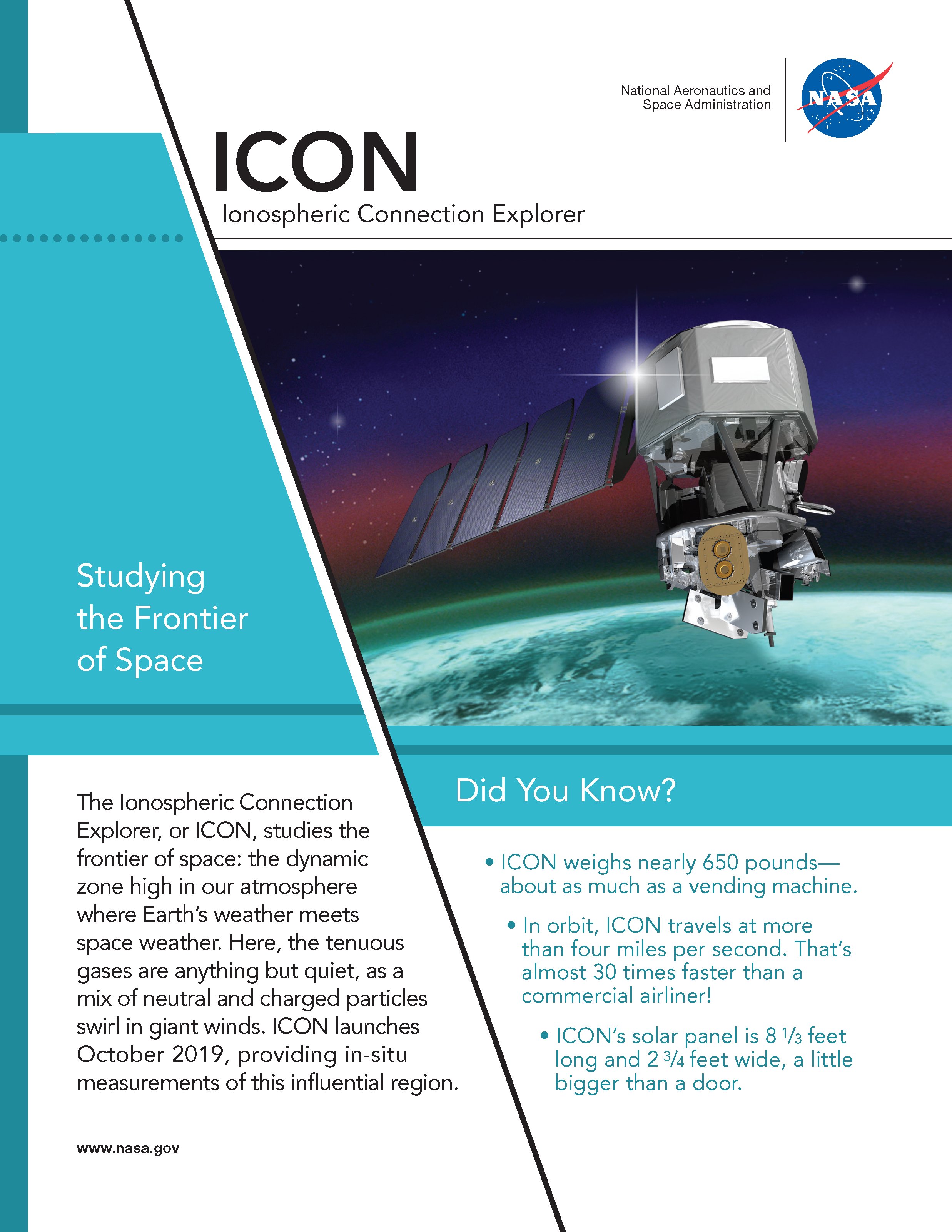

Название: ICON – Pegasus XL – Cape Canaveral AFS, L-1011 "Stargazer" – 11.10.2019 – 04:59:05 ДМВ
Отправлено: tnt22 от 06.10.2019 11:01:16
Отправлено: tnt22 от 06.10.2019 11:01:16
Опубликована брошюра миссии
icon_presskit_oct2019.pdf (https://www.nasa.gov/sites/default/files/atoms/files/icon_presskit_oct2019.pdf) - 1.2 MB, 19 стр, 2019-10-04 17:58:13 UTC


icon_presskit_oct2019.pdf (https://www.nasa.gov/sites/default/files/atoms/files/icon_presskit_oct2019.pdf) - 1.2 MB, 19 стр, 2019-10-04 17:58:13 UTC
Название: ICON – Pegasus XL – Cape Canaveral AFS, L-1011 "Stargazer" – 11.10.2019 – 04:59:05 ДМВ
Отправлено: tnt22 от 06.10.2019 11:01:59
Отправлено: tnt22 от 06.10.2019 11:01:59
Название: ICON – Pegasus XL – Cape Canaveral AFS, L-1011 "Stargazer" – 11.10.2019 – 04:59:05 ДМВ
Отправлено: tnt22 от 06.10.2019 11:02:44
Отправлено: tnt22 от 06.10.2019 11:02:44
Название: ICON – Pegasus XL – Cape Canaveral AFS, L-1011 "Stargazer" – 11.10.2019 – 04:59:05 ДМВ
Отправлено: tnt22 от 06.10.2019 11:03:13
Отправлено: tnt22 от 06.10.2019 11:03:13
Название: ICON – Pegasus XL – Cape Canaveral AFS, L-1011 "Stargazer" – 11.10.2019 – 04:59:05 ДМВ
Отправлено: tnt22 от 06.10.2019 11:04:44
Отправлено: tnt22 от 06.10.2019 11:04:44
Название: ICON – Pegasus XL – Cape Canaveral AFS, L-1011 "Stargazer" – 11.10.2019 – 04:59:05 ДМВ
Отправлено: tnt22 от 06.10.2019 11:05:22
Отправлено: tnt22 от 06.10.2019 11:05:22
Название: ICON – Pegasus XL – Cape Canaveral AFS, L-1011 "Stargazer" – 11.10.2019 – 04:59:05 ДМВ
Отправлено: tnt22 от 07.10.2019 14:31:26
Отправлено: tnt22 от 07.10.2019 14:31:26
Опубликованы закрываемые зоны
lnm07402019.pdf (https://www.navcen.uscg.gov/pdf/lnms/lnm07402019.pdf), стр. 5

lnm07402019.pdf (https://www.navcen.uscg.gov/pdf/lnms/lnm07402019.pdf), стр. 5
Название: ICON – Pegasus XL – Cape Canaveral AFS, L-1011 "Stargazer" – 11.10.2019 – 04:59:05 ДМВ
Отправлено: tnt22 от 07.10.2019 15:02:52
Отправлено: tnt22 от 07.10.2019 15:02:52
Карта закрываемых зон
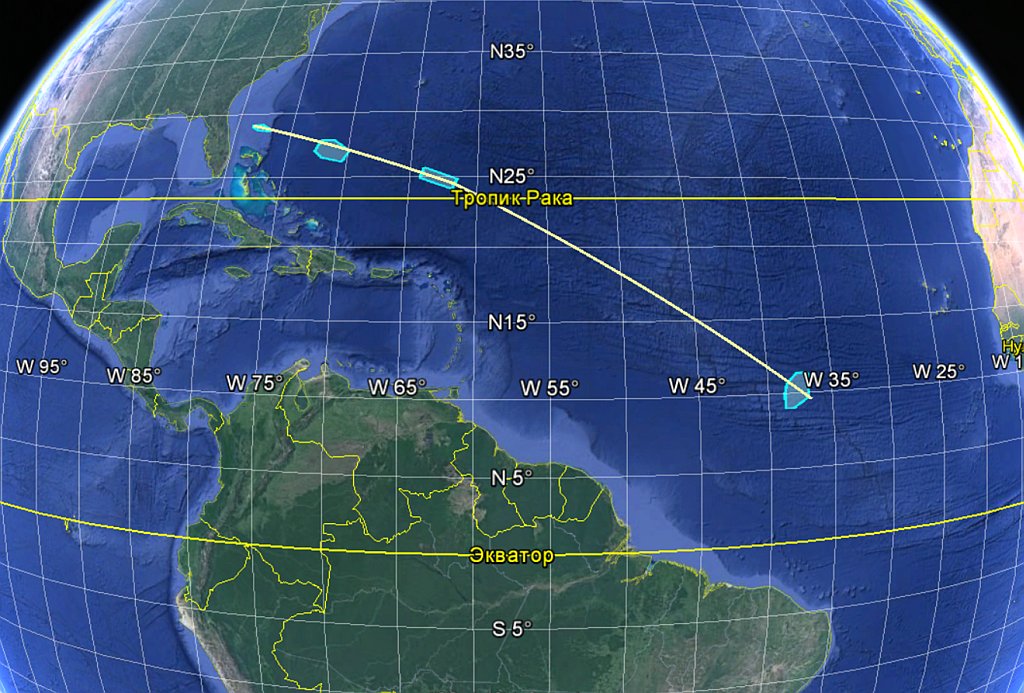
Название: ICON – Pegasus XL – Cape Canaveral AFS, L-1011 "Stargazer" – 11.10.2019 – 04:59:05 ДМВ
Отправлено: tnt22 от 07.10.2019 16:29:57
Отправлено: tnt22 от 07.10.2019 16:29:57
ЦитироватьNorthrop Grumman @northropgrumman (https://twitter.com/northropgrumman) 2 мин. назад (https://twitter.com/northropgrumman/status/1181198752616456193)
It's launch week! On Wednesday, 3 #NorthropGrumman (https://twitter.com/hashtag/NorthropGrumman?src=hash)-built spacecraft will launch from 2 continents. Our MEV-1 & @Eutelsat_SA (https://twitter.com/Eutelsat_SA)'s 5 West B will launch aboard an @ILSLaunch (https://twitter.com/ILSLaunch) Proton at 6:17 a.m. ET & #NASAICON (https://twitter.com/hashtag/NASAICON?src=hash) will launch aboard our #PegasusXL (https://twitter.com/hashtag/PegasusXL?src=hash) at 9:30 p.m. ET. Stay tuned for updates![свернуть]
Название: ICON – Pegasus XL – Cape Canaveral AFS, L-1011 "Stargazer" – 11.10.2019 – 04:59:05 ДМВ
Отправлено: тавот от 07.10.2019 18:55:31
Отправлено: тавот от 07.10.2019 18:55:31
Причины столь длительного переноса не озвучили ? Или я пропустил ? :cry:
Название: ICON – Pegasus XL – Cape Canaveral AFS, L-1011 "Stargazer" – 11.10.2019 – 04:59:05 ДМВ
Отправлено: tnt22 от 07.10.2019 19:59:19
Отправлено: tnt22 от 07.10.2019 19:59:19
Цитироватьтавот написал:См #119 (http://novosti-kosmonavtiki.ru/forum/messages/forum11/topic16217/message1887491/#message1887491) (других подробностей вроде не было)
Причины столь длительного переноса не озвучили ? Или я пропустил ?
ЦитироватьThe launch has been rescheduled to Oct. 10, 2019, following the completion of a joint NASA/Northrop Grumman investigation into a Pegasus sensor reading that was not within normal limits during previous ferry and launch attempt flights. The cause of the issue is understood, and the flight hardware has been modified to address the issue. Two L-1011 flights with Pegasus were conducted to verify the effectiveness of the modification with no issues. Functional tests are being performed on NASA's ICON spacecraft, which utilizes Northrop Grumman's LEOStar-2 platform, to ensure that the ICON spacecraft is ready for the upcoming integration activity, ferry flight and launch.
Название: ICON – Pegasus XL – Cape Canaveral AFS, L-1011 "Stargazer" – 11.10.2019 – 04:59:05 ДМВ
Отправлено: tnt22 от 07.10.2019 20:11:27
Отправлено: tnt22 от 07.10.2019 20:11:27
https://blogs.nasa.gov/icon/2019/10/07/launch-week-arrives-for-icon/ (https://blogs.nasa.gov/icon/2019/10/07/launch-week-arrives-for-icon/)
ЦитироватьLaunch Week Arrives for ICON
Danielle Sempsrott (https://blogs.nasa.gov/icon/author/dsempsro/)
Posted Oct 7, 2019 at 10:14 am
The Northrop Grumman Pegasus XL rocket, carrying NASA's Ionospheric Connection Explorer (ICON), has arrived at the Skid Strip at Cape Canaveral Air Force Station in Florida on Oct. 1, 2019. The rocket is attached beneath the company's L-1011 Stargazer aircraft. ICON will study the frontier of space – the dynamic zone high in Earth's atmosphere where terrestrial weather from below meets space weather above. Photo credit: NASA/Ben Smegelsky
NASA's Ionospheric Connection Explorer – or ICON – satellite is scheduled to launch Wednesday, Oct. 9, from Cape Canaveral Air Force Station in Florida. ICON will be air-launched from a Northrop Grumman Pegasus XL rocket, carried by the company's L-1011 aircraft, Stargazer. Launch is currently scheduled for 9:30 p.m. EDT.
Weather officials from the U.S. Air Force 45th Space Wing predict a 40% chance of favorable weather conditions for launch. Primary concerns are cumulous clouds and lightning. We'll continue to provide weather and launch updates here on the blog, so be sure to check back in!
Название: ICON – Pegasus XL – Cape Canaveral AFS, L-1011 "Stargazer" – 11.10.2019 – 04:59:05 ДМВ
Отправлено: tnt22 от 08.10.2019 19:57:19
Отправлено: tnt22 от 08.10.2019 19:57:19
Название: ICON – Pegasus XL – Cape Canaveral AFS, L-1011 "Stargazer" – 11.10.2019 – 04:59:05 ДМВ
Отправлено: tnt22 от 08.10.2019 20:04:16
Отправлено: tnt22 от 08.10.2019 20:04:16
Название: ICON – Pegasus XL – Cape Canaveral AFS, L-1011 "Stargazer" – 11.10.2019 – 04:59:05 ДМВ
Отправлено: tnt22 от 08.10.2019 20:04:42
Отправлено: tnt22 от 08.10.2019 20:04:42
Название: ICON – Pegasus XL – Cape Canaveral AFS, L-1011 "Stargazer" – 11.10.2019 – 04:59:05 ДМВ
Отправлено: tnt22 от 08.10.2019 20:06:06
Отправлено: tnt22 от 08.10.2019 20:06:06
Название: ICON – Pegasus XL – Cape Canaveral AFS, L-1011 "Stargazer" – 11.10.2019 – 04:59:05 ДМВ
Отправлено: tnt22 от 08.10.2019 20:08:04
Отправлено: tnt22 от 08.10.2019 20:08:04
Название: ICON – Pegasus XL – Cape Canaveral AFS, L-1011 "Stargazer" – 11.10.2019 – 04:59:05 ДМВ
Отправлено: tnt22 от 08.10.2019 20:12:36
Отправлено: tnt22 от 08.10.2019 20:12:36
Название: ICON – Pegasus XL – Cape Canaveral AFS, L-1011 "Stargazer" – 11.10.2019 – 04:59:05 ДМВ
Отправлено: tnt22 от 08.10.2019 20:14:39
Отправлено: tnt22 от 08.10.2019 20:14:39
Название: ICON – Pegasus XL – Cape Canaveral AFS, L-1011 "Stargazer" – 11.10.2019 – 04:59:05 ДМВ
Отправлено: tnt22 от 08.10.2019 20:15:51
Отправлено: tnt22 от 08.10.2019 20:15:51
Название: ICON – Pegasus XL – Cape Canaveral AFS, L-1011 "Stargazer" – 11.10.2019 – 04:59:05 ДМВ
Отправлено: tnt22 от 08.10.2019 20:18:05
Отправлено: tnt22 от 08.10.2019 20:18:05
Название: ICON – Pegasus XL – Cape Canaveral AFS, L-1011 "Stargazer" – 11.10.2019 – 04:59:05 ДМВ
Отправлено: tnt22 от 08.10.2019 20:19:01
Отправлено: tnt22 от 08.10.2019 20:19:01
Stephen Clark, SFN

Название: ICON – Pegasus XL – Cape Canaveral AFS, L-1011 "Stargazer" – 11.10.2019 – 04:59:05 ДМВ
Отправлено: tnt22 от 08.10.2019 20:23:23
Отправлено: tnt22 от 08.10.2019 20:23:23
ЦитироватьChris G - NSF @ChrisG_NSF (https://twitter.com/ChrisG_NSF) 7 мин. назад (https://twitter.com/ChrisG_NSF/status/1181619017796194312)
The @northropgrumman (https://twitter.com/northropgrumman) representation says they have fixed the issue that plagued last year's launch attempts with #Pegasus (https://twitter.com/hashtag/Pegasus?src=hash). Weather is now the question... with a 70% NO GO forecast for Wednesday. 60% GO on Thursday.
Название: ICON – Pegasus XL – Cape Canaveral AFS, L-1011 "Stargazer" – 11.10.2019 – 04:59:05 ДМВ
Отправлено: tnt22 от 08.10.2019 20:40:18
Отправлено: tnt22 от 08.10.2019 20:40:18
Название: ICON – Pegasus XL – Cape Canaveral AFS, L-1011 "Stargazer" – 11.10.2019 – 04:59:05 ДМВ
Отправлено: tnt22 от 08.10.2019 20:41:15
Отправлено: tnt22 от 08.10.2019 20:41:15
Название: ICON – Pegasus XL – Cape Canaveral AFS, L-1011 "Stargazer" – 11.10.2019 – 04:59:05 ДМВ
Отправлено: tnt22 от 08.10.2019 20:41:49
Отправлено: tnt22 от 08.10.2019 20:41:49
Название: ICON – Pegasus XL – Cape Canaveral AFS, L-1011 "Stargazer" – 11.10.2019 – 04:59:05 ДМВ
Отправлено: tnt22 от 08.10.2019 20:42:01
Отправлено: tnt22 от 08.10.2019 20:42:01
Название: ICON – Pegasus XL – Cape Canaveral AFS, L-1011 "Stargazer" – 11.10.2019 – 04:59:05 ДМВ
Отправлено: tnt22 от 08.10.2019 20:42:14
Отправлено: tnt22 от 08.10.2019 20:42:14
Название: ICON – Pegasus XL – Cape Canaveral AFS, L-1011 "Stargazer" – 11.10.2019 – 04:59:05 ДМВ
Отправлено: tnt22 от 08.10.2019 20:52:31
Отправлено: tnt22 от 08.10.2019 20:52:31
Название: ICON – Pegasus XL – Cape Canaveral AFS, L-1011 "Stargazer" – 11.10.2019 – 04:59:05 ДМВ
Отправлено: tnt22 от 08.10.2019 20:53:07
Отправлено: tnt22 от 08.10.2019 20:53:07
Название: ICON – Pegasus XL – Cape Canaveral AFS, L-1011 "Stargazer" – 11.10.2019 – 04:59:05 ДМВ
Отправлено: tnt22 от 08.10.2019 20:57:24
Отправлено: tnt22 от 08.10.2019 20:57:24
Название: ICON – Pegasus XL – Cape Canaveral AFS, L-1011 "Stargazer" – 11.10.2019 – 04:59:05 ДМВ
Отправлено: tnt22 от 08.10.2019 21:01:06
Отправлено: tnt22 от 08.10.2019 21:01:06
Брифинг завершен

Название: ICON – Pegasus XL – Cape Canaveral AFS, L-1011 "Stargazer" – 11.10.2019 – 04:59:05 ДМВ
Отправлено: tnt22 от 08.10.2019 21:10:08
Отправлено: tnt22 от 08.10.2019 21:10:08
Прогноз погоды L-2 на 10 октября (UTC)
L-2 Pegasus (https://www.patrick.af.mil/Portals/14/Weather/L-2%20Days%20Pegasus%20ICON%20MEF.pdf?ver=2019-10-08-102114-170)

Пусковой день (10.10) - 30 % GO
Резервный день (11.10) - 60 % GO
L-2 Pegasus (https://www.patrick.af.mil/Portals/14/Weather/L-2%20Days%20Pegasus%20ICON%20MEF.pdf?ver=2019-10-08-102114-170)
Пусковой день (10.10) - 30 % GO
Резервный день (11.10) - 60 % GO
Название: ICON – Pegasus XL – Cape Canaveral AFS, L-1011 "Stargazer" – 11.10.2019 – 04:59:05 ДМВ
Отправлено: tnt22 от 08.10.2019 21:25:50
Отправлено: tnt22 от 08.10.2019 21:25:50
https://blogs.nasa.gov/icon/2019/10/08/nasa-northrop-grumman-prepare-for-launch-of-icon/ (https://blogs.nasa.gov/icon/2019/10/08/nasa-northrop-grumman-prepare-for-launch-of-icon/)
https://blogs.nasa.gov/kennedy/2019/10/08/nasa-northrop-grumman-prepare-for-launch-of-icon/ (https://blogs.nasa.gov/kennedy/2019/10/08/nasa-northrop-grumman-prepare-for-launch-of-icon/)
https://blogs.nasa.gov/kennedy/2019/10/08/nasa-northrop-grumman-prepare-for-launch-of-icon/ (https://blogs.nasa.gov/kennedy/2019/10/08/nasa-northrop-grumman-prepare-for-launch-of-icon/)
ЦитироватьNASA, Northrop Grumman Prepare for Launch of ICON
Danielle Sempsrott (https://blogs.nasa.gov/icon/author/dsempsro/)
Posted Oct 8, 2019 at 10:16 am
Northrop Grumman's L-1011 Stargazer aircraft has arrived at the Skid Strip at Cape Canaveral Air Force Station in Florida on Oct. 1, 2019. The company's Pegasus XL rocket, containing NASA's Ionospheric Connection Explorer (ICON), is attached beneath the aircraft. ICON will study the frontier of space – the dynamic zone high in Earth's atmosphere where terrestrial weather fr om below meets space weather above. Photo credit: NASA/Ben Smegelsky
NASA and Northrop Grumman will hold a mission briefing at the agency's Kennedy Space Center in Florida at 1 p.m. EDT on Tuesday, Oct. 8, in preparation for the launch of NASA's Ionospheric Connection Explorer (ICON) satellite. Tune in to NASA TV (https://www.nasa.gov/multimedia/nasatv/index.html#public) and the agency's website (https://www.nasa.gov/nasalive) to watch the mission briefing live.
The Northrop Grumman L-1011 Stargazer aircraft, carrying a Pegasus XL rocket with the agency's ICON satellite, will take off from the Cape Canaveral Air Force Station Skid Strip on Oct. 9. The launch window will be open from 9:25 to 10:55 p.m., with a targeted release at 9:30 p.m. Ignition of the Pegasus XL rocket will occur five seconds after release from the Stargazer.
ICON is designed to study the frontier of space: the dynamic zone high in our atmosphere wh ere terrestrial weather from below meets space weather above.
Be sure to follow our blog for launch updates. Live launch coverage here and on NASA TV (https://www.nasa.gov/multimedia/nasatv/index.html#public) will begin at 9:15 p.m. on Oct. 9.
Название: ICON – Pegasus XL – Cape Canaveral AFS, L-1011 "Stargazer" – 11.10.2019 – 04:59:05 ДМВ
Отправлено: tnt22 от 09.10.2019 00:23:44
Отправлено: tnt22 от 09.10.2019 00:23:44
https://blogs.nasa.gov/icon/2019/10/08/pegasus-icon-satellite-set-to-launch-tomorrow/ (https://blogs.nasa.gov/icon/2019/10/08/pegasus-icon-satellite-set-to-launch-tomorrow/)
ЦитироватьPegasus, ICON Satellite Set to Launch Tomorrow
Danielle Sempsrott (https://blogs.nasa.gov/icon/author/dsempsro/)
Posted Oct 8, 2019 at 4:28 pm
Live coverage of NASA's Ionospheric Connection Explorer (ICON) Prelaunch Mission Briefing fr om Kennedy Space Center in Florida. Representatives from NASA, Northrop Grumman Innovation Systems, the Air Force's 45th Space Wing, and the University of California, Berkeley provided an overview of the ICON mission. ICON will launch on a Northrop Grumman Pegasus XL rocket from the company's Stargazer L-1011 on Wednesday, October 9, 2019. The ICON mission was managed by NASA's Launch Services Program. Photo credit: NASA/Kim Shiflett
NASA's Ionospheric Connection Explorer (ICON) satellite is set to launch from a Northrop Grumman Pegasus XL rocket – carried by the company's L-1011 Stargazer aircraft – on Wednesday, Oct. 9, from the Skid Strip runway at Cape Canaveral Air Force Station in Florida. Once Stargazer is airborne and has reached the right altitude and location, the rocket will be released for launch.
Will Ulrich, launch weather officer with the U.S. Air Force 45th Space Wing, speaks to news media during a prelaunch mission briefing for NASA's Ionospheric Connection Explorer (ICON), on Oct. 8, 2019, in the News Center auditorium at the agency's Kennedy Space Center in Florida. Photo credit: NASA/Kim Shiflett
One thing to keep an eye on for tomorrow's launch is the weather. With a cold front moving in and a forecast of scattered showers throughout the day, weather officials from the U.S. Air Force 45th Space Wing are currently predicting a 30% chance of favorable weather conditions for launch. Primary weather concerns are the cumulus cloud rule and lightning rule.
"I wish I had some better news, but ultimately, we're going to do our best with all the tools we have at our disposal to ensure that tomorrow's launch – or potentially Thursday night's launch – is as safe as possible," said Will Ulrich, launch weather officer for the U.S. Air Force 45th Space Wing, in Tuesday afternoon's mission briefing.
The 90-minute launch window opens at 9:25 p.m. EDT on Oct. 9, with a targeted release at 9:30 p.m. If ICON is unable to launch tomorrow due to unfavorable weather conditions, the backup launch date is Oct. 10, with the same targeted release time.
"If we go to the backup day – hopefully we don't need to have a 24-hour delay, but should we – conditions are going to be a little better," said Ulrich. Thursday's forecast shows less chance of rain, and weather conditions improve to a 60% chance "go" for launch.
Once ICON reaches orbit, it will study the dynamic zone high in our atmosphere wh ere terrestrial weather from below meets space weather from above.
Live launch coverage and countdown will begin at 9:15 p.m. on Oct. 9 here on the blog, on NASA TV (https://www.nasa.gov/multimedia/nasatv/index.html#public) and the agency's website (https://www.nasa.gov/nasalive). Learn more about NASA's ICON mission at: https://www.nasa.gov/icon (https://www.nasa.gov/icon)
Название: ICON – Pegasus XL – Cape Canaveral AFS, L-1011 "Stargazer" – 11.10.2019 – 04:59:05 ДМВ
Отправлено: tnt22 от 09.10.2019 00:27:54
Отправлено: tnt22 от 09.10.2019 00:27:54
ЦитироватьNASA | ICON mission briefing | Northrop Grumman's Pegasus XL rockethttps://www.youtube.com/watch?v=VLdg6Z5_Cwo (https://www.youtube.com/watch?v=VLdg6Z5_Cwo)https://www.youtube.com/embed/VLdg6Z5_Cwo (https://www.youtube.com/embed/VLdg6Z5_Cwo) (59:21)(https://www.youtube.com/channel/UC6Iv92nZE21XWt0B1ZTCd6Q) space googlevesaire (https://www.youtube.com/channel/UC6Iv92nZE21XWt0B1ZTCd6Q)
Трансляция началась 4 часа назад
Briefing from NASA's Kennedy Space Center in Florida
Название: ICON – Pegasus XL – Cape Canaveral AFS, L-1011 "Stargazer" – 11.10.2019 – 04:59:05 ДМВ
Отправлено: tnt22 от 09.10.2019 16:18:16
Отправлено: tnt22 от 09.10.2019 16:18:16
https://spaceflightnow.com/2019/10/08/pegasus-rocket-ready-for-airborne-launch-with-nasa-scientific-satellite/ (https://spaceflightnow.com/2019/10/08/pegasus-rocket-ready-for-airborne-launch-with-nasa-scientific-satellite/)
ЦитироватьPegasus rocket ready for airborne launch with NASA scientific satellite
October 8, 2019 (https://spaceflightnow.com/2019/10/) | Stephen Clark (https://spaceflightnow.com/author/stephen-clark/)
A Northrop Grumman Pegasus XL rocket is mounted underneath an L-1011 carrier jet, which will fire the launcher into orbit as soon as Wednesday night off Florida's east coast. Credit: NASA/ Ben Smegelsky
After a year-long delay to troubleshoot recurring erroneous data signatures fr om the rudder of Northrop Grumman's air-launched Pegasus XL rocket, NASA is eager to send a $252 million research satellite into orbit as soon as Wednesday night off Florida's east coast on a mission to probe the ionosphere, a region near the boundary between Earth's atmosphere and space.
The Ionospheric Connection Explorer, or ICON, mission is dedicated to studying the link between Earth's weather systems and space weather driven by solar activity on the ionosphere, a layer in the upper atmosphere where plasma variations can impact satellite communications and GPS navigation signals.
"The ionosphere is continually changing, and it's very dynamic, so that can have big impacts on our ability to do this kind of communication," said Nicky Fox, head of NASA's heliophysics division. "So not only is it a great place to go and study plasma physics, but it's also a region that has a big space weather impact on us."
Northrop Grumman's L-1011 carrier jet will take off at 8:32 p.m. EDT Wednesday (0032 GMT Thursday) fr om the Skid Strip airfield at Cape Canaveral Air Force Station and head for a drop box roughly 50 to 100 miles (80 to 160 kilometers) east of Daytona Beach.
If all goes according to plan, L-1011 flight crew will release the 57-foot-long (17-meter) Pegasus XL rocket at 9:30 p.m. EDT (0130 GMT). Five seconds later, the three-stage Pegasus launcher will ignite and fire into orbit with the ICON spacecraft.
Bad weather is in the forecast Wednesday night, however, and there is just a 30 percent chance of favorable conditions for the Pegasus launch. Forecasters from the U.S. Air Force's 45th Weather Squadron predict numerous rain showers and thunderstorms Wednesday night associated with a weather system moving through Florida could violate launch weather rules related to lightning and cumulus clouds.
There is a 90-minute launch window available Wednesday that opens at 9:25 p.m. EDT (0125 GMT), enough time for the L-1011 carrier jet to make a second pass through the drop box if needed.
Better weather is forecast Thursday, when there's a 60 percent probability of acceptable conditions for launch.
"In the event of a 24-hour delay, precipitation chances appear to diminish through the day on Thursday as drier mid-level air works into the area," forecasters wrote in a launch weather outlook. "Precipitation should be more isolated and the potential for thunder is significantly lower. The primary concern (Thursday) will be the cumulus rule."
It has been a rocky start in getting ICON into space.
Two launch campaigns last year were cut short by erroneous data signatures that showed movement on the Pegasus rocket's rudder, one of three aerodynamic control surfaces on the solid-fueled rocket's winged first stage.
"It was the rudder actuator (wh ere) we were seeing some anomalous position feedback readings, basically noise spikes in the feedback line," said Phil Joyce, vice president of space launch programs at Northrop Grumman. We didn't understand those, but they were significant enough that we were concerned that, if we launched with that condition present, those noise spikes could couple into our control system and cause a bad day."
Engineers from Northrop Grumman and NASA spent 11 months analyzing the problem, testing hardware, developing corrective actions, and then preparing the Pegasus XL rocket and the ICON satellite for another try at launching.
"We wanted to get things right on this rocket," said Omar Baez, NASA's launch director for the ICON mission. "We have no second chances on these types of missions, and we want to get it right."
Teams first noticed the rudder readings during a ferry flight last June (https://spaceflightnow.com/2018/07/05/nasa-northrop-grumman-likely-to-relocate-delayed-pegasus-launch-to-florida/) to the mission's original launch base on Kwajalein Atoll in the Pacific Ocean. Managers decided to return the rocket to Vandenberg Air Force Base — home to the Pegasus launch processing team — during a planned stopover in Hawaii.
NASA and Northrop Grumman officials agreed to relocate the mission's staging base to Cape Canaveral in the aftermath of the aborted Kwajalein launch campaign. Launching from Florida was not originally planned because the ICON satellite was expected to be slightly heavier than it turned out to be, which would have required a launch from a location closer to the equator.
But similar rudder data readings cropped up during a ferry flight from Vandenberg to Cape Canaveral last October, prompting more data reviews and hardware changes in an attempt to resolve the problem. Teams thought they might have the issue fixed, but telemetry data again showed a potential problem after the L-1011 and Pegasus departed Cape Canaveral toward the drop box for a launch attempt Nov. 7.
Managers ordered another stand-down to further investigate the problem, and the L-1011 and Pegasus returned to Vandenberg.
This view of the Pegasus XL rocket inside the Building 1555 processing facility at Vandenberg Air Force Base in California shows the vehicle's aerodynamic control surfaces, including the rudder at the top of the first stage. Credit: NASA/Randy Beaudoin
"It really says something about a team when you have a lot of adversity, and ICON is certainly no different," Joyce said Tuesday. "This is an incredibly complex machine. We saw some things on our previous launch attempt that none of us were comfortable with, and we decided to stand down, go address those and make sure that we really understood what was happening there.
Engineers did not see the spurious rudder data during pre-launch testing on the ground. The problem only manifested itself when the Pegasus was airborne under the L-1011 carrier jet at low pressures and cold temperatures.
"That required a really extensive ground test, modeling, simulation and flight test activity to get the bottom of what was really an extremely challenging problem, one of the most challenging that I've seen in my career in this business over some 30 years," Joyce said.
"But we got there," he said. "With NASA, we were able to get to some surprising results that told us a little bit more about the system that we have on the Pegasus, and educated us, and we made some really smart corrective actions."
Engineers were unable to identify the root cause of the erroneous rudder position data. The Pegasus launcher set to deliver ICON into orbit is the first to fly with a new actuator control unit. Joyce said engineers, among there things, made some "slight modifications" to electronics controlling the rudder actuators on the Pegasus first stage.
"There were actually five or six different things that we thought were coupling into this phenomenon that we were seeing, and what we did to correct the problem is we went and attacked all of those," Joyce said. "So we modified our electronics to be less sensitive to this, we modified some of the hardware in that feedback circuit to be more robust to the environment that the L-1011 provides ... And we went back and demonstrated that the modified systems would handle those environments in the lab, and then we conducted two test flights out at Vandenberg."
On Oct. 1, the L-1011 ferried the Pegasus rocket back to Cape Canaveral. Engineers have not detected a recurrence of the rudder data issues in flight since last year.
Previous concerns related to ICON's Pegasus rocket delayed the mission from 2017.
Engineers wanted more time to inspect the Pegasus rocket motors after they were mishandled during shipment to Vandenberg. That pushed the launch back from June to December 2017, the next availability in the military-run range at the mission's original launch site at Kwajalein in the Marshall Islands.
Then managers decided to ground the mission to assess the reliability of bolt-cutters used to jettison the Pegasus rocket's payload fairing and separate the satellite in orbit.
Those issues were closed out before the first ICON launch campaign last year, when the rudder problems first appeared.
NASA's ICON spacecraft was attached to its Pegasus XL rocket Sept. 10 inside Building 1555 at Vandenberg Air Force Base, California. Credit: NASA/Randy Beaudoin
The ICON mission will be the 44th launch of a Pegasus rocket on a satellite delivery mission, and the 34th in the Pegasus XL configuration with uprated solid rocket motors. It will be the seventh Pegasus launch based out of Cape Canaveral, which hosted the most recent Pegasus rocket mission in December 2016.
The delays have not caused ICON's total cost to rise above NASA's $252 million budget for the mission, Fox said Tuesday.
Since arriving back on Florida's Space Coast last week, the Pegasus launch team have put the rocket through a launch day dress rehearsal and completed most of the final closeouts on the vehicle.
Ground crews at the Skid Strip airfield will begin launch day preparations Wednesday afternoon. The final hands-on tasks on the Pegasus rocket include the removal of safety pins from the launcher's ordnance devices, and the installation of a door on the rocket's payload shroud after checks of internal batteries.
The launch team will begin steps in the Pegasus pre-launch checklist shortly after 5 p.m. EDT (2100 GMT). After starting its engines, the L-1011 carrier aircraft will taxi to the Skid Strip runway for takeoff toward the planned drop point more than 100 miles east-northeast of Cape Canaveral.
The L-1011 carrier jet, a converted airliner previously owned by Air Canada, will head east, then turn around and fly west through the drop box to assess weather conditions. The "race track" pattern will culminate in a final turn to place the carrier aircraft on an easterly heading at an altitude of 39,000 feet (11,900 meters) and an airspeed of Mach 0.82, according to Don Walter, the L-1011's command pilot.
A four-man flight crew and three Pegasus launch vehicle operators will be aboard the L-1011 during the ICON launch.
In the final minute before launch, the Pegasus rocket will sweep its fins to verify their readiness before Steve Gunn, Walter's co-pilot, pushes a button to command release of the launch vehicle.
Hooks will open to allow the Pegasus to free fall for five seconds to a distance of several hundred feet below the L-1011, before the solid-fueled first stage motor fires to begin the climb into space.
"You lose 52,000 pounds (23,600 kilograms) all at once," Walter said. "The airplane wants to go up. It's kind of like a ride at Disneyland, which is a good thing for us. When that rocket lights off, we want to be a long way away."
The L-1011 flight crew. From left to right: Flight engineer Bob Taylor, pilot and flight engineer Mark Kenny, co-pilot Steve Gunn, and command pilot Don Walter. Credit: Alex Polimeni/Spaceflight Now
The Pegasus XL's Orion 50S XL first stage motor will ignite and ramp up to 163,000 pounds of thrust, and the rocket will pitch upward to gain altitude in front of the carrier jet as Walter steers the aircraft awards from the launcher's exhaust plume.
The first stage will burn out at T+plus 1 minute, 17 seconds, followed by stage separation around 16 seconds later. An Orion 50 XL motor will fire at an altitude of around 237,000 feet (72.1 kilometers) with around 44,000 pounds of thrust.
The Pegasus will be above the dense lower layers of the atmosphere by T+plus 2 minutes, 10 seconds, at which time the rocket will shed its clamshell-like nose cone to reveal the ICON satellite.
The Orion 50 XL second stage motor will consume all its solid fuel at T+plus 2 minutes, 48 seconds, then begin a four-minute coast phase for the rocket to climb to the targeted altitude for the ICON mission. During this time, the rocket's on-board computer will calculate when it needs to ignite the third stage based on the performance of the booster to this point.
Separation of the second and third stages is planned around T+plus 7 minutes, followed seconds later by ignition of the third stage Orion 38 motor. The third stage's 69-second burn will place ICON into a 357-mile-high (575-kilometer) orbit inclined 27 degrees to the equator.
The Pegasus rocket will release the 634-pound (288-kilogram) ICON spacecraft from its third stage at T+plus 11 minutes, 20 seconds. ICON will start extending its power-generating solar panels less than two minutes after deployment from the Pegasus rocket, then lock onto the sun to start charging its batteries.
ICON carries no rocket thrusters of its own, so an on-target deployment by the Pegasus rocket is critical to the mission's success. After checkouts, ICON should begin scientific observations in late November, according to Thomas Immel, the mission's principal investigator at the University of California, Berkeley.
Like the Pegasus rocket, the ICON satellite was built by Northrop Grumman. It's based on the company's LEOStar 2 satellite bus.
Wednesday is shaping up to be a busy day for Northrop Grumman. Two commercial satellites built by the aerospace contractor were set to launch (https://spaceflightnow.com/2019/10/09/proton-eutelsat-5wb-mev-1-mission-status-center/) aboard a Proton rocket early Wednesday, and ICON could be the third Northrop Grumman-made spacecraft to launch in less than 24 hours.
Technicians put the ICON satellite in climate-controlled storage while engineers investigated the Pegasus rocket's rudder issues. Teams took ICON out of storage this summer to complete a full health check on the spacecraft. The testing included a deployment test of the satellite's five-panel solar array wing to ensure the mechanisms needed to unfurl the panel were still fully functional.
NASA selected Immel's proposal for the agency's Explorer program in 2013 to probe the extreme variability of the ionosphere, ever-changing layer in the upper atmosphere that affects long-distance radio communications and GPS navigation.
Artist's concept of the ICON satellite in orbit. Credit: NASA
The ICON mission will investigate the link between conditions in the ionosphere, which scientists long thought was primarily driven by solar activity, and weather deeper in Earth's atmosphere.
"The ionosphere is the densest plasma in space between us and the sun, and that plasma has a number of effects on systems that we use every day," Immel said.
The ICON mission will study "how weather in our lower atmosphere, the weather we experience from day to day, influences conditions in space," he said. "This coupling of the lower atmosphere to the upper atmosphere is a new science topic for NASA."
Previous satellite missions detected the unexpected coupling between plasma waves and winds in the ionosphere and terrestrial weather systems.
"What we discovered, using data from a NASA mission called IMAGE, was that this region of the upper atmosphere and ionosphere was actually responding to effects related to weather systems near Earth's surface," said Scott England, ICON project scientist based at Virginia Tech. "This was really unexpected at the time, to see a connection. Wh ere the charged particles were, how many there were, how dense the gas was — they were responding to weather patterns near the surface of the Earth."
"We saw with those missions that the density in the ionosphere varied in response to changes in the rainy seasons in the tropics," Immel said. "The new mission of ICON is to focus on that topic, and we're carrying the instruments to invesitgate that region.
"We think focusing on that will give us a real key to understanding and making better predictions for space weather," he said.
ICON carries four types of instruments developed at the University of California, Berkeley, the Naval Research Laboratory, and the University of Texas at Dallas.
Another NASA mission named GOLD — short for Global-scale Observations of the Limb and Disk — has objectives that intersect with ICON's planned observations.
GOLD is mounted on a geostationary satellite more than 22,000 miles (nearly 36,000 kilometers) over the equator, providing wide-area views of the airglow in the ionosphere.
"ICON is going to come along and provide those in situ measurements, flying right through some of those plasma bubbles that we've been imaging with GOLD for a year now," Fox said.
If ICON had launched on its original schedule, it would have been in space before GOLD.
"There has been a two-year delay," Fox said. "We have learned a little bit more science. We now have a year's worth of GOLD images, so I think, if anything, we're even more excited about what ICON is going to bring to us."
Название: ICON – Pegasus XL – Cape Canaveral AFS, L-1011 "Stargazer" – 11.10.2019 – 04:59:05 ДМВ
Отправлено: tnt22 от 09.10.2019 16:59:03
Отправлено: tnt22 от 09.10.2019 16:59:03
Прогноз погоды L-1 на 10 октября (UTC)
L-1 Pegasus (https://www.patrick.af.mil/Portals/14/Weather/L-1%20Day%20Pegasus%20ICON%20MEF.pdf?ver=2019-10-09-094034-407)

Пусковой день (10.10) - = 30 % GO
Резервный день (11.10) - ↑ 70 % GO
L-1 Pegasus (https://www.patrick.af.mil/Portals/14/Weather/L-1%20Day%20Pegasus%20ICON%20MEF.pdf?ver=2019-10-09-094034-407)
Пусковой день (10.10) - = 30 % GO
Резервный день (11.10) - ↑ 70 % GO
Название: ICON – Pegasus XL – Cape Canaveral AFS, L-1011 "Stargazer" – 11.10.2019 – 04:59:05 ДМВ
Отправлено: tnt22 от 09.10.2019 21:35:03
Отправлено: tnt22 от 09.10.2019 21:35:03
https://spaceflightnow.com/2019/10/09/pegasus-xl-icon-mission-status-center-2/ (https://spaceflightnow.com/2019/10/09/pegasus-xl-icon-mission-status-center-2/)
Цитировать10/09/2019 18:37 Stephen Clark
The latest official weather forecast issued by the U.S. Air Force's 45th Weather Squadron continues to predict a 70 percent probability of unfavorable weather for launch this evening.
"A weak surface trough continues to affect the Florida peninsula this morning," the range weather team wrote in this morning's forecast. "It will move slowly southward across central Florida today and then off the southern part of the peninsula overnight into Thursday. The atmosphere remains moist and unstable which will result in numerous showers and widely scattered thunderstorms to redevelop during the late morning and afternoon hours.
"Precipitation chances will diminish through the evening but there will still be the possibility of precipitation during the count. The primary concerns for violation are the lightning and cumulus cloud rules."
Tonight's 90-minute launch window opens at 9:25 p.m. EDT (0125 GMT). Northrop Grumman's L-1011 carrier jet is expected to drop the 57-foot-long (17-meter) solid-fueled Pegasus XL rocket around 9:30 p.m. EDT, weather permitting.(https://photo.24liveblog.com/2119618526931088763/20191009153757_220704.jpg)
Ground crews at the Skid Strip airfield will begin launch day preparations Wednesday afternoon. The final hands-on tasks on the Pegasus rocket include the removal of safety pins from the launcher's ordnance devices, and the installation of a door on the rocket's payload shroud after checks of internal batteries.
The launch team will begin steps in the Pegasus pre-launch checklist shortly after 5 p.m. EDT (2100 GMT). After starting its engines, the L-1011 carrier aircraft will taxi to the Skid Strip runway for takeoff toward the planned drop point more than 100 miles east-northeast of Cape Canaveral.
The L-1011 carrier jet, a converted airliner previously owned by Air Canada, will head east, then turn around and fly west through the drop box to assess weather conditions. The "race track" pattern will culminate in a final turn to place the carrier aircraft on an easterly heading at an altitude of 39,000 feet (11,900 meters) and an airspeed of Mach 0.82, according to Don Walter, the L-1011's command pilot.
A four-man flight crew and three Pegasus launch vehicle operators will be aboard the L-1011 during the ICON launch.
In the final minute before launch, the Pegasus rocket will sweep its fins to verify their readiness before Steve Gunn, Walter's co-pilot, pushes a button to command release of the launch vehicle.ICON carries no rocket thrusters of its own, so an on-target deployment by the Pegasus rocket is critical to the mission's success. After checkouts, ICON should begin scientific observations in late November, according to Thomas Immel, the mission's principal investigator at the University of California, Berkeley.Hooks will open to allow the Pegasus to free fall for five seconds to a distance of several hundred feet below the L-1011, before the solid-fueled first stage motor fires to begin the climb into space.
"You lose 52,000 pounds (23,600 kilograms) all at once," Walter said. "The airplane wants to go up. It's kind of like a ride at Disneyland, which is a good thing for us. When that rocket lights off, we want to be a long way away."
The Pegasus XL's Orion 50S XL first stage motor will ignite and ramp up to 163,000 pounds of thrust, and the rocket will pitch upward to gain altitude in front of the carrier jet as Walter steers the aircraft awards from the launcher's exhaust plume.(https://photo.24liveblog.com/2119618526931088763/20191009153757_299286.jpg)
The first stage will burn out at T+plus 1 minute, 17 seconds, followed by stage separation around 16 seconds later. An Orion 50 XL motor will fire at an altitude of around 237,000 feet (72.1 kilometers) with around 44,000 pounds of thrust.
The Pegasus will be above the dense lower layers of the atmosphere by T+plus 2 minutes, 10 seconds, at which time the rocket will shed its clamshell-like nose cone to reveal the ICON satellite.
The Orion 50 XL second stage motor will consume all its solid fuel at T+plus 2 minutes, 48 seconds, then begin a four-minute coast phase for the rocket to climb to the targeted altitude for the ICON mission. During this time, the rocket's on-board computer will calculate when it needs to ignite the third stage based on the performance of the booster to this point.
Separation of the second and third stages is planned around T+plus 7 minutes, followed seconds later by ignition of the third stage Orion 38 motor. The third stage's 69-second burn will place ICON into a 357-mile-high (575-kilometer) orbit inclined 27 degrees to the equator.
The Pegasus rocket will release the 634-pound (288-kilogram) ICON spacecraft from its third stage at T+plus 11 minutes, 20 seconds. ICON will start extending its power-generating solar panels less than two minutes after deployment from the Pegasus rocket, then lock onto the sun to start charging its batteries.[свернуть]
Название: ICON – Pegasus XL – Cape Canaveral AFS, L-1011 "Stargazer" – 11.10.2019 – 04:59:05 ДМВ
Отправлено: tnt22 от 09.10.2019 21:59:57
Отправлено: tnt22 от 09.10.2019 21:59:57
Задержка 24 часа по погоде
Цитировать10/09/2019 21:51 Launch delayed to Thursday Stephen Clark
NASA and Northrop Grumman officials have pushed back the launch of a Pegasus XL rocket with a ionospheric research satellite to Thursday due to persistent rain showers over Florida's Coast that show no signs of abating in time for this evening's launch window.
Forecasters predicted poor weather during this evening's 90-minute launch window, which opened at 9:25 p.m. EDT (0125 GMT).
Weather conditions are expected to significantly improve for a launch window Thursday opening at the same time.
There's a 70 percent chance of favorable weather during Thursday's launch window.
ЦитироватьWilliam Harwood @cbs_spacenews (https://twitter.com/cbs_spacenews) 4 мин. назад (https://twitter.com/cbs_spacenews/status/1182005834412412928)
PegasusXL/ICON: Today's planned flight of an air-launched Pegasus XL booster carrying NASA's ICON ionosphere research satellite has been delayed 24 hours due to expected bad weather in the Atlantic Ocean "drop box;" launch retargeted for Thursday at 9:30pm EDT
Название: ICON – Pegasus XL – Cape Canaveral AFS, L-1011 "Stargazer" – 11.10.2019 – 04:59:05 ДМВ
Отправлено: tnt22 от 09.10.2019 22:06:26
Отправлено: tnt22 от 09.10.2019 22:06:26
https://blogs.nasa.gov/icon/2019/10/09/icon-launch-moved-back-24-hours/ (https://blogs.nasa.gov/icon/2019/10/09/icon-launch-moved-back-24-hours/)
ЦитироватьICON Launch Moved Back 24 Hours
James Cawley (https://blogs.nasa.gov/icon/author/jjcawley/)
Due to weather in the area, NASA and Northrop Grumman have decided to move the Pegasus XL and ICON launch 24-hours to October 10 at 9:30 p.m., with takeoff of the Stargazer L-1011 at 8:32 p.m.
NASA's live broadcast will begin tomorrow at 9:15 p.m. on www.nasa.gov/live (http://www.nasa.gov/live).
The teams are not working any issues. The rocket, airplane and spacecraft are ready to launch tomorrow. As always, safety of the crew and mission success are our main focus.
Название: ICON – Pegasus XL – Cape Canaveral AFS, L-1011 "Stargazer" – 11.10.2019 – 04:59:05 ДМВ
Отправлено: tnt22 от 10.10.2019 05:14:46
Отправлено: tnt22 от 10.10.2019 05:14:46
https://www.interfax.ru/world/679794 (https://www.interfax.ru/world/679794)
Цитировать04:52, 10 октября 2019
НАСА на сутки отложило запуск спутника ICON из-за неблагоприятной погоды
Москва. 10 октября. INTERFAX.RU - Запуск спутника ICON, предназначенного для изучения земной ионосферы, перенесен на сутки в связи с неблагоприятной погодой в районе мыса Канаверал, сообщило Национальное управление США по аэронавтике и исследованию космического пространства (НАСА).
Теперь воздушный старт крылатой ракеты легкого класса корпорации Northrop Grumman со спутником NASA планируется совершить с самолета-носителя L-1011 Stargazer в 21:30 в четверг по восточноамериканскому времени (04:30 в пятницу по Москве). Самолет, с которого будет осуществлен пуск ракеты над Атлантикой, поднимется с авиабазы на мысе Канаверал в штате Флорида.
Отделение ракеты со спутником от самолета-носителя должно произойти на высоте около 12 км. Затем ракета должна будет вывести спутник ICON на орбиту высотой около 580 км.
Задачей 287-килограммового спутника НАСА, который будет работать на орбите не менее двух лет, будет заключаться в отслеживании изменений в верхних слоях атмосферы, происходящих под действием солнечной активности. Он будет наблюдать за взаимодействием термосферы и ионосферы Земли. Собранные им данные должны помочь ученым лучше разобраться в эффектах, которые космическая погода оказывает на системы связи, навигации и на космические аппараты.
По оценкам, общая стоимость проекта ICON составляет $252 млн.
Название: ICON – Pegasus XL – Cape Canaveral AFS, L-1011 "Stargazer" – 11.10.2019 – 04:59:05 ДМВ
Отправлено: tnt22 от 10.10.2019 17:08:32
Отправлено: tnt22 от 10.10.2019 17:08:32
Прогноз погоды L-1 на 11 октября (UTC)
L-1 Pegasus (https://www.patrick.af.mil/Portals/14/Weather/L-1%20Day%20Pegasus%20ICON%20MEF%20(Oct%209).pdf?ver=2019-10-10-094338-747)

Пусковой день (11.10) - = 70 % GO
Резервный день (12.10) - 90 % GO
L-1 Pegasus (https://www.patrick.af.mil/Portals/14/Weather/L-1%20Day%20Pegasus%20ICON%20MEF%20(Oct%209).pdf?ver=2019-10-10-094338-747)
Пусковой день (11.10) - = 70 % GO
Резервный день (12.10) - 90 % GO
Название: ICON – Pegasus XL – Cape Canaveral AFS, L-1011 "Stargazer" – 11.10.2019 – 04:59:05 ДМВ
Отправлено: tnt22 от 10.10.2019 20:08:15
Отправлено: tnt22 от 10.10.2019 20:08:15
ЦитироватьNASA Sun & Space @NASASun (https://twitter.com/NASASun) 22 ч. назад (https://twitter.com/NASASun/status/1182012204733911040)
Now on Thursday, Oct. 10 —8:32pm ET: Stargazer airplane takes off
9:15pm ET: @NASA (https://twitter.com/NASA) TV coverage of launch begins at http://nasa.gov/live (https://t.co/U8T7pZaI5r)
9:30pm ET: Launch!
https://video.twimg.com/tweet_video/EGdZpZWWwAIRa8i.mp4 (https://video.twimg.com/tweet_video/EGdZpZWWwAIRa8i.mp4) (0:07)
Название: ICON – Pegasus XL – Cape Canaveral AFS, L-1011 "Stargazer" – 11.10.2019 – 04:59:05 ДМВ
Отправлено: tnt22 от 10.10.2019 21:36:49
Отправлено: tnt22 от 10.10.2019 21:36:49
https://blogs.nasa.gov/icon/2019/10/10/teams-prepare-for-icon-launch-tonight/ (https://blogs.nasa.gov/icon/2019/10/10/teams-prepare-for-icon-launch-tonight/)
https://blogs.nasa.gov/kennedy/2019/10/10/teams-prepare-for-icon-launch-tonight/ (https://blogs.nasa.gov/kennedy/2019/10/10/teams-prepare-for-icon-launch-tonight/)
https://blogs.nasa.gov/kennedy/2019/10/10/teams-prepare-for-icon-launch-tonight/ (https://blogs.nasa.gov/kennedy/2019/10/10/teams-prepare-for-icon-launch-tonight/)
ЦитироватьTeams Prepare for ICON Launch Tonight
Anna Heiney (https://blogs.nasa.gov/icon/author/aheiney/)
Posted Oct 10, 2019 at 2:05 pm(https://img.novosti-kosmonavtiki.ru/130843.jpg)
Northrop Grumman's L-1011 Stargazer aircraft has arrived at the Skid Strip at Cape Canaveral Air Force Station in Florida on Oct. 1, 2019. The company's Pegasus XL rocket, containing NASA's Ionospheric Connection Explorer (ICON), is attached beneath the aircraft. ICON will study the frontier of space – the dynamic zone high in Earth's atmosphere where terrestrial weather from below meets space weather above. Photo credit: NASA/Ben Smegelsky
The Ionospheric Connection Explorer (ICON) will launch tonight on a Northrop Grumman Pegasus XL rocket from the company's Stargazer L-1011 aircraft. The Stargazer will take off from the Cape Canaveral Air Force Station at 8:33 p.m. EDT.
The first launch attempt for ICON is 9:30 p.m. EDT. Follow live coverage here on the blog as well as on NASA TV and on the web at http://nasa.gov/live (http://nasa.gov/live) beginning at 9:15 p.m. EDT.
Название: ICON – Pegasus XL – Cape Canaveral AFS, L-1011 "Stargazer" – 11.10.2019 – 04:59:05 ДМВ
Отправлено: tnt22 от 11.10.2019 00:38:02
Отправлено: tnt22 от 11.10.2019 00:38:02
https://www.militarynews.ru/story.asp?rid=1&nid=519116&lang=RU (https://www.militarynews.ru/story.asp?rid=1&nid=519116&lang=RU)
ЦитироватьНа орбиту стартует американская ракета со спутником ICON для изучения ионосферы - NASA
11.10.2019 0:29:08
Вашингтон. 11 октября. ИНТЕРФАКС - Американская ракета-носитель Pegasus XL в пятницу утром по московскому времени должна стартовать на орбиту со спутником ICON, который предназначен для изучения земной ионосферы, сообщило Национальное управление США по аэронавтике и исследованию космического пространства (NASA).
Воздушный старт крылатой ракеты легкого класса корпорации Northrop Grumman со спутником NASA должен быть осуществлен с самолета-носителя L-1011 Stargazer в 21:30 в четверг по восточноамериканскому времени (04:30 мск в пятницу). Самолет, с которого будет совершен пуск ракеты над Атлантикой, поднимется с авиабазы на мысе Канаверал в штате Флорида.
Запуск первоначально планировался сутками ранее, но был перенесен на 24 часа из-за неблагоприятных погодных условий в районе мыса Канаверал.
Отделение ракеты со спутником от самолета-носителя должно произойти на высоте около 12 км. Затем ракета должна будет вывести спутник ICON на орбиту высотой около 580 км.Задачей 287-килограммового спутника NASA, который будет работать на орбите не менее двух лет, будет заключаться в отслеживании изменений в верхних слоях атмосферы, происходящих под действием солнечной активности. Он будет наблюдать за взаимодействием термосферы и ионосферы Земли. Собранные им данные должны помочь ученым лучше разобраться в эффектах, которые космическая погода оказывает на системы связи, навигации и на космические аппараты.
По оценкам, общая стоимость проекта ICON составляет $252 млн.[свернуть]
Название: ICON – Pegasus XL – Cape Canaveral AFS, L-1011 "Stargazer" – 11.10.2019 – 04:59:05 ДМВ
Отправлено: tnt22 от 11.10.2019 01:39:35
Отправлено: tnt22 от 11.10.2019 01:39:35
Цитировать10/11/2019 01:25 Stephen Clark
An updated forecast from the Air Force's 45th Weather Squadron predicts an 80 percent chance of acceptable weather during tonight's Pegasus launch window, which opens at 9:25 p.m. EDT (0125 GMT).
Drop of the Pegasus rocket over the Atlantic Ocean northeast of Cape Canaveral is planned at 9:30 p.m. EDT (0130 GMT).
Launch preparations at the Pegasus "hotpad" at Cape Canaveral Air Force Station's Skid Strip airfield are proceeding this evening. Takeoff of the L-1011 carrier aircraft with the Pegasus rocket under its belly is planned at 8:33 p.m. EDT (0033 GMT).
The final hands-on tasks on the rocket include the removal of safety pins from the Pegasus's pyrotechnic ordnance devices, and the installation of a door on the rocket's payload fairing before takeoff of the L-1011.
The primary weather concern this evening is with precipitation. Light rain showers are streaming onshore around Cape Canaveral from the northeast, and flight rules prohibit the L-1011 from flying through precipitation with the Pegasus rocket attached during a launch countdown.
But conditions are much improved from yesterday, when widespread rainfall affected Florida's Space Coast.
"This trend is expected to continue as the drier air continues to move across the Space Coast area. Any precipitation that occurs at the Skid Strip will likely be light in nature and brief in duration. The primary weather concern for violation is precipitation.
"Should there be a 24-hour delay, the drier air will continue to erode the potential for precipitation and will become even more widely spread across the area. The primary weather concern (Friday night) is precipitation.
Название: ICON – Pegasus XL – Cape Canaveral AFS, L-1011 "Stargazer" – 11.10.2019 – 04:59:05 ДМВ
Отправлено: tnt22 от 11.10.2019 02:36:58
Отправлено: tnt22 от 11.10.2019 02:36:58
Цитировать10/11/2019 02:19 Stephen Clark
All weather criteria are currently acceptable for takeoff of the Pegasus rocket's L-1011 carrier jet at 8:33 p.m. EDT (0033 GMT) from Cape Canaveral's Skid Strip airfield. But rain showers are in the area.(https://photo.24liveblog.com/2119618526931088763/20191010231956_501043.jpg)
Название: ICON – Pegasus XL – Cape Canaveral AFS, L-1011 "Stargazer" – 11.10.2019 – 04:59:05 ДМВ
Отправлено: tnt22 от 11.10.2019 03:26:21
Отправлено: tnt22 от 11.10.2019 03:26:21
Цитировать10/11/2019 03:17 Stephen Clark
The L-1011 aircraft has begun to taxi away from its "hot pad" staging area in preparation for takeoff
Название: ICON – Pegasus XL – Cape Canaveral AFS, L-1011 "Stargazer" – 11.10.2019 – 04:59:05 ДМВ
Отправлено: tnt22 от 11.10.2019 03:27:54
Отправлено: tnt22 от 11.10.2019 03:27:54
ЦитироватьSpaceflight Now @SpaceflightNow (https://twitter.com/SpaceflightNow) 3 мин. назад (https://twitter.com/SpaceflightNow/status/1182451605603540992)
The Pegasus launch team is "go" for departure of the L-1011 carrier aircraft from Cape Canaveral Air Force Station at 8:31pm EDT (0031 GMT). Drop time remains set for 9:30pm EDT (0130 GMT) to carry NASA's ICON ionospheric research satellite into orbit. https://spaceflightnow.com/2019/10/09/pegasus-xl-icon-mission-status-center-2/ ... (https://t.co/S7Zv4iXmCO)
Название: ICON – Pegasus XL – Cape Canaveral AFS, L-1011 "Stargazer" – 11.10.2019 – 04:59:05 ДМВ
Отправлено: tnt22 от 11.10.2019 03:32:59
Отправлено: tnt22 от 11.10.2019 03:32:59
https://blogs.nasa.gov/icon/2019/10/10/stargazer-preparing-for-takeoff/ (https://blogs.nasa.gov/icon/2019/10/10/stargazer-preparing-for-takeoff/)
ЦитироватьStargazer Preparing for Takeoff
Danielle Sempsrott (https://blogs.nasa.gov/icon/author/dsempsro/)
Posted Oct 10, 2019 at 8:20 pm
Northrop Grumman's L-1011 aircraft, Stargazer, prepares for takeoff at the Cape Canaveral Air Force Station Skid Strip in Florida on Oct. 10, 2019. Attached beneath the aircraft is the company's Pegasus XL rocket, carrying NASA's Ionospheric Connection Explorer (ICON). Photo credit: NASA
Stargazer's engines have powered up on the Skid Strip runway at Cape Canaveral Air Force Station in Florida. Takeoff is scheduled for 8:33 p.m. EDT. Stick with us here on the blog for live updates.
Цитировать10/11/2019 03:28 Stephen Clark
All stations reported a "go" for departure of the L-1011 carrier aircraft from Cape Canaveral Air Force Station, with Air Force, NASA and Northrop Grumman officials voicing approval for takeoff.
Название: ICON – Pegasus XL – Cape Canaveral AFS, L-1011 "Stargazer" – 11.10.2019 – 04:59:05 ДМВ
Отправлено: tnt22 от 11.10.2019 03:34:27
Отправлено: tnt22 от 11.10.2019 03:34:27
Взлёт!
ЦитироватьChris G - NSF @ChrisG_NSF (https://twitter.com/ChrisG_NSF) 50 сек. назад (https://twitter.com/ChrisG_NSF/status/1182453812646289408)
Takeoff! #Stargazer (https://twitter.com/hashtag/Stargazer?src=hash) is airborne and headed to the drop site for tonight's #Pegasus (https://twitter.com/hashtag/Pegasus?src=hash) launch of #ICON (https://twitter.com/hashtag/ICON?src=hash) for #NASA (https://twitter.com/hashtag/NASA?src=hash). @northropgrumman (https://twitter.com/northropgrumman)
Название: ICON – Pegasus XL – Cape Canaveral AFS, L-1011 "Stargazer" – 11.10.2019 – 04:59:05 ДМВ
Отправлено: tnt22 от 11.10.2019 03:39:08
Отправлено: tnt22 от 11.10.2019 03:39:08
Цитировать10/11/2019 03:35 Stephen Clark
The L-1011 "Stargazer" carrier aircraft with the Northrop Grumman Pegasus XL rocket has departed Cape Canaveral Air Force Station in Florida for this evening's launch of NASA's ICON mission. The booster will be released from the jet over the Atlantic Ocean around 9:30 p.m. EDT to propel the Ionospheric Connection Explorer into a 357-mile-high (575-kilometer) orbit.
Название: ICON – Pegasus XL – Cape Canaveral AFS, L-1011 "Stargazer" – 11.10.2019 – 04:59:05 ДМВ
Отправлено: tnt22 от 11.10.2019 03:44:53
Отправлено: tnt22 от 11.10.2019 03:44:53
ЦитироватьNASA_LSP @NASA_LSP (https://twitter.com/NASA_LSP) 6 мин. назад (https://twitter.com/NASA_LSP/status/1182455143452889089)
The L-1011 Stargazer, #PegasusXL (https://twitter.com/hashtag/PegasusXL?src=hash)
& #NASAICON (https://twitter.com/hashtag/NASAICON?src=hash)
will now fly for about 1 hour to an altitude of ~41,300 ft, ~50 miles offshore of Daytona Beach, over the Atlantic Ocean. The rocket will then be manually dropped for launch when everyone is "GO" at about 9:30pm EDT.
Название: ICON – Pegasus XL – Cape Canaveral AFS, L-1011 "Stargazer" – 11.10.2019 – 04:59:05 ДМВ
Отправлено: tnt22 от 11.10.2019 03:46:12
Отправлено: tnt22 от 11.10.2019 03:46:12
Цитировать10/11/2019 03:42 Stephen Clark
T-minus 48 minutes and counting. Stargazer is following a predetermined course commonly called "the race track" patten to reach the precise point where the Pegasus can be released for launch. This ferry flight lasts about an hour, flying east from Cape Canaveral, making a U-turn and then coming back around to launch the rocket toward the east.
Unlike some previous Pegasus missions, there is no chase plane assigned to tonight's launch, which will occur in darkness over the Atlantic Ocean.
Название: ICON – Pegasus XL – Cape Canaveral AFS, L-1011 "Stargazer" – 11.10.2019 – 04:59:05 ДМВ
Отправлено: tnt22 от 11.10.2019 03:48:29
Отправлено: tnt22 от 11.10.2019 03:48:29
Цитировать10/11/2019 03:45 Stephen Clark
This launch originates from the belly of the L-1011, named Stargazer. Originally delivered to Air Canada in March 1974, it was purchased by Orbital ATK in 1992 and modified as the Pegasus launch platform.(https://photo.24liveblog.com/2119618526931088763/20191011004550_076146.jpg)
Название: ICON – Pegasus XL – Cape Canaveral AFS, L-1011 "Stargazer" – 11.10.2019 – 04:59:05 ДМВ
Отправлено: tnt22 от 11.10.2019 03:58:58
Отправлено: tnt22 от 11.10.2019 03:58:58
ЦитироватьNASA_LSP @NASA_LSP (https://twitter.com/NASA_LSP) 48 сек. назад (https://twitter.com/NASA_LSP/status/1182459970178166784)
Photos of takeoff of the @northropgrumman (https://twitter.com/northropgrumman) L-1011 Stargazer, #PegasusXL (https://twitter.com/hashtag/PegasusXL?src=hash)
& #NASAICON (https://twitter.com/hashtag/NASAICON?src=hash)
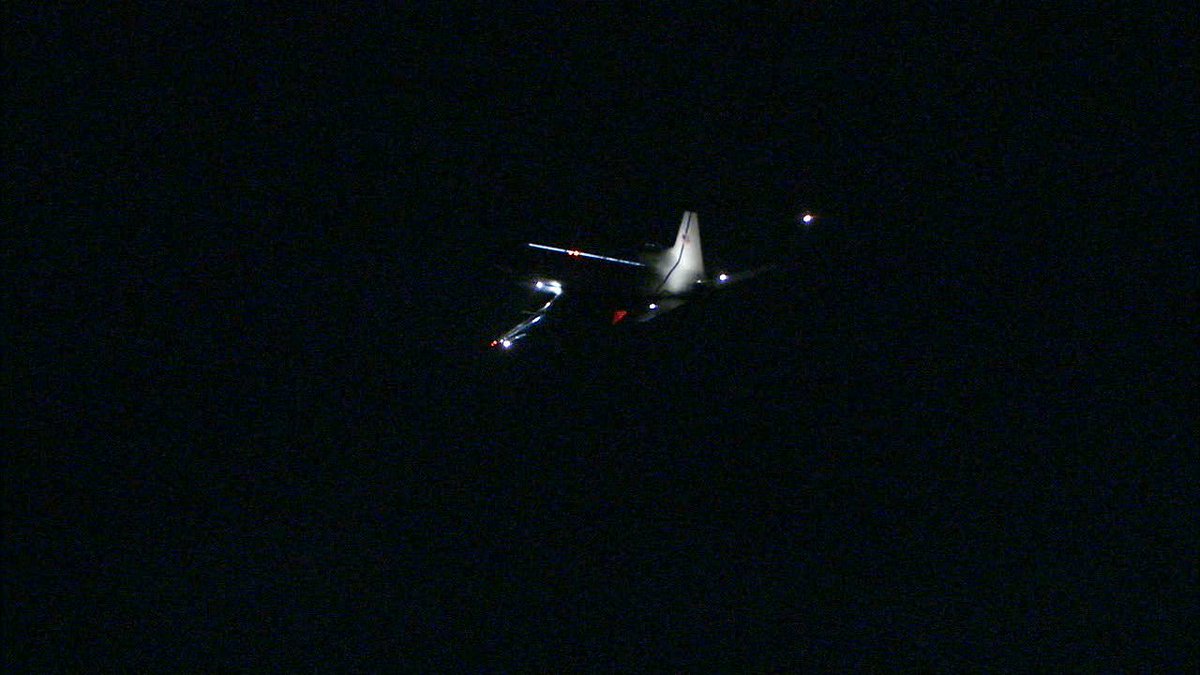
Название: ICON – Pegasus XL – Cape Canaveral AFS, L-1011 "Stargazer" – 11.10.2019 – 04:59:05 ДМВ
Отправлено: tnt22 от 11.10.2019 04:05:28
Отправлено: tnt22 от 11.10.2019 04:05:28
ЦитироватьICON: Takeoff of L-1011 Stargazer Aircrafthttps://www.youtube.com/watch?v=VJj0w_rJfX8 (https://www.youtube.com/watch?v=VJj0w_rJfX8)https://www.youtube.com/embed/VJj0w_rJfX8 (https://www.youtube.com/embed/VJj0w_rJfX8) (1:01)(https://www.youtube.com/user/NASAKennedy) NASAKennedy (https://www.youtube.com/channel/UCjJtr2fFcUp6yljzJOzpHUg)
10 окт. 2019 г.
The Northrop Grumman L-1011 Stargazer aircraft takes off fr om Cape Canaveral Air Force Station in Florida, carrying the Pegasus XL rocket that contains NASA's Ionospheric Connection Explorer (ICON). ICON will study the frontier of space - the dynamic zone high in Earth's atmosphere wh ere terrestrial weather from below meets space weather above.
Название: ICON – Pegasus XL – Cape Canaveral AFS, L-1011 "Stargazer" – 11.10.2019 – 04:59:05 ДМВ
Отправлено: tnt22 от 11.10.2019 04:10:52
Отправлено: tnt22 от 11.10.2019 04:10:52
Цитировать10/11/2019 04:00 Stephen Clark
The L-1011 carrier jet is now executing a 180-degree turn to head back toward the Florida coast. The aircraft will fly through the Pegasus drop box to measure turbulence, winds and other conditions, before turning back around toward the east to begin the launch run.
10/11/2019 04:00 Stephen Clark
Now 30 minutes from the planned launch time. Today marks the 44th flight of the air-launched Pegasus rocket and the 34th using the XL version. The rocket weighs nearly 53,000 pounds, stretches 57 feet long and is comprised of three solid-fueled stages for boosting small satellites into space.
The first stage is 33.7 feet long, 4.2 feet in diameter, has a wingspan of 22 feet and produces 163,000 pounds of thrust. The second stage is 4.2 feet long and 4.2 feet wide for 44,000 pounds of thrust. The third stage is 4.4 feet long and 3.2 feet in diameter with a thrust of 8,000 pounds.
10/11/2019 04:02 Stephen Clark
The drop box is located around 108 miles east-northeast of Cape Canaveral. At the time of the release, the L-1011 aircraft will be flying at an altitude of 39,000 feet, an airspeed of Mach 0.82, on a magnetic heading of 113 degrees.
Название: ICON – Pegasus XL – Cape Canaveral AFS, L-1011 "Stargazer" – 11.10.2019 – 04:59:05 ДМВ
Отправлено: tnt22 от 11.10.2019 04:11:44
Отправлено: tnt22 от 11.10.2019 04:11:44
ЦитироватьWilliam Harwood @cbs_spacenews (https://twitter.com/cbs_spacenews) 4 мин. назад (https://twitter.com/cbs_spacenews/status/1182462429265092609)
PegasusXL/ICON: NASA says the Pegasus XL drop altitude will be 41,300 feet above the Atlantic Ocean about 50 miles east of Daytona Beach
Название: ICON – Pegasus XL – Cape Canaveral AFS, L-1011 "Stargazer" – 11.10.2019 – 04:59:05 ДМВ
Отправлено: tnt22 от 11.10.2019 04:22:31
Отправлено: tnt22 от 11.10.2019 04:22:31
Название: ICON – Pegasus XL – Cape Canaveral AFS, L-1011 "Stargazer" – 11.10.2019 – 04:59:05 ДМВ
Отправлено: tnt22 от 11.10.2019 04:23:04
Отправлено: tnt22 от 11.10.2019 04:23:04
Название: ICON – Pegasus XL – Cape Canaveral AFS, L-1011 "Stargazer" – 11.10.2019 – 04:59:05 ДМВ
Отправлено: tnt22 от 11.10.2019 04:23:35
Отправлено: tnt22 от 11.10.2019 04:23:35
Название: ICON – Pegasus XL – Cape Canaveral AFS, L-1011 "Stargazer" – 11.10.2019 – 04:59:05 ДМВ
Отправлено: tnt22 от 11.10.2019 04:24:15
Отправлено: tnt22 от 11.10.2019 04:24:15
Название: ICON – Pegasus XL – Cape Canaveral AFS, L-1011 "Stargazer" – 11.10.2019 – 04:59:05 ДМВ
Отправлено: tnt22 от 11.10.2019 04:24:41
Отправлено: tnt22 от 11.10.2019 04:24:41
Название: ICON – Pegasus XL – Cape Canaveral AFS, L-1011 "Stargazer" – 11.10.2019 – 04:59:05 ДМВ
Отправлено: tnt22 от 11.10.2019 04:25:01
Отправлено: tnt22 от 11.10.2019 04:25:01
Название: ICON – Pegasus XL – Cape Canaveral AFS, L-1011 "Stargazer" – 11.10.2019 – 04:59:05 ДМВ
Отправлено: tnt22 от 11.10.2019 04:27:38
Отправлено: tnt22 от 11.10.2019 04:27:38
Название: ICON – Pegasus XL – Cape Canaveral AFS, L-1011 "Stargazer" – 11.10.2019 – 04:59:05 ДМВ
Отправлено: tnt22 от 11.10.2019 04:32:15
Отправлено: tnt22 от 11.10.2019 04:32:15
Цитировать10/11/2019 04:29 Stephen Clark
T-minus 90 seconds. The L-1011 is adjusting its course to acquire the proper magnetic heading of 113 degrees. One of the key duties of the aircraft crew is releasing Pegasus on the correct trajectory so that the rocket doesn't have to perform any abrupt steering after ignition.
Название: ICON – Pegasus XL – Cape Canaveral AFS, L-1011 "Stargazer" – 11.10.2019 – 04:59:05 ДМВ
Отправлено: tnt22 от 11.10.2019 04:33:02
Отправлено: tnt22 от 11.10.2019 04:33:02
Цитировать10/11/2019 04:31 Stephen Clark
ABORT.
Название: ICON – Pegasus XL – Cape Canaveral AFS, L-1011 "Stargazer" – 11.10.2019 – 04:59:05 ДМВ
Отправлено: tnt22 от 11.10.2019 04:33:38
Отправлено: tnt22 от 11.10.2019 04:33:38
Цитировать10/11/2019 04:31 Stephen Clark
The Pegasus release was aborted after problems with the voice communications link between ground controllers at Cape Canaveral and the flight crew on the L-1011 carrier aircraft.
Название: ICON – Pegasus XL – Cape Canaveral AFS, L-1011 "Stargazer" – 11.10.2019 – 04:59:05 ДМВ
Отправлено: tnt22 от 11.10.2019 04:35:41
Отправлено: tnt22 от 11.10.2019 04:35:41
ЦитироватьWilliam Harwood @cbs_spacenews (https://twitter.com/cbs_spacenews) 2 мин. назад (https://twitter.com/cbs_spacenews/status/1182468863268655104)
PegasusXL/ICON: The launch team has called off this initial launch attempt, apparently because of a communications glitch between the L-1011 Stargazer carrier jet and flight controllers; not yet clear if the team can make a second attempt later in the window
Название: ICON – Pegasus XL – Cape Canaveral AFS, L-1011 "Stargazer" – 11.10.2019 – 04:59:05 ДМВ
Отправлено: tnt22 от 11.10.2019 04:37:02
Отправлено: tnt22 от 11.10.2019 04:37:02
ЦитироватьSpaceflight Now @SpaceflightNow (https://twitter.com/SpaceflightNow) 57 сек. назад (https://twitter.com/SpaceflightNow/status/1182469634701844480)
The Pegasus launch team is readying for another launch attempt. Tonight's launch window extends until 10:55pm EDT (0255 GMT), and the L-1011 carrier jet will circle back to pass through the drop box again.
LIVE COVERAGE: https://spaceflightnow.com/2019/10/09/pegasus-xl-icon-mission-status-center-2/ ... (https://t.co/S7Zv4iXmCO)
Название: ICON – Pegasus XL – Cape Canaveral AFS, L-1011 "Stargazer" – 11.10.2019 – 04:59:05 ДМВ
Отправлено: tnt22 от 11.10.2019 04:37:47
Отправлено: tnt22 от 11.10.2019 04:37:47
Цитировать10/11/2019 04:36 Stephen Clark
The Pegasus guidance computer has been configured back to "captive carry" mode, and the ICON spacecraft is back on an external power source as the team performs countdown recycle operations.
Название: ICON – Pegasus XL – Cape Canaveral AFS, L-1011 "Stargazer" – 11.10.2019 – 04:59:05 ДМВ
Отправлено: tnt22 от 11.10.2019 04:39:17
Отправлено: tnt22 от 11.10.2019 04:39:17
ЦитироватьChris B - NSF @NASASpaceflight (https://twitter.com/NASASpaceflight) 4 мин. назад (https://twitter.com/NASASpaceflight/status/1182469382771007489)
Racetrack recycle. About 30 minutes to get back to the launch box.
Название: ICON – Pegasus XL – Cape Canaveral AFS, L-1011 "Stargazer" – 11.10.2019 – 04:59:05 ДМВ
Отправлено: tnt22 от 11.10.2019 04:41:30
Отправлено: tnt22 от 11.10.2019 04:41:30
Цитировать10/11/2019 04:38 Stephen Clark
And the Pegasus rocket's avionics are back on external power. The team will perform the internal power switch again during the upcoming second launch attempt.
Название: ICON – Pegasus XL – Cape Canaveral AFS, L-1011 "Stargazer" – 11.10.2019 – 04:59:05 ДМВ
Отправлено: tnt22 от 11.10.2019 04:54:53
Отправлено: tnt22 от 11.10.2019 04:54:53
Цитировать10/11/2019 04:50 Stephen Clark
After heading west to position itself for another launch run, the Stargazer aircraft is now heading back toward the east to fly through the drop box once again.
Some of the city lights of Central Florida are visible in this view from the aircraft.(https://photo.24liveblog.com/2119618526931088763/20191011015016_743689.jpg)
Название: ICON – Pegasus XL – Cape Canaveral AFS, L-1011 "Stargazer" – 11.10.2019 – 04:59:05 ДМВ
Отправлено: tnt22 от 11.10.2019 04:56:02
Отправлено: tnt22 от 11.10.2019 04:56:02
ЦитироватьChris G - NSF @ChrisG_NSF (https://twitter.com/ChrisG_NSF) 12 мин. назад (https://twitter.com/ChrisG_NSF/status/1182471584306597888)
22:00 EDT (02:00 UTC) is new launch time.
Название: ICON – Pegasus XL – Cape Canaveral AFS, L-1011 "Stargazer" – 11.10.2019 – 04:59:05 ДМВ
Отправлено: tnt22 от 11.10.2019 04:57:55
Отправлено: tnt22 от 11.10.2019 04:57:55
Название: ICON – Pegasus XL – Cape Canaveral AFS, L-1011 "Stargazer" – 11.10.2019 – 04:59:05 ДМВ
Отправлено: tnt22 от 11.10.2019 05:00:33
Отправлено: tnt22 от 11.10.2019 05:00:33
Сброс РН
Название: ICON – Pegasus XL – Cape Canaveral AFS, L-1011 "Stargazer" – 11.10.2019 – 04:59:05 ДМВ
Отправлено: tnt22 от 11.10.2019 05:00:48
Отправлено: tnt22 от 11.10.2019 05:00:48
Вкл ДУ 1-й ст РН

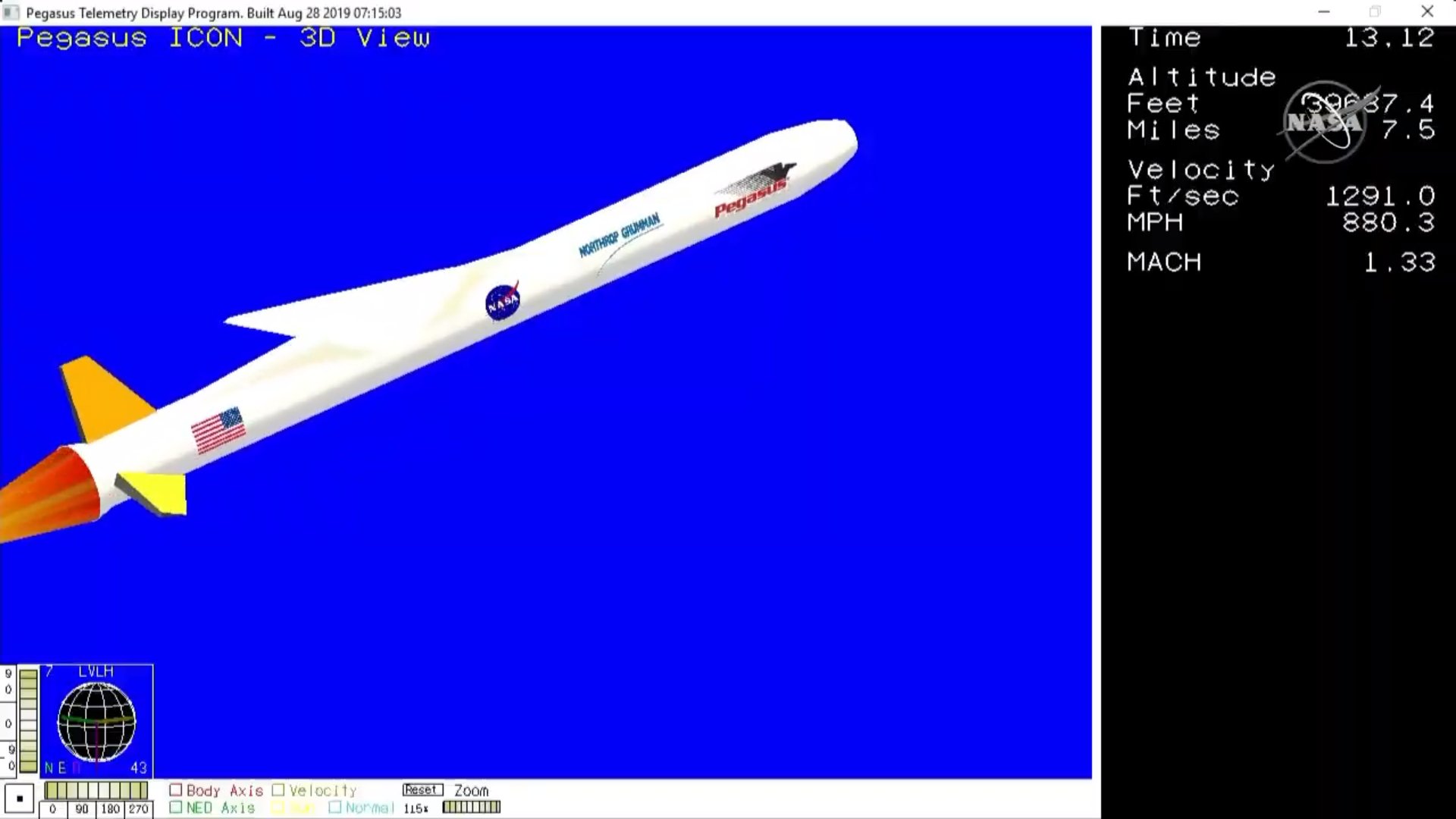

Название: ICON – Pegasus XL – Cape Canaveral AFS, L-1011 "Stargazer" – 11.10.2019 – 04:59:05 ДМВ
Отправлено: tnt22 от 11.10.2019 05:01:53
Отправлено: tnt22 от 11.10.2019 05:01:53
Выкл ДУ 1-й ст РН
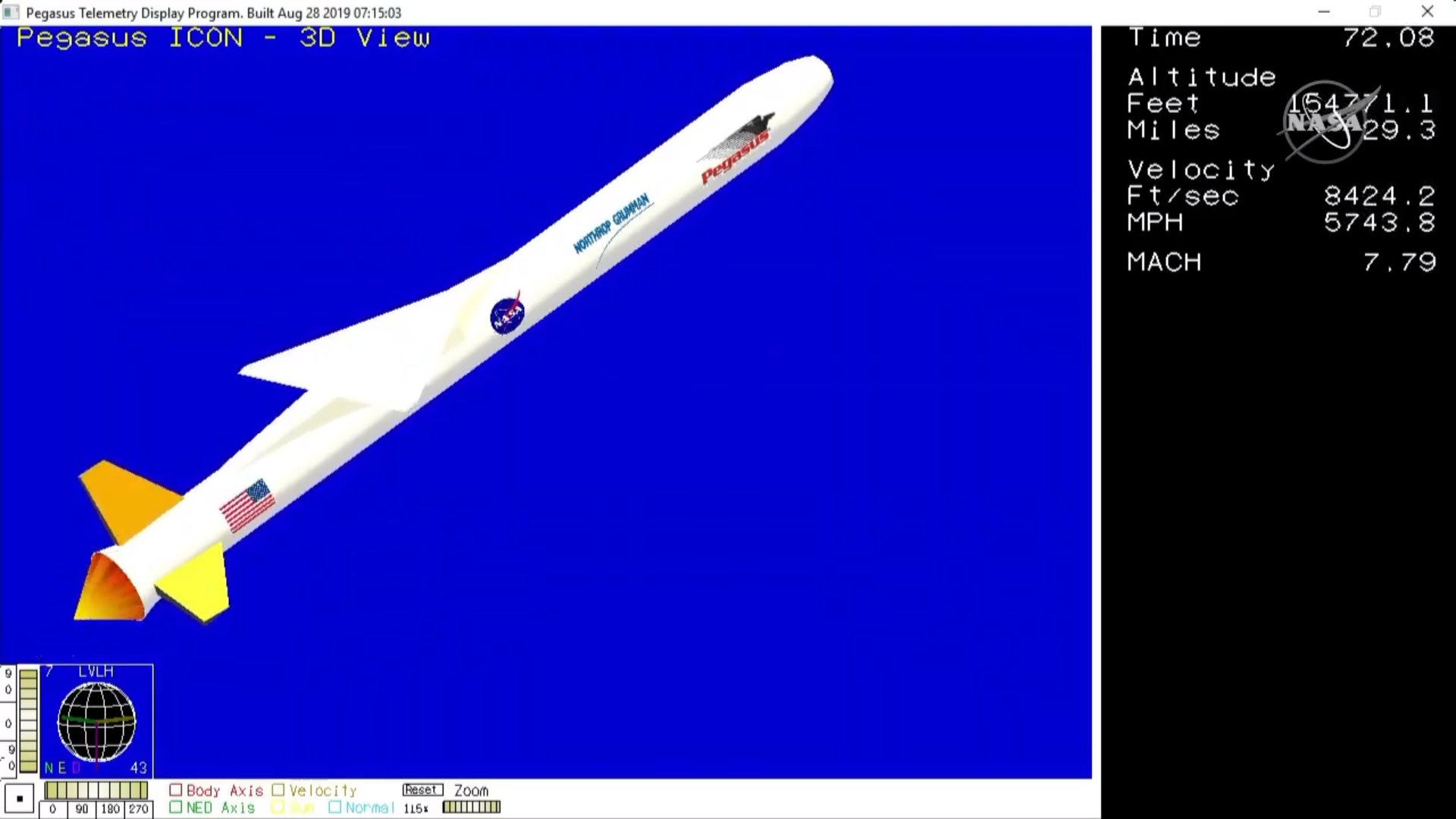
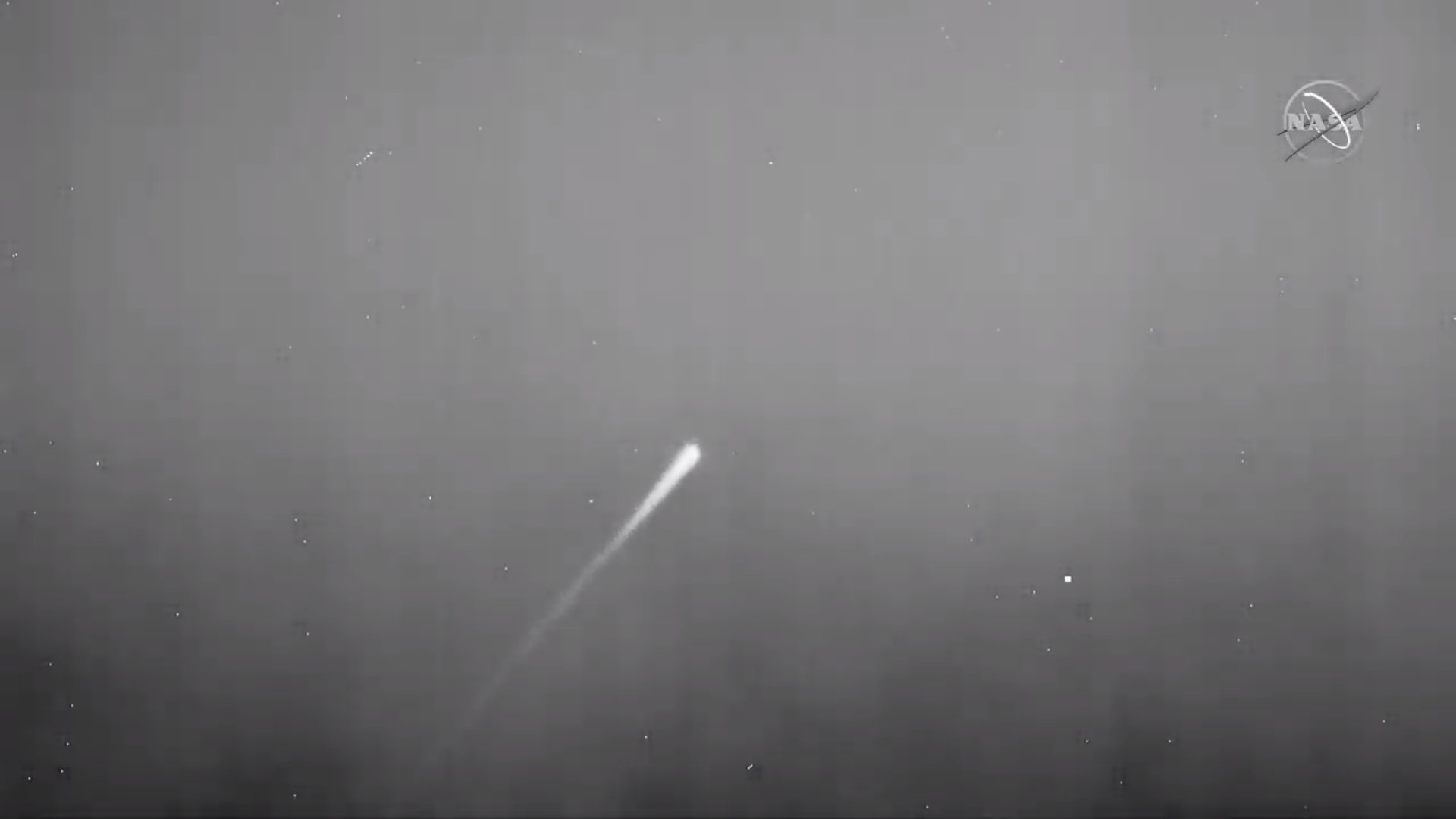

Название: ICON – Pegasus XL – Cape Canaveral AFS, L-1011 "Stargazer" – 11.10.2019 – 04:59:05 ДМВ
Отправлено: tnt22 от 11.10.2019 05:01:58
Отправлено: tnt22 от 11.10.2019 05:01:58
Отд 1-й ст РН, вкл ДУ 2-й ст РН
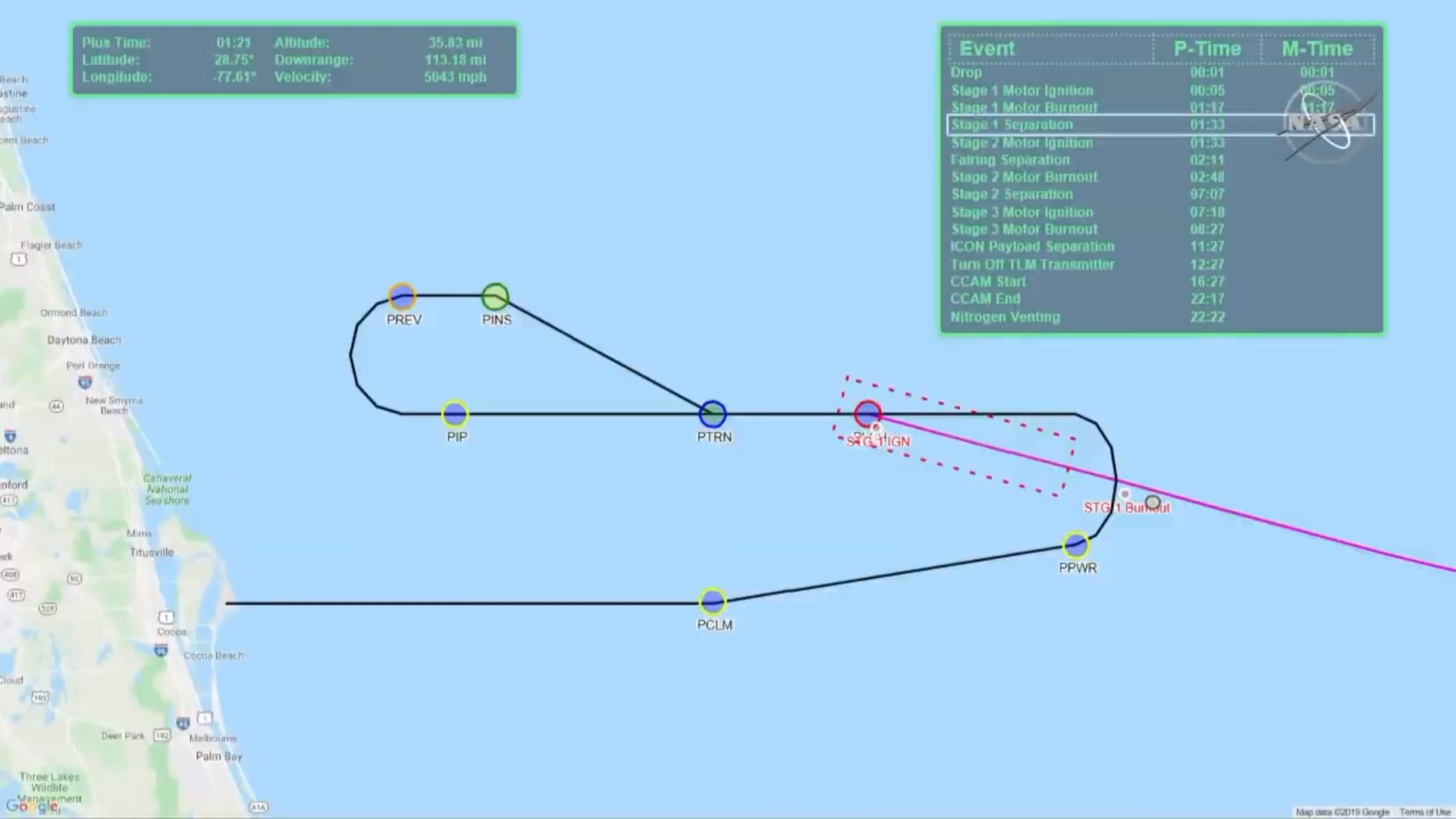
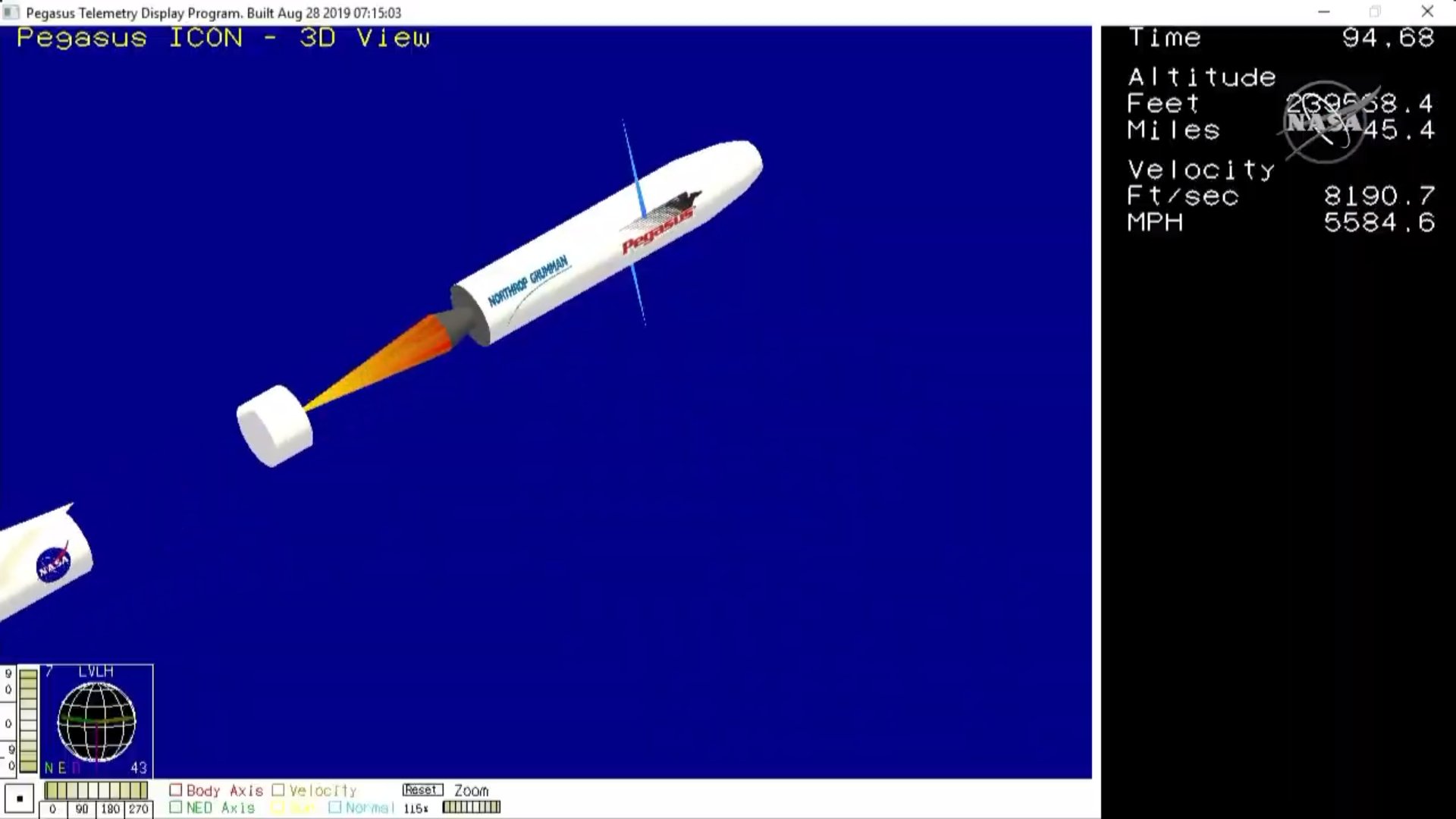

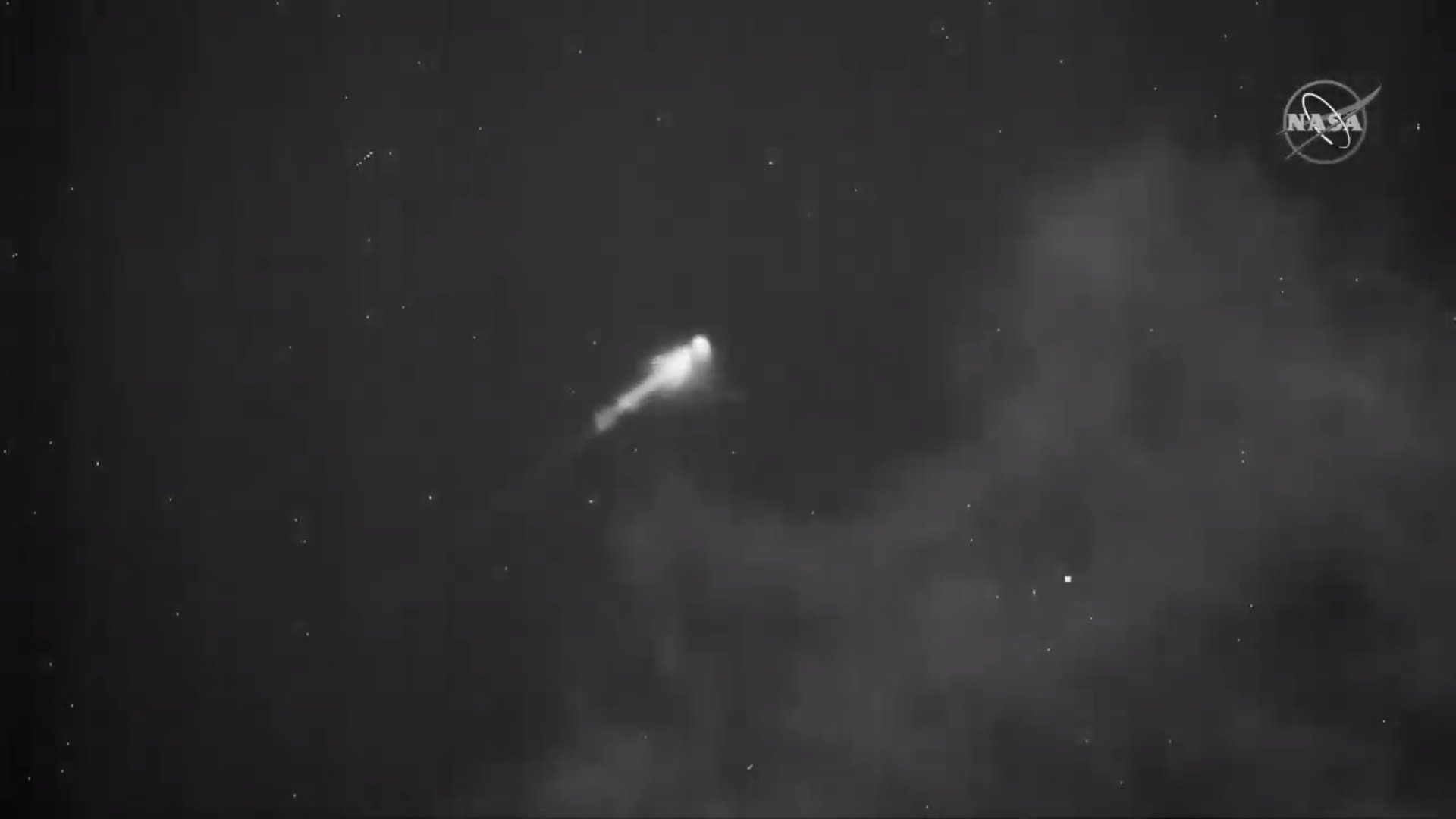

Название: ICON – Pegasus XL – Cape Canaveral AFS, L-1011 "Stargazer" – 11.10.2019 – 04:59:05 ДМВ
Отправлено: tnt22 от 11.10.2019 05:02:36
Отправлено: tnt22 от 11.10.2019 05:02:36
Сброс ГО
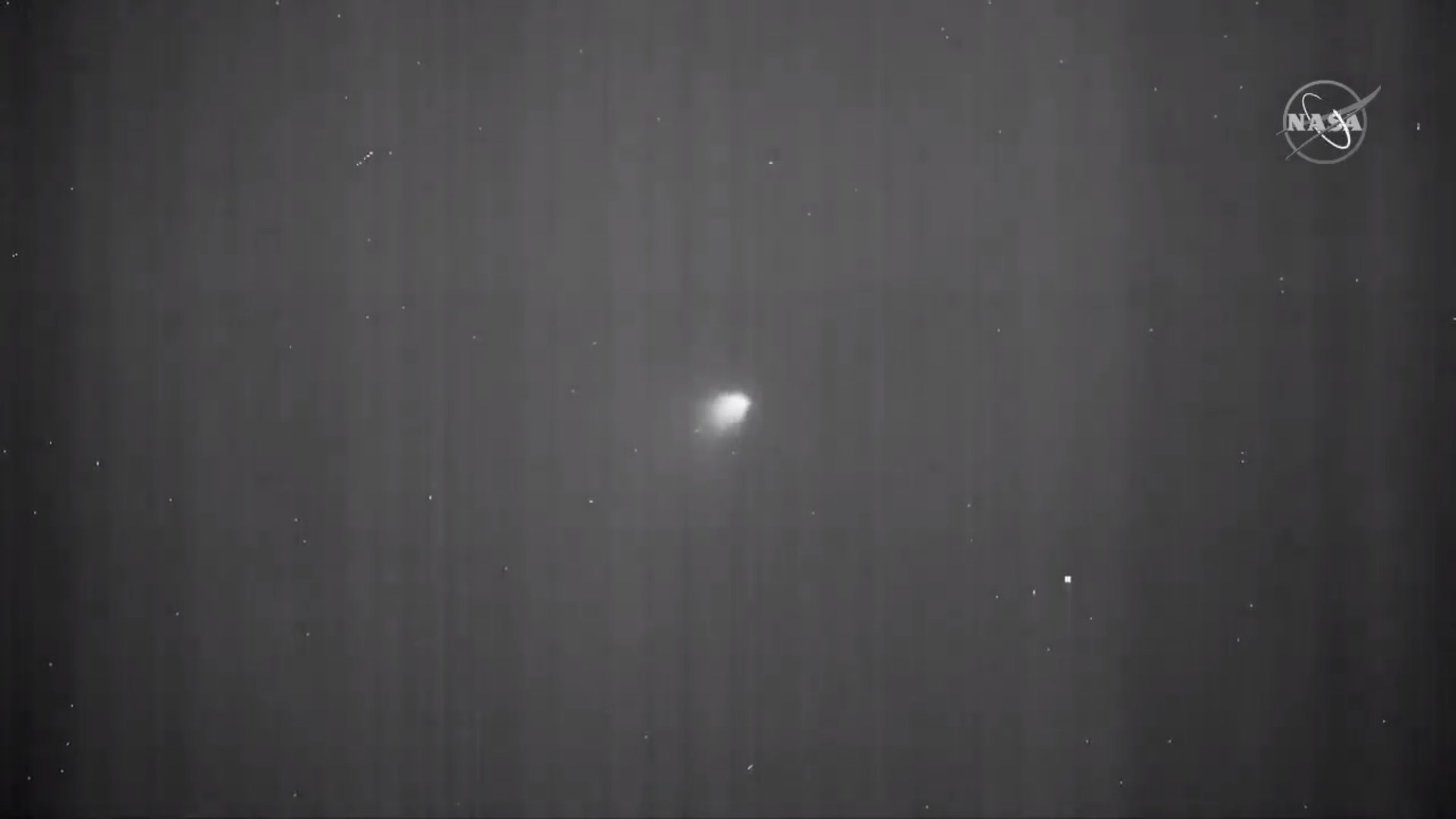
Название: ICON – Pegasus XL – Cape Canaveral AFS, L-1011 "Stargazer" – 11.10.2019 – 04:59:05 ДМВ
Отправлено: tnt22 от 11.10.2019 05:03:36
Отправлено: tnt22 от 11.10.2019 05:03:36
Выкл ДУ 2-й ст РН
Название: ICON – Pegasus XL – Cape Canaveral AFS, L-1011 "Stargazer" – 11.10.2019 – 04:59:05 ДМВ
Отправлено: tnt22 от 11.10.2019 05:07:47
Отправлено: tnt22 от 11.10.2019 05:07:47
Отд 2-й ст РН
Название: ICON – Pegasus XL – Cape Canaveral AFS, L-1011 "Stargazer" – 11.10.2019 – 04:59:05 ДМВ
Отправлено: tnt22 от 11.10.2019 05:08:08
Отправлено: tnt22 от 11.10.2019 05:08:08
Вкл ДУ 3-й ст РН


Название: ICON – Pegasus XL – Cape Canaveral AFS, L-1011 "Stargazer" – 11.10.2019 – 04:59:05 ДМВ
Отправлено: tnt22 от 11.10.2019 05:09:00
Отправлено: tnt22 от 11.10.2019 05:09:00
Выкл ДУ 3-й ст РН

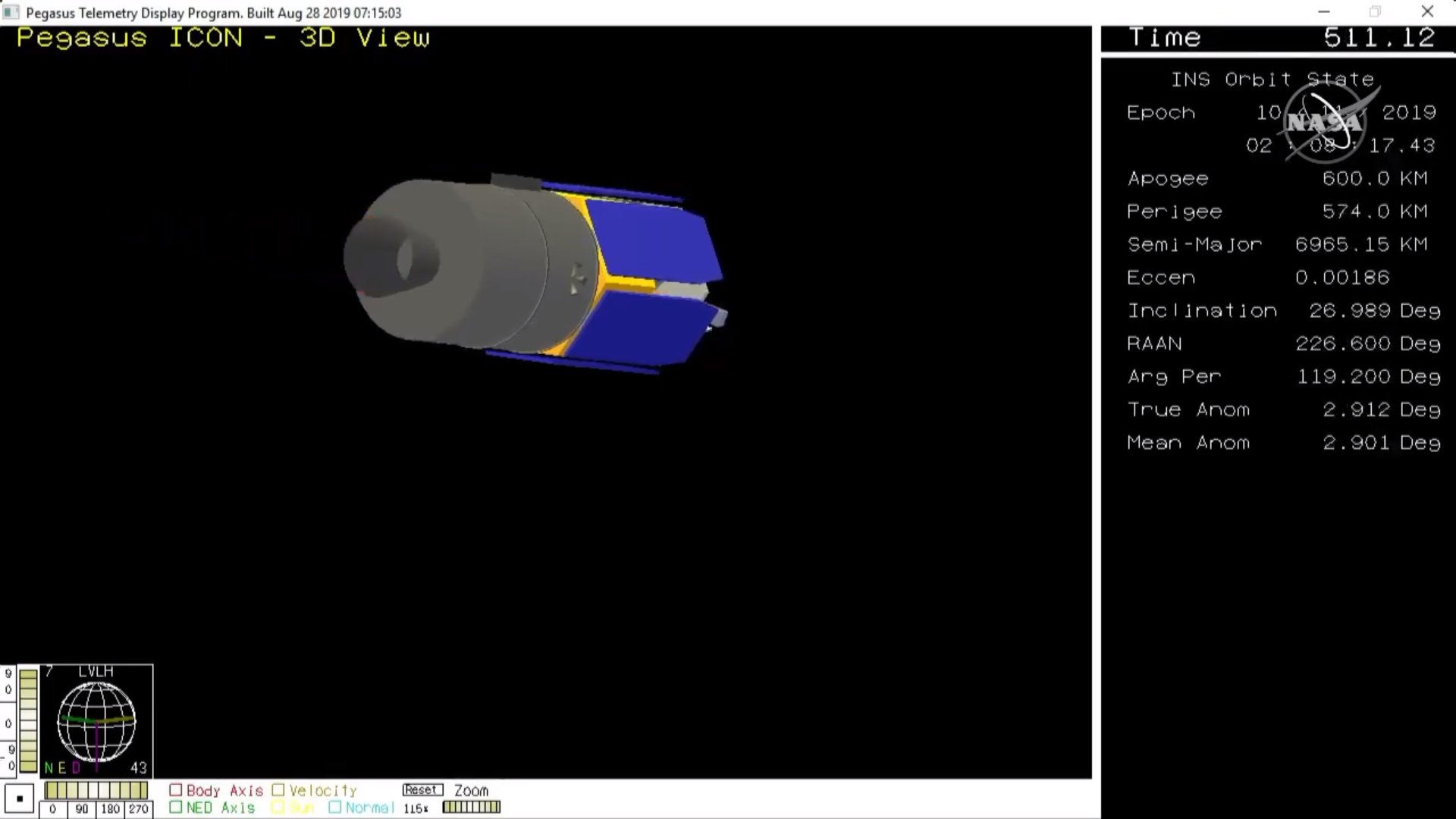
Название: ICON – Pegasus XL – Cape Canaveral AFS, L-1011 "Stargazer" – 11.10.2019 – 04:59:05 ДМВ
Отправлено: tnt22 от 11.10.2019 05:14:41
Отправлено: tnt22 от 11.10.2019 05:14:41
Есть отделение КК ICON!
ЦитироватьChris B - NSF @NASASpaceflight (https://twitter.com/NASASpaceflight) 2 мин. назад (https://twitter.com/NASASpaceflight/status/1182478949982580736)
Mission is fine. The updates have stopped has there's a checksum error with the telemetry screen.
Название: ICON – Pegasus XL – Cape Canaveral AFS, L-1011 "Stargazer" – 11.10.2019 – 04:59:05 ДМВ
Отправлено: tnt22 от 11.10.2019 05:46:40
Отправлено: tnt22 от 11.10.2019 05:46:40
Название: ICON – Pegasus XL – Cape Canaveral AFS, L-1011 "Stargazer" – 11.10.2019 – 04:59:05 ДМВ
Отправлено: tnt22 от 11.10.2019 05:49:11
Отправлено: tnt22 от 11.10.2019 05:49:11
ЦитироватьNorthrop Grumman @northropgrumman (https://twitter.com/northropgrumman) 25 мин. назад (https://twitter.com/northropgrumman/status/1182481547494080512)
We have successful spacecraft separation! Next step for #NASAICON (https://twitter.com/hashtag/NASAICON?src=hash) is solar array deployment.
#NorthropGrumman (https://twitter.com/hashtag/NorthropGrumman?src=hash)
Название: ICON – Pegasus XL – Cape Canaveral AFS, L-1011 "Stargazer" – 11.10.2019 – 04:59:05 ДМВ
Отправлено: tnt22 от 11.10.2019 05:50:37
Отправлено: tnt22 от 11.10.2019 05:50:37
ЦитироватьNorthrop Grumman @northropgrumman (https://twitter.com/northropgrumman) 5 мин. назад (https://twitter.com/northropgrumman/status/1182487082641563648)
Success!
#NASAICON (https://twitter.com/hashtag/NASAICON?src=hash) solar array deployment is complete.
#NorthropGrumman (https://twitter.com/hashtag/NorthropGrumman?src=hash)
Название: ICON – Pegasus XL – Cape Canaveral AFS, L-1011 "Stargazer" – 11.10.2019 – 04:59:05 ДМВ
Отправлено: tnt22 от 11.10.2019 05:52:53
Отправлено: tnt22 от 11.10.2019 05:52:53
ЦитироватьSpaceflight Now @SpaceflightNow (https://twitter.com/SpaceflightNow) 24 мин. назад (https://twitter.com/SpaceflightNow/status/1182483025243836417)
Tonight's launch marked the 44th flight of a Northrop Grumman Pegasus rocket on a satellite delivery mission, and the 30th consecutive success for Pegasus.
Название: ICON – Pegasus XL – Cape Canaveral AFS, L-1011 "Stargazer" – 11.10.2019 – 04:59:05 ДМВ
Отправлено: tnt22 от 11.10.2019 05:54:35
Отправлено: tnt22 от 11.10.2019 05:54:35
Цитироватьedward staples @heartdoc2 (https://twitter.com/heartdoc2) 20 мин. назад (https://twitter.com/heartdoc2/status/1182484331522080768)
@SpaceflightNow (https://twitter.com/SpaceflightNow) my view looking ESE from waldo, Fla straight uprange of the 1st and 2nd stages of Pegasus. The blips in the path is vibration on the dock from waves or foot steps!
Название: ICON – Pegasus XL – Cape Canaveral AFS, L-1011 "Stargazer" – 11.10.2019 – 04:59:05 ДМВ
Отправлено: tnt22 от 11.10.2019 05:55:07
Отправлено: tnt22 от 11.10.2019 05:55:07
Название: ICON – Pegasus XL – Cape Canaveral AFS, L-1011 "Stargazer" – 11.10.2019 – 04:59:05 ДМВ
Отправлено: tnt22 от 11.10.2019 06:00:03
Отправлено: tnt22 от 11.10.2019 06:00:03
https://blogs.nasa.gov/icon/2019/10/10/icon-flying-solo/ (https://blogs.nasa.gov/icon/2019/10/10/icon-flying-solo/)
ЦитироватьICON Flying Solo
Danielle Sempsrott (https://blogs.nasa.gov/icon/author/dsempsro/)
Posted Oct 10, 2019 at 10:21 pm
This illustration depicts NASA's Ionospheric Connection Explorer, or ICON, satellite that will study the frontier of space: the dynamic zone high in our atmosphere where terrestrial weather from below meets space weather from above.
Photo credit: NASA
The Pegasus XL rocket has gone through each of its three stage motors, reaching a top speed of nearly 17,000 mph. ICON has now separated from the rocket to begin its mission, orbiting 360 miles above the Earth.
Название: ICON – Pegasus XL – Cape Canaveral AFS, L-1011 "Stargazer" – 11.10.2019 – 04:59:05 ДМВ
Отправлено: tnt22 от 11.10.2019 06:05:10
Отправлено: tnt22 от 11.10.2019 06:05:10
https://news.northropgrumman.com/news/releases/northrop-grumman-successfully-launches-nasa-icon-satellite-on-pegasus-rocket (https://news.northropgrumman.com/news/releases/northrop-grumman-successfully-launches-nasa-icon-satellite-on-pegasus-rocket)
ЦитироватьNorthrop Grumman Successfully Launches NASA ICON Satellite on Pegasus Rocket
Ninth science mission for which the company both built and launched the satellite for NASA
October 10, 2019
Dulles, Va. – Oct. 10, 2019 – Northrop Grumman Corporation (NYSE: NOC) announced its Pegasus® XL rocket successfully launched the company-built Ionospheric Connection Explorer (ICON) satellite for NASA. The launch marked the 44th overall flight of the world's first privately-developed commercial space launch vehicle, and ICON marks the ninth science satellite to be both built and launched by the company for NASA.
Northrop Grumman successfully launched the Pegasus XL rocket carrying NASA's Ionospheric Connection Explorer (ICON) satellite fr om Cape Canaveral Air Force Station on Oct. 10, 2019.
The first phase of the launch was aboard Northrop Grumman's "Stargazer" L-1011 carrier aircraft. Shortly after release from Stargazer, Pegasus ignited, carrying ICON to its intended 575-kilometer orbit.
"We are proud to have another successful launch of Pegasus," said Rich Straka, vice president, launch vehicles, Northrop Grumman. "Today's launch is a testament to the team's expertise and determination to provide our customer with mission success."
NASA's ICON satellite will study the frontier of space – the dynamic zone high in Earth's atmosphere wh ere terrestrial weather from below meets space weather above. Northrop Grumman designed and manufactured the spacecraft for ICON at its Dulles satellite manufacturing facility, and tested and verified the spacecraft at the company's location in Gilbert, Arizona. The satellite is based on the company's LEOStar-2™ bus, a flight-proven and flexible satellite platform that accommodates a wide variety of missions.
"Our initial data shows the spacecraft is in good health and performing as expected," said Steve Krein, vice president, civil and commercial satellites, Northrop Grumman. "The successful launch of ICON continues to demonstrate Northrop Grumman's legacy of delivering innovative space science missions for NASA. ICON marks the latest in a long line of scientific spacecraft we have developed and built for NASA over the last 35 years."
ICON will help determine the physics of Earth's space environment and pave the way for mitigating its effects on technology, communications systems and society. Northrop Grumman has previously built multiple explorer satellites buses for NASA, including the NuSTAR, Swift, GALEX, AIM and IBEX spacecraft. Northrop Grumman is also currently manufacturing the Landsat-9 and JPSS-2 spacecraft for NASA. Both satellites use the company's larger LEOStar-3™ bus.
As an air-launched system, Pegasus has unparalleled flexibility to operate from virtually anywhere on Earth with minimal ground support requirements. In fact, Pegasus missions have launched from five separate sites in the U.S., Europe and the Marshall Islands. Pegasus is the leading launch system for the deployment of small satellites into low earth orbit. As the only NASA Category 3 vehicle in the small-launch class, Pegasus is certified to launch NASA's most valuable small satellites.
Northrop Grumman is a leading global security company providing innovative systems, products and solutions in autonomous systems, cyber, C4ISR, space, strike, and logistics and modernization to customers worldwide. Please visit news.northropgrumman.com and follow us on Twitter, @NGCNews (http://www.twitter.com/ngcnews), for more information.
Название: ICON – Pegasus XL – Cape Canaveral AFS, L-1011 "Stargazer" – 11.10.2019 – 04:59:05 ДМВ
Отправлено: tnt22 от 11.10.2019 06:13:30
Отправлено: tnt22 от 11.10.2019 06:13:30
ЦитироватьICON: Launch Broadcast Beginshttps://www.youtube.com/watch?v=T-iAYCFo_zE (https://www.youtube.com/watch?v=T-iAYCFo_zE)https://www.youtube.com/embed/T-iAYCFo_zE (https://www.youtube.com/embed/T-iAYCFo_zE) (2:51)(https://www.youtube.com/user/NASAKennedy) NASAKennedy (https://www.youtube.com/channel/UCjJtr2fFcUp6yljzJOzpHUg)
10 окт. 2019 г.
ЦитироватьICON: Polling for Launchhttps://www.youtube.com/watch?v=24R_RNAEe9s (https://www.youtube.com/watch?v=24R_RNAEe9s)https://www.youtube.com/embed/24R_RNAEe9s (https://www.youtube.com/embed/24R_RNAEe9s) (0:20)(https://www.youtube.com/user/NASAKennedy) NASAKennedy (https://www.youtube.com/channel/UCjJtr2fFcUp6yljzJOzpHUg)
10 окт. 2019 г.
Название: ICON – Pegasus XL – Cape Canaveral AFS, L-1011 "Stargazer" – 11.10.2019 – 04:59:05 ДМВ
Отправлено: tnt22 от 11.10.2019 06:15:15
Отправлено: tnt22 от 11.10.2019 06:15:15
ЦитироватьLaunch of Pegasus XL Carrying ICONhttps://www.youtube.com/watch?v=Bj7urES3pEY (https://www.youtube.com/watch?v=Bj7urES3pEY)https://www.youtube.com/embed/Bj7urES3pEY (https://www.youtube.com/embed/Bj7urES3pEY) (1:12)(https://www.youtube.com/user/NASAKennedy) NASAKennedy (https://www.youtube.com/channel/UCjJtr2fFcUp6yljzJOzpHUg)
10 окт. 2019 г.
Название: ICON – Pegasus XL – Cape Canaveral AFS, L-1011 "Stargazer" – 11.10.2019 – 04:59:05 ДМВ
Отправлено: tnt22 от 11.10.2019 06:17:51
Отправлено: tnt22 от 11.10.2019 06:17:51
ЦитироватьInterview with NASA's ICON Launch Manager Omar Baezhttps://www.youtube.com/watch?v=daU1z50_SjM (https://www.youtube.com/watch?v=daU1z50_SjM)https://www.youtube.com/embed/daU1z50_SjM (https://www.youtube.com/embed/daU1z50_SjM) (2:49)(https://www.youtube.com/user/NASAKennedy) NASAKennedy (https://www.youtube.com/channel/UCjJtr2fFcUp6yljzJOzpHUg)
10 окт. 2019 г.
Название: ICON – Pegasus XL – Cape Canaveral AFS, L-1011 "Stargazer" – 11.10.2019 – 04:59:05 ДМВ
Отправлено: tnt22 от 11.10.2019 06:22:20
Отправлено: tnt22 от 11.10.2019 06:22:20
https://www.nasa.gov/press-release/nasa-spacecraft-launches-on-mission-to-explore-frontier-of-space (https://www.nasa.gov/press-release/nasa-spacecraft-launches-on-mission-to-explore-frontier-of-space)
ЦитироватьOct. 11, 2019
RELEASE 19-082
NASA Spacecraft Launches on Mission to Explore Frontier of Space(https://www.nasa.gov/sites/default/files/thumbnails/image/icon-plane.jpg)
Northrop Grumman's L-1011 aircraft, Stargazer, prepares for takeoff at the Cape Canaveral Air Force Station Skid Strip in Florida on Oct. 10, 2019. Attached beneath the aircraft is the company's Pegasus XL rocket, carrying NASA's Ionospheric Connection Explorer (ICON).
Credits: NASA
After successfully launching Thursday night, NASA's Ionospheric Connection Explorer (ICON) spacecraft is in orbit for a first-of-its-kind mission to study a region of space where changes can disrupt communications and satellite orbits, and even increase radiation risks to astronauts.
A Northrop Grumman Stargazer L-1011 aircraft took off at 8:31 p.m. EDT from Cape Canaveral Air Force Station in Florida carrying ICON, on a Northrop Grumman Pegasus XL rocket, to launch altitude of about 39,000 feet. The first launch opportunity around 9:30 was skipped due to communication issues between the ground team at Cape Canaveral and the aircraft. On the second attempt, the aircraft crew released its payload at 9:59 p.m. EDT and automated systems on the Pegasus rocket launched ICON, a spacecraft roughly the size of a refrigerator, into space.
The spacecraft's solar panels successfully deployed, indicating it has power with all systems operating. After an approximately month-long commissioning period, ICON will begin sending back its first science data in November.
ICON will study changes in a region of the upper atmosphere called the ionosphere. In addition to interfering with communications signals, space weather in the ionosphere can also prematurely decay spacecraft orbits and expose astronauts to radiation-borne health risks. Historically, this critical region of near-Earth space has been difficult to observe. Spacecraft can't travel through the low parts of the ionosphere and balloons can't travel high enough.
"ICON has an important job to do – to help us understand the dynamic space environment near our home," said Nicola Fox, director for heliophysics at NASA Headquarters in Washington. "ICON will be the first mission to simultaneously track what's happening in Earth's upper atmosphere and in space to see how the two interact, causing the kind of changes that can disrupt our communications systems."
ICON explores the connections between the neutral atmosphere and the electrically charged ionosphere with four instruments. Three of the instruments (https://www.nasa.gov/content/icon-spacecraft-and-instruments) rely on one of the upper atmosphere's more spectacular phenomena: colorful bands called airglow.
Airglow is created by a similar process that creates the aurora – gas is excited by radiation from the Sun and emits light. Though aurora are typically confined to extreme northern and southern latitudes, airglow happens constantly across the globe, and is much fainter. But it's still bright enough for ICON's instruments to build up a picture of the ionosphere's density, composition and structure. By way of airglow, ICON can observe how particles throughout the upper atmosphere are moving.
ICON's fourth instrument provides direct measurements of the ionosphere around it. This instrument characterizes the charged gases immediately surrounding the spacecraft.
"We put as much capability on this satellite that could possibly fit on the payload deck," said Thomas Immel, the principal investigator for ICON at the University of California, Berkeley. "All those instruments are focused on the ionosphere in a completely new science mission that starts now."
ICON's orbit around Earth places it at a 27-degree inclination and altitude of about 360 miles. From there, it can observe the ionosphere around the equator. ICON will aim its instruments for a view of what's happening at the lowest boundary of space, from about 55 miles up to 360 miles above the surface. This rapid orbit circles Earth in 97 minutes while precessing around the equator, allowing ICON to sample a wide range of latitude, longitude and local times.
ICON is an Explorer-class mission. NASA's Goddard Space Flight Center in Greenbelt, Maryland, manages the Explorer Program for NASA's Science Mission Directorate in Washington. The University of California at Berkeley developed the ICON mission and the two ultraviolet imaging spectrographs, Extreme Ultra-Violet instrument and the Far Ultra-Violet instrument. The Naval Research Laboratory in Washington developed the Michelson Interferometer for Global High-resolution Thermospheric Imaging instrument. The University of Texas in Dallas developed the Ion Velocity Meter. The spacecraft was built by Northrop Grumman in Dulles, Virginia. The Mission Operations Center at UC Berkeley's Space Sciences Laboratory is tasked with operating the ICON mission.-end-
Last Updated: Oct. 11, 2019
Editor: Katherine Brown
Название: ICON – Pegasus XL – Cape Canaveral AFS, L-1011 "Stargazer" – 11.10.2019 – 04:59:05 ДМВ
Отправлено: tnt22 от 11.10.2019 06:28:16
Отправлено: tnt22 от 11.10.2019 06:28:16
https://tass.ru/kosmos/6987893 (https://tass.ru/kosmos/6987893)
Цитировать11 ОКТ, 05:42
NASA со второй попытки запустило ракету со спутником для изучения ионосферы Земли
Воздушный старт ракеты-носителя Pegasus с модифицированного транспортного самолета L-1011 Stargazer прошел с задержкой
НЬЮ-ЙОРК, 11 октября. /ТАСС/. Национальное управление по аэронавтике и исследованию космического пространства (NASA) США запустило в четверг спутник ICON, предназначенный для изучения ионосферы Земли. Воздушный старт ракеты-носителя Pegasus с модифицированного транспортного самолета L-1011 Stargazer состоялся с получасовой задержкой - в 22:00 по времени Восточного побережья США (05:00 мск).
Трансляция ведется на сайте NASA (https://www.nasa.gov/feature/europa-clippers-mission-to-jupiter-s-icy-moon-confirmed). "Третья ступень отделилась, аппарат достиг орбиты", - информировало NASA.
Самолет, выполняющий роль платформы для воздушного старта, поднялся в воздух в 03:33 мск с взлетно-посадочной полосы базы ВВС США на мысе Канаверал (штат Флорида). Stargazer достиг высоты примерно 11,9 км, однако не сбросил ракету-носитель со спутником. "Мы потеряли связь с L-1011 в финальные минуты отсчета времени и были вынуждены отменить попытку запуска", - пояснило в своем Twitter (https://twitter.com/nasa) космическое ведомство США.
Самолету пришлось сделать круг и повторить маневр через 30 минут. На этот раз сброс ракеты-носителя прошел штатно. Pegasus через пять секунд свободного падения в горизонтальном положении в автоматическом режиме запустил двигатели. Согласно плану НАСА, носитель должен был доставить спутник на низкую околоземную орбиту за 10 минут.
Миссия ICON рассчитана на два года. Разработчиком ракеты Pegasus XL, состоящей из трех ступеней, является американская корпорация Northrop Grumman. Первоначально запуск приборы намечался на 26 октября прошлого года. Однако пуск был отложен на неопределенный срок из-за необходимости продления предполетных испытаний ракеты-носителя Pegasus.
ICON массой 0,27 тонны был разработан для изучения ионизированной части верхних слоев атмосферы Земли, расположенной выше 50 км. Ионосфера представляет собой природное образование разреженной слабоионизированной плазмы, находящейся в магнитном поле нашей планеты и обладающей благодаря своей высокой электропроводности специфическими свойствами, определяющими характер распространения в ней радиоволн и различных возмущений. Благодаря этому образованию возможен такой удобный вид связи на дальние расстояния, как радиосвязь.
Название: ICON – Pegasus XL – Cape Canaveral AFS, L-1011 "Stargazer" – 11.10.2019 – 04:59:05 ДМВ
Отправлено: tnt22 от 11.10.2019 06:43:22
Отправлено: tnt22 от 11.10.2019 06:43:22
https://blogs.nasa.gov/icon/2019/10/10/icon-begins-study-of-earths-ionosphere/ (https://blogs.nasa.gov/icon/2019/10/10/icon-begins-study-of-earths-ionosphere/)
ЦитироватьICON Begins Study of Earth's Ionosphere
Danielle Sempsrott (https://blogs.nasa.gov/icon/author/dsempsro/)
Posted Oct 10, 2019 at 10:54 pm
Northrop Grumman's L-1011 Stargazer aircraft, with the company's Pegasus XL rocket attached beneath, takes off fr om the Skid Strip runway at Cape Canaveral Air Force Station in Florida on Oct. 10, 2019. NASA's Ionospheric Connection Explorer (ICON) is secured inside the rocket's payload fairing. The air-launched Pegasus XL was released fr om the aircraft at 9:59 p.m. EDT to start ICON's journey to space. Photo credit: NASA/Frank Michaux
A Northrop Grumman Pegasus XL rocket launched NASA's Ionospheric Connection Explorer, or ICON, satellite at 9:59 p.m. EDT on Oct. 10 fr om Cape Canaveral Air Force Station (CCAFS) to study the dynamic zone in our atmosphere wh ere terrestrial weather from below meets space weather from above.
The satellite was attached to the Pegasus XL rocket, which hitched a ride on the company's L-1011 Stargazer aircraft. Once the aircraft reached an altitude of 39,000 feet, the rocket was dropped, with ignition occurring five seconds after.
"This is a fun launch. In my operational function, this is about as good as it gets," said Omar Baez, launch director in NASA's Launch Services Program. "The anxiety level is higher, the adrenaline is flowing, but what a cool way to fly."
Originally targeting a 9:30 p.m. drop, NASA and Northrop Grumman determined to bypass the first drop attempt due to a loss of communication between ground teams at CCAFS and the Stargazer.
NASA's Ionospheric Connection Explorer (ICON) is attached to the Northrop Grumman Pegasus XL rocket inside Building 1555 at Vandenberg Air Force Base in California on Sept. 10, 2019. Photo credit: NASA/Randy Beaudoin
"When your launch pad is moving at 500/600 miles per hour, things happen," said Baez. "The first attempt got us because we lost positive communication with the aircraft and the ground, and our rule is to abort the flight and go back around and try it again. And we were able to execute it flawlessly."
The region of space wh ere ICON will conduct its study – the ionosphere – comprises of winds that are influenced by many different factors: Earth's seasons, the heating and cooling that takes place throughout the day, and bursts of radiation from the Sun. This region also is wh ere radio communications and GPS signals travel, and fluctuations within the ionosphere can cause significant disruptions to these critical technologies.
As a response to the recent scientific discovery that the ionosphere is significantly impacted by storms in Earth's lower atmosphere, Northrop Grumman designed, integrated and tested the ICON satellite under a contract from the University of California Berkeley's Space Sciences Laboratory. NASA's Launch Services Program at Kennedy is responsible for launch service acquisition, integration, analysis and launch management.
The ICON mission is part of NASA's Explorer Program managed by the agency's Goddard Space Flight Center in Maryland for the Science Mission Directorate in Washington, which aims to provide frequent flight opportunities for small- to medium-sized spacecraft that are capable of being built, tested and launched in a shorter period of time.
ICON is expected to improve the forecasts of extreme space weather by utilizing in-situ and remote-sensing instruments to survey the variability of Earth's ionosphere. The mission also will help determine the physics of our space environment, paving the way for mitigating its effects on our technology, communications systems and society.
Название: ICON – Pegasus XL – Cape Canaveral AFS, L-1011 "Stargazer" – 11.10.2019 – 04:59:05 ДМВ
Отправлено: tnt22 от 11.10.2019 11:59:04
Отправлено: tnt22 от 11.10.2019 11:59:04
Обнаружены два объекта запуска
44629 / 2019-068B : 581 x 610 km x 26.994°, 96.58 min, 2019-10-11 05:14:12
Код Выделить
0 TBA - TO BE ASSIGNED
1 44628U 19068A 19284.21839666 .00001274 00000-0 10000-3 0 9991
2 44628 26.9924 225.8036 0011411 132.6128 325.5408 14.93214360 16
0 TBA - TO BE ASSIGNED
1 44629U 19068B 19284.21819786 .00000202 00000-0 00000+0 0 9998
2 44629 26.9938 225.7620 0020985 104.9632 351.7306 14.90742677 1044628 / 2019-068A : 580 x 596 km x 26.992°, 96.43 min, 2019-10-11 05:14:2944629 / 2019-068B : 581 x 610 km x 26.994°, 96.58 min, 2019-10-11 05:14:12
Название: ICON – Pegasus XL – Cape Canaveral AFS, L-1011 "Stargazer" – 11.10.2019 – 04:59:05 ДМВ
Отправлено: tnt22 от 11.10.2019 12:21:57
Отправлено: tnt22 от 11.10.2019 12:21:57
ЦитироватьJonathan McDowell @planet4589 (https://twitter.com/planet4589) 5 ч. назад (https://twitter.com/planet4589/status/1182517202207031297)
ICON and the Pegasus 3rd stage cataloged in 569 x 569 km x 27.0 deg orbits, confirming success of the 44th Pegasus launch.
Название: ICON – Pegasus XL – Cape Canaveral AFS, L-1011 "Stargazer" – 11.10.2019 – 04:59:05 ДМВ
Отправлено: tnt22 от 11.10.2019 13:09:27
Отправлено: tnt22 от 11.10.2019 13:09:27
ЦитироватьJohn Kraus :f09f9a80: @johnkrausphotos (https://twitter.com/johnkrausphotos) 8 ч. назад (https://twitter.com/johnkrausphotos/status/1182480640178036737)
I can't believe I managed to catch a glimpse of this over the Atlantic Ocean! Northrop Grumman's #PegasusXL (https://twitter.com/hashtag/PegasusXL?src=hash) rocket heads to orbit with NASA's #ICON (https://twitter.com/hashtag/ICON?src=hash) mission. The rocket was dropped from the L-1011 Stargazer aircraft at 10:00pm ET.
Название: ICON – Pegasus XL – Cape Canaveral AFS, L-1011 "Stargazer" – 11.10.2019 – 04:59:05 ДМВ
Отправлено: tnt22 от 11.10.2019 20:27:07
Отправлено: tnt22 от 11.10.2019 20:27:07
Объекты занесены в каталог, не идентифицированы

Название: ICON – Pegasus XL – Cape Canaveral AFS, L-1011 "Stargazer" – 11.10.2019 – 04:59:05 ДМВ
Отправлено: tnt22 от 16.10.2019 22:06:00
Отправлено: tnt22 от 16.10.2019 22:06:00
НОРАД определился с объектами запуска

Название: ICON – Pegasus XL – Cape Canaveral AFS, L-1011 "Stargazer" – 11.10.2019 – 04:59:05 ДМВ
Отправлено: tnt22 от 22.06.2020 22:20:41
Отправлено: tnt22 от 22.06.2020 22:20:41
https://blogs.nasa.gov/icon/2020/06/22/first-icon-science-data-released-to-public/ (https://blogs.nasa.gov/icon/2020/06/22/first-icon-science-data-released-to-public/)
Цитата: undefinedFirst ICON Science Data Released to Public
Lina Tran (https://blogs.nasa.gov/icon/author/kktran/)
Posted Jun 22, 2020 at 2:02 pm
On June 22, NASA's ICON team released scientific data collected during the spacecraft's first eight months in orbit to the public.
The data release features observations from ICON's four instruments — MIGHTI, FUV, EUV, and IVM — which have been observing the ins and outs of the ionosphere, the sea of charged particles high in the upper atmosphere. Scientists have been busy parsing the wealth of observations collected by ICON in preparation for the mission's first science results, which will be released later this year.
"We're really excited to see the first data appearing from the ICON mission," said Scott England, the ICON project scientist at Virginia Tech in Blacksburg, Virginia. "For me, the real power of these data isn't just seeing transformative things like the wind patterns throughout the whole upper atmosphere, but having all these observations available to us at once, so we can see the connections between the neutral and charged environment around Earth."
The release coincides with the virtual summer meeting of CEDAR (http://cedarweb.vsp.ucar.edu/wiki/index.php/2020_Workshop:workshoplist), the Coupling, Energetics, and Dynamics of Atmospheric Regions program. The newly released data spans measurements made since the mission's launch on Oct. 10, 2019. Data can be accessed through University of California Berkeley's Space Sciences Lab (https://icon.ssl.berkeley.edu/Data).
ICON observes what's happening at the lowest boundary of space, from about 55 miles up to 360 miles above the surface. ICON explores the connections between the neutral atmosphere and the electrically charged ionosphere. In addition to interfering with communications signals, space weather in this important slice of the atmosphere can also prematurely decay spacecraft orbits and expose astronauts to radiation-borne health risks.
By Lina Tran
NASA's Goddard Space Flight Center, Greenbelt, Md.
